





 Basketball court opening at Cuney Homes on February 2023.
Source: IMPAcT13
Basketball court opening at Cuney Homes on February 2023.
Source: IMPAcT13







 Basketball court opening at Cuney Homes on February 2023.
Source: IMPAcT13
Basketball court opening at Cuney Homes on February 2023.
Source: IMPAcT13
On behalf of the Houston Housing Authority and the City of Houston, we proudly and enthusiastically present the Third Ward Cuney Homes Choice Neighborhood Initiative Draft Transformation Plan.
On behalf of the Houston Housing Authority and the City of Houston, we proudly and enthusiastically present the Third Ward Cuney Homes Choice Neighborhood Initiative Final Transformation Plan.
The Plan represents the culmination of 28 months of intensive resident engagement, collaborative work with our community partners, and a synthesis of creativity and aspirations from neighborhood residents, local organizations, and other stakeholders. Their collective ideas capture a holistic vision of a new and enhanced future for the Third Ward area by envisioning a safe, inclusive, thriving, familyfriendly, mixed-income neighborhood while also honoring the community's deeply rooted culture and history
The Plan represents the culmination of months of intensive resident engagement, collaborative work with our community partners, and a synthesis of creativity and aspirations from neighborhood residents, local organizations, and other stakeholders. Their collective ideas capture a holistic vision of a new and enhanced future for the Third Ward area by envisioning a safe, inclusive, thriving, familyfriendly, mixed-income neighborhood while also honoring the community's deeply rooted culture and history.
On behalf of the Houston Housing Authority and the City of Houston, we proudly and enthusiastically present the Third Ward Cuney Homes Choice Neighborhood Initiative Draft Transformation Plan.


The Plan represents the culmination of 28 months of intensive resident engagement, collaborative work with our community partners, and a synthesis of creativity and aspirations from neighborhood residents, local organizations, and other stakeholders. Their collective ideas capture a holistic vision of a new and enhanced future for the Third Ward area by envisioning a safe, inclusive, thriving, familyfriendly, mixed-income neighborhood while also honoring the community's deeply rooted culture and history.
The strategy behind the Plan organizes this vision into an attainable roadmap, with intentional goals founded on the core guiding principles of reimagining, uplifting, and revitalizing the Third Ward Cuney Homes community.
The strategy behind the Plan organizes this vision into an attainable roadmap, with intentional goals founded on the core guiding principles of reimagining, uplifting, and revitalizing the Third Ward Cuney Homes community.
The strategy behind the Plan organizes this vision into an attainable roadmap, with intentional goals founded on the core guiding principles of reimagining, uplifting, and revitalizing the Third Ward Cuney Homes community.
f Reimagine — Elevate the quality of the neighborhood environment to encourage community growth that will meet the current needs of residents by generating access to health and wellness resources that do not currently exist for Third Ward residents. This includes safe recreation and educational spaces, fresh food, local businesses, and affordable comprehensive care services for people of all ages.
Reimagine — Elevate the quality of the neighborhood environment to encourage community growth that will meet the current needs of residents by generating access to health and wellness resources that do not currently exist for Third Ward residents. This includes safe recreation and educational spaces, fresh food, local businesses, and affordable comprehensive care services for people of all ages.
Reimagine — Elevate the quality of the neighborhood environment to encourage community growth that will meet the current needs of residents by generating access to health and wellness resources that do not currently exist for Third Ward residents. This includes safe recreation and educational spaces, fresh food, local businesses, and affordable comprehensive care services for people of all ages.
Uplift — Create an environment that reinvigorates the community by actively and consistently supporting residents in their vision of how they want to transform their environment and community spaces. We are fostering a collective approach of resident-led engagement to uplift community members' ideas for improvements they want to implement to meet their health, safety, employment, and housing needs.
f Uplift — Create an environment that reinvigorates the community by actively and consistently supporting residents in their vision of how they want to transform their environment and community spaces. We are fostering a collective approach of resident-led engagement to uplift community members' ideas for improvements they want to implement to meet their health, safety, employment, and housing needs.
Uplift — Create an environment that reinvigorates the community by actively and consistently supporting residents in their vision of how they want to transform their environment and community spaces. We are fostering a collective approach of resident-led engagement to uplift community members' ideas for improvements they want to implement to meet their health, safety, employment, and housing needs.
Revitalize — Enhance the community by generating economic self-sufficiency by integrating more affordable housing and homeownership options to combat displacement due to the skyrocketing cost of living. The Plan also incorporates preserving the historic cultural integrity of the area through the reconstruction of community spaces and additional neighborhood amenities.
Revitalize — Enhance the community by generating economic self-sufficiency by integrating more affordable housing and homeownership options to combat displacement due to the skyrocketing cost of living. The Plan also incorporates preserving the historic cultural integrity of the area through the reconstruction of community spaces and additional neighborhood amenities.
f Revitalize — Enhance the community by generating economic self-sufficiency by integrating more affordable housing and homeownership options to combat displacement due to the skyrocketing cost of living. The Plan also incorporates preserving the historic cultural integrity of the area through the reconstruction of community spaces and additional neighborhood amenities.
The Plan is holistically consistent with the City's housing plan and works in tandem with the mutual goals to support the advancement of Houstonians in the Third Ward. It builds upon the numerous existing plans created for the Third Ward community, laying a new foundation for this community’s future.
The Plan is holistically consistent with the City's housing plan and works in tandem with the mutual goals to support the advancement of Houstonians in the Third Ward. It builds upon the numerous existing plans created for the Third Ward community, laying a new foundation for this community’s future.
The Third Ward community has faced an array of historical setbacks, suppression, and financial challenges that have extended detrimental effects into the present conditions. Despite these hardships, the residents and partnering organizations remain steadfast in commitment and love for their community. There is a vast and limitless opportunity to embrace these ideas for an inspired
The Third Ward community has faced an array of historical setbacks, suppression, and financial challenges that have extended detrimental effects into the present conditions. Despite these hardships, the residents and partnering organizations remain steadfast in commitment and love for their community. There is a vast and limitless opportunity to embrace these ideas for an inspired
The Plan is holistically consistent with the City's housing plan and works in tandem with the mutual goals to support the advancement of Houstonians in the Third Ward. It builds upon the numerous existing plans created for the Third Ward community, laying a new foundation for this community’s future.
The Third Ward community has faced an array of historical setbacks, suppression, and financial challenges that have extended detrimental effects into the present conditions. Despite these hardships, the residents and partnering organizations remain steadfast in commitment and love for our community. There is a vast and limitless opportunity to embrace these ideas for an inspired environment that will cultivate a complete and connected community that is capable of incorporating socioeconomic self-sufficiency while also maintaining affordability and enjoyability for those who live here.
environment that will cultivate a complete and connected community that is capable of incorporating socioeconomic self-sufficiency while also maintaining affordability and enjoyability for those who live there.
The Houston Housing Authority stands united with the Third Ward community to leverage the resources available to enhance their lives by developing infrastructure that will make a lasting impact on their health and well-being. We look forward to creating a safe and thriving environment that incorporates education, employment, and wellness resources to serve people of all ages, abilities, and cultural backgrounds.
The Houston Housing Authority stands united with the Third Ward community to leverage the resources available to enhance their lives by developing infrastructure and resources that will make a lasting impact on their health and well-being. We look forward to creating a safe and thriving environment that incorporates education, employment, and wellness resources to serve people of all ages, abilities, and cultural backgrounds.
It is with fervent purpose and thoughtful intention that we enthusiastically support the development of Cuney Homes and the greater Third Ward to sustain the growth and health of the community for today, tomorrow, and future generations to come.
It is with fervent purpose and thoughtful intention that we enthusiastically support the development of Cuney Homes and the greater Third Ward to sustain the growth and health of the community for today, tomorrow, and future generations to come.

Sincerely,
Sincerely,
David A. Northern, Sr. President & CEO Houston Housing Authority David A. Northern, Sr. President & CEO Houston Housing Authority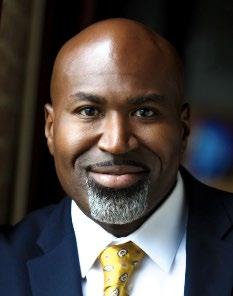 Sylvester Turner Mayor City of Houston
Sylvester Turner Mayor City of Houston
Sylvester Turner Mayor City of Houston
Sylvester Turner Mayor City of Houston


 Cuney Homes youth at the National Night Out event in October 2022.
Cuney Homes youth at the National Night Out event in October 2022.
The purpose of the Final Third Ward-Cuney Homes Choice Neighborhoods Plan is to serve as a roadmap towards comprehensive neighborhood transformation, developed by residents, for residents. This Plan is designed to be fully implemented in the next decade.
Delores Ford Cuney Homes resident"At our move-in appointment, we were told to treat this place as home. Well, this is my home. And after this plan hits the neighborhood, they won’t be ashamed of where they live. They will want their friends and family to come visit them to see how it has changed over the years."
Core Team
Houston Housing Authority
City of Houston
Cuney Homes Resident Council
Sankofa Research Institute
Planning Coordinator
WRT, LLC in partnership with Moody Nolan
Community Ambassadors
David Butler
Debra Hill
Delores Ford
Irenda Jefferson
Laura Welch
Linda Herkshan
Pamela Barr
Rita Bean
Verdell Ingram
Veronica DeBoest
Housing Task Force
Center for Civic & Public Policy Improvement
Change Happens CDC
City of Houston HCD
Cuney Homes Resident Council
Cuney Homes Residents
Greater Third Ward Residents
The Guess Group
Harris County Community Services Department
Harris County Precinct One Commissioner
Housing Collaborative
Houston Housing Authority
Houston Community Land Trust
Houston Housing Finance Corporation
Houston Land Bank
The Kinder Institute
Midtown Redevelopment Authority
Office of Houston City Council Member
Evans-Shabazz
Orchard Communities
Project Row Houses
TIRZ 7/Third Ward Community Cloth Cooperative
Trinity East/United Methodist Church
Womack Development
Special thanks to the Cuney Homes residents and many community members who have helped shape this Plan.
Neighborhood Task Force
American Heart Association
Blue Triangle Multi-Cultural Associates
Change Happens
City of Houston – Department of Neighborhoods
City of Houston – Planning & Development Department
Complete Communities
Cuney Homes Residents
Emancipation Park Conservancy
Fit Houston
Friends of Columbia Tap Trail
Greater Third Ward Super Neighborhood #67
Harris County Precint 1
Harris County Precinct 6 & 7
Houston City Council District D – Carolyn Evans
Shabazz
Houston Land Bank
Houston Parks Board
Houston Police Department
Little Red Box
Northern Third Ward Implementation Project
Operation Love
OST Community Partnership
Project Row Houses
Provost Studios
Residents of Greater Third Ward
Rotary Houston Skyline
S.H.A.P.E. Community Center
Texas 18th Congressional District
-Congresswoman Sheila Jackson Lee
Texas Southern University Earl Carl Institute
The Common Market
TIRZ 7
Trinity East United Methodist Church
University of Houston – College of Medicine
Wheeler Avenue Baptist Church
William A. Lawson Institute for Peace & Prosperity
People Task Force
Boynton Chapel United Methodist Church
Beal Counseling Associates
Blackshear Elementary
Center for Justice Research, Texas Southern University
Community Health Worker Initiative, University of Houston
C-STEM Teacher and Student Support Services, Inc.
Cuney Homes Residents
Emancipation Economic Development Council
Emancipation Park Conservancy
Greater Third Ward Residents
Houston Community College
Houston Public Library
Layers DM
Project Row Houses
Row House CDC
Sankofa Research Institute
SHAPE Community Center
Third Ward Community Ambassadors
Third Ward Community Cloth
Trinity East United Methodist Church
University of Houston, College of Medicine
We Are The Ones Cooperative Incubator and Accelerator
Workshop Houston
Yates High School Alumni Association
Affordable Housing – Housing is considered affordable if a family pays no more than 30% of its household income on housingrelated costs.
Anchor Institutions – Anchor institutions are businesses and organizations firmly established within a neighborhood. They have regional significance and serve as economic and cultural drivers, generating jobs, creating local business opportunities, and contributing in significant ways to the development of human, social, and cultural capital.
Area Median Income (AMI) – Area Median Income is the midpoint of a region’s income distribution — half of families earn more than the median and half earn less than the median. The median household income for the City of Houston is $52,450.
CDBG – HUD’s Community Development Block Grant program is adminstered in Houston by the City's Housing & Community Development Department, providing communities with resources to address a wide range of needs and priorities relating to housing and economic opportunity.
CN – Choice Neighborhoods. Sponsored by HUD, Choice Neighborhoods Planning Grants support the development of comprehensive neighborhood revitalization plans that focus on three core goals: Housing, People, and Neighborhoods. To achieve these goals, communities must develop a comprehensive neighborhood revitalization strategy or “Transformation Plan.”
CNI – Choice Neighborhoods Initiative.
Early Action Activities – Up to $150,000 of CN Planning Grant funds can be used for limited physical neighborhood improvements during the two-year planning process.
Evidence-based Practice – This term refers to the use of the best available conclusions or findings from research and studies as a basis for determining the best practices and predictions of outcomes in a field.
Extremely Low Income – Households with an income under 30% of AMI.
FQHC – Federally Qualified Health Centers are community-based health care providers
that receive funds from the HRSA Health Center Program to provide primary care services in underserved areas. They must meet a stringent set of requirements, including providing care on a sliding fee scale based on the ability to pay.
FMR – Fair Market Rent is the rent amount, including utilities (except telephone), to rent privately-owned, decent, safe and sanitary rental housing of a modest (non-luxury) nature.
HCHFC – Harris County Housing Finance Corporation supports affordable single-family home mortgages or interests and provides financing for multi-family housing projects for low and moderate-income owners.
HCV – Housing Choice Voucher is commonly known as a Section 8 voucher. With a HCV, the participant is free to choose any housing that meets the requirements of the program and is not limited to units located in subsidized housing projects.
Low Income – Households with income between 30% and 60% of AMI.
HUD – U.S. Department of Housing and Urban Development.
LEED – Leadership in Energy and Environmental Design (a green building and neighborhood certification program).
LIHTC – HUD's Low Income Housing Tax Credit program provides a tax incentive to subsidize the acquisition, construction, and rehabilitation of affordable rental housing for low- and moderate-income tenants. These credits are issued by the Texas Department of Housing & Community Affairs.
9% Credits – The 9% credit is a competitive tax credit allocation for the construction of affordable rental housing. It typically covers most of the cost of new construction. Tax credit units have set rents and prospective tenants must meet income limit requirements.
4% Credits – The 4% tax credit is not competitive, and does not cover the total cost of new construction. As a result it is typically claimed for rehabilitated affordable housing and new construction affordable units that are financed with tax-exempt bonds or other subsidies.
Market-Rate Housing – Housing units unrestricted by income.
Non-Replacement Housing – New housing proposed by the Choice Plan that is not intended to replace Cuney Homes units.
Part I Violent Crimes – Aggravated assault, rape, murder, and robbery are classified as Part I Violent Crimes.
Public Housing – Public housing was established to provide decent and safe rental housing for eligible low-income families, the elderly, and persons with disabilities. Rent is 30% of income. All existing units at Cuney Homes are public housing.
PBV – Project-Based Voucher units are part of the Housing Choice Voucher program, also known as Section 8. PBVs are tied to a unit.
PFC – Public Facility Corporations are nonprofit corporations, created by a sponsoring local government entity like a housing authority or county, that can issue public bonds to finance, aquire, construct, or rehabilitate public facilities like afforable housing and schools. Under Texas Local Government Code, private developers can get a tax exemption for creating housing that is at least 50% affordable to low- and moderateincome households through PFCs.
RAD – HUD's Rental Assistance Demonstration program supports public housing agencies in preserving and improving public housing, and increasing residents' stability and choice by converting public housing properties' regulatory status to become permanently affordable Section 8 housing.
QAP – A Qualified Allocation Plan describes the process of distributing LIHTC.
Renewable Energy/Low-Impact Design – Energy from natural resources such as sunlight and geothermal heat that is naturally replenished.
Replacement Housing – This refers to rental housing (public housing and PBV housing) that will replace any Cuney Homes units that are demolished, disposed of, or reduced.
School Readiness – This refers to a set of expectations, guidelines or developmental milestones that describe what all children need to know before entering kindergarten.
TDC – Total development costs.
TDHCA – The Texas Department of Housing and Community Affairs is the state agency responsible for administering affordable housing, among other programs.
TDHCA runs a Homeowner Assistance Fund, a home weatherization fund, the Texas Housing Trust Fund, and the Competitive (9%) Housing Tax Credit and Non-Competitive (4%) Housing Tax Credit programs for the development of affordable multifamily properties.
Section 8 Housing - Section 8 is a common name for the Housing Choice Voucher Program that allows private landlords to rent apartments and homes at fair market rates to qualified low-income tenants. Housing choice vouchers are administered locally by public housing agencies with funds from HUD.
Transformation Plan – Communities that receive a CN Planning Grant from HUD must develop and implement a comprehensive neighborhood revitalization strategy that addresses the three core goals of the Choice Neighborhoods Initiative (Housing, People, Neighborhood). The Transformation Plan becomes the guiding document for the revitalization of the public and/ or assisted housing units while at the same time, directing transformation of the neighborhood and creating positive outcomes for families.
Wealth Building – Community wealth building aims to address wealth disparities by improving collective and individual asset-ownership and creating a more stable and inclusive local economy. Strategies can include expanding affordable homeownership, investing in the capacity of local businesses, and increasing job training.
Workforce Housing – Rental or homeownership housing that is affordable to households earning between 60 and 120 percent of area median income.
Welcome to this enduring story of community resilience as it marks a significant shift in its re-birth.
Celebrate the rich African American heritage and culture that defines the Third Ward.
Learn more about our planning partners and key milestones in the planning process.
PAGE 60 04.
PAGE 92
Understanding current conditions in the neighborhood helps to establish a baseline for improvement.
The vision for the future of Cuney Homes and Third Ward.
PAGE 142
The People Plan explores strategies to help residents of all ages thrive with regard to income and employment, health, and education.
This chapter shapes a vision for a safe, vibrant, and inclusive community that celebrates and preserves its rich history and culture.
This chapter outlines a vision for Cuney Homes and increased access to safe, affordable housing with opportunities for wealth building.
This chapter translates our vision and goals into actions with clear metrics to measure our progress.
Needs Assessment Survey Market Scan and Technical Memo

The time is now. To leverage existing local efforts and future investment to lay out an equitable and inclusive framework for the next 50 years of history that has yet to be written—one where all community members can afford to remain in their neighborhood of choice and benefit from economic and quality-of-life investments.

Cities across our country are changing rapidly. Growth is not even, investments are not always equitable, and communities are rarely treated equally.
The City of Houston is booming. Propelled by an economy rooted in energy, manufacturing, aeronautics, healthcare, transportation, and research, it is one of the largest and most diverse cities in the country. But what about those who have lived in the city for generations? In a neighborhood with a rich African American heritage that has battled for decades to thrive despite overwhelming obstacles—not the least of which were redlining, Jim Crow laws, and disinvestment. It is time.
It is time for residents of Houston's historic Third Ward, of Cuney Homes, to receive decades of promises.
It is time... to stitch together recent planning efforts with the aspirations of Cuney Homes residents to nurture the seeds of re-birth that have been planted so that the generations that follow may write the narrative they want to achieve.
We need to be able to sleep at night without the sound of gun shots. We need to be able to afford safe housing and nutritious food so we may harness educational resources and apply our insights, knowledge, and perspectives to help solve realworld challenges and make a sustainable living. Our children need to be given a chance to live alongside others just like them, who are enriching the world with their talents.
This didn’t happen for George Floyd, who grew up at Cuney Homes with his family. His death in May 2020 ignited a national social justice movement, opening the door a little into the need for substantial change.
The Third Ward-Cuney Homes Choice Neighborhood Plan aims to push that door open. Third Ward has a deep tradition of civic pride and community engagement. There are dozens of organizations working together in the community to re-write this narrative.
The Third Ward-Cuney Homes Choice Neighborhood Plan strives to stitch these efforts together with the aspirations of Cuney Homes residents to nurture the seeds of re-birth that have been planted so that the generations that follow may write the narrative they want to achieve.

All Cuney Homes children should have the oportunity to live life to the fullest.
Source: WASHINGToN PoST
(top to bottom) George Floyd mural by local artist Jonah Jackson, who grew up in the Third Ward. It was designed to bring the community together.
Source: HTTPS://WWW.uTSA.eDu/ ToDAY/2020/06/STorY/
"Our children; our future" mural in the Third Ward.
Source: WrT

“Historically, the Cuney Homes has been viewed as a forgotten part of town. And what I would hope that this initiative as well as the we rise for our future campaign really does is to illuminate and give agency to all of the residents of the Cuney Homes to know that their voice and opinion matters, and that they deserve a healthy, equitable place to live that, in fact, allows everyone to feel like they’re thriving.”

Former slaves in Texas learned of their freedom two and a half years following President Lincoln’s Emancipation proclamation.
In 1872, community leaders purchased 10 acres of land in order to have a place to commemorate the anniversary of their emancipation (Juneteenth). Emancipation Park became a community hub, hosting the first De-Ro-Loc No-tsu-oh carnival in 1909, a weeklong event where businesses were displayed, along with a series of agricultural and industrial exhibitions.
As freed persons, Blacks were forced to live in physical and economic isolation. The racism residents faced along with their needs for services and amenities created an economic opportunity that Blacks met with hard work and creative pooling of resources to build homes, churches, schools, and establish a variety of thriving businesses and self-sufficient communities. Between 1910 and 1930, the Black population exploded, jumping from 22,929 to 66,357 and the Third Ward became the epicenter of Black life, filled with a thriving community of skilled tradespeople, teachers, doctors, and community leaders. For generations that followed, the Third Ward was the political, economic, and cultural center of Houston’s African American community.
The Third Ward’s rich cultural history includes the City’s oldest Black church and Texas Southern University, one of the nation’s largest historically black colleges and universities (HBCU), serving over 9,500 students. The neighborhood is also home to Houston’s first and longest-standing public housing community, Cuney Homes, built in 1939 and named after Norris Wright Cuney, a prominent African American leader who used his resources in politics to fund schools and colleges for African Americans and opposed segregation in public schools.
From 1939, when it was built, until the early 1970s, the Eldorado Ballroom on Elgin Street across from Emancipation Park was the place to be. Owned by African American businesswoman and philanthropist, Anna Dupree, it was a fashionable and dignified venue for dancing and blues and jazz performances featuring national legends and local talent.
In addition to being the cultural and historical center, most of the social activism of Houston’s African American Community can be credited to the Third Ward and a number of the prominent figures and events that took root here. Inspired by the students who organized the country’s first sit-in at a Woolworth’s in Greensboro, North Carolina, on March 4, 1960, a group of Texas Southern University students led a lunch counter sitin at the "whites only" lunch counter of Weingarten's grocery store on Almeda. The sit-in played an important role in the desegregation of Houston's public establishments as more sit-ins around the city followed.
The history of Houston’s Third Ward mirrors that of many other African American communities in cities around the nation. Segregation and the enforcement of Jim Crow laws forced African Americans to live in concentrated areas with streets and other physical boundaries demarcating the areas where they were allowed to live, work, and worship. Using the limited resources at hand they built self-sufficient communities, as they did in the Third Ward.
To this day, residents continue to fight for hope, for a chance to have equal opportunities to support themselves, to live life with dignity, and to thrive.
Like other African American neighborhoods, promised investment touted by urban renewal efforts cleared large tracts of land for new development. Most often, this resulted in highways built right through the heart of communities just like the construction of I-45 and I-69 in the Third Ward. Between 1960 and the 1970s, the Third Ward lost significant numbers of residents due to factors including traffic and the reduction of property values from the freeway and racial integration that allowed families to relocate to racially-integrated neighborhoods in the suburbs. The Third Ward eventually succumbed to the powerful forces of government-sponsored policies of disinvestment and urban renewal that further decimated the community, resulting in a pattern of neglect and decline.
At last, celebrating Juneteenth at Emancipation Park.
Source: eMANcIPATIoN PArK coNSerVANcY

1960 sit-in at Weingarten's by students of Texas Southern University.
Source: HouSToN cHroNIcLe

“I have been here 52 years, (…) since integration, before we had segregation."
Georgia Provost
Third Ward resident
Today the Third Ward is experiencing very different pressures and challenges. As the City of Houston and adjacent downtown experience periods of economic growth, disparities in the Third Ward remain.
The Choice Neighborhood, which encompasses most but not all of the Third Ward, had an estimated population of 13,888 and 5,686 households in 2020 with modest growth expected through 2025. Of the current residents, 81.7% are African American compared with 23.1% in the City. There is a growing Hispanic population of 13.3%. The median age is 36.6 compared to 33 years for the City. While the neighborhood has a mix of incomes, there is a high proportion of low-income households—29.4% that earn under $15,000. The median household income for the neighborhood is $28,174 compared to the City at $53,450. Over three-quarters of housing is rental properties (approxiamately 4,274 units). The high rate of vacancy, at 24.7%, adds another layer of vulnerability as do rapidly increasing housing values. In 2020, the median housing value for a home in the neighborhood was $240,881 versus $195,800 for the City at large.
For residents of Cuney Homes, these challenges are compounded further. Nearly 90% of the population is African American and the median household income is $9,528. The rate of unemployment is double that of the Choice Neighborhood as is the number of singleparent households.
Houston added over 1.1 million residents in the last decade. With the Third Ward in such close proximity to downtown and a number of anchor institutions, the neighborhood is facing displacement pressures from more people who are attracted to living in the areas surrounding downtown. With lowered property values, the Third Ward has become attractive to developers, fueling private-sector investors who see a market for new market-rate housing.
New units are being developed well beyond the price points of existing residents, fueling fears that the African American history and culture of the Third Ward will be lost. While long-time residents would like to see

Project Row Houses.
Source: HTTPS://ForWArDTIMeS.coM/ProJecT-roWHouSeS-ceLeBrATeS-25TH-ANNIVerSArY-WITH-reLeASeoF-coMMeMorATIVe-BooK/
Source: HTTPS://WWW.3WccB.coM/WHAT-We-Do; WrT
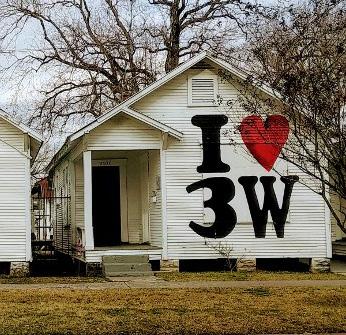
“Many, many people rushed away when Black people started to move in [to the Third Ward]. Now, they are calling us daily to find out if we want to sell our houses.”
Lana Edwards
Third Ward resident
investment and new services such as grocery stores, restaurants, and other amenities, they would also like to be able to maintain the community character and affordability and have a place in the neighborhood’s resurgence. With over 80% of the residents being renters and 50% of the residents earning less than $10,000/year, the fear of displacement is a genuine threat for the Third Ward’s African American community and along with it, the loss of African American culture as noted in the Third Ward Comprehensive Needs Assessment, 2019.
Along with these threats are many other pressing, inter-related issues, which have been heightened by the COVID-19 pandemic. These include:
f Housing inadequacy.
f Physical and mental health and wellness.
f Healthy food access and food insecurity.
f Meaningful, self-sustaining employment.
f Safety.
With the help of a generous grant from the U.S. Department of Housing and Urban Development (HUD), the Houston Housing Authority and the City of Houston embarked on a Choice Neighborhoods Initiative (CNI) planning process in December 2020. The process will lead to a neighborhood plan centered around the redevelopment of Cuney Homes.
The CNI launched during the Obama administration and focuses on three core goals:
f Housing: Improving distressed public and assisted housing with high-quality mixed-income housing that is well-managed and responsive to the needs of the surrounding neighborhood.
f People: Enhancing the quality of life for residents with regard to employment and income, health, and children’s education.
f Neighborhood: Improving conditions through public and private reinvestment regarding safety, economic development and commercial activity, connectivity and mobility, and parks and open space. All of these elements impact people’s decisions about where they choose to live.

When Cuney Homes residents were asked, What do you think are your neighborhood’s greatest strengths, the number 1 answer was “History and Culture of the Third Ward.”
And when residents of the Third Ward were asked if they worried about African American culture loss within the past 12 months, a majority—63.52% of residents— stated that they were “extremely” worried. Another 15.23% said they were “very” worried. (Third Ward Comprehensive Needs Assessment, 2019)
As Cuney Homes and community residents begin to explore a vision together, it is clear that honoring the neighborhood’s significance is a priority, while creating an innovative and forward-looking vision that integrates: varied housing opportunities, inclusive economic growth, resiliency for people and the community.
Repositioning Cuney Homes as a centerpiece of building Black wealth and economic prosperity will provide a critical path forward for achieving racial equity and addressing historic inequities in this community.
This CNI will also collect and retell the lesser known stories of this neighborhood—of vibrant cultures and music, entrepreneurship, and innovation and return this neighborhood to its rightful place in the community as a mixed-use hub of activity where all residents, businesses, workers and their families, students, and makers from all walks of life coexist and celebrate their shared achievements.

While much of the physical remnants of this history have disappeared, the collective consciousness of
this community lives on in its residents and institutions. This Third Ward-Cuney Homes Choice Neighborhood Plan will harness the opportunity to leverage ongoing local efforts and future investment to lay out an equitable and inclusive framework for the next 50 years of history that has yet to be written—one where all community members can afford to remain in their neighborhood of choice and benefit from economic and quality-of-life investments.


The first Cuney Homes Community Meeting was held on February 23, 2022. In honor of Black History Month, this meeting celebrated the life of Norris Wright Cuney. Participants were introduced to the newly selected Community Ambassadors who unveiled new branding for the Plan. The meeting concluded with small breakout sessions to discuss some preliminary findings from the Cuney Homes Needs Assessment. Forty-three residents participated.
In June and September 2022, the planning team facilitated visioning workshops that brought Cuney Homes residents, the broader Third Ward community, city agencies, and other area stakeholders and planning partners together to discuss and shape the emerging visions, guiding principles, and priorities of the Housing, Neighborhood, and People Plans.
The National Night Out event brings together law enforcement and neighbors, allowing them to enhance their relationships. The best way to build a safe community is to know your neighbor and your surroundings. This event allowed residents to rediscover their community and shape positive relationships between Houston Housing Authority, Houston Police Department, Harris County Sherriff’s Office, Third Ward Super Neighborhood Council, Houston Complete Communities, Cuney Homes Resident Council Board, elected officials, Cuney Homes and Third Ward residents while putting the Columbia Tap Trail Cuney Homes, in the spotlight. By maintaining relationships between local law enforcement, city departments, and community based organizations, we expect more open lines of communication and opportunities for our kids to participate in youth crime prevention programs like the Police Athletic League (PAL) and Police Explorer.
Night Out in October 2022.
Source: HHA
Visioning workshop in June 2022.
Source: KAMILLe DeVILLe
(top to bottom)
Food Pantry tour with Ambassadors.
Source: HHA
Plan Celebration in September 2023.
Source: WrT

After a clean-up pantry party with Cuney Homes Ambassadors, Council members, and the American Heart Association, a donation drive to collect nonperishable food donations from local organizations and community members was organized. The Cuney Homes food pantry received donations from the American Heart Association, Change Happens, and the HHA.
Around 50 members of the community, including Cuney Homes and Third Ward residents, attended the community meeting in the evening.
The evening community meeting goal was to share the development of the People, Neighborhood, and Housing core themes of the Choice Neighborhood Initiative. The planning team built on the input received through the process to share the overarching vision created by residents in the summer 2022 workshop, and the guiding principles and goals that would inform the Final Plan.
The meeting was positive and full of energy from the community that gathered that evening to give feedback and express their thoughts on housing typologies, open spaces, education and employment, and neighborhood strategies among other topics.

At the end of the planning process, on September 2023, residents of Cuney Homes and the Third Ward and partners met at the Third Ward Multi-Service Center to celebrate the Final Choice Neighborhoods Plan and the accomplishments made so far. The meeting was an exciting gathering to come together and celebrate all the milestones met and all the residents that have been part of the process, raising their voice and shaping the Plan.
Partners shared powerful words to build momentum and start acting on change, and shared a presentation summarizing the Choice Neighborhoods Plan.
The meeting included the video excerpts from the storytelling at SHAPE Center, bringing powerful stories of hopes, vision for the community, and what they want the Third Ward to be in the future: a thriving environment rooted in community and recognition of its residents.
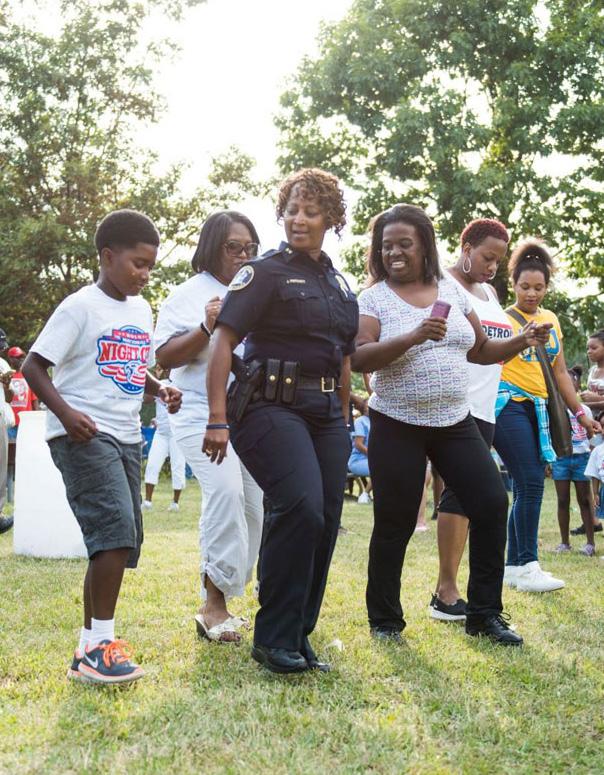
Goal 1: Increase the number of residents with access to preventive care including annual exams, screening, and dental cleanings.
Goal 2: Increase the number of residents with a neighborhood primary care physician and pharmacy access.
Goal 3: Reduce food insecurity by providing highquality, affordable food access for all Cuney Homes residents.
Goal 4: Increase awareness and access to mental health services and emotional health support.
Goal 5: Ensure that all the residents who would like to return to the Third Ward neighborhood are able to with support from Community Health workers.
Goal 6: Increase access and participation in physical activity to advance mental and physical health, wellbeing of Cuney Homes residents.
Goal 7: Increase access, participation, and awareness in quality Early Childhood Education by creating the Third Ward Alliance of Childcare and Early Education providers in the Third Ward-Cuney Homes Choice Neighborhood.
Goal 8: Expand awareness and support among Cuney Homes families for career-training opportunities and benefits and increase the percentage of high-school graduates entering college or career-training programs.
Goal 9: Increase opportunities and participation in after-school and out-of-school programs and provide enrollment assistance.
Goal 10: Increase household income through securing higher-paying jobs and opportunities for business ownership and entrepreneurship in the Third Ward.
Goal 11: Reduce the unemployment rate among workready residents by providing local job opportunities, regardless of criminal background.
Goal 12: Increase access to employment for youth ages 14 to 21.
Third Ward, a place to grow and enhance community wellbeing and resilience through active resident engagement, connection to its history, educational opportunities, and pathways to building wealth. and culturally responsive health and wellness resources.
Create vibrant destinations to strengthen the local economy (walkable, mixed-use corridors with housing, and local businesses).
Build household wealth by creating job opportunities and skills training for neighborhood residents in partnership with local anchor institutions.
Promote quality businesses by addressing nuisances, creating pop-up shops, and building the capacity of local entrepreneurs to launch and grow businesses.
Improve community health and wellness by increasing access to support services, quality healthcare, affordable fresh food, and safe outdoor recreation.
Integrate quality, affordable housing along key corridors and retain existing residents through tools that limit displacement and increase economic support to existing homeowners and renters.
Enhance the physical environment by honoring the history and creating a positive identity through a coordinated art, branding, and placemaking strategy that, in part, repurposes vacant lots.
Ensure residents of all ages can thrive in the neighborhood by creating social, educational, and recreational opportunities for youth and seniors.
Celebrate People, History, + Culture by building and strengthening the sense of place and community through cultural programming and preservation efforts that celebrate the Third Ward history as a thriving center of African American culture— a destination where you can expect to find performances, landmarks, markets, and social events that celebrate the rich heritage and contributions of Black Houstonians.
Increase transportation access through an affordable, multi-modal transit network that provides convenient access to Cuney Homes, the Neighborhood, and the City.
Address neighborhood safety concerns by building stronger relationships, expanding local programs, ensuring safe mobility, and addressing loitering.
Empower community through neighborhood planning, inclusion, and advocacy.
Goal 1: Establish a sense of place through the recognition of community history.
Goal 2: Provide inclusive community gathering and recreation spaces through accessible design for persons with disabilities, spaces to keep both seniors and youth active, and maintain multi-generational spaces and educational spaces.
Goal 3: Improve access to basic needs, services, and amenities within walking distance of Cuney Homes and in the Third Ward. Enable residents and Black businesses to fill current gaps.
Goal 4: Establish Cuney and the Third Ward as a safe and resilient community with better relationships with law enforcement, community resources, and activated vacant lots and open space.
Goal 5: Connect residents safely to transit and Complete Streets. Provide more accommodating and safe transit stops, improved sidewalks and street crossings.
Goal 6 : Provide spaces and opportunities for civic engagement. Build political power through leadership capacity building and political engagement.
A resilient community through connections, accessibility, relationships, and recognition of the history.
 Project Row Houses installation.
Source: WrT
Project Row Houses installation.
Source: WrT
On-Site: 821 Mixed-Income

Rental Homes, 46 Affordable Homeownership Units
Off-Site (Emancipation West and East): 297 MixedIncome Rental Homes;
Off-Site (New Hope Housing Gray) : 135 MixedIncome Rental Homes
One-for-one replacement of 553 public housing units.
Additional 447 affordable rental units; 46 affordable homeownership units; 253 market rate rental units.
Preserve and celebrate the history, culture, and character of the Third Ward in art, murals, landmark signage, and wayfinding with QR-codes that share stories, and streets named for significant Third Ward residents.
Create a distinct place that speaks to the Black community and says Third Ward , preserving the small scale with a maximum of 3-4 stories, front porches and courtyards, gabled roofs, and green spaces.
Increase safety for all ages and businesses through design, lighting, and disaster resiliency planning, including safe play spaces for children.
Foster a sense of community by organizing housing in clusters and weaving in seating/gathering areas outdoors.
Design with all residents in mind , using a range of housing types and amenities for people at different stages of their life (seniors, those with disabilities, in transition, youth, families, single parents) and maintain affordability.
Integrate amenities that build skills, education, and wellness such as a learning and rec center with programs and activities (tech lab, job training, portable library) for all ages as well as playgrounds, outdoor fitness, and community gardens.
Limit displavcement by maintaining permanent affordability, incentivizing resident return, and helping existing homeowners remain in their homes.
Create safe access to stores and services nearby , particularly a co-op market, an incubator for entrepreneurs, community kitchen, entertainment, and job opportunities (including for youth).
Link new housing to reliable Metro routes and encourage other forms of transportation (bike lanes and racks, bus shelters, scooters).
Incorporate energy efficiency and green infrastructure into the design including solar energy, green roofs, rain gardens, solar shading.
Use (and even reuse) lasting materials like brick, textures, and cobblestone crosswalks to create a sense of longevity and quality.
Goal 1 : Preserve and increase affordable housing within the Third Ward.
Goal 2: Limit displacement of Cuney Homes and Third Ward residents.
Goal 3: Redesign Cuney Homes as a welcoming place that fosters community and celebrates the historic character and rich African American culture of the larger Third Ward.
Goal 4 : Create a community that fosters health, wellness, and safety for residents and visitors of all ages as well as businesses.
Goal 5 : Support the needs of seniors and residents with disabilities.
A close-knit community through the preservation of the history and culture.
The reimagined Cuney Homes, a vibrant, culture-based, closed-knitted community.
A lively environment where gathering areas, active trails, and assets welcome community and relationships.
 The redeveloped Cuney Homes.
The redeveloped Cuney Homes.

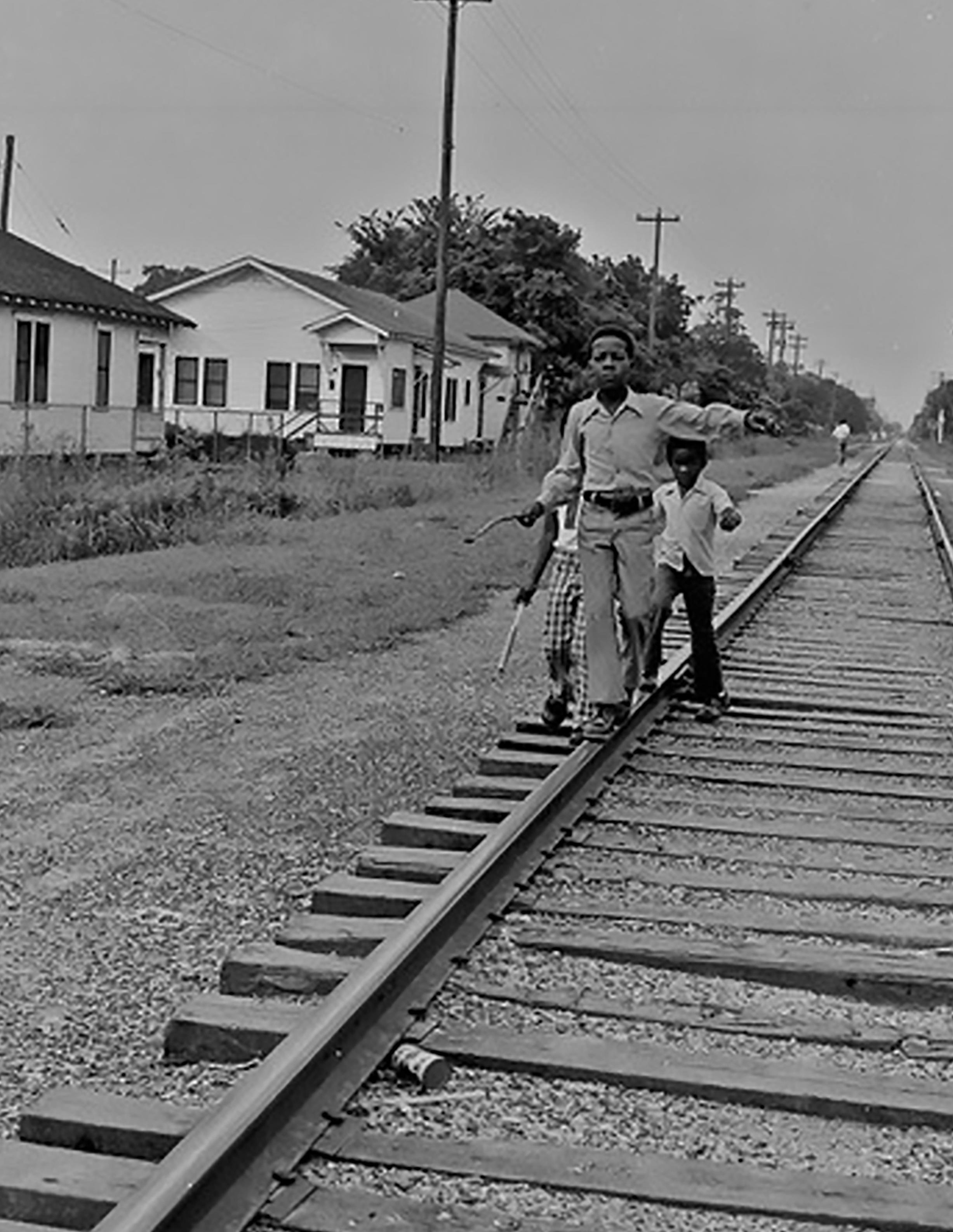
For many generations, the Third Ward was the political, economic, social, and cultural center of Houston's African American community.

1840s-1880s
Houston was settled in 1836 on the banks of the Buffalo Bayou, inland from Galveston Bay. The original four Wards were established in 1839, with the intersection of the four in the heart of modern-day Downtown Houston.
As of 1848, 22.4% of Harris County's African American population was still enslaved. Those who had already gained their freedom were beginning to settle in the Third Ward, southeast of Downtown. The first African American congregation in Texas, Trinity United Methodist Church, was founded in 1848.
Juneteenth
In 1863, President Lincoln issued the Emancipation Proclamation, but many enslaved African Americans did not gain their freedom until June 19th, 1865, when word of the Emancipation Proclamation finally reached Houston. In 1872, a group of formerly enslaved Third Ward residents purchased a tract of land that become Emancipation Park to commemorate Juneteenth. This celebration of African American freedom is now a federal holiday.
the Third Ward,
notice that artists and cultural advocates have a long legacy of celebrating events like Juneteenth. Last year we celebrated the 150th anniversary of Juneteenth celebrations at Emancipation Park.”
1840s
1836 Houston is established along the west bank of Buffalo Bayou
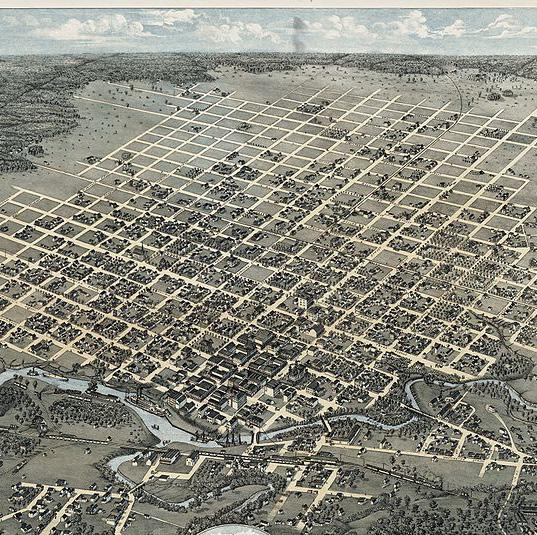

1840
The Ward system is established
1850s
1848
A small mission for the slave membership of Houston Methodist Church was formed, one of the first African American congregations in Houston
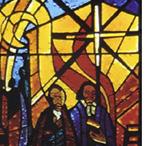
1840-1890
The Third Ward is a thriving neighborhood
“In
you’llRUEROB Jackson Third Ward resident
Shotgun houses in the Third Ward in 1930s and after renovation by Project Row Houses


Many shotgun houses still remain in the Third Ward, notably the ones preserved by Project Row Houses. This house form was spread widely through house catalogs, and was designed to be built quickly as the neighborhood developed, with narrow frontages and cross-ventilating windows. By the 1880s, 25% of Black households in the Third Ward were homeowners.
The "Father of Black Houston," Jack Yates was born a slave in Virginia. He went on to found the Antioch Missionary Baptist Church, the first Black Baptist Church in Houston, and later started the first school for Blacks in Houston. He played a key role in the purchase of the land that would later become Emancipation Park.


1860S
African Americans arrive to the Third Ward and settle
1860s
1870s CIVIL WA R & EMANCIPATION

1872
1870 Segregation is codified in Texas
Former slaves purchase city land that becomes Emancipation Park
1880S
About 25% of Black households in the Third Ward are owner-occupied
1880s
1880S
The emergence of house catalogs brings regional housing styles. The shotgun house is commonly found in Houston’s Black communities
Although President Abraham Lincoln issued the Emancipation Proclamation on January 1, 1863, it was not until June 19, 1865 that federal troops arrived in Galveston, Texas to ensure that all enslaved people were freed. And less than 10 years later in 1872, a group of community members, all former slaves, purchased 10 acres of land in Houston for $1,000 to create a place for the community to celebrate “Juneteenth.”
Emancipation Park was Houston’s first park, and the only public park and swimming pool open to African Americans in Houston until the 1950s. It is now protected as a state historic landmark (2009).
In 2006, Third Ward natives Carol Pratt Blue and Bill Milligan, formed “Friends of Emancipation Park” to revitalize the facilities. Beginning in 2010, Emancipation Park underwent a significant renovation designed by Mr. Phil Freelon, an internationally recognized African American architect whose firm designed the Smithsonian Museum of African American History and Culture in Washington DC.
The $33.5 million renovation preserves the park as a living monument designed to enhance the health and wellbeing of the community with a cultural center, outdoor blessings theater, aquatics center, picnic pavilions, a commemorative monument, an indoor gym, a playground, tennis courts and a baseball field, and a lawn for community gatherings.
Sherry Browning Third Ward resident"[My favorite is] Emancipation Park. (...) They have Juneteenth programming. It is Black history. (...) and it is good for the kids to learn about history and the history of the park.
This enduring symbol of civic pride and resilience, established by the founders 150 years ago, rippled around the world and is now anchoring the community’s revitalization at the heart of the Third Ward along Emancipation Avenue.
(top)
Passive recreation areas in Emancipation Park and walking path.

Source: MArK HerBoTH
(middle, front left to right) Emancipation Park displays.

Source: KAMILLe DeVILLe
Emancipation Park entrance.

Source: MArK HerBoTH
(left)
Lively play spaces in Emacipation Park.
Source: AYALA VArGAS PHoToGrAPHY

The Third Ward was already growing rapidly by the turn of the 20th century, and this growth only accelerated during the Great Migration of the 1910s-1930s, with waves of African American families from the rural Deep South resettling in the Third Ward. It was during this era that many of the neighborhood's institutions and anchors were founded.
As Houston continued growing into the postwar 1950s, the city identified a need for highways bypassing congested urban neighborhoods for the growing suburbs. Like most other American cities, Houston's African American neighborhoods were targeted for clearance to construct these highways: much of the western section of the Third Ward was demolished in the 1950s for Interstate 45. Texas State Highway 288 followed in the 1960s, further dividing the neighborhood from Downtown and Midtown Houston.
1893
The Texas Freeman, a newspaper for African Americans launches

1910 First wave of the Great Migration
1916 Blackshear Elementary School is built
Clarice Freeman Third Ward resident“We have a route running through that connects us to other parts of the city. I have lived to see two routes intersect our neighborhood. They just torn down and destroyed in order to accommodate this particular way of going through the center part of this city.”
1918 Houston Negro Hospital and Nursing School opens, the first non-profit hospital serving African Americans

1920s
1927 Texas Southern University is established
In 1930, C.F. Richardson started the Houston Defender, a Black-owned newspaper that took a position of community advocacy.
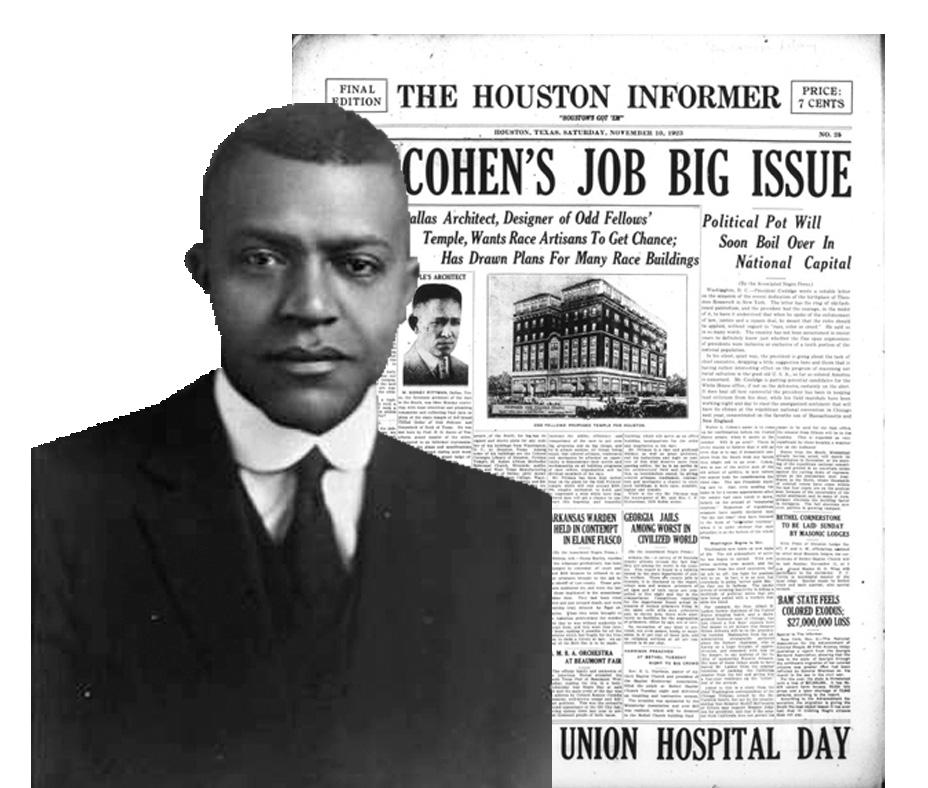
Reverend Ray Martin founded the Progressive Amateur Boxing Association in 1968. It was dedicated to introducing Third Ward youth to the sport, with the goal of keeping them off the streets by serving as a counseling, resource, and educational center.


Robert Meeker bought radio station KCOH-1430 in 1953, making it the first Black-owned station in Texas. Its programming was centered around public service for the community.

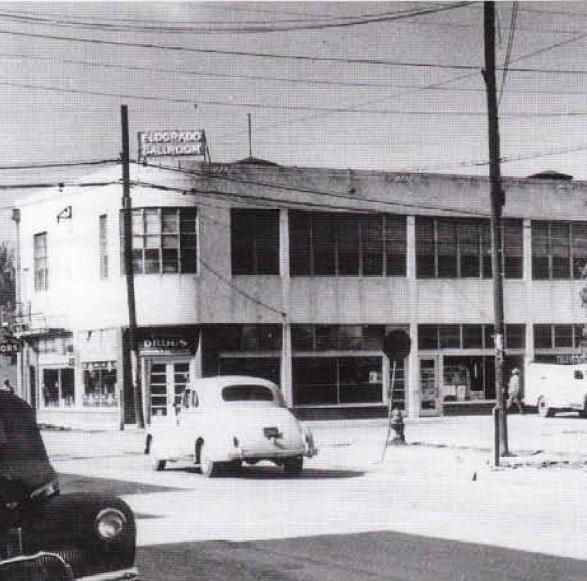

Source:
KCOH
Source:
Reverend Ray Martin and Progressive Boxing and Community Center.
Source:
In the first half of the 20th century, negotiations in the government to transform federal housing policy suggested that the government’s active role may well be abolished, this also led to the appearance of tenement reform laws that forged a role for local governments to set standards and regulate housing safety. The Public Housing Conference in New York City brought together social workers and housing experts to advocate for federal and state housing legislation. Its members sought to tear down slum apartments and construct low-cost housing.
The United States Housing Act of 1937 (Wagner-Steagall Act) created the United States Housing Authority, a public corporation under the Department of the Interior, which offered $500 million in loans for low-cost housing.

Established in 1939, with its doors opened in 1943, Cuney Homes, named for Norris Wright Cuney, a prominent African American leader in Texas during the late 1800s, was the first development of the Houston Housing Authority.

 Veronica DeBoest Cuney Homes resident
Veronica DeBoest Cuney Homes resident
"[They] became the fastest runner and won a lot of trophies. Now he’s a rapper, and he comes back and gives back. (…) That’s what Cuney Homes is. We have always taken care of one another. That’s what makes us all a family.
Third Ward is a bustling center of African American economic, social, and civic life. 1937 United States Housing Act of 1937 1943 Cuney Homes opened its doors
Dr. Alvia Wardlaw
Alvia Wardlaw is an American art scholar, and one of the country's top preeminent experts on African American art. Alvia grew up and lives in Third Ward and is the Curator and Director of the University Museum at Texas Southern University.

Dr. Alvia Wardlaw
Source: PAPer cITY, PHoTo BY MAX BurKHALTer
Beyonce and Solange Knowles
Source: GeTTY IMAGeS
Debbie Allen and Phylicia Rashad
Source: GeTTY IMAGeS
1964
Civil Rights Act of 1964 mandated desegregation

Beyoncé and Solange Knowles
Long before the sisters grew to fame and dominating the charts, Beyonce and Solange Knowles were growing with big dreams in Houston's Third Ward.

Debbie Allen and Phylicia Rashad

Debbie Allen, a choreographer, dancer, Tony nominated actress, producer & director and her sister Phylicia Rashad, a producer, director and actress grew up in the Third Ward.
1997 Modernization of Cuney Homes

2000s
1970s 1980s 1990s
1977
Larcenia Floyd, a single mom of three, settled in Cuney homes

TODAY
Gentrification and housing market pressures now threaten the capacity of the community to remain in their heritage homes with development putting pressure for evictions and newer housing.
1969
The last 50 years in the Third Ward have been marked by strong involvement in civil rights, the founding and growth of grassroots community movements and organizations, and an evolving movement for racial justice and police reform through Black Lives Matter.
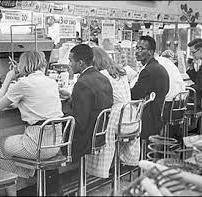
[What is special about this community is] that it's cultural, it’s rooted, and it's historical. It is a monument to my life and the children that come after me. And it’s very ancestral. It’s very ancestral for me. A lot of my elders and ancestors have done the work in the community, have been a part of the community, and have lived in the community."
1989 Change Happens opens to support families
1960
A sit-in by TSU students inspires others nationally to address racial inequality
In response to emerging development speculation in recent years, a range of neighborhood and city plans have continued to build a foundation to ensure the preservation of the Third Ward community. The recent renovation and expansion of Emancipation Park and community center have become the face of this commitment to celebrating the vibrance and resilience of the Third Ward. This collective celebration of the neighborhood's deep heritage, history, and culture is a crucial cornerstone of any community planning efforts moving forward. 1970s 1980s
S.H.A.P.E. Community Center is founded to improve the quality of life of people of African descent
1979 Community Music Center opens
1990s
1993 Project Row Houses is launched
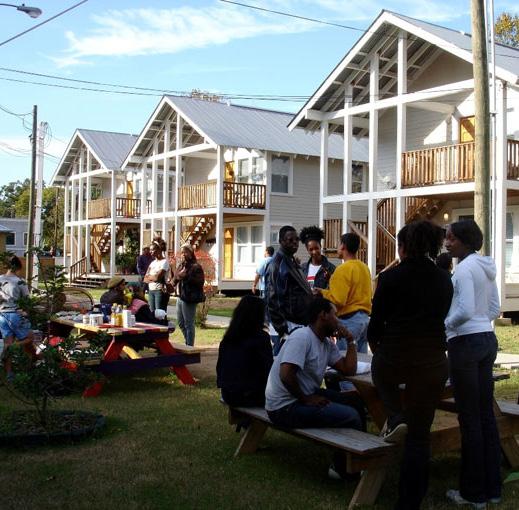
Pat Parker was a poet who wrote frequently between 1960 and 1990 of the challenges she faced growing up in the Third Ward. She was also involved in wide-ranging activism, and formed the Women's Press Collective.

2001
Yellowstone Academy opens to educate low-income students in The Third Ward
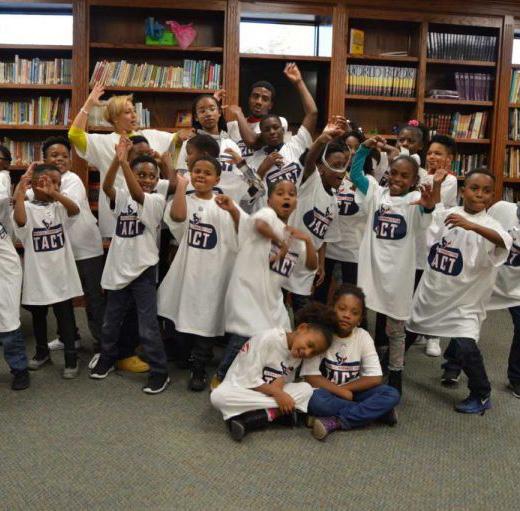

In 1979, Patricia Johnson and Ron Scales founded the Community Music Center, seeing that the legacy of "American Negro Slave Music" was being lost. The organization aims to preserve this musical tradition through education and performance.
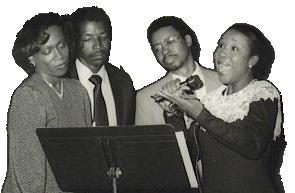
2003 Workshop
Houston is created
The Third Ward fabric remains unchanged due to deed restrictions
2017
$33.5 million renovation of Emancipation Park
2020
George Floyd is killed by a police officer in Minneapolis, igniting historic protests. The Black Lives Matter movement aims to address racial inequities



In Houston's Third Ward, we are planning for its greatest asset - its people. We continue to find inspiration in the resilient lives of people who endure unimaginable hardships in places like the Third Ward. But there is celebration too. Pride and joy in the faces of beautiful children, revered elders, and accomplished astronauts – so precious they’re vaulted in community treasure boxes. There is celebration in the voices of community members who participated in the Third Ward-Cuney Homes storytelling event while sharing powerful stories of love, Third Ward pride, community, and their vision for the future. These stories are powerful memorandums that we have to learn from the past to move forward into the future. Third Ward is full of opportunities and dreams of the people that form the neighborhood.
Cuney Homes and Third Ward residents shared their memories and hopes so we can continue forward into a thriving Third Ward.





The heart of the Third Ward community is its people, its assets, the interaction between neighbors, and the organizations that strive to work towards the future of Third Ward. The opportunities that residents and local organizations alike create are a living testimony that the heart of Third Ward is a welcoming and caring place. The legacy of those who passed has been carried over to the future, and now, more than ever, residents of the Third Ward are striving to advance towards a welcoming, community-based Third Ward.
Because in 1978, my husband, State Representative Al Edwards filed to run for office. And he won! So that meant we were in the right place at the right time. We had an exciting life after that, because we had three children. And then he was the one that sponsored the bill making Juneteenth a state holiday, his first year in office. So Third Ward, it means a lot to us.
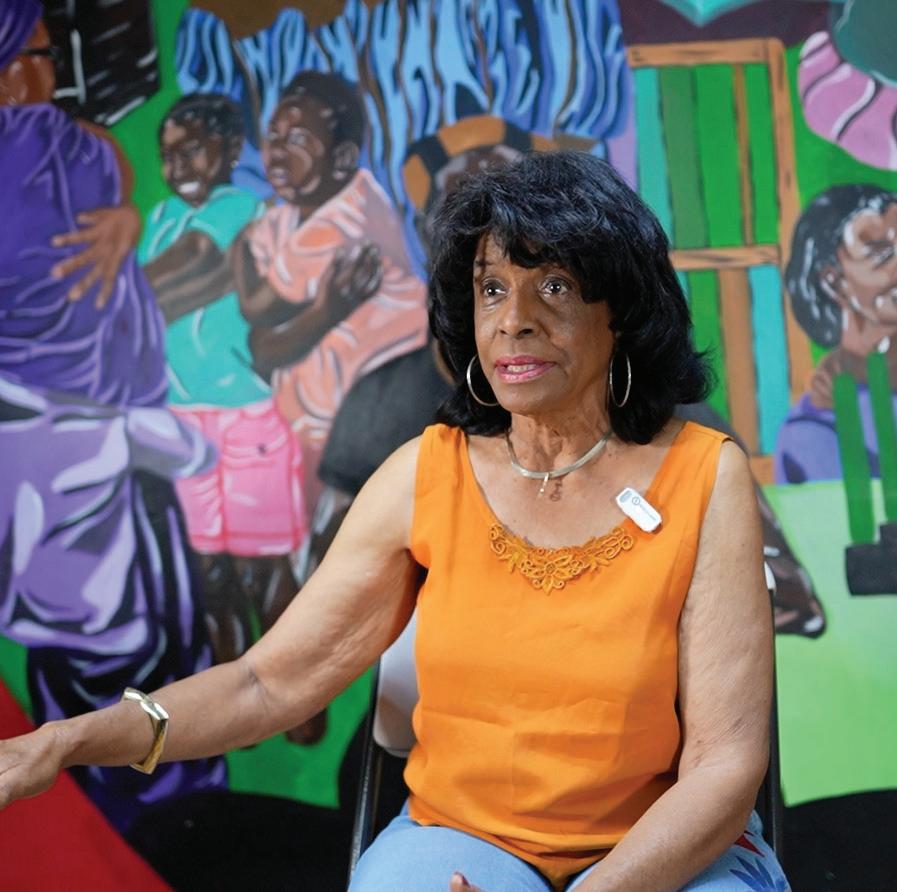
They tell me I’m the mother of the hood, Cuney Homes. Everybody now calls me Mama Erma. Love, there’s the heartbeat of the community, right there, the love and care and having people. I give it back because I help everybody in Cuney Homes, young mothers that need anything. I got the babies. I raise a lot of babies.

Support and carrying on my arms, my five sisters - that was my greatest experience and trying to get them to share and learn about everything.
The Third Ward community, especially Cuney Homes, was a highlight because we had a beautiful yard. Flowers along the side. We had a garden in the backyard.

Third Ward is a microcosm of the entire African American community in Houston, Texas. In Third Ward, you have everything encompassed in one small area - we have our own River Oaks. We have our own business district, we have our own athletic district, we have our own university.

What’s special about this community is that it’s cultural, it’s rooted. It's historical. It is a monumental to my life and the children that come after me. And it’s very ancestral. It’s very ancestral for me. A lot of my elders and ancestors have done the work in the community, have been a part of the community, and have lived in the community.

Residents and Third Ward neighbors have expressed the importance of learning from the past to create a better future. Third Ward is a historical neighborhood rooted in community; leaders, local community organizations, neighbors have shared what Third Ward means to them, and what is important to carry into the future to make sure the Third Ward is a thriving community with opportunities for all. The Third Ward community is ready to work together to create synergies between neighbors and organizations, and advocate for their residents needs to create a better future for all.
And Third Ward is a place that grows people especially, if they get a chance to come into places like S.H.A.P.E. Community Center, that gives you the ability to know that you’re worthy of having what’s better than what you have. So being in Third Ward, as an African American, you can see the roots of pain, but you can also see the progress of getting over it with the passion that people have.

We had a computer lab at the Cuney Homes. And for a little while, nobody was donating laptops. And one of my friends was a basketball player at the time. And his friend, that’s what he would do, refurbish computers and laptops for kids that were in need.

God called me to take care of everyone, but especially what we call the least, the last, the lost, and the unloved. A lot of times, if you look at building something, you want to look at the top, you want to just appeal to the top, He called me to appeal to the bottom. But also what He told me is that one day, the very people who were looking down on Third Ward would be flocking to Third Ward.
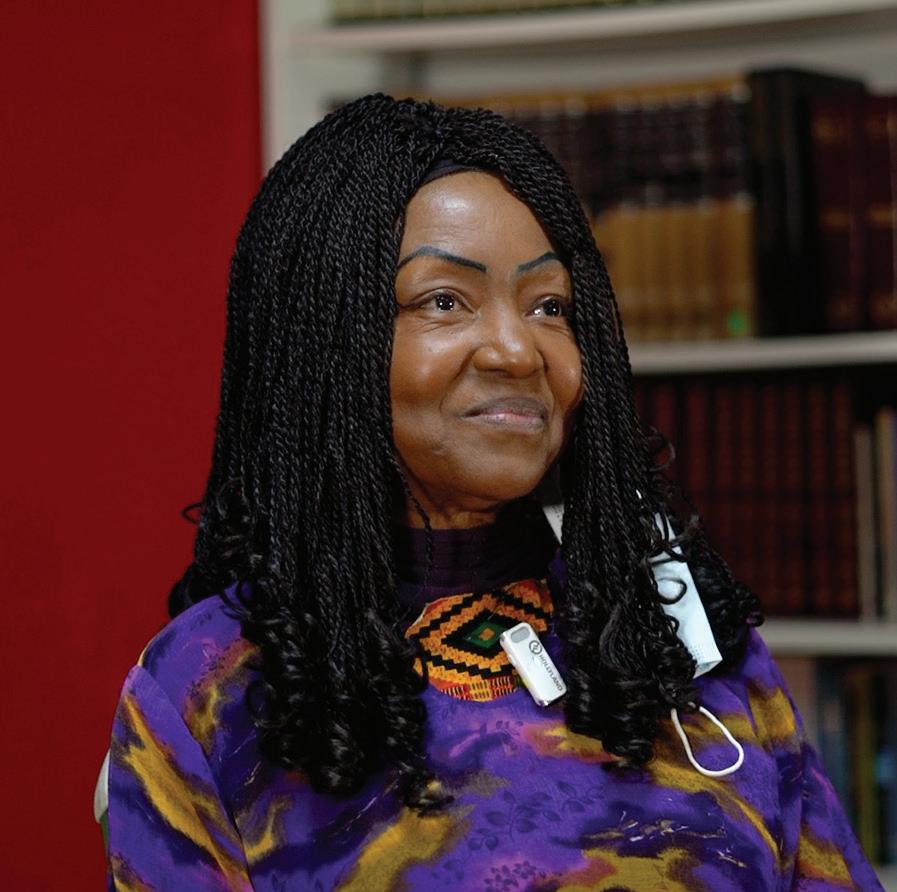
I’d like to see more Black businesses. I would like for them to come together and work with Cuney Homes. But we got a lot of work to do. We need to start learning how to work together. And once we learn how to do that, we’ll be alright. Got a lot of resources right here in Houston. Just work together.


The community vision for the Third Ward strives to make impactful change. Helping each other build a better future will entail celebrating the history, culture, and the voices of the Third Ward and building upon them. The vision reimagines the Third Ward as a culturally responsive community, with active awareness, connections, and accessibility to resources to help each other thrive into the future.
Look at Houston! It’s amazing! I would want it just to continue growing the way it has been with a vision of it being better, not going backwards. We want them to understand that they’re moving into an area where they’re going to have the responsibility of helping to maintain and better the area. We know that, then you’ve got to make a difference.

Well, what makes Third Ward so special is, it’s a hub, whether a lot of people do realize it or not. It is the Mecca hub of Houston. It was like that back when I was doing my thing. And it still extends itself. You want to get a real cultural base, you’ve got to come to Third Ward.

And I’ve been all over the world as a matter of fact, around the world about three and a half times plus. But I haven’t seen a community that was any better than this. And I was able to help my mom and dad buy a home in the Third Ward at 15 years old. And I’m the last of the living from when I moved in that area. My vision for this community is for people to gain a better heart about life.

I hope that they get everything that Cuney Homes residents wish to get out of this, and the houses could be rebuilt beautifully and torn down and turn everything around and be a safe place for everyone to live in.

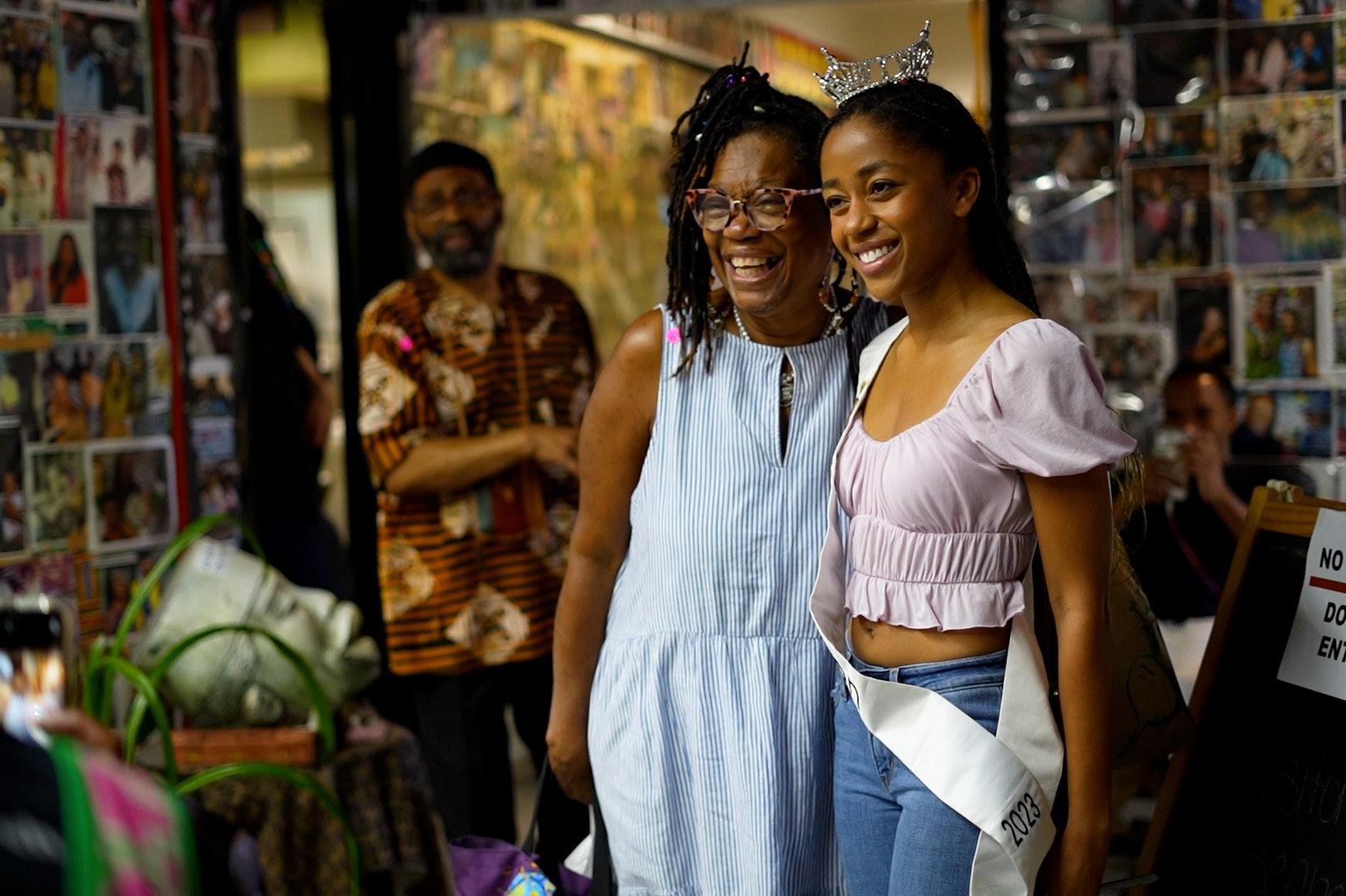
Residents have been engaged with the community long in the past and they will decades come. Third Ward advocates and individuals alike strive to help their neighbors thrive and live a better life. Neighbors recognize the importance of a close-knit community and the impacts others have made in their lives. They create safe spaces, and creative and learning environments for each other. Community leaders strive to bring social change to their neighbors through advocacy environments. Residents are keeping the legacy alive by creating deep connections and drawing tangible outcomes for the future of the Third Ward together.

My father was a prominent football player and went to the state championship game in 1992. Unfortunately, he passed in 1999, to gun violence in the community. And so I keep his legacy alive by the work that I do in Third Ward. And make sure that residents as well as artists, and creatives, have safe spaces, and make sure that they are in fact heard, and on the frontlines of social change.
I love Third Ward, Third Ward has been so good to me and my family. And I’m just in love with the people. It’s like a family. I enjoy being around the people. It’s like, you wake up, everybody’s waving. Everybody knows each other. We just show each other love. We’re a big family.
“What school you going to? Let’s get on over there.” Not only will I get you back to school, I called the principal and the teacher, I knew 99% of them. A lot of kids came back to give back to the community. And that’s what made me so proud - at least I did something right.



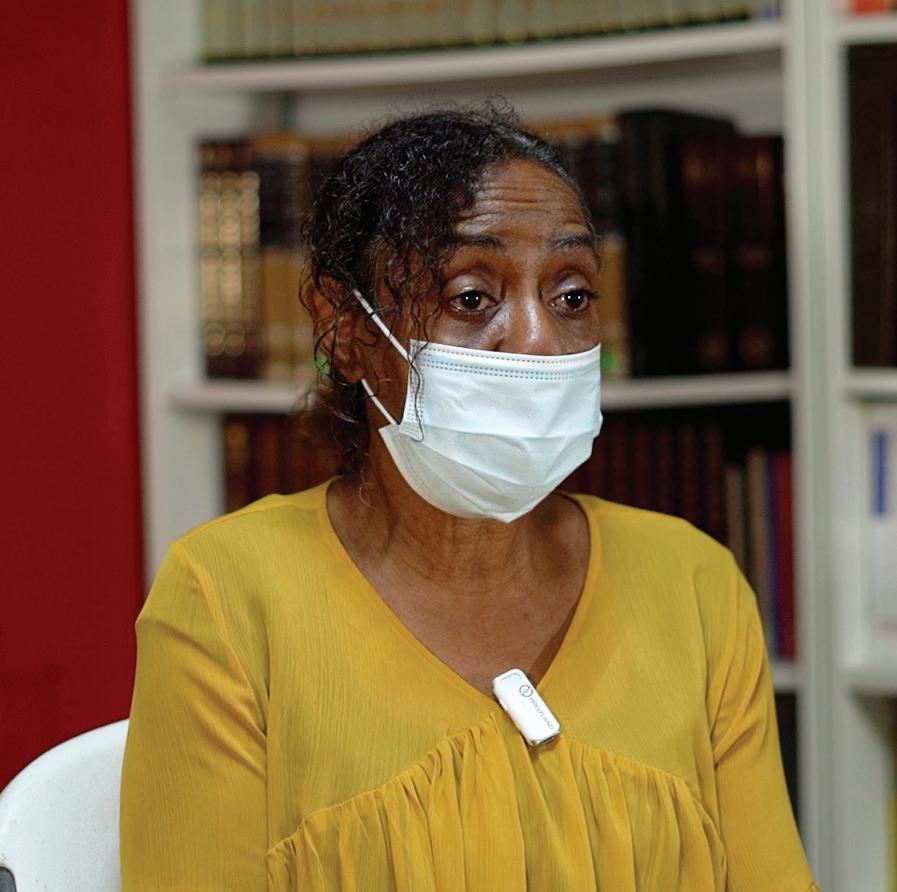
What I thank God about so much is that a lot of our kids finished school, went to college, and they got their own businesses. One rolled by me the other night, and he is a Commander now. “I probably wouldn’t have been running the track!” But he did. And he’s doing great. And there are others that come back and tell me about themselves.”
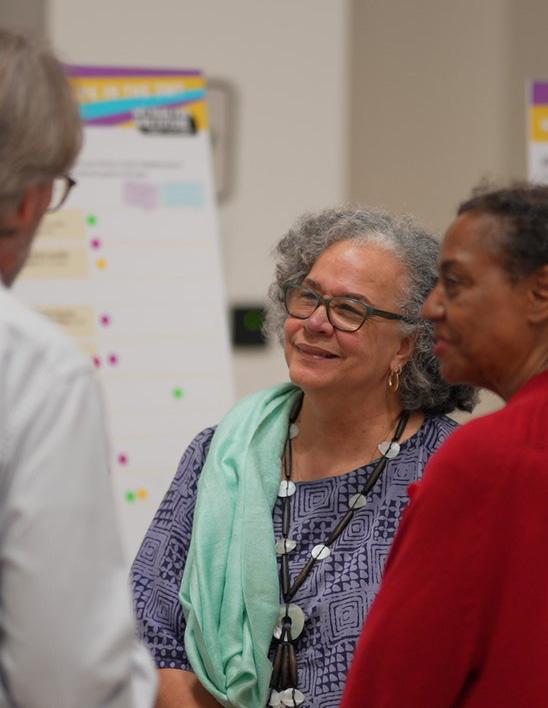
Shaping a path for the future redevelopment of Cuney Homes and the Third Ward involves an inclusive planning process to ensure current residents have a place in the Third Ward’s rebirth. It is centered around the Third Ward’s deep tradition of civic activism.

The Third Ward-Cuney Homes Choice Neighborhood Plan falls within a continuum of several recent neighborhood planning efforts focused on revitalizing the historic African American Third Ward community. While some residents of Cuney Homes have been active in these efforts, it is critical that the planning process puts Cuney Homes residents at the forefront and helps bring their insights and aspirations into the collective vision for the Neighborhood. It is also important that the planning process brings together area residents and partners who have been working tirelessly to preserve and restore the Third Ward.
Cuney Homes is the first housing development completed by the Houston Housing Authority (HHA) in 1939. HHA provides affordable homes and supportive services to more than 58,000 low-income Houstonians, including over 17,000 families taking part in the Housing Choice Voucher Program and another 5,700 families living in 25 public housing and tax credit developments around the city. In addition to providing safe, affordable homes, HHA offers programs for residents to enhance their education, improve their health, and meet their economic goals.

The City of Houston is the fourth largest city in the US. It is also one of the most diverse and fastest growing cities in the country. The Housing & Community Development Department (HCD) strives to create opportunities for all Houstonians to have access to safe, affordable homes in communities where they can thrive. HCD administers federal grants such as the Community Development Block Grant (CDBG), HOME Investment Partnerships Program (HOME), Housing Opportunities for Persons with HIV/AIDS (HOPWA),
and Emergency Solution Grants (ESG). HCD is the co-chair of the Housing Task Force with HHA.
The City’s Planning and Development Department is also playing an integral role in the Third WardCuney Homes Choice Neighborhood planning process as a Co-Chair of the Neighborhood Task Force. The Planning Department focuses on city-wide planning initiatives that aim to grow and preserve Houston’s diverse communities to create a resilient city.
The department recently partnered with the Mayor’s Office on the Third Ward Complete Communities Action Plan to uplift this historically under-resourced neighborhood. Current initiatives include: Livable Places Houston, Houston Bike Plan Walkable Places, and an Accessory Dwelling Units Design Book.


Based in Third Ward, the Sankofa Research Institute is playing a pivotal role in the Third Ward-Cuney Homes Choice Neighborhood planning process as Co-Chair of the People Task Force and the local engagement partner. Sankofa was founded by a passionate community activist, Assata Richards, who grew up with her family in Cuney Homes and has deep roots in the Third Ward.
Ms. Richards understands the importance of data and community. The Sankofa Institute engages with individuals in research that creates knowledge for identifying, developing, and advancing innovative strategies to build effective communities so that all residents may live more meaningful lives with dignity. Drawing upon its specialized expertise, Sankofa administered the Cuney Homes Resident Needs Assessment and analyzed the findings.
Steven Dow, former Executive Director of Houston Local Initiatives Support Corportaion (LISC), is working with Sankofa Research Institute to Co-Lead the People Task Force, drawing upon the Needs Assessment data and secondary data, to assist in shaping the plan.



Residents of Cuney Homes and the Choice Neighborhood are invited to play an active role in the planning process by serving on every Task Force to help directly shape the overarching vision, goals, and strategies for the plan. They are also invited to attend community meetings and special events, and remain up to date through regular updates.
Stemming from the Third Ward’s rich tradition of civic activism, numerous community organizations are working to create positive change in the neighborhood today. As a result, the Choice planning process is not starting from scratch but building on these efforts by working with area residents and organizations to stitch together a shared vision for meaningful change. These partners and stakeholders are serving as members of each of the three Task Forces and also sit on the Steering Committee to ensure the goals of these plans are carefully aligned.
Community meeting in June 2022.
Source: KAMILLe DeVILLe Children's Kwanzaa.
Source: HHA
Community meeting in March 2023.
Source: WrT
The planning team comprises three Task Forces— Housing, People, and Neighborhood—which correspond to the three main objectives of the Choice Neighborhoods Initiative. The Task Forces bring together many voices from residents of Cuney Homes and larger Third Ward, to community-based organizations, city agencies, and service providers. The Task Forces meet regularly to discuss challenges and opportunities facing the neighborhood, and ways to build on previous efforts. The Task Forces will identify priorities and a vision for the plan, and are also charged with developing strategies to achieve the goals, identifying partners to implement the strategies, and outlining metrics to track progress.
Our Community Ambassadors are an important part of the planning team’s make-up. Several Ambassadors sit on the Task Forces but they also met independently to provide an extra layer of focused review and feedback. The Ambassadors held focus group discussions for Cuney Homes and neighborhood residents in the spring of 2022 that were centered around specific elements of the plan. They also served as a two-way conduit, sharing information with their neighbors and gathering feedback for the planning team.
A two-year planning process can feel like a very long time to get excited about the possibilities and not see any physical changes. Early Action Activities are designed to keep the momentum going by identifying some activities that can be implemented while the plan is being completed. A small portion of funding is included as part of the HUD grant for projects designed to jumpstart transformation of the neighborhood that are limited to physical improvement, community development, and economic development. Ideas for these activities are being developed directly from the Cuney Homes Needs Assessment findings and discussions with the Task Forces.
A Committee set up in April 2022, comprised of Cuney Homes residents, Community Ambassadors, and members of the Task Forces began to meet to review ideas and select the preferred activities. In turn, detailed plans are in progress and now being completed successfully.
Source: WrT
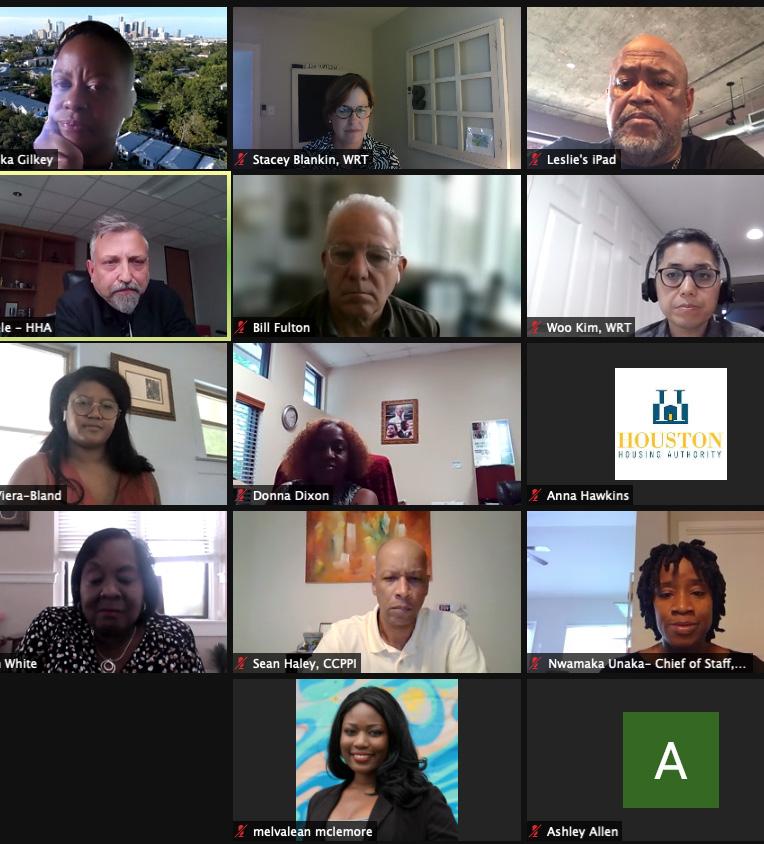
(…) the memory is that [community leaders] were heroes, we saw them everyday in our community doing good things and making sure we were safe playing on the streets of Third Ward.”
Chris Tucker Third Ward resident
I have lived in Cuney Homes for 23 years. I know that my outlook about Cuney Homes changed. My son started making friends. My daughter, an introvert, also became active with residents and they looked out for her. That’s why this is so important to me. Most of the time, people with disabilities aren’t included. But at Cuney Homes, my daughter was included in this community and people embraced her.
If we can achieve one thing with the Choice Neighborhoods Initiative, what do you hope it will be?
I believe the Transformation Plan could set a precedent for revitalization projects, by including the voices of previously disenfranchised members of the community and seeing their efforts realized and valued through the process. I also think this could be a great community building opportunity for the diverse members of Third Ward.


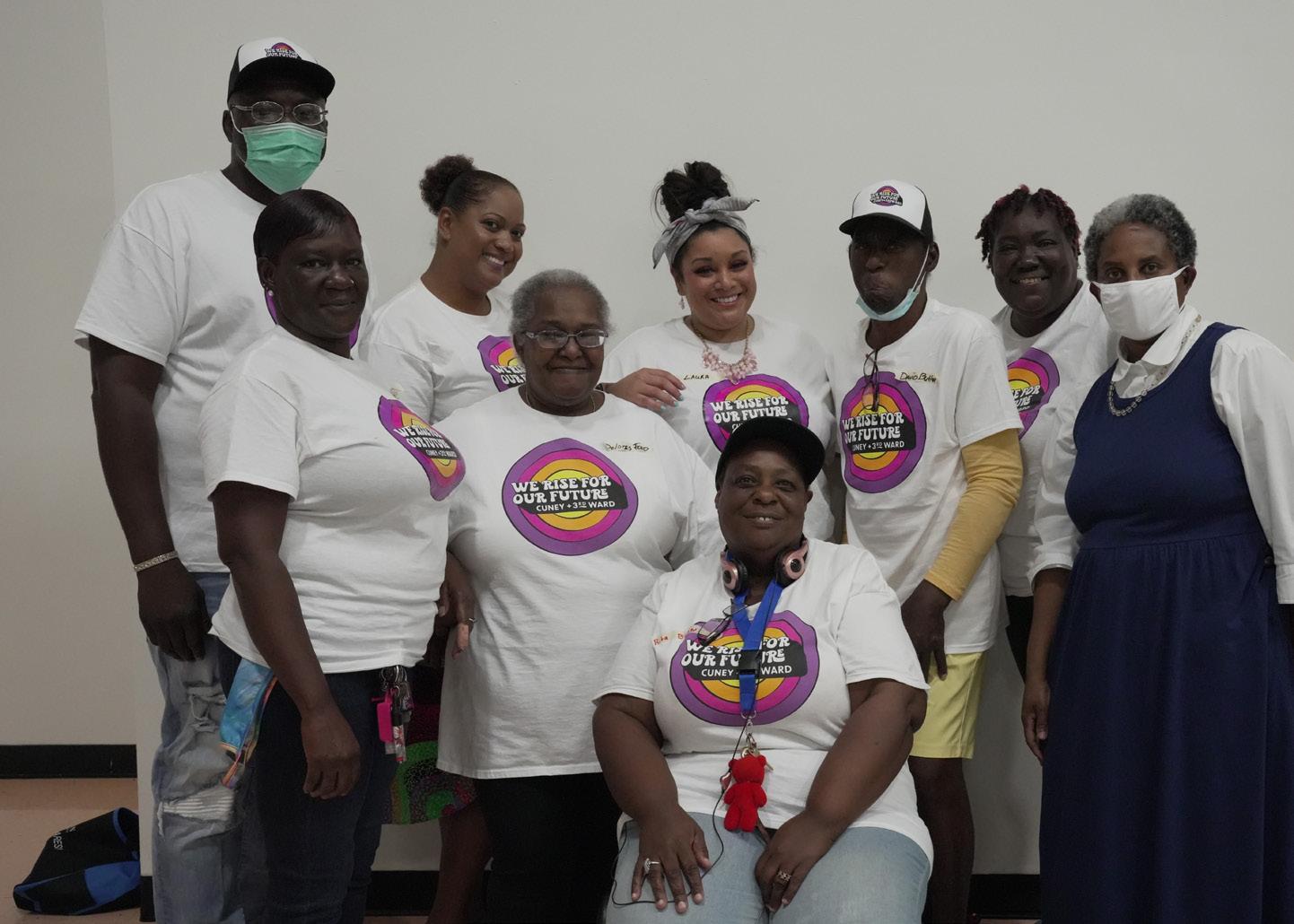
"My daughter, an introvert, also became active with residents and they looked out for her. That’s why this is so important to me."LauraWelch
"I also think this could be a great community building opportunity for the diverse members of Third Ward."
If we can achieve one thing with the Choice Neighborhoods Initiative, what do you hope it will be?


I hope this effort leads to more entrepreneurship for the residents where they will receive funding for their services. The residents often walk away with nothing but bear the responsibility to see efforts through. I want them to utilizing the Section 3 program through training and applicability. I want them to learn how to set up a business.

In keeping with the tradition of civic engagement, nine Cuney Homes residents and one Third Ward resident are serving as Community Ambassadors for the Third Ward-Cuney Homes Neighborhood planning process to build and reinforce transparency and trust. These very talented, articulate, and passionate Ambassadors are keeping their friends and neighbors up to date on the Choice planning process, encouraging them to participate, and informing the planning team about what is needed, what is working, and what is not. In addition, these Ambassadors are taking part in specialized training so that they may further their leadership skills, become effective stewards of the Choice Plan, and hold local leaders accountable for the Plan’s implementation.
What do you think the impact of the plan could be on the neighborhood?
The impact of the Transformation Plan will be inspirational, educational, and very much needed. To me, this Plan could mean better education for our youths, better quality of life, and a chance for people to be inspired to make a change in their lives. This plan will help connect residents with quality jobs and help us interact with the community as a whole.
"I hope this effort leads to more entrepreneurship for the residents where they will receive funding for their services."
"To me, this Plan could mean better education for our youths, better quality of life, and a chance for people to be inspired to make a change in their lives."
I take ten Cuney Homes children back and forth to school each school day. Many kids were not going to school and were being targeted by predatory adults. So, I bought a truck and I make three trips every morning and afternoon. I knock on doors to make sure the kids get up on time to get ready to attend school. I also feed homeless people in the neighborhood and provide support by connecting them to resources.
What do you think the impact of the plan could be on the neighborhood?
I hope this plan impacts the long-term Cuney Homes and Third Ward residents the most. Too many folks have been pushed out of this community. I want this plan to help the folks that want to stay here. I want their children and their children’s children to call this place home for many generations.



If we can achieve one thing with the Choice Neighborhoods Initiative, what do you hope it will be?
I hope this project will bring more supportive services for the residents. Cuney Homes is a city within a city. We need an employment center for single mothers to get their GED and job training so they can gain a career to increase their income and take care of their kids better. There are single fathers that could be working here at Cuney Homes if we had a way for them to do so. Personal development courses that help residents with substance abuse and mental health counseling would be very helpful here.
"I want their children and their children’s children to call this place home for many generations."
"I hope this project will bring more supportive services for the residents."
"I knock on doors to make sure the kids get up on time to get ready to attend school."
IrendaJefferonRita Bean
What do you think the impact of the plan could be on the neighborhood?
I hope the impact includes a grocery store. I would like to work there, especially if there is an opportunity for me to cook and serve food. I am retired food service worker for North Forest I.S.D. If we have a store, I can use my talents to help my people eat healthy.



If we can achieve one thing with the Choice Neighborhoods Initiative, what do you hope it will be?
This plan will help a lot of people because a lot will be achieved through this process. This can reach out to some of these families and provide them with support for their kids. Parents need counseling and more support to raise their children the right way and this process shows that we care. Choice can give activities to kids and put their minds on a positive note and give them a reason to care.
What most excites about the Choice planning effort?
I have lived at Cuney Homes for 3 years. I think Choice is our best plan to improve our living conditions. I am excited about how this process will change the community for the better due to positive input from the residents.
"I am excited about how this process will change the community for the better."
LidaHerkshan
"Parents need counseling and more support to raise their children the right way and this process shows that we care."
"I hope the impact includes a grocery store."
Shaping a path for the future redevelopment of Cuney Homes and the Third Ward involves an inclusive planning process to ensure current residents have a place at the decision-making table and in Third Ward’s revitalization.
Bringing Cuney Homes residents into the visioning process and equipping them with the skills and level of comfort to share their opinions and aspirations is a fundamental part of the planning process. The engagement strategy continues to evolve to ensure the greatest participation. Key elements of the overall framework include the following.

Our approach understands that people have varying amounts of time to participate and get their news in different ways. We are sharing information in a variety of ways.
Electronically: ThirdWardChoice.com is the main resource hub, with meeting dates, presentation materials, and reports. We are also reaching out on social media (Facebook and Twitter), along with emails and robotexts that tap into recent planning efforts such as the Third Ward Complete Communities Action Plan and Super Neighborhood email lists.
On paper: Postcards and door hangers, fliers and posters are a just a few ways info is circulated.







June 21
Cuney residents kick-off meeting

Dec.-Jan. Third Ward-Cuney Homes needs assessment
June 28-29
HUD virtual site meeting
The planning process involves several large meetings at major milestones to reach a broad audience and gather community input.
Jan. 20
Feb. 23
Community meeting celebrating Black History Month
April
EAA Committee set up
Branding workshop with Ambassadors
Feb. 24
Neighborhood resident kick-off meeting
May-June Leadership series
May 4
Housing typologies workshop
May 7
First Third Ward On Tap Festival
June 21
Housing Plan visioning workshop
June 22
The process began with a Cuney Homes Resident Kick-Off Meeting on June 21, 2021. On account of the COVID pandemic, residents were invited to assemble with masks and socially distanced, in the Community Center at Cuney Homes or to join virtually to learn about the Choice Neighborhoods Initiative, the planning process, and how to get involved. The meeting also provided a preview of, and invitation to, the HUD Site Visit that took place the following week.
A two-day virtual HUD Site Visit was held on June 28-29, 2021, that brought together dozens of Cuney Homes residents, area partners, and HUD team members. The Site Visit led participants through an overview of the Third Ward’s rich history, a virtual tour of the Choice Neighborhood ( ArcGIS Third Ward-Cuney Homes StoryMap ), and an outline of the team’s approach to creating an aspirational yet achievable plan for transformation.
July 12
People Plan visioning workshop
Aug. 1
Cuney Homes bike ride with American Heart Association
Neighborhood Plan visioning workshop
July 14 Choice workshop with Rice University students
A quick look at the engagement!

The first Cuney Homes Community Meeting was held on February 23, 2022. In honor of Black History Month, this meeting celebrated the life of Norris Wright Cuney. Participants were introduced to the newly selected Community Ambassadors who unveiled new branding for the plan. The meeting concluded with small break-out sessions to discuss some preliminary findings from the Cuney Homes Needs Assessment. Forty-three residents participated.
On February 24, 2022, a Neighborhood Kick-Off Meeting took place in the recently completed Emancipation Center, showcasing a new tenant and welcome addition to the neighborhood, CenterWell Senior Primary Care. Over 40 people came together to learn about the CNI and its potential to help reimagine the neighborhood as place where all residents are welcome and may thrive.
Ambassadors shared information on the Choice Neighborhood and the goal to re-imagine Cuney Homes at a Bike Trail Event in the Third Ward
Source: WrT
Cuney
Source: WrT
Basketball court opening February 2022.
Source: IMPAcT13

In June and September 2022, the planning team facilitated visioning workshops that brought Cuney Homes residents, the broader Third Ward community, city agencies, and other area stakeholders and planning partners together to discuss and shape the emerging visions, guiding principles, and priorities of the Housing, Neighborhood, and People plans.
The key goals of the Housing Workshop, which took place on June 21, 2022, were to:

f Develop a cohesive vision for Cuney Homes' redevelopment with an understanding of the unique character areas of the site.
f Explore and define the character of housing in the Third Ward with a particular emphasis on what should be preserved.
f Define a vision for the housing that supports the revitalization of the historic Third Ward in several strategic focus areas.
During the workshop, participants joined four breakout groups. Three of the groups focused on different character areas of the Cuney Homes site, and one group considered housing in the rest of the Third Ward. These Cuney Homes groups worked together to review draft guiding principles for the housing plan, discuss the specific opportunities that their character area presents, describe what the experience of being in each area should look and feel like, and what types of housing and amenities would be appropriate and desired in each. The group focused on Third Ward housing looked at older housing and newer developments in the neighborhood to determine what makes housing unique to the Third Ward, what should be preserved, what is liked and disliked, and what living in the Emancipation Avenue area should look and feel like.

Neighborhood
The Neighborhood Workshop on May 19, 2022 aimed to define an overarching vision for the Third Ward and visions for four key corridors and focus areas in the neighborhood. Workshop participants joined four breakout groups to refine principles that will guide neighborhood reinvestment in the neighborhood. Then, participants used printed images, pre-written words and phrases, and words and phrases they developed on their own to respond to the prompt, "We would love the Third Ward to be known as a place...", to create forward-looking visions for the neighborhood that integrate varied housing opportunities, inclusive economic growth, a sense of community, and resiliency for people. Finally, each group used words, phrases, and photos to share what they would like to see in a key corridor, recognizing its unique character, existing assets, and future potential.
The People Workshop took place on July 6, 2022. Working in three breakout groups, participants developed a collective vision in response to the following questions:
f What does a healthy Third Ward look like?
f What does it mean for children's education needs to be met?
f What does it mean for you and your family to be economically stable?
Groups then ranked their priorities for improving health and wellness, education, and economic stability to realize those visions. Participants brainstormed aspirational, yet achievable, targets and strategies to achieve goals across these three focus areas. They also identified existing aligned programs and organizations that can help.
CONTINUE WITH LEADERSHIP SERIES(ADD ICONS NEXT TO EACH)THEN ADD THE REST OF THE EVENTS.
A quick look at the engagement!
LEAVE SPACE FOR ONE SMALL PARAGRAPHS OF TEXT (5 LINES)
Aug 10
Choice workshop with Texas Southern University students
Sep. 7
Housing typology workshop
Sep. 27
EAA - Cuney Homes basketball court: youth focus group
Nov. 8
EAA - Food pantry tour
Nov. 17
Adult show and tell
Oct. 29
Domestic violence education workshop
Sep. 14 Senior bingo
Oct. 4 National Night Out
Nov. 17
Food for Thought Turkey Giveaway
Nov. 22
EAA - Cuney Homes basketball court paint breaking ceremony
Dec. 10
Writing workshop with the National Public Housing Museum
Dec. 29
Children's Kwanzaa
Jan. 16
MLK Food Giveaway
Jan. 24
Ambassador leadership graduation ceremony
Feb. 3
EAA - Food Pantry donation drive
Feb. 7
EAA - Food Pantry soft opening

The Needs Assessment survey indicated that Cuney Homes seniors wanted a safe place to socialize, where they could come together and continue to create community. Seniors had the opportunity to socialize and take a food pantry survey to indicate the types of food they would like in the upcoming Cuney Homes Food Pantry.
Cuney Homes and Third Ward youths came together to be part of the design of the new Cuney Homes basketball court. They were able to provide feedback on what they would like to see in the new court design through words and images. Youths also chose the muralist to complete the work.
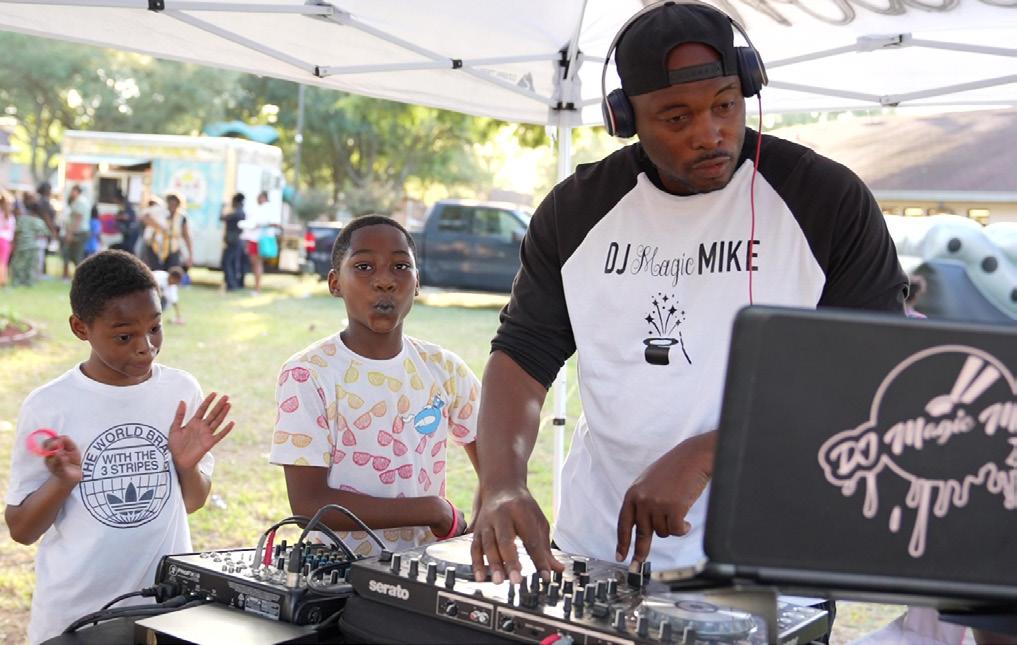
The National Night Out event brings together law enforcement and neighbors, allowing them to enhance their relationships. The best way to build a safe community is to know your neighbor and your surroundings. This event allowed residents to rediscover their community and shape positive relationships, while putting the Columbia Tap Trail, an important asset of the Third Ward, in the spotlight.
Family’s came together to learn about the principles and symbols of Kwanzaa. There were craft activities for children and adults, a dance contest, a martial arts demonstration, and live African drumming.
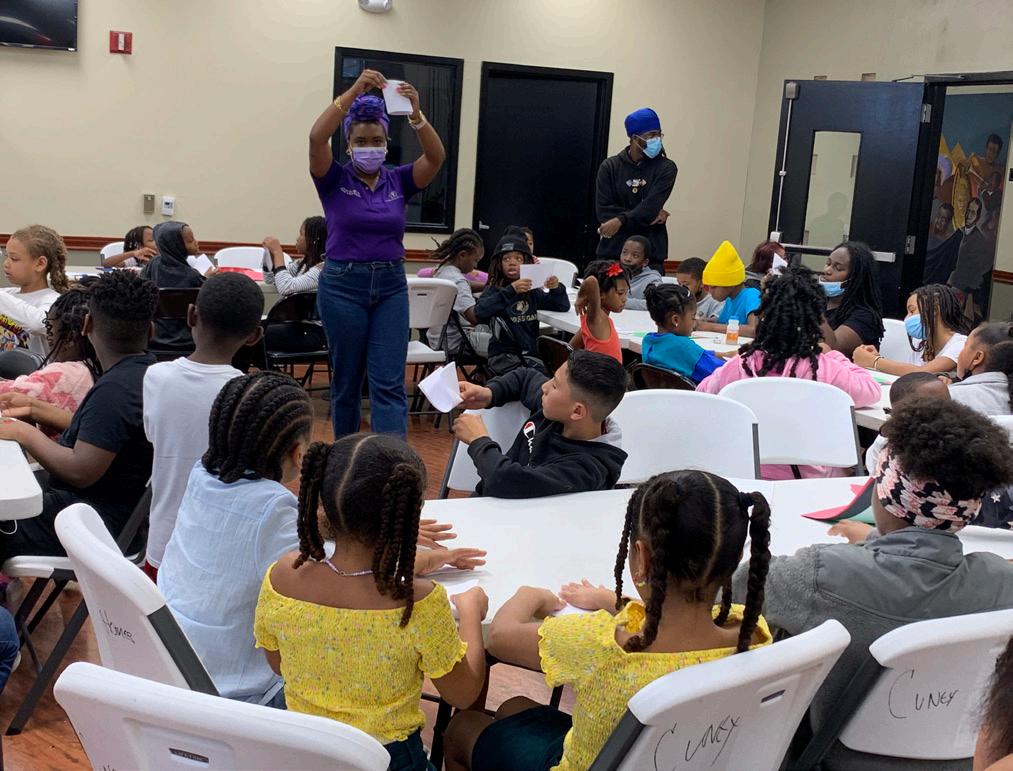
Source:
National
Source: HHA
Children's Kwanzaa in December 2022.
Source: HHA
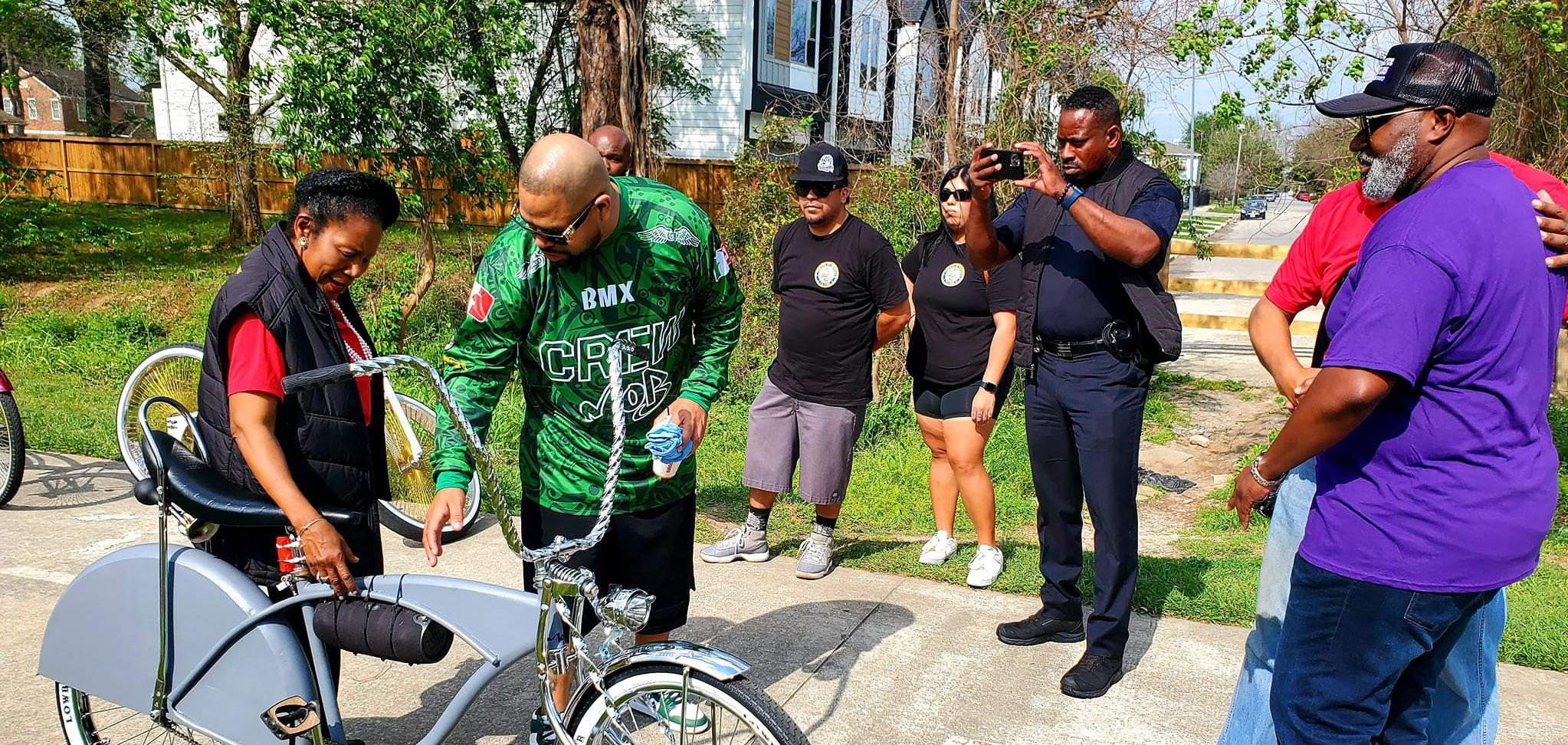


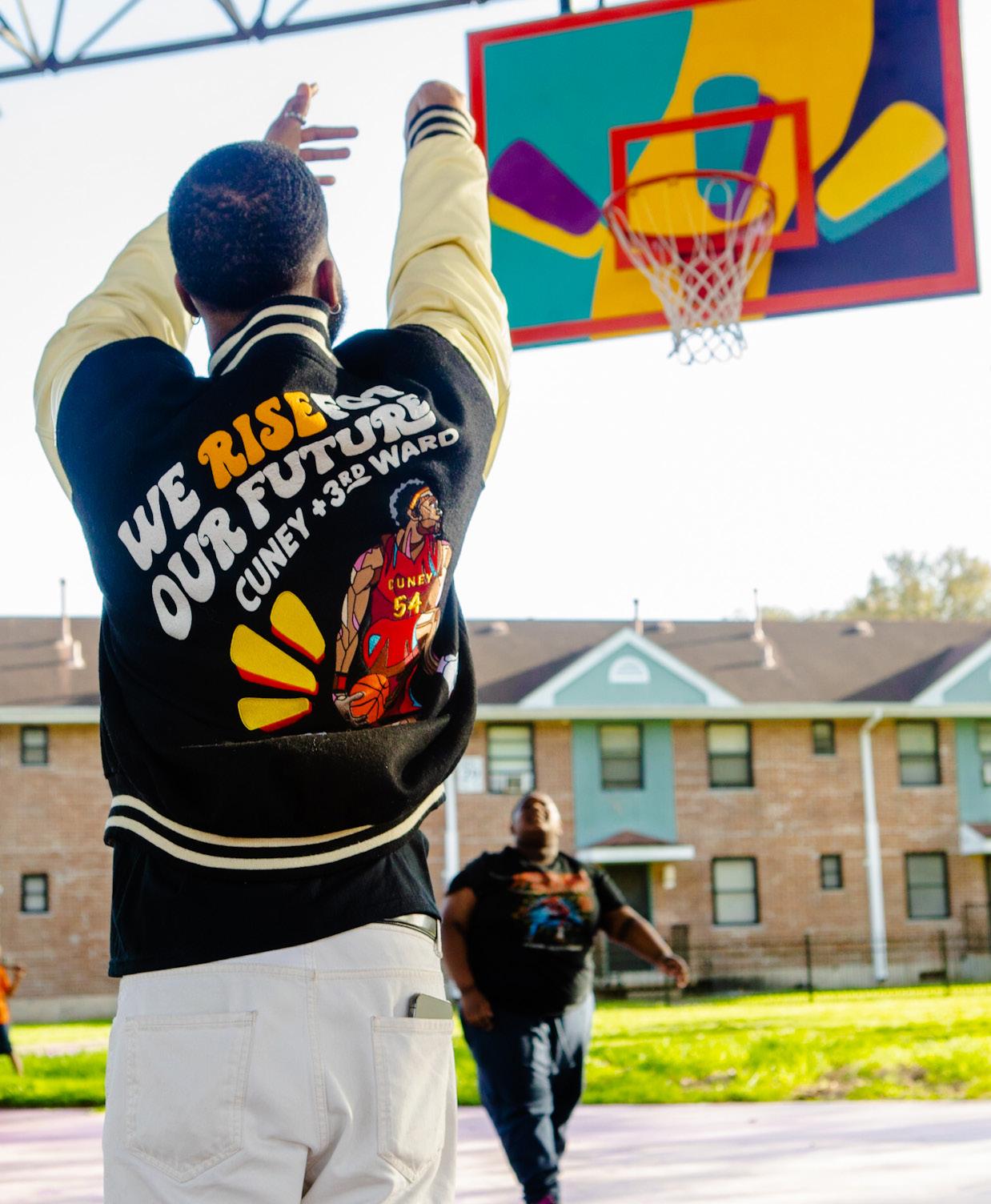


After a clean-up pantry party with Cuney Homes Ambassadors, Council members, and the American Heart Association, a donation drive to collect non-perishable food donations from local organizations and community members was organized. The Cuney Homes food pantry received donations from the American Heart Association, Change Happens, and the HHA.
On March 2, 2023, S.H.A.P.E. Center and the Elder Institute of Wisdom opened their doors to Cuney Homes residents to be part of the history of the Third Ward. The day was a celebration of pride and joy, of those who made the Third Ward and those who are working to preserve the history and culture. Seventeen Cuney Homes and Third Ward residents from the Elder Institute of Wisdom participated in the event and shared powerful stories of love, of serving the community, of moments that they keep as fond memories, and their vision for the future of the Third Ward. This important, treasured event will allow the community to have a record of the history and the culture of the Third Ward, and will allow them to move forward, taking from the past to evolve into the future.

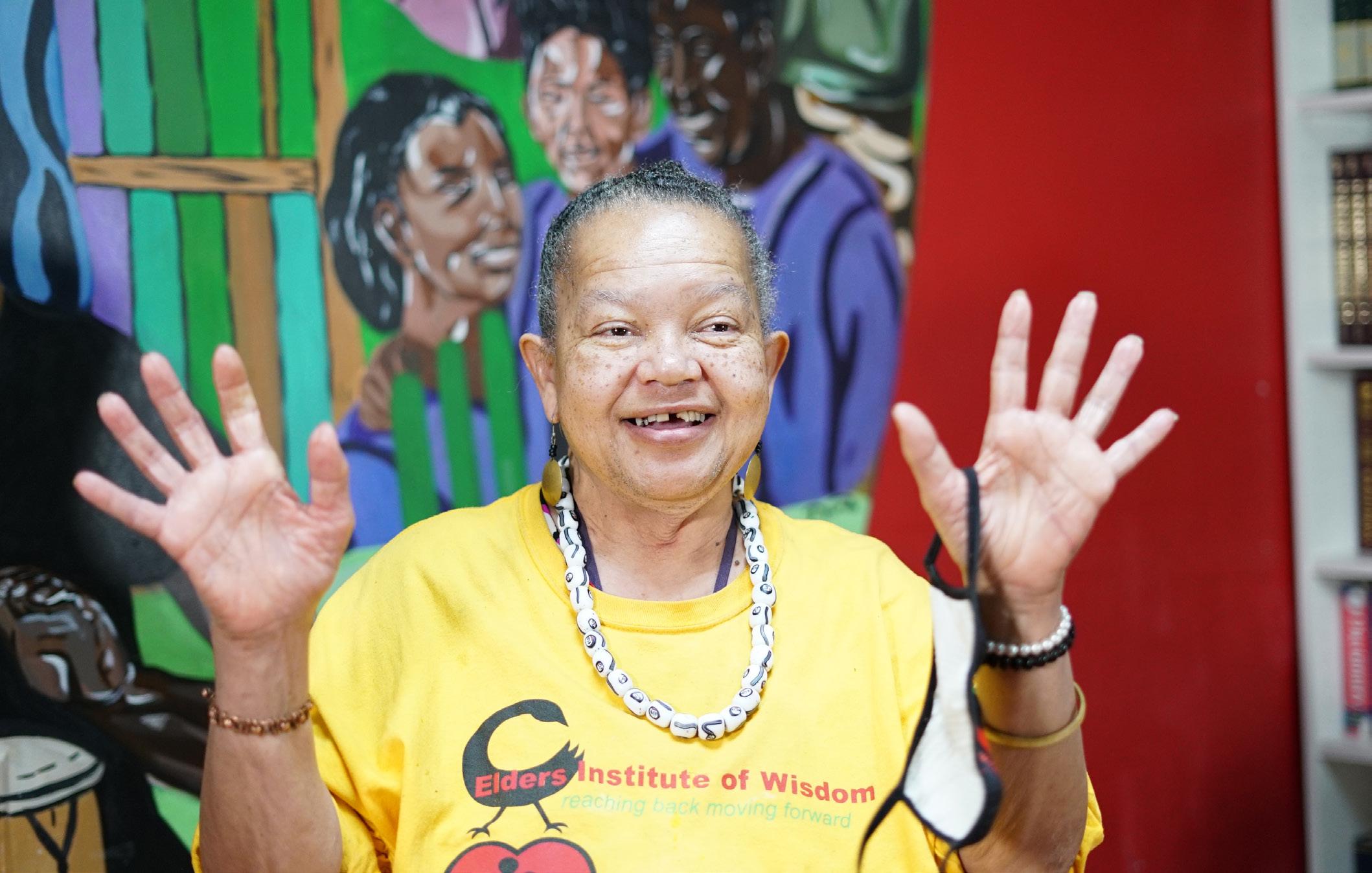




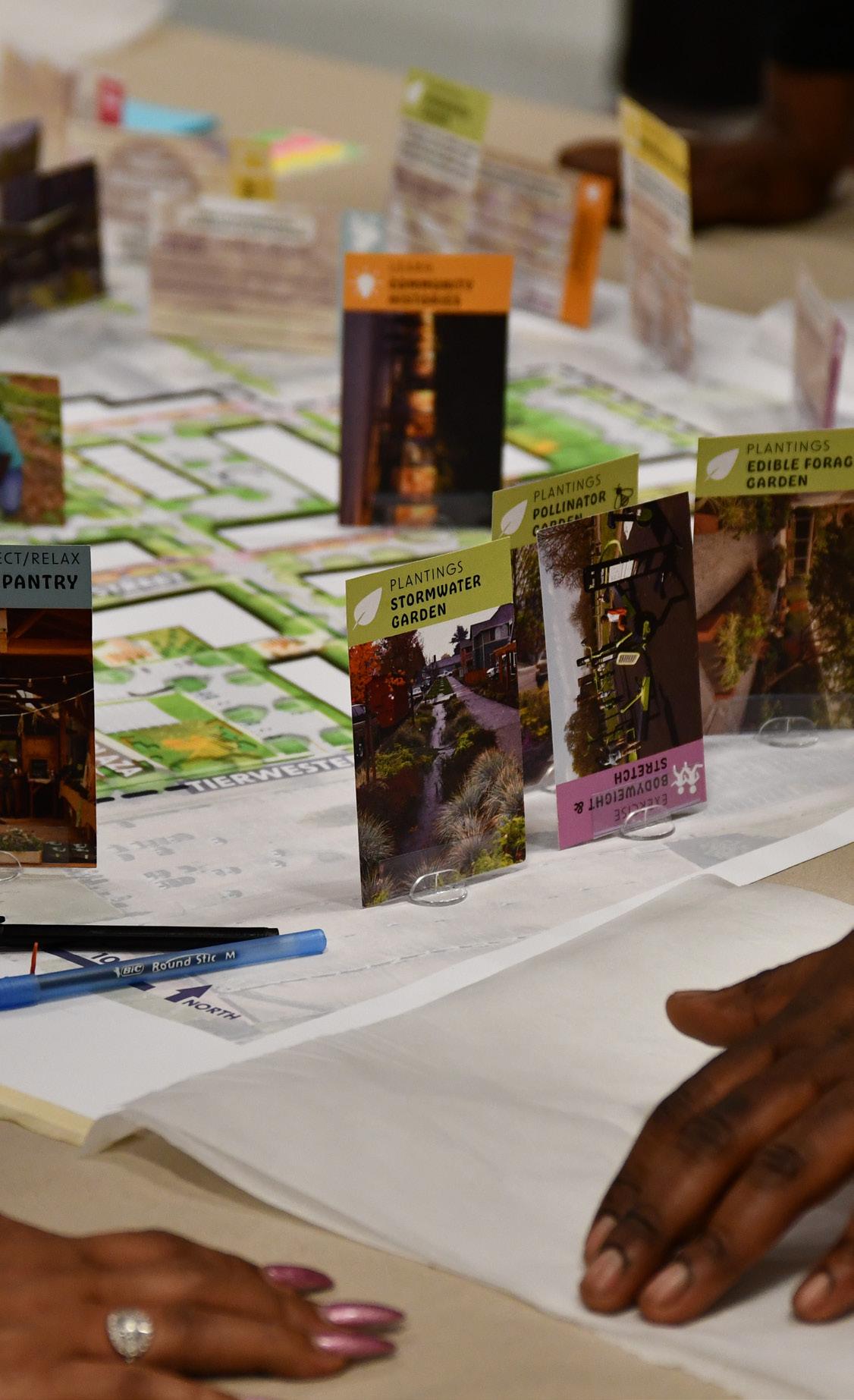

Around 50 members of the community, including Cuney Homes and Third Ward residents, attended the community meeting in the evening. The evening community meeting goal was to share the development of the People, Neighborhood, and Housing core themes of the Choice Neighborhood Initiative. The planning team built on the input received through the process to share the overarching vision created by residents in the summer 2022 workshop, and the guiding principles and goals that will inform the Final Plan.
The meeting was positive and full of energy from the community that gathered that evening to give feedback and express their thoughts on housing typologies, open spaces, education and employment, and neighborhood strategies among other topics.
In addition, kid’s activities were set up under the topic “what would you like the outdoor spaces of your home to look like?” so they could also take part in the meeting feedback.
The second year of Third Ward On Tap event gathered hundreds of people, including families and kids who celebrated the plans to reclaim and improve the Columbia Tap Trail and Truxillo Street community space. All intended to reunite the community and encourage healthy outdoor activities through the use of trails and outdoor space within Cuney Homes and the Third Ward.
The event included a block party, live music, food trucks, bike giveaways, bike contests, games, and prizes.
RYDE was recently awarded a Micro-Grant from Evolve Houston to launch an on-demand service to provide free, 100% electric, door-to-door, accessible transit in an underserved area of Houston. Cuney Homes and Greater Third Ward residents had the opportunity to take a test ride in one of the 100% electric micro-transit vehicles for a trip around Third Ward.
CONTINUE WITH LEADERSHIP SERIES(ADD ICONS NEXT TO EACH) -
THEN ADD THE REST OF THE EVENTS.
A quick look at the engagement!
LEAVE SPACE FOR ONE SMALL PARAGRAPHS OF TEXT (5 LINES)
Feb. 10
Columbia Tap Trail Design
Charette #1
Feb. 24
Columbia Tap Trail Design
Charette #2
2023
Feb. 27
Cuney Homes
basketball court opening
Feb. 29
Rodeo Houston with Cuney Homes and Third Ward kids
Mar. 2
Third Ward-Cuney Homes oral history project @ S.H.A.P.E. Center with the Elders Institute of Wisdom
Mar. 2
Community meeting #2
Mar. 11
Third Ward On Tap: Trill Edition
Mar. 13
Community safety meeting with
Department of Justice
Mar. 14
Safety for Our Future
Mar. 29
Review of the Draft Plan with residents
Mar. 31
"Random Acts of Kindness Day" Community Celebration
RYDE Micro-Grant for Mobility Test-Ride in April 2023.




Source: HHA
Light the Night in July 2023.
Source: HHA

On the evening of July 27, 2023, Cuney Homes residents and Third Ward neighbors came together for an impactful event, "One Safe Houston: Light the Night." The event aimed to shed light on community safety concerns and promote a brighter future for all residents. The gathering commenced at the Cuney Homes Community Center.
Participants, both on foot and on bicycles, provided by the Harris County Precinct One RideONE program, embarked on a journey along the Columbia Tap Trail, uniting people from various backgrounds in a shared commitment to community well-being.
The event symbolized a collective effort to advocate for safety enhancements. Collaborating with the Houston Police Department and other partners, the attendees aimed to foster a secure environment for everyone. This initiative sought to empower underserved communities by offering opportunities to learn about bicycle safety, maintenance, and providing access to alternative transportation methods. The event featured a diverse range of bicycles, including e-bikes, ensuring inclusivity, and enabling people of all abilities to participate.
The Light the Night event encapsulated the spirit of togetherness and dedication to community safety. By walking and cycling side by side, participants illuminated the path to a safer and more vibrant future for Houston, demonstrating that small steps can lead to significant positive changes.
This summer, the University of Houston’s Honors College hosted the second Community Health Workers Initiative at Cuney Homes. This 8-week introductory course allowed Cuney Homes and Third Ward residents to gain certifications and additional training and support as a Community Health Worker, an advocate for individual and community health. There were 13 graduates for the Community Health Worker program this summer.
CONTINUE WITH LEADERSHIP SERIES(ADD ICONS NEXT TO EACH)THEN ADD THE REST OF THE EVENTS.
LEAVE SPACE FOR ONE SMALL PARAGRAPHS OF TEXT (5 LINES)
Apr. 25
RYDE Micro-Grant for Mobility Test-Ride
Apr. 26
Exploring the Past to Build the Future Field Trip
Jun. 28
Feeding Our Future Food Pantry Day Proclamation
Jun. 29
Pride Ride
2023
Jul. 16 Columbia Tap Trail Visioning Meeting
Jul. 26
University of Houston Healthy Start Program
Jul. 27
Light the Night
Aug. 9
University of Houston Lunch and Learn
Aug. 19
Cuney Kickback
Aug. 28
Twas the Night Before School
Aug. 29
Third Ward Community Coffee Chats
Walking Towards Our Future

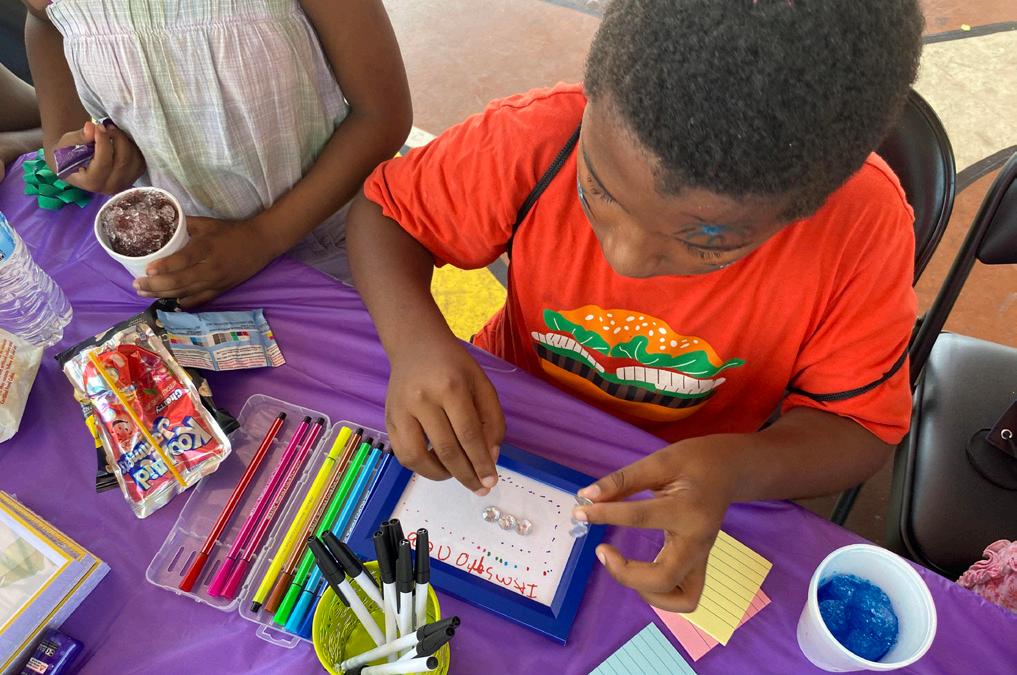
The weekly Friday Community Coffee Chats held at Doshi House Cafe have been a dynamic and engaging platform for residents of Cuney Homes and members of the Friends of Columbia Tap community. These chats, which commenced in December 2022, have provided an inclusive and low-barrier avenue through an informal atmosphere for open dialogue and collaboration among various communities.
Shared leadership has been a key factor, ensuring that diverse viewpoints and voices are represented. Throughout these sessions, participants have had the liberty to bring forth topics or issues that matter to them, generating conversations that span a wide range of subjects. Residents have been able to invite guest speakers to shed light on specific matters, enriching the knowledge available within the community. Moreover, the chats have also facilitated discussions on becoming more effective community advocates, promoting active participation and community empowerment.
The coffee chats have become a valuable space for mutual learning drawing from each other's experiences and expertise. Through a format that promotes openness, collaboration, and shared leadership, participants have come together at the Community Coffee Chats to discuss, learn, and strategize on matters of local importance. This ongoing initiative demonstrates the power of casual, yet purposeful conversations in fostering a stronger and more connected community.
Source: HHA
Third Ward Coffee Chats in August 2023.
Source: HHA
Walking Towards Our Future 2023.
Source: HHA

We Walk Toward Our Future is a partnership with Fit Houston and Friends of Columbia Tap Trail. After the successful launch of the Feeding Our Future food pantry, residents and Fit Houston worked together to start a walking group as part of our walking campaign, #WALK30, which encourages everyone to walk 30 minutes a day, no matter where you are.
To make this initiative happen, FOCT cleaned the entryway to the trail, added landscaping, and made the trail safe to access. The South Central police department accompanied the Walking Toward Our Future group on the first few walks, then we invited partners such as UH College of Medicine, local nonprofits, local running clubs, and more, to walk.
Two months later we have a very viable walking group, and many new people have joined residents and partners to enjoy the trail. This is more than walking; it is civic engagement. The walk ends at Doshi House, a local coffee shop where neighborhood stakeholders meet each Friday to continue to make improvements along the trail, the community, and more.
At the end of the planning process, on September 2023, residents of Cuney Homes and the Third Ward and partners met at the Third Ward MultiService Center to celebrate the Final Choice Neighborhoods Plan and the accomplishments made so far. The meeting was an exciting gathering to come together and celebrate all the milestones met and all the residents that have been part of the process, raising their voice and shaping the Plan.
Partners shared kind and powerful words to build momentum and start acting on change, and shared a presentation summarizing the Choice Neighborhoods Plan.
The meeting included the video excerpts from the storytelling at SHAPE Center, bringing powerful stories of hopes, vision for the community, and what they want the Third Ward to be in the future: a thriving environment rooted in community and recognition of its residents.
Throughout the Choice Neighborhoods planning process, the planning team and residents have put together meetings, workshops, events, and activities that relate to the Choice Plan and the needs of the community, so capacity building and community ties are built throughout the process.
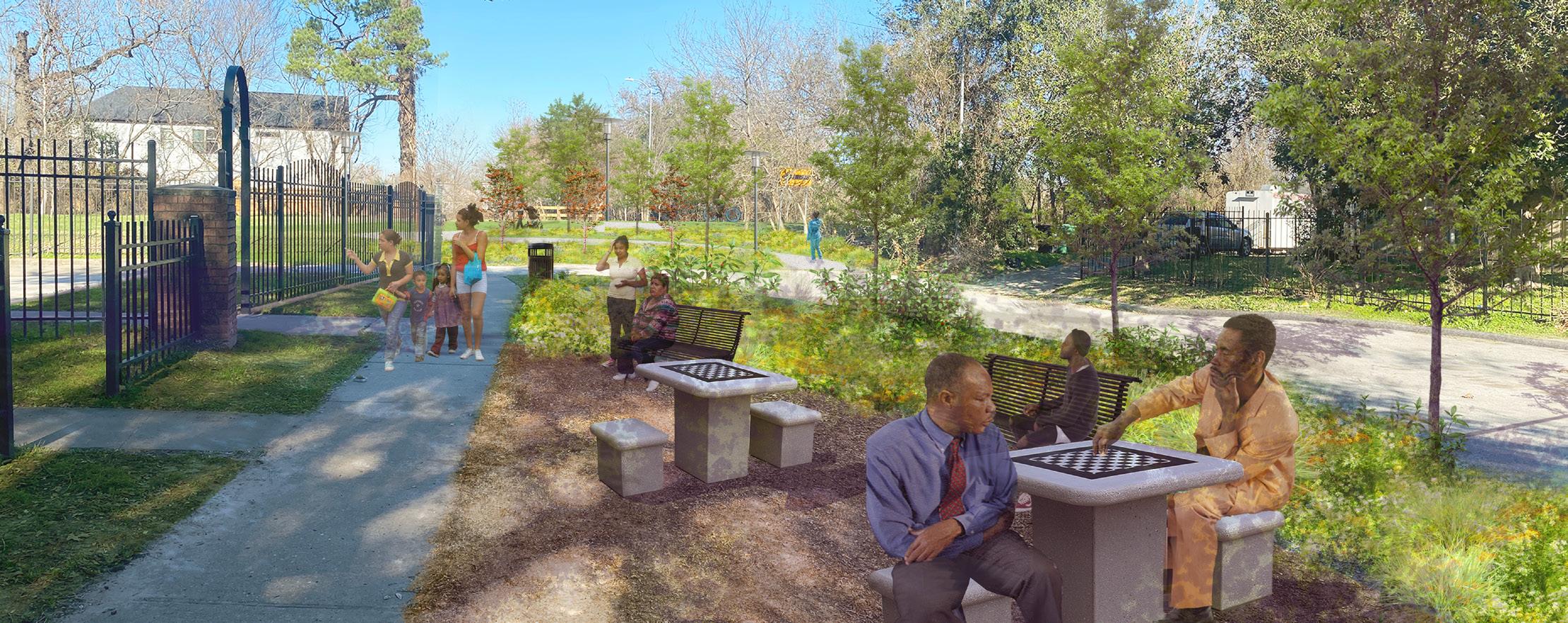
Together, we rolled up our sleeves and imagined the possibilities... Now we are making change!
As part of the Choice Neighborhood planning process, the planning team, Community Ambassadors, and Cuney Homes residents make the Early Action Activities a reality.

Input on important needs that the community needed to be met was gathered through the Needs Assessment, the community workshops in 2022, and other events.
The result of this input brought a new gathering place in the community, a renewed basketball court where children play, families gather, and events are organized. A new food pantry was created through the work of the Ambassadors and community partners, so every resident can have access to healthy foods. We also addressed safety concerns by reclaiming the space at Columbia Tap Trail, an important gateway of Cuney Homes residents; this trail can help foster an active lifestyle and improve residents' wellbeing.
Columbia Tap Trail is of significant importance to the history of the Third Ward. This rail line was built by enslaved Black men and opened in 1856 as a critical route for transporting sugar and cotton from Brazoria County plantations to Houston. No historic markers exist nowadays.
Keeping the focus on neighborhood history and transportation, we want to restore this part of the trail to a yet unforeseen glory. Through community engagement activities, such as Task Force meetings, community meetings and design charettes, it was determined that residents desire to hold this space for recreational activities for people of all ages and abilities. We envision this space as a pocket park complete with benches, lighting, way-finding signs, pollinator and rain gardens, landscaping, an information board, and a mural that celebrates the history and the future of the Columbia Tap Trail.
Fresh food and healthy food options are very hard to come by in the Third Ward community, and it is difficult for residents to overcome their current barriers that prevent access to food.

To overcome this need until more permanent solutions can be achieved, we utilized a small pantry inside the Cuney Homes Community Center to establish a very small but mighty food pantry Funded by the American Heart Association. The affectionately titled Feeding Our Future Food Pantry is open two days a week and distributes 100 fresh fruit and vegetable boxes each week to Cuney Homes residents only. The food boxes are provided by The Common Market, a mission driven distributor of sustainable, local farm foods. The food pantry is staffed by three Choice Ambassadors. There is a dire need for more variety of food items offered by this pantry, so we are actively working to solidify additional partnerships to secure dry food items, snacks for kids, and prepared meal kits.
The Cuney Homes Basketball Court is the heartbeat of the community, but it had fallen into a state of disrepair. That was until James Harden, professional NBA basketball player came to donate school supplies for a backto-school event at Cuney Homes. When a random storm rained on Harden, he decided to be the change he wished to see in the court.
With the help of James Harden’s Impact13 Foundation funding, the basketball court has been renovated. Project Row Houses and the planning team put a youth focus group together, so youths can have their voices heard. The Cuney Homes Basketball Court was renovated with a new roof, new goals, and bleachers. The mural for the court features a “jump man” with a red and yellow jersey referring to the colors of Jack Yates High School. “Cuney” is written on the jersey with the number “54” as a subtle but powerful nod to George Floyd’s number when he played basketball at Jack Yates High School.

The first significant touchpoint with Cuney Homes residents was the Needs Assessment, which was used not just to gather information, but to talk to residents one on one to explain the CNI and what it might mean for them.
Five local community researchers were recruited, hired, and trained by Sankofa Research Institute to conduct the surveys using the principles of Community-Based Participatory Research. The researchers were selected because of their connections to Cuney Homes and the Third Ward and their interest in making a positive difference. Three Community Researchers are residents of the Third Ward, one currently works with Third Ward residents, and one is a member of a Third Ward faithbased organization.
Working with the Resident Council, Sankofa developed a data collection plan tailored to residents:, which included
f Attending events at Cuney Homes to pass out postcards announcing the launch of the survey.
f Going door-to-door to each household giving residents a postcard or placing a postcard on their door.
f Establishing a dedicated telephone line for residents to call and schedule appointments.
f Dedicating one community researcher to administer surveys to drop-in residents.
f Being present at the site initially five days per week, which included Saturdays.
f Providing residents the option of being surveyed at their apartment unit or in the Community Center.
f Initiating a late afternoon and early evening shift for working residents.
f Making at least six attempts to complete a survey with each household and use door hangers to communicate with residents.
f Employing Robocalls, SMS messaging, and posters to increase the effectiveness of the outreach.
of Cuney Homes residents believe that crime and safety is the most pressing issue in the neighborhood of Cuney Homes residents believe that activities and safe meeting places for teens are missing
of Cuney Homes residents think that maintaining and making neighborhood parks safer could improve the neighborhood
"What do you think are your neighborhood’s greatest strengths?"
"What would you like this neighborhood to be known for after it has been redeveloped?"
A safe, stable, and familyfriendly neighborhood
A thriving center of Black and African-American culture - a place you can expect to find performances, markets, and social events that celebrate the rich heritage and contributions of Black Houstonians
“How would you like the history of your neighborhood be celebrated and told?”
"What do you like the most about Cuney Homes?"
The people, the neighbors, the sense of community
Being able to live in the Third Ward
Reporting changes in my income to allow my rent to go down
Being close to my family/friends, work, doctors, and church
Being able to attend on-site programs, events, and services
When asked what amenities could improve the neighborhood, some of the top responses related to parks & recreation were:
“Maintaining and making neighborhood parks safer ”
“Making spaces more inclusive/accessible”
“ Lighting and benches along the Columbia Tap Rail”
“Are there additional services that would help your child do well in school?”
Although the Third Ward has a long tradition of community activism, not everyone has had an opportunity to share their opinions or develop the skills necessary to take part in civic discourse. The Third Ward-Cuney Homes Choice Neighborhood Plan aims to provide opportunities for residents of all ages to strengthen their capacity to lead.
Neighborhood Leadership Series
#1-A meeting of the minds: conflict resolution
Cuney Homes and Third Ward Residents shared types of conflict they faced both at home and throughout the community and learned conflict resolution tips to help them successfully navigate and resolve conflict.
Speakers: Angela St. Julien, Darcy Thompson, Dr. Diana Pino from the Association for Conflict Resolution, Houston chapter.
#2-Fair housing and affordable house development
Through a Renter Know Your Rights presentation, residents learned history of racism and segregation in housing and how to be advocates for affordable housing.
Speakers: Julia Orduna and David Wheaton from Texas Housers; Yolanda Guess-Jeffries City of Houston Housing & Community Development Department.
#3-How to start a co-op business or a small business
Third Ward Entrepreneurs shared entrepreneurship experiences and tips with residents. The Emancipation Economic Development Council shared their Entrepreneur Training program with residents. Project Row Houses shared their Art Entrepreneurship program with residents.

Speakers: Britany Winters, Upgrade Boutique; Alicia Neal, Emancipation Economic Development Council; RUEROB, Project Row Houses; Dean Liscum, Dean Liscum Communications, Ashley Hairston, Houston Housing Authority – Section 3 program.
Neighborhood Leadership Series #5.
Source: HHA (top to bottom)
Resident Ambassadors in training.
Source: HHA
Neighborhood Leadership Series #7.
Source: HHA
#4-Upskill your way to a green career
Explained green career options to Cuney Homes residents and the Third Ward community.
Speakers: Ken Williams, GROW Houston.
#5-Building generational wealth through homeownership
Residents learned how to successfully navigate homebuyer programs from industry professionals and new homeowners.
Speakers: Kristy Kirkendoll, HHA Board Member; Joanne Gladney, HHA Housing Choice Voucher Program/Family Self-Sufficiency program; Veralisa Hunter, Covenant Community Capital.
#6-Mental health talk with a doc
Mental Health professionals encouraged Cuney Homes residents to seek available resources to help themselves or a neighbor struggling with mental health issues.

Speakers: Dr. Steven Starks, University of Houston –College of Medicine; Rebecca Skillern, Houston Police Department – Mental Health Divisions; Patrick LeBlanc, Houston Police Department – Mental Health Division.
#7-Making Cuney Homes safer
Townhall meeting with Cuney Homes Precinct 6 and Houston Police Department for residents to discuss safety concerns in the community.
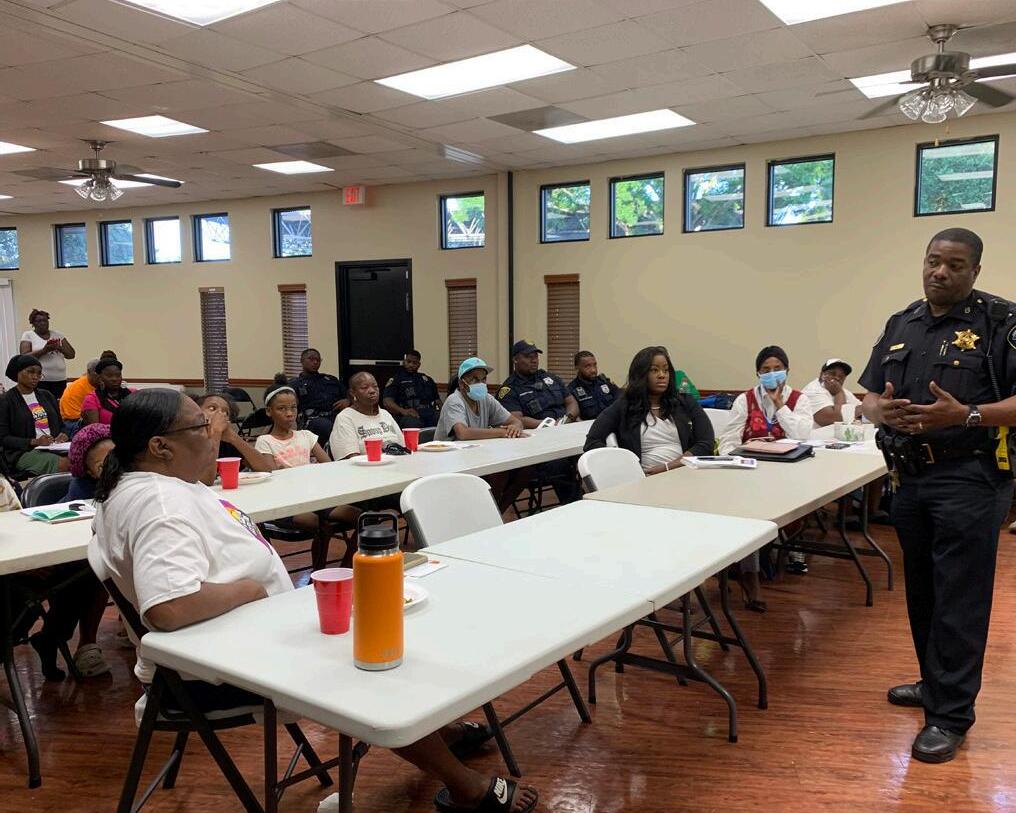
May 10
A meeting of the minds: conflict resolution
May 24
Fair housing and affordable house development
June 2
How to start a co-op business or small business
June 7
Upskill your way to a green career
June 16
Build generational wealth through homeownership
June 23
Mental health talk with a doc
June 28
Making Cuney Homes safer
A quick look at the leadership series!

To create a meaningful Plan for transformation, it is critical to understand the current state of conditions in the neighborhood. This analysis sets up a baseline against which goals for improvement will be established and metrics will be created to measure progess going forward.

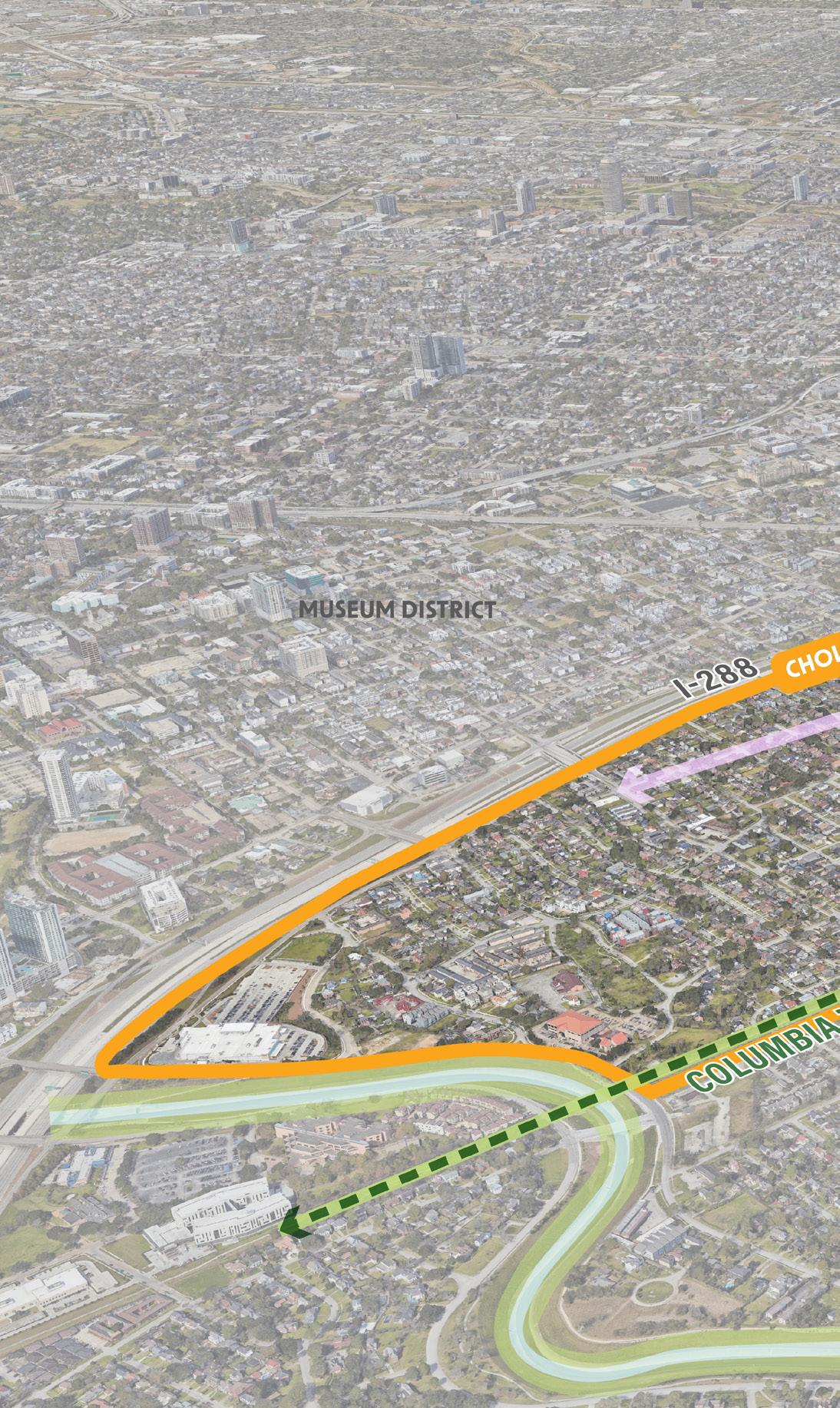
The Third Ward-Cuney Homes Choice Neighborhood boundary comprises most but not all of the historic Third Ward, extending to the I-45 highway to the north; the Highway 288/I-69 (US-59) highways to the west; extending to Brays Bayou, Blodgett and Elgin streets to the south; and the Columbia TAP Rail Trail, Scott Street, and Cullen Boulevard to the east. Midtown Houston is located directly west, across I-69, and Downtown is located northwest, diagonally across both highway networks. The southern “tail” of the site boundary extends outside the historic Third Ward, running along the Brays Bayou Greenway.
Cuney Homes anchors the Third Ward with a 33-acre site located to the southwest of the neighborhood boundary, adjacent to Texas Southern University to the south and Scott Street to the west where it runs along the boundary of the University of Houston.

“Everything we need is right around us in the Third Ward. As, when I was younger, I could walk to practically everything I needed and now, I am glad I can still get to whatever I need in a short driving distance.”
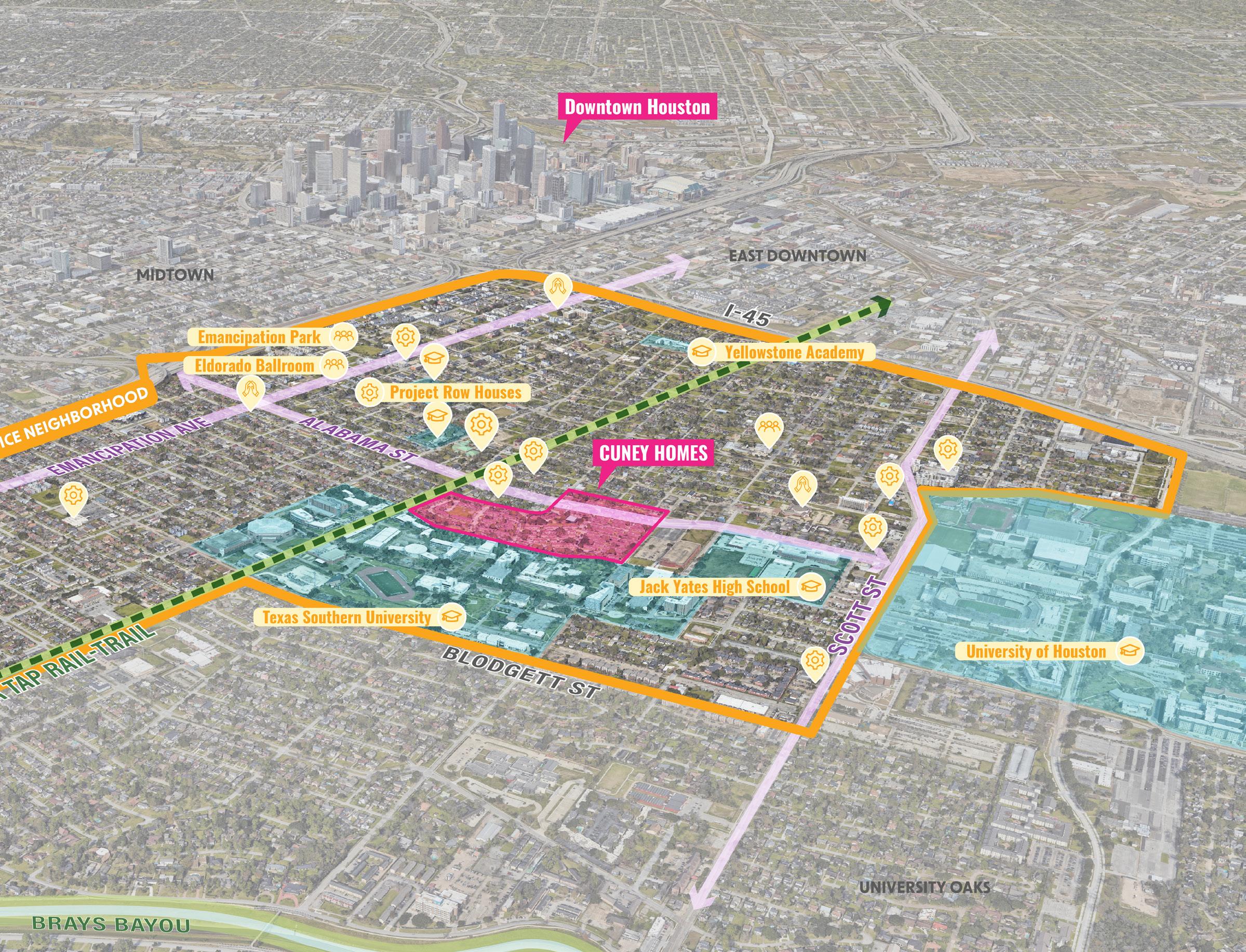
A quick look at a map of the Choice Neighborhood shows that while it has ready access to regional highways, those same routes—state highway 288 and interstate highways 69 (US-59) and 45—isolate the historic neighborhood from the rest of the city. The construction of these highways considerably impacted the Third Ward community by demolishing homes and preventing growth in the neighborhood.
Despite this challenge, the Choice Neighborhood has several important assets that can act as seeds to grow opportunities for residents and create essential infrastructure for more activity within the neighborhood. Anchors like Texas Southern University and the University of Houston bring Houstonians from the entire region to the neighborhood.


The presence of community organizations like the S.H.A.P.E. Community Center, Project Row Houses, Change Happens! and the Third Ward Multi-Service Center, along with recent improvements at the community hub of Emancipation Park, support residents and their participation in civic life. Existing multi-modal transit connections are also being expanded in the near future, connecting residents with the larger city.
Finally, in addition to these physical assets, residents’ strong sense of community, collective efficacy and desire to stay in the neighborhood creates intangible strengths: 78% of Third Ward residents describe being either “very satisfied” or “somewhat satisfied” living in the Third Ward. This satisfaction and pride of place can be a strong driver for the future of the neighborhood, as long as current residents are provided opportunities to stay.

"What do you think are your neighborhood’s greatest strengths?"Source: cuNeY HoMeS reSIDeNT SurVeY, 2022
The Third Ward is home to organizations that service the neighborhood and anchors it based on the preservation of culture and history of the Third Ward.
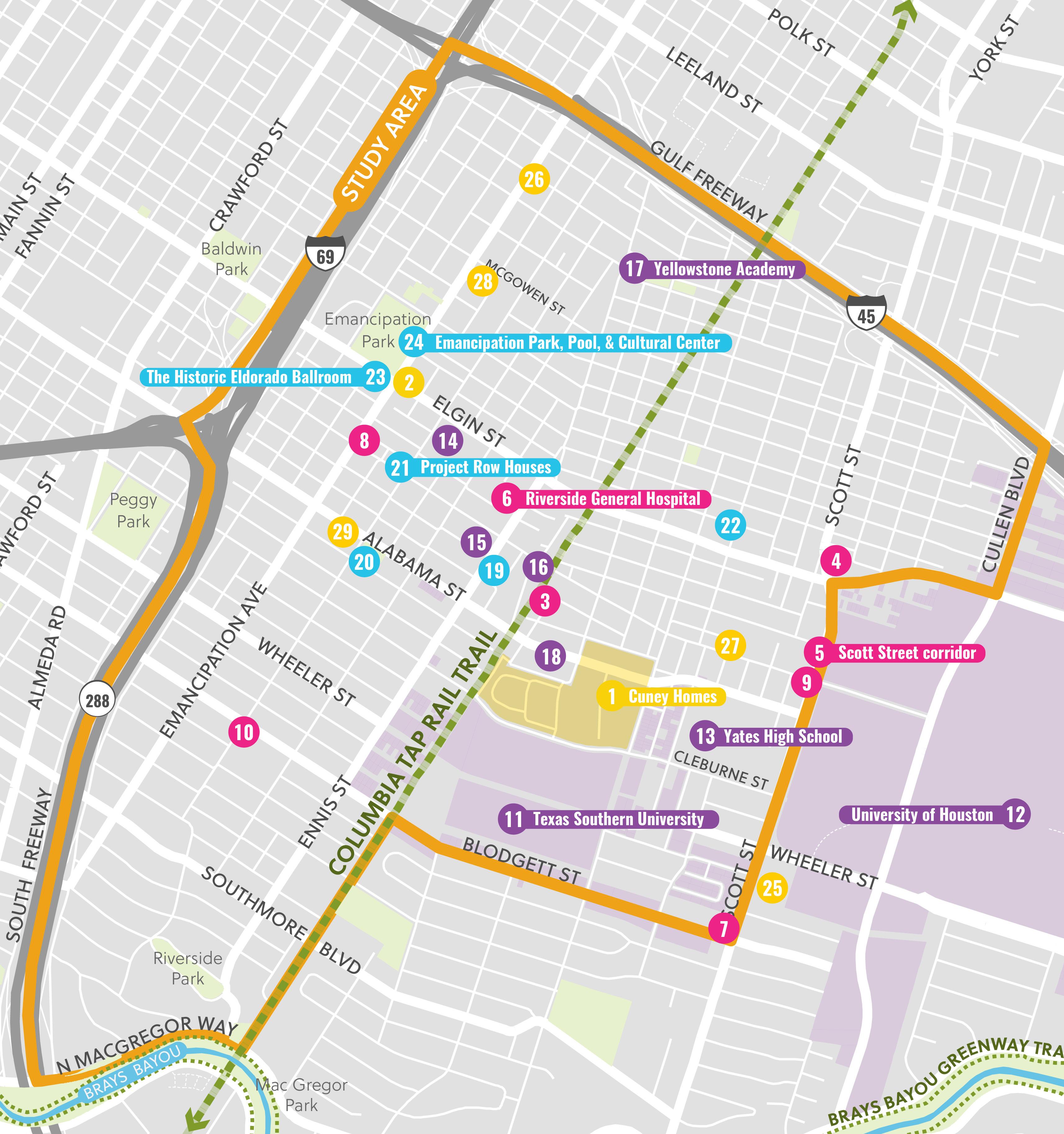
There are two primary commercial arteries in the Choice Neighborhood running along the north-south streets of Emancipation Avenue to the west of the neighborhood, and Scott Street to the east. There are also pockets of commercial activity on some east-west streets, including McGowen, Elgin, Alabama, Blodgett, and Southmore streets. Intersections where these cross-streets meet Emancipation Avenue and Scott Street have seen some recent higher-density mixeduse development, creating small emerging “nodes” of activity in the neighborhood.
According to the Third Ward Comprehensive Needs Assessment, residents shop within the neighborhood for their groceries, primarily at major stores like HEB or Fiesta. Only 15% reported shopping for groceries outside of the neighborhood. This may be partially due to mobility limitations, but also may indicate a preference for supporting local businesses: 92% of residents surveyed requested additional retail opportunities in the neighborhood, including clothing, home goods, book, and other retail.
Meanwhile, commercial activity on the other side of Highway 288, in Midtown, creates strong commercial competition for these businesses, with more mobile Third Ward residents crossing over into the neighborhood to the west.
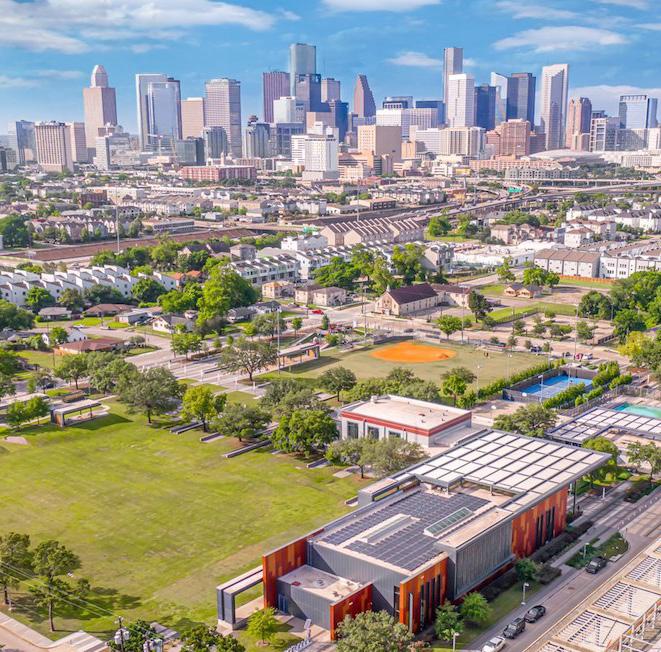
(top to bottom)
Crumbville, one of the thriving businesses in Emancipation Avenue, reflects the entrepreneurial spirit growing in the Third Ward.
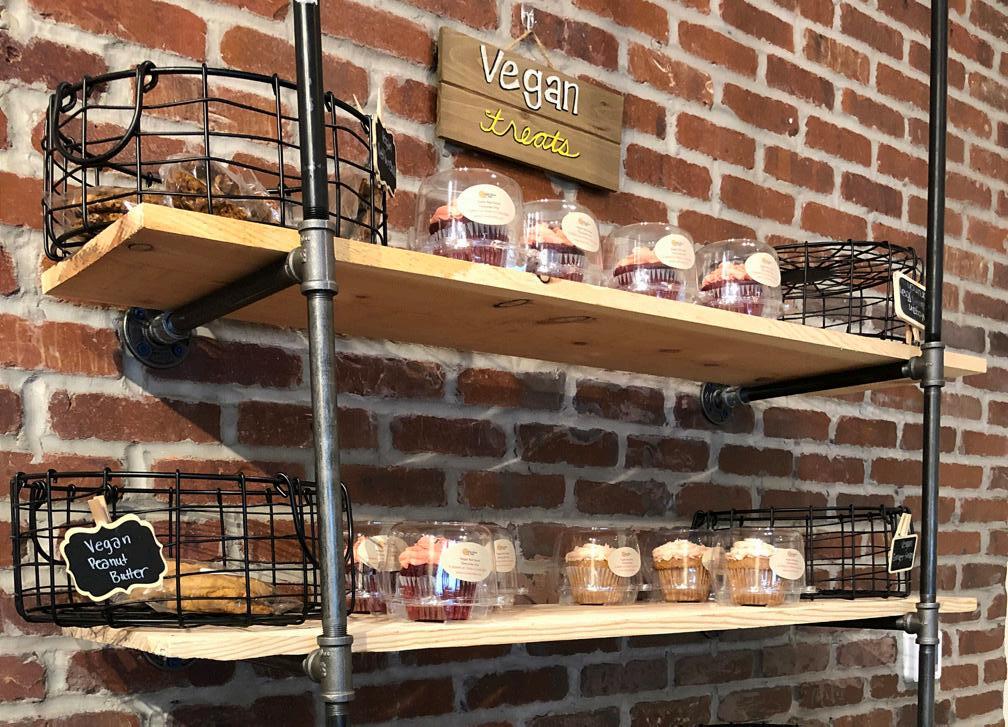
Source: WrT
A view overlooking Emancipation Park towards downtown.
Source: 365THINGSINHouSToN.coM
Emancipation Park, the physical, historical, and spiritual heart of the community.
Source: AYALA VArGA PHoToGrAPHY

In 1950, there were 175 businesses on Emancipation Avenue, historically a major center for African American commerce in Houston; as of 2018, there were 20 (Complete Communities Third Ward Action Plan, 2018). The Emancipation Avenue Main Street Program, an initiative of the Emancipation Economic Development Council and the Texas Historical Commission, is designed to create and support equitable economic development along this important corridor by revitalizing commerce, celebrating African American culture, and promoting creativity. Emancipation Avenue has also been chosen as a pilot in the City’s Walkable Places program. The recent $33.5 million redevelopment of Emancipation Park and its recreation center has increased visibility of this corridor as a central hub for Houston’s African American communities.
Across the street from Emancipation Park is the recently completed mixed-use Affordable Housing Operations Center, designed to harness synergies among organizations to lift up historically underserved
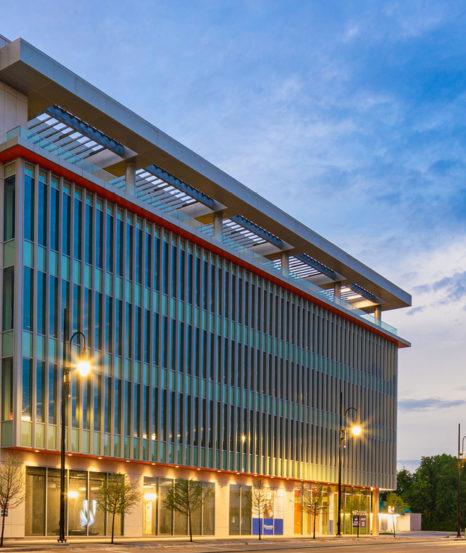
The newly constructed One Emancipation Center is a beacon of hope and rebirth in the heart of the neighborhood. Located directly across the street from Emancipation Park, the 5-story, 58,000-SF building is home to the Affordable Housing Operations Center, designed to bring together organizations committed to preserving and expanding affordable housing in the Third Ward and Southeast Houston. Led by CCPPI, the Center strives to address displacement and help residents remain in their homes and in their neighborhoods.
individuals through affordable housing and supportive services.
The Center represents a symbol of re-birth for the community and includes a new 5-story, 58,000-SF mixed-use building and a multi-level parking garage with about 215 spaces next door.
The ground-floor provides a community room and houses CenterWell Senior Primary Care, providing much-needed medical services to those 65 and older. Just behind the garage is a new 3-story building with 20 residential units over parking at grade level.
In terms of street character, Emancipation Avenue today has scattered vacancy, and older businesses often have deep setbacks with front parking lots. New development around Emancipation Park is higher density mixed-use with minimal setbacks, indicating a shift towards rethinking this street as an urban and walkable corridor. However, many businesses are currently still spread far enough apart to limit a consistently walkable experience.
Source: HTTPS://WWW.ArcH-coN.coM/DIVISIoN/AFForDABLeHouSING-oPerATIoNS-ceNTer/
Alabama Street, in addition to Elgin Street, is one of the major east-west corridors that connect the Third Ward to Midtown, Texas Southern University, and University of Houston.
Historically the street that marked the divide in the era of de jure segregation, Alabama Street stands as a main boulevard that gives access to many of the services and assets of the Third Ward. S.H.A.P.E. Community Center, STEM Inc., Generation One, and Jack Yates High School are some of the Third Ward educational services that are lined up along Alabama Street creating a rich corridor for education and culture on the Third Ward.

The character of the street is formed by Third Ward style single-family homes with gabled roofs and frontyards lined up as a facade. The scattered vacancy and non-connected sidewalks contribute to mobility problems in the area.
The Third Ward Complete Communities Action Plan strives to remove barriers so that all of Houston's residents and business owners can have access to quality services, amenities, and opportunities.
Highest priorities identified focus on affordable housing projects and policies, education and employment opportunities.
Key strategies include:
f Build housing for all.
f Improve neighborhood mobility and build great streets.
f Preserve the neighborhood's history and character.
Between Columbia Tap Trail and Tierwester Street, Alabama Street is the main throughfare to Cuney Homes, the front door to its community. Built as two-way boulevard separated by a median, Alabama Street is the main gateway to the site and the most prominent visual point to Cuney Homes today. Residents noted that loitering and gatherings are one of the most pressing problems in this main street, and that it contributes to the feeling of unsafety of residents. They would also like to see more transportation options running through Alabama Street, so all residents have the access to improved mobility and services in the Third Ward and beyond.
When asked what can help maintain and improve Emancipation Avenue, residents said:

f Safer, more visible crosswalks.
f Brighter lighting.
f Enhanced bus stop waiting environment.
f Accessibility for people of all abilities.
f More businesses in one concentrated area.
Residents would love the neighborhood to be known as a thriving center of African American culture— a place you can expect to find performances, markets, and social events that celebrate the rich heritage and contributions of Black Houstonians.
Browning Third Ward resident“[Third Ward] is close to downtown. You can get around, even if you don’t have a car. There are a lot of activities, positive activities and businesses, and you can be a part of that too."
Sherry
The Choice neighborhood is primarily residential in nature, with a scattered mix of uses. Because the City of Houston does not have a city-wide comprehensive zoning ordinance, it is not uncommon to see blocks with single family houses sprinkled with churches and corner stores.
Many U.S. cities create a shared vision of how communities would like to see their city develop as part of their city-wide comprehensive planning efforts to guide city-wide investment and development activity. Since the City of Houston does not regulate land use, it is often site-specific municipal codes and development requirements that guide future development in Houston neighborhoods.
The absence of an overarching physical vision for the neighborhood makes it more difficult to understand how the Choice Neighborhood would like to evolve. Current and proposed development in the Third Ward do not reflect any consistent form, density, setbacks, or use. In neighborhoods like the Third Ward with projected nearterm growth, this lack of a dedicated future land use plan or development guidelines can leave a vision for development in the hands of those with the most capital.
The Choice Neighborhood's vacancy rate of 24.5% (ESRI Community and Income Profile 2020) is more than double the city-wide rate of 11.2% (ACS 2019). North of Alabama Street, closer to downtown, vacancies are especially concentrated—with nearly 30% of singlefamily residential lots currently vacant, largely due to disinvestment and subsequent demolition. Much of the single-family housing stock north of Alabama Street is also in poor repair. The combination of widespread vacancies, dilapidated buildings, and crumbling sidewalks detracts from the overall appearance of the neighborhood and disrupts the streetscape with gaps that can attract dumping, litter, and unsafe conditions. This blight of buildings and lots is a concern for residents. South of Alabama Street, vacancy and blight improve dramatically.
While a high rate of vacancy can negatively impact the character of a neighborhood, it can also present an opportunity for redevelopment that can be done thoughtfully and inclusively. Alternatively, it can also open the door to predatory developers and outside investors, leading to displacement and gentrification.
The Historic Third Ward Strategic Implementation Framework was developed to inform policy and program decision making at the neighborhood level to support equitable community redevelopment in the Third Ward. It functions as a toolkit and recommendations guide to implementation for use by Third Ward residents, community
developers, and non-profits, private/public funders and investors and public officials.
Key strategies include:
f Consider a Land Bank to maintain affordability and purchase blighted property.
Choice Neighborhood
Cuney Homes
University Area
Major Highway
Trail
Park
Waterbody
Single family residential
Multifamily residential Commercial
Public & Institutional
Industrial
Park & Open Spaces
Undeveloped
Agriculture Production
This map shows how land in the Choice Neighborhood is currently being used.


Yellow is residential.
Source: cITY oF HouSToN
Choice Neighborhood
University Area
Major Highway Trail
Park
Waterbody
Vacant Land
Publicly Owned
MRA Property
Land Bank Property
This map shows the vacancy in the Choice Neighborhood and the current concentration in the northern portion.
Source: cITY oF HouSToN
"If Cuney Homes is redeveloped, would you like to return to the site when it is completed?"
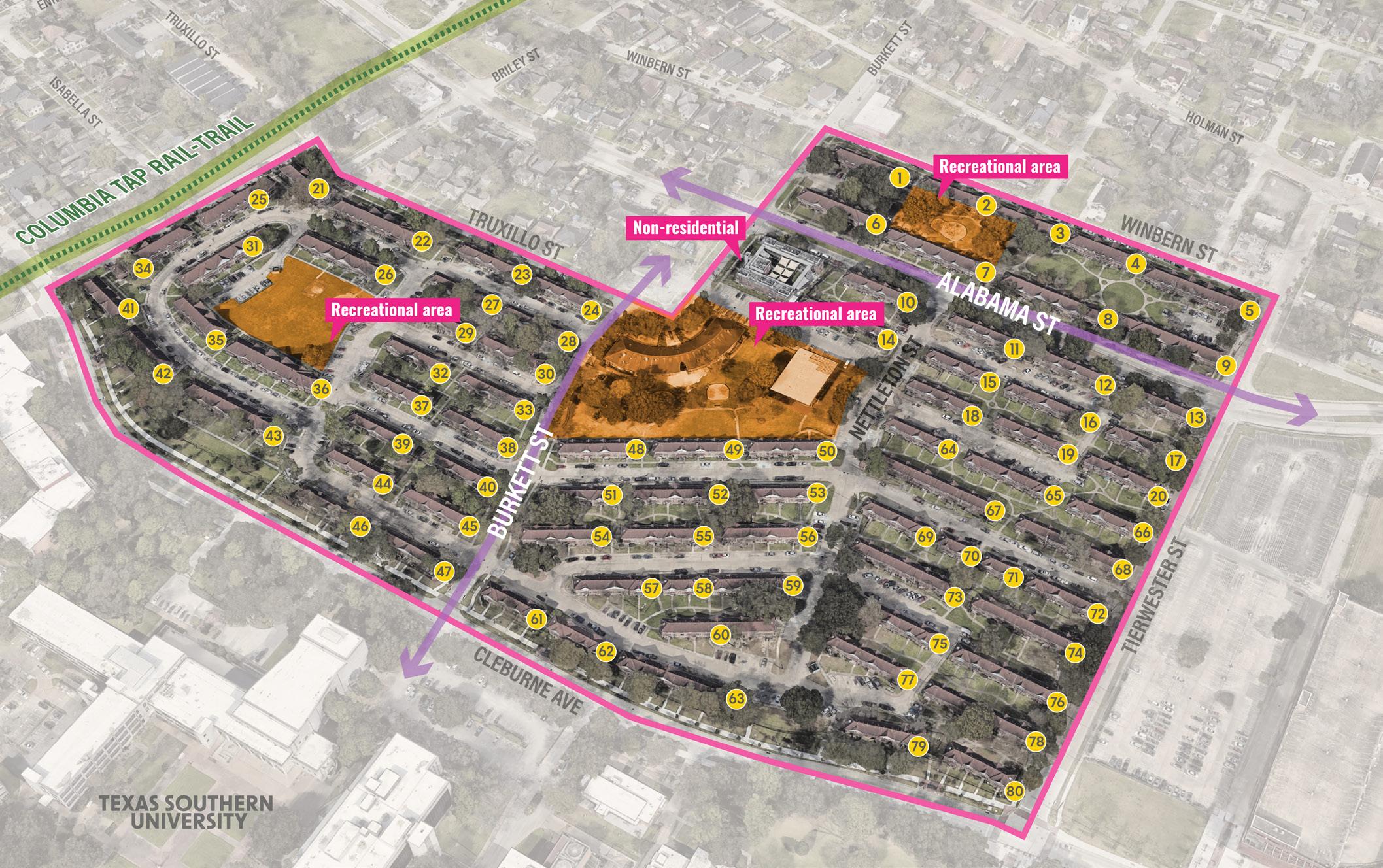
7% would like to live somewhere else in the Third Ward
79% YES!
"What do you like the most about Cuney Homes?"
The people, the neighbors, the sense of community
Being able to live in the Third Ward
Reporting changes in my income to allow my rent to go down
Being close to my family/friends, work, doctors, and church
Being able to attend on-site programs, events, and services
Cuney Homes was the first public housing built by the Houston Housing Authority. It was constructed between 1939 and 1941, with the express purpose to house Houston’s African American population. The complex is comprised of 553 homes, with 519 occupied at the time of the Choice Neighborhoods Initiative application for a total population of 1,124 in 2021. These homes are spread across 80 buildings on 32.68 acres. The unit breakdown is as follows:
f 224 one-bedroom units 750SF
f 229 two-bedroom units 1,000SF
f 81 three-bedroom units 1,100SF
f 19 four-bedroom units 1,200SF
The complex includes two-story concrete block buildings clad in brick, arranged with parking and surrounding lawn areas. A central basketball court, community center, and baseball diamond are included on-site as well.
The buildings are arranged in a traditional barracks-style configuration, creating a great deal of open lawn area, but no true community gathering spaces. The homes lack air conditioning, particularly burdensome in Houston’s subtropical climate, and do not meet modern standards for size. The concrete block construction makes any significant retrofit or reconfiguration prohibitively expensive. New development is an opportunity to reconfigure the property and better connect Cuney Homes residents with the surrounding Third Ward neighborhood, and to provide a more comprehensive mix of housing types, incomes, and demographics for a wider range of Houstonians.
Source: HHA
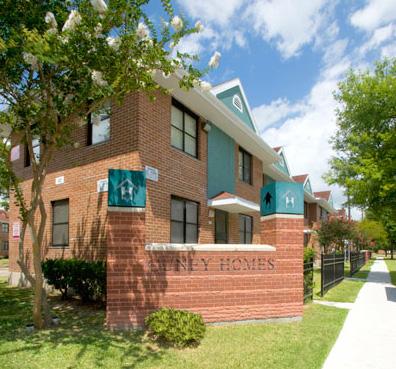
“I love it. [Cuney Homes] is my home, is my everything.”
Erma Phillips Cuney Homes resident
“I have not seen a community that was any better than this. (…) I have seen a lot of my friends and my parents go, but somehow, they returned every now and then when they can and I have enjoyed that.”
Jewel Brown
Third Ward resident
Cuney Homes sits along Alabama Street, which serves as an almost invisible dividing line between the character of housing that once distinguished the northern part of the Third Ward from the larger brick houses found in the southern end.

North of Alabama Street, the lots tend to be smaller and were traditionally populated by modest pre-World War II, single-story, wood frame houses arranged in a row. Built for working class households, many of these homes have welcoming front porches that reflect a strong sense of community. Yet, their light wood-framed construction requires upkeep and maintenance, which can be expensive for those on limited budgets. Many of these houses are deteriorating past the point of reasonable repair, placing the neighborhood’s historic housing stock at risk. With demand for housing in Houston skyrocketing and the location of the Third Ward so close to downtown, more than 500 homes in the Northern Third Ward have been demolished since 2010.
Demolishing these original houses to increase density and modernize construction may make financial sense, but the original texture and character of the neighborhood requires consideration. Preserving and repairing historic homes is a recommendation repeated in multiple recent plans, as is keeping the homes at affordable rates to avoid displacement.
In addition to the single-story shotgun-style house, other housing types represented in the neighborhood range from duplexes, triplex/fourplex apartment buildings, and townhomes, to larger-density multifamily complexes. Most houses are either slabon-grade or elevated several feet on piers with crawlspaces below. Construction is either wood frame or brick, with lower-slope gable and hip roofs. Front setbacks are deep, and porches remain important.
New construction is scattered across the neighborhood. Although meeting the need for more modern housing stock, it tends to be at a height and density that does not relate to adjacent properties and overshadows the existing fabric.

Project Row Houses has rehabilitated some of the shotgun-style houses in the Third Ward.
Source: THe SISTerHooD MAGAZINe
It is important to understand the existing context and typologies given the connotation these building types and material selections may have for a rapidly redeveloping neighborhood. Relatively new housing types like townhomes can represent outside speculation, as do modern cladding, color, and material choices. These new housing types can be symbolic of outsiders and displacement and may be skeptically received by a community working to remain rooted in place. Redevelopment will require sensitive and contextual aesthetics and density.
Many of the older homes in the northern part of Third Ward are smaller, wood framed shotgunstyle homes.
Source: WrT
Row House CDC, a sister organization of Project Row Houses has developed affordable contextsensitive duplexes.

Source: WrT
In the last few years, new infill housing is popping up across the neighborhood at much greater heights and densities with little regard for the existing context.

Source: TeXAS oBSerVer
The Northern Third Ward Consortium was created in 2015 to lead a community-driven planning effort to address development pressures and critical issues of long-time Third Ward residents. This study comprehends the Emancipation Park neighborhood and the northern tip of the Third Ward.
Key strategies include:
f Preserve existing housing and develop new housing that meets current needs.
f Make neighborhood improvements, such as restoring historic sites, modernizing streets, and programming vacant lots.
Housing affordability and accessible homeownership have become pressing concerns across the entire city: the gap between what Houston residents should pay for housing and their actual housing cost is growing.
The City of Houston has more renters (57%) than homeowners; of those renter households, nearly half paid more than 30% of their income towards housing in 2018, a statistic defined as being “housing cost burdened.” Renters who are housing cost burdened are more susceptible to displacement than homeowners, with increasing difficulty to purchase a home without significant subsidy.
Households making the median household income in Harris County have seen median sales prices grow above what they can sustainably afford. Homeownership is commonly seen as a path towards wealth-building, so the increasing difficulty of closing this affordability gap is a concern for growing longterm wealth of city residents—a particular concern in communities of color, historically denied opportunities for wealth-building.
What is the Area Median Income (AMI)?
The AMI serves to classify how affordable the housing stock is. The AMI represents the point at which half of households earn more and half earn less.
What do the percentages represent?
f <50% AMI, very low-income households.
f <30% AMI, extremely low-income households.
Like its larger city, the Third Ward is facing housing cost challenges as well, for both homeowners and renters. Eighty-five percent of Third Ward renters who make less than $20,000 spend more than 30% of their income on housing, while 67% of homeowners at the same income range spend more than 30% of their income on housing. Across all income ranges, 50% of all Third Ward renters and 25% of owners are considered housing cost burdened.
Finding ways to create long-term affordable rentals and pathways to homeownership are high priorities for residents, and particularly important in a neighborhood facing development pressure: with so many residents already paying more than 30% of their income, rapid rises in housing prices could lead to displacement.
2022 Area Median Income values for the Houston metro area for a fourperson household:
f 30% AMI - $26,600
f 50% AMI - $44,300
f 80% AMI - $70,850
f 120% AMI - $106,300
What is housing affordability?
Housing affordability means that housing costs are within the means of the household.
HUD sets a threshold for housing affordability: households that spend more than 30% of the income in housing costs including rent, utilities, and taxes, are considered to be housing cost burdened.

The housing ladder infographic tells us how many households within the AMI threshold are housing cost burdened, based on Houston's Metropolitan Statistical Area.
Of those households renting, and below 30% AMI, 94.5% spend more than 30% of their income in housing costs, same as those households that earn between 30-50% AMI.
Of those households renting and between 50-80% AMI, more than half are housing cost burdened. More than half of the homeowners below 30% AMI and between 30-50% AMI spend more than 30% of their income in housing costs.
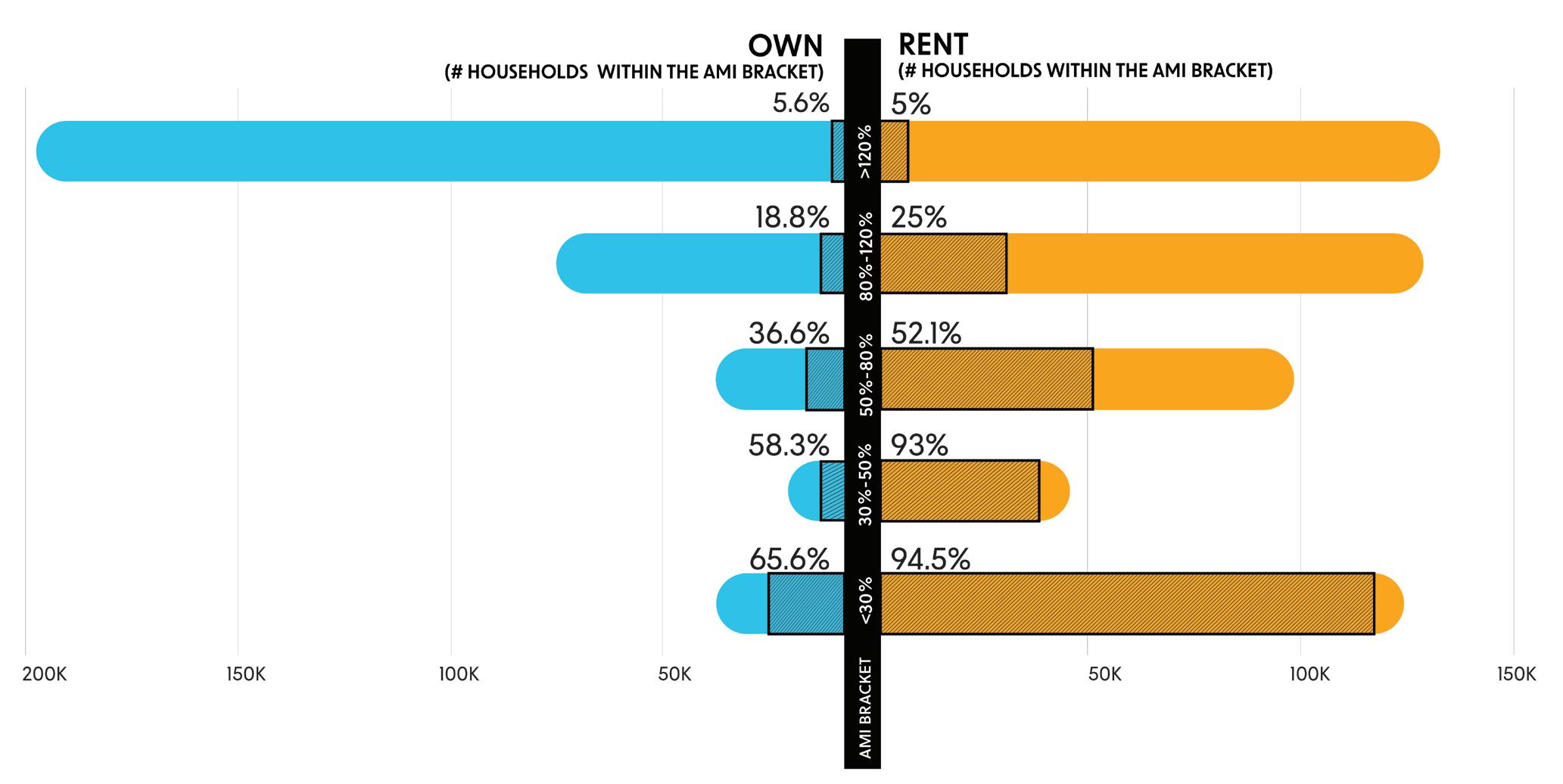
Only 18.7% of residents own their homes in the Choice Neighborhood, half the rate of Houston at large (37.6%). Seventy-three percent of Third Ward residents are renters, in sharp contrast to Houston as a whole (53%). These rates are not atypical for neighborhoods with lower household incomes, but high rates of renter-occupied housing creates several challenges with regard to stability as homeowners tend to protect their investment by maintaining their homes and it can contribute to the persistence of generational poverty.
Homeownership does not necessarily fully address affordability concerns: much of the historic housing stock in the Choice Neighborhood was constructed before 1940 and is in poor repair, and the cost of maintenance can be prohibitive for residents on low or fixed incomes. Additionally, as new development continues and housing costs rise, property taxes often rise as well, further burdening lower-income homeowners.
Anecdotally, many rental properties in the neighborhood are changing ownership from individual or small-scale property owners to larger management companies and LLCs; this consolidation of ownership can create additional challenges for the longer-term accessibility of ownership for local residents, and for small-scale real estate developers, such as a resident buying their next-door property to use as a rental investment.
Given the Third Ward’s proximity to Downtown Houston, its rich history, and formerly low housing costs, the neighborhood has attracted significant development attention in the past decade. In an assessment of susceptibility to gentrification, two of Houston’s most vulnerable census blocks lie within the Choice Neighborhood boundary.

BUILDING ON RECENT PLANS
The Third Ward Comprehensive Needs Assessment summarizes the findings of a comprehensive neighborhood survey of over 1,600 Third Ward residents, including 202 Cuney Homes households.
Key findings include:
f Strong sense of community and collective efficacy, that can serve as basis for positive neighborhood change.
f High concern by the loss of Black culture and presence in the neighborhood.
f Some concern about being displaced due to pressures of gentrification and rising costs.
As rents rise and median home prices increase beyond what lower-income residents might reasonably afford, anxiety about potential displacement is also rising throughout the neighborhood. Sixty-nine percent of Third Ward residents list high rents as a concern to their ability to stay in the neighborhood and 64% of residents reported “extreme concern” about the potential loss of African American culture in their neighborhoods.
Cuney Homes is the only Houston Housing Authority property within the Choice Neighborhood boundary, but there are three other LIHTC properties to the northwest of the neighborhood: 2222 Cleburne; Homewood at Zion; and Zion Gardens. Meanwhile, Housing Choice Voucher Program (HCVP) properties can be found throughout the neighborhood.
Cost-burdened renter:
f More than 50% of all the renters in the City of Houston spend more than 30% of their income on housing-related costs.
Median sales price and affordable housing price for median household income in Harris County:
f Between 2011 and 2018 median sales price rose from $139,000 to $220,000.
f At the same time, the affordable housing price rose from $163,121 in 2011 to $186,256 in 2018.
The Emancipation Park Neighborhood Plan, conducted by students and EEDC, is centered around the historical significance of the Third Ward to Black American history in Texas and responds to growing concerns over gentrification and displacement of long-term residents.
Key strategies include:
f Establish a community land trust.
f Support "responsible" mixeduse development.
f Activate vacant lots for community use.
What we have foundSource: "THe 2020 STATe oF HouSING IN HArrIS couNTY AND HouSToN" rePorT. KINDer INSTITuTe For urBAN reSeArcH, rIce uNIVerSITY.
The real demand for affordable housing in the Choice Neighborhood is much greater due to the blighted conditions of the existing housing stock. According to the 2019 Third Ward Comprehensive Needs Assessment, almost one quarter (23.5%) of Third Ward households live in severely inadequate housing. That rate is significantly higher than the under 2% nationwide figure reported by HUD.
“Inadequate housing” is a category that can refer to many different problems, but Third Ward households rank the following as their most common issues in their homes:
f Presence of rats in the home (41%).
f Open cracks wider than a dime (30%).
f Inside water leaks (25%).
L ong-term lack of repair and maintenance on the single-family housing stock leads to untenable living conditions over time, but residents may not feel they have much of a choice to relocate elsewhere to sturdier homes.
As the Third Ward Needs Assessment notes, lowerincome renters tend to be more vulnerable to evictions and therefore are often unwilling to report these severely inadequate conditions to a city official or their landlord. More stringent code enforcement or home repair programs may help bring up the quality of the Third Ward’s housing stock, but landlords may need real incentives – or fines – to be held accountable for improving the quality of their structures for their tenants.
Waterbody METRORail
HOUSING AGE
Choice Neighborhood Harris Country Major Highway 0% - 25%
26% - 50%
51% - 75%
76% - 100% Not Vulnerable No Data or No Population
Part of the Choice Neighborhood is very susceptible to gentrification in the City of Houston along with other areas shown in darker blue.
Source: rIce KINDer INSTITuTe For urBAN reSeArcH

Choice Neighborhood
Cuney Homes
University Area
Major Highway
Trail Park
Waterbody
AFFORDABLE HOUSING
Cuney Homes
Low Income Housing Tax Credit Property
HOME Program Activities
Housing Choice Voucher Program (HCVP)
Subsidized housing throughout the Third Ward.

Source: cITY oF HouSToN; HuD; HouSToN HouSING AuTHorITY
Choice Neighborhood
Cuney Homes
Major Highway
Trail Park
Waterbody
HOSING AGE
Before 1945
1946-1986
1987 to current
The proportion of pink properties indicates that the majority of houses were built before 1939.
Source: cITY oF HouSToN

Despite being divided from Downtown Houston by highway infrastructure, the Choice Neighborhood is relatively well served by public transit, primarily via buses, but also a light rail line, with plans to expand significantly in the near future. The Purple Line light rail, running north-south along Scott Street, has several stops on the east side of the Choice Neighborhood, adjacent to the University of Houston. A stop is located less than half a mile or less than 10 minutes from Cuney Homes. Multiple bus lines connect east-west through the neighborhood with stops at Cuney Homes.
A Bus Rapid Transit line, the METRORapid, is also planned to connect east-west along Wheeler, Alabama, and Elgin Streets, running directly through the Cuney Homes property. This BRT would help create more direct connections from the Choice Neighborhood to Midtown and north to the Fifth Ward, including direct connections to the Red Line and Purple Line light rail.
Veronica DeBoest Cuney Homes resident“I would like to see more transportation like we used to have here, because I was able to take the kids to places. (…) They went everywhere with the seniors, lots of places and lots of trips."
Houston’s METRONext Plan aims to transform the transit network through 500 miles of travel improvements in the Houston region. These improvements include 75 miles of Bus Rapid Transit, the METRORapid, and improvements to high-ridership bus routes, designated as BOOST routes. The Choice Neighborhood’s Route 54 bus line is slated to receive some of the first improvements in the city, including sidewalk and crosswalk improvements near the stops, bus shelters with lighting, and signal improvements.

Choice Neighborhood
Cuney Homes
University Area
Major Highway
Trail
Waterbody
BIKE NETWORK

Existing Bike Stations

Off-Street
Dedicated On-Street
Proposed Shared On-Street

Bike infrastructure in the Third Ward.
Choice Neighborhood
Cuney Homes

University Area
Major Highway
Park Park
Trail
Waterbody
TRANSIT NETWORK
Purple MetroRail Line

Red MetroRail Line
Planned Transit Cooridor
Shared On-Street Bus Route

BUS ROUTE IN NEIGHBORHOOD
Beechnut
Cullen Hirsch
Gulfton Holman
Richmond
Scott

Southmore
Public transportation in the Third Ward.
Source: cITY oF HouSToN
The Greater Third Ward has a Walk Score of 64, defined as “Somewhat Walkable,” which is higher than the overall Houston Walk Score of 48 (“CarDependent”). Walk Score® is a tool that "analyzes hundreds of walking routes to nearby amenities” and assigns a rating from 1 (car dependent) to 100 (walker’s paradise), taking into account features such as block length, number of intersections, and pedestrian safety. A Walk Score of 64 categorizes the Third Ward as a neighborhood where only some errands can be completed on foot, indicating additional room for improvement.
Only slightly more than half of Third Ward residents (56%) have access to a car currently, well under the Houston average of 92%. In fact, almost half of Third Ward residents with household incomes of less than $10,000 lack access to a car, bike, or motorcycle, increasing the importance of reliable public transit access and walkable streets for residents. However, many residents reported that sidewalks are missing or in disrepair.
Busy streets, fast traffic, wide blocks that prioritize curb cuts, and little shade also limit a safe and convenient environment for both walking and biking. The biggest transportation concern cited by Cuney Homes residents in the Needs Assessment was road conditions/potholes and flooding when it rains.
Limited bike infrastructure exists in the Choice Neighborhood currently, with Hutchins Street's onstreet infrastructure and the Columbia TAP Rail Trail's north-south connection through the Choice Neighborhood and to the Brays Bayou Greenway as key exceptions. However, additional lanes are planned to create a larger network for cyclists connecting to the city as transit trends predict an increase of bike boardings on METRO and bike share checkouts from Houston BCycle, which has stations at several key sites within the Choice Neighborhood.
The Houston Bike Plan focuses on a long-term vision for a well-connected, city-wide bike plan that is supported by policies and programs. The Plan strives to create a safer, more comfortable environment for all people on bikes, while providing access to opportunities, and improving community health and wellness.
Key strategies include:
f Increase safety and access.
f Grow ridership.
f Develop and maintain facilities.
Houston’s “Build 50 Challenge,” currently underway, is projected to bring 50 miles of on- and offstreet bikeways to Houston. Though most of the improvements are slated for Precinct 1, some improvements are also planned for the Third Ward, including east-west connections along Southmore, Alabama and McGowen Streets, and north-south connections like Emancipation Avenue and Live Oak Street. This planned bike network is projected to help connect Houstonians to where they need to go via cycling to create a real alternative to car commuting.
"Do any of the following issues present a challenge in your daily life?"
Pedestrian safety #1
Comfort/cleanliness of bus/ METRO stops #2
Safety of transit stops #3
Bicycle safety #4
Location of transit stops #5
Safety on buses/METRORail #6
Houston's first Climate Action Plan (CAP) focuses on a greenhouse gas emission strategy to meet the Paris Climate Agreement Goal of carbon neutrality by 2050. It has four focus areas: transportation, energy transition, building optimization, and materials management.

Key strategies include:
f Developing more housing near multi-modal transit connections to reduce car travel.
f Installing linear green infrastructure and tree plantings along wide urban corridors.
As new development creates available commercial space, neighborhood organizations are spearheading programs to support small businesses and entrepreneurship in the community. The Third Ward Complete Communities Action Plan emphasizes growing the local economy by testing communityowned cooperative models and pop-ups, supporting local businesses, and local hiring, particularly with the two major universities in the neighborhood. Project Row Houses recently launched the Financial Opportunity Center with LISC for Third Ward job seekers, providing access to financial and career counseling along with entrepreneurship classes. Small businesses like Crumbville Bakery and Doshi House have launched on Emancipation Avenue with organizational support.
Training for residents to hold positions in the CN is needed.
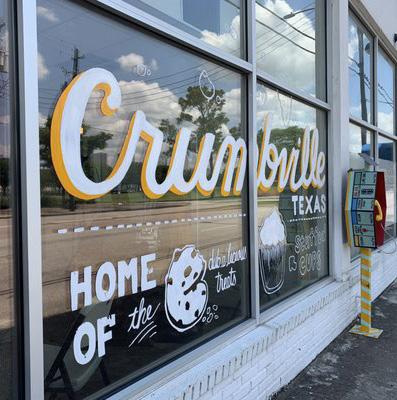

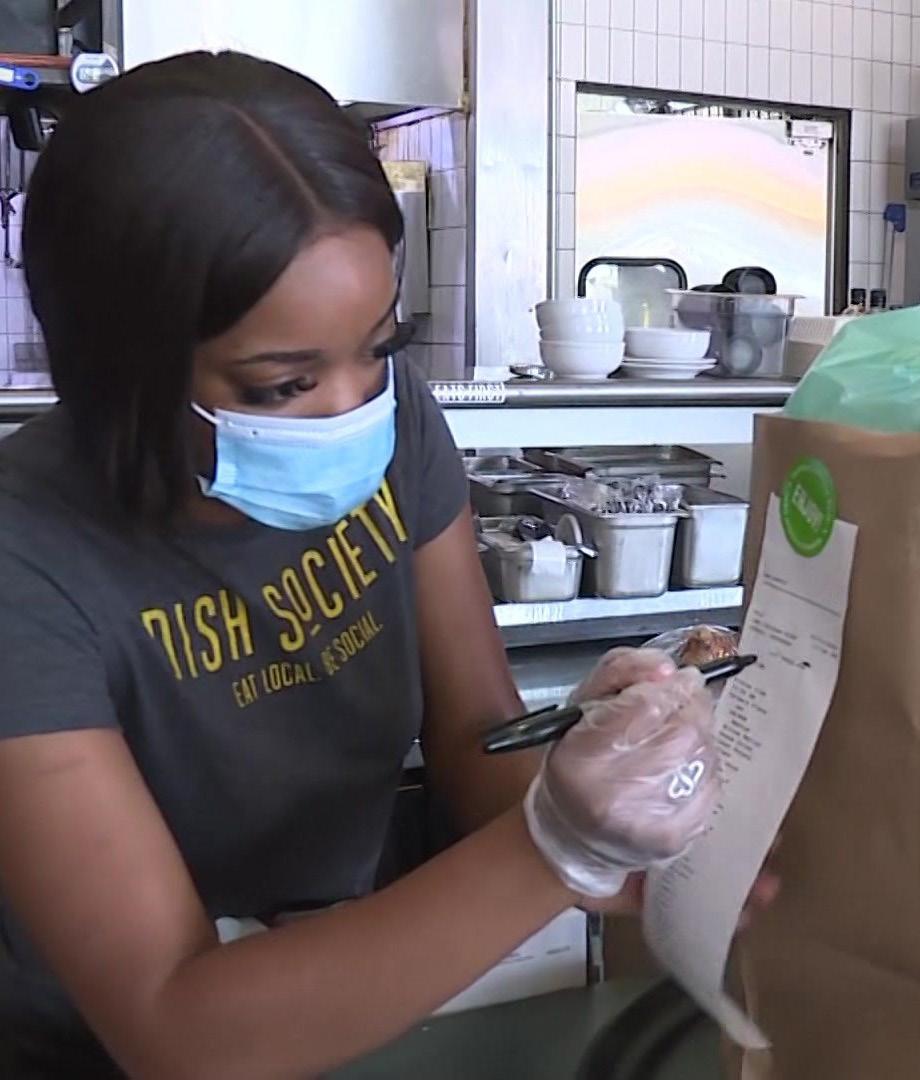
With major regional employment centers like Texas Southern University and the University of Houston, the Texas Medical Center, and Midtown and Downtown Houston all in close proximity to the Choice Neighborhood, the Third Ward is welllocated for workers. However, there is a mismatch between jobs in the neighborhood and jobs of residents: almost all employed neighborhood residents (99%) work outside of the neighborhood boundary. Meanwhile there are 2,630 jobs within the neighborhood, but 97% of those are taken by workers from outside the neighborhood.
Within the neighborhood boundary major employers are scarce, with Texas Southern University the only large anchor. Workforce training and resources facilities are proposed for the neighborhood (Texas Workforce Solutions) in order to provide training and house job fairs, and local businesses are encouraged to hire local.
Houston’s citywide unemployment rate is 5.4%, but the rate for the Choice Neighborhood is 14.3%. The Cuney Homes rate itself is twice as high as the surrounding neighborhood, at 31.8%. The Third Ward Comprehensive Needs Assessment found that only one-fourth of neighborhood residents reported working full-time. One out of five of those without employment reported an inability to work due to health.
A majority (62%) of unemployed Cuney Homes residents reported being out of work for over a year. The biggest barriers for employment included overcoming criminal history and background checks, with 73% of residents listing this as a barrier keeping them from employment; the next highest responses were lacking skills for available jobs (56%) and finding quality affordable childcare (54%).
Poverty is twice as high in the Cuney Homes households as it is citywide: the Houston poverty rate is 20.1% and the Cuney Homes rate is 39%.
6 months to a year 12%
63%
More than a year
25%
Less than 6 months
"If you are unemployed, how long have you been unemployed?"
“We asked the community, 'What is that you want? What do you need?' and they say it unequivocally, we need jobs.”
Bishop Frank Rush
Third Ward resident
The entire Choice Neighborhood lies within an Opportunity Zone, allowing for capital gains tax breaks for investments in projects within the zone. Some of the area is also within a Texas Enterprise Zone, whereby companies are nominated by communities to receive tax refunds based on the planned job creation and capital improvements. These incentives do not always influence the market enough to truly impact economically distressed communities, but may help finance eventual housing development within the Choice Neighborhood.
A Tax Increment Reinvestment Zone crosses into the Choice boundary: the Old Spanish Trail / Almeda Corridors TIRZ provides financing to stimulate commercial, industrial, and residential development in key corridors, especially streets and parks in the northwest of the Third Ward. Current projects funded through the TIRZ include streetscape and parks projects: the Emancipation Avenue Reconstruction Project, Emancipation Park and Community Center, Live Oak Street Improvements, Historic Holman Street Reconstruction, and the Greater Third Ward Neighborhood Project, among others.
Overcoming criminal history and background checks #1
Lacking the skills needed for available jobs #2
Mental health challenges such as PTSD/trauma/depression, anxiety #3
Not enough transportation options to get to jobs #4
Not enough education for available jobs #5
"What do you feel are some reasons that people in the neighborhood struggle to get a job or keep a job?"
"If employed, where do you work?"
“[The Third Ward] binds cultural and business entities and anybody can come in and get the opportunity to start their business; (…) you get a chance to be successful.”
Raymond Thompson Third Ward residentSource: cuNeY HoMeS reSIDeNT SurVeY, 2022
LEGEND
Texas Enterprise Zone

Opportunity Zone
Choice Neighborhood
Cuney Homes
University Area
Major Highway
Trail Park
Waterbody
Opportunity Zones and Texas Enterprise Zones in the Third Ward.
Source: cITY oF HouSToN
LEGEND
Choice Neighborhood
Cuney Homes
University Area
Major Highway
Trail Park
Waterbody
TAX INCREMENT REINVESTMENT ZONES (TIRZ)
OST / Almeda

Midtown
Greater Houston East Downtown
Tax Increment Reinvestment Zones (TIRZ) in the Third Ward.

Source: cITY oF HouSToN
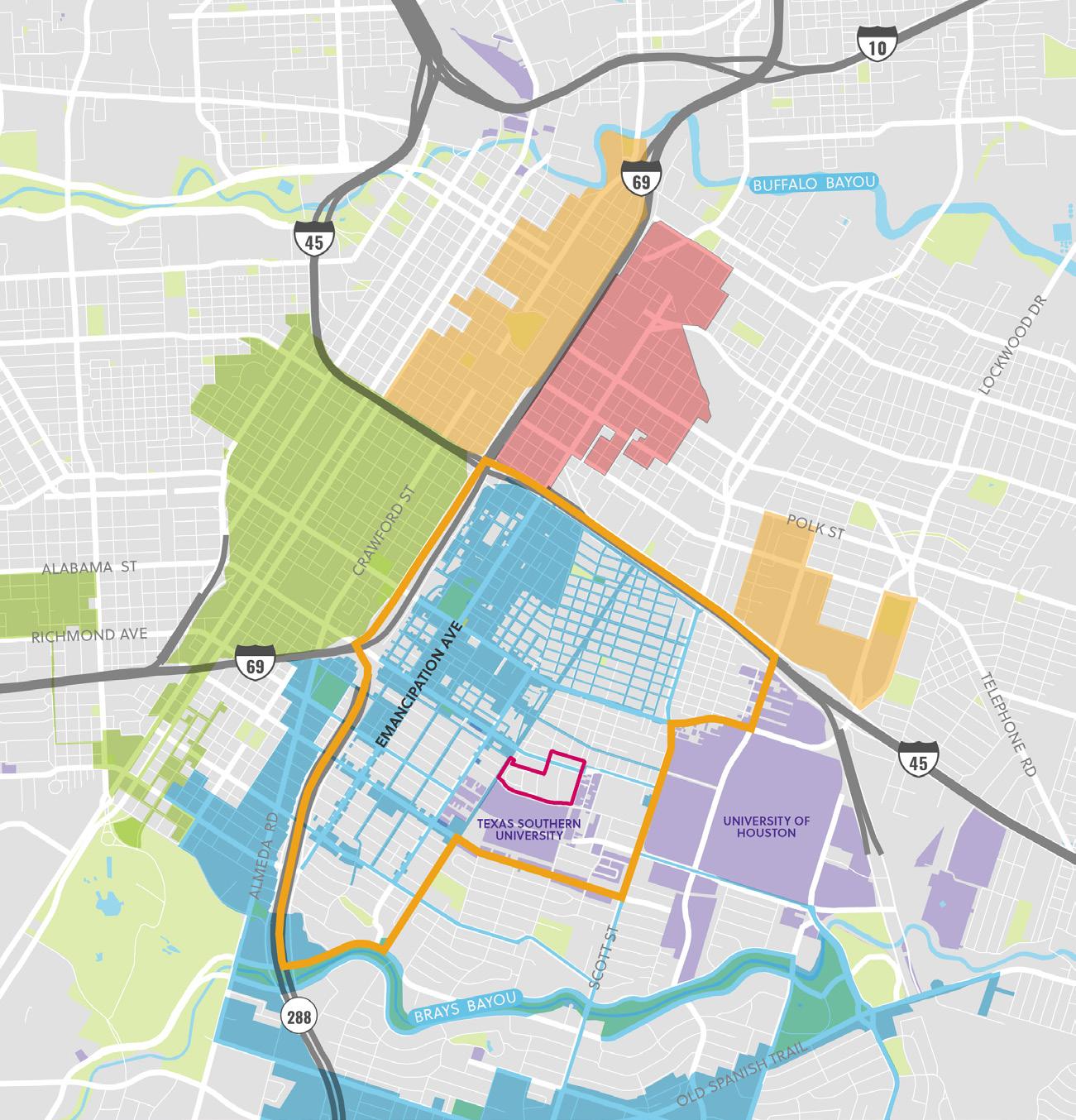
Educational attainment impacts the quality of life in many ways from earning potential, self-sufficiency and confidence to mental health. According to the Third Ward Comprehensive Needs Assessment, 80.9% of Third Ward residents have a high school diploma or GED while only 18% of residents have a bachelor’s degree or higher. Of the adult population at Cuney Homes, 76.5% have a high school diploma or GED and only 1.45% have a bachelor’s degree or higher, according to the Houston Housing Authority.
The path to educational achievement begins at a very young age. Early childhood education helps children develop the emotional, social, and cognitive skills at a critical time of development (ages 0-5), when the brain will achieve 90% of its growth, which is necessary for a positive long-term effect.
Of the respondents who took the Cuney Homes survey, 21% have children under the age of 5, and of those 58% are enrolled in a licensed Pre-K or early childhood learning. The top reason that children of survey respondents are not enrolled is cost. That was followed by difficulty finding a safe, quality pre-school program, and a lack of openings.
The Choice Neighborhood has several licensed early childhood education facilities that include:
f Pre-K programs for 4-5 year-olds at the two public elementary schools: Blackshear Elementary and Lockhart Elementary School.
f Pilgrim Day Care Center at Texas Southern University, which offers 140 slots for infants, toddlers, and pre-K students.
f SEARCH’s House of Tiny Treasures at the University of Houston, which is a nationally accredited preschool for children aged 2-5 who have or are experiencing homelessness.
f Generation One Academy at Cuney Homes: For over 15 years, this living laboratory for education research and development has provided a therapeutic environment geared toward building resiliency in families. The year-round program is for children aged 2-5 with after-school and summer programs.

I cannot find an affordable program that meets my needs
"Why are some reasons your children do not participate in a Pre-K or early childhood program?"
There are four public schools operated by the Houston Independent School District (HISD) in the Choice Neighborhood: Blackshear and Lockhart Elementary Schools, Yates High School, and a magnet program at Baylor College of Medicine at Ryan Middle School. In addition, Cullen Middle School serves Third Ward students from outside of the neighborhood. There also several charter schools in the neighborhood, including Yellowstone Academy, Texas Southern University Charter School, and University of Houston Charter School.

Based on data from the Houston Housing Authority and the Cuney Homes resident survey, it is apparent that children living at Cuney Homes attend a wide range of schools, many outside of the Choice neighborhood. The Texas Education Agency (TEA) annually assigns an accountability rating to all public schools. The rating is based on student achievement, school progress, and closing the gaps. In 2018-2019, only one of the public schools in the Choice Neighborhood achieved a rating above C, the Baylor College of Medicine. Blackshear and Lockhart Elementary both received C ratings, while Cullen Middle School and Jack Yates High School had D ratings.
“Are there additional services that would help your child do well in school?”
Summer programs #1
Individual tutoring #2
Additional after-school programming #3
Assistance with college #4
Homework club on-site at Cuney Homes Behavioral counseling #5
Source: cuNeY HoMeS reSIDeNT SurVeY, 2022
“Whatever needs to be done to make the lives of children better, needs to be accomplished. ...our children have exposure because of the people that run centers like [Baylor College of Medicine]. And that is why I think the Third Ward is just so wonderful.”
Lana Edwards Third Ward resident
Health is a strong concern for Third Ward residents. When asked about their most-desired service, store, or business for their neighborhood, almost 93% of residents responded that they wanted a hospital or health provider in their neighborhood, above other amenities like retail stores, restaurants, laundromats, or even childcare facilities. When asked how best to improve access to healthcare, Cuney Homes residents most requested more healthcare facilities in the neighborhood (73%).
In early 2022 the CenterWell Senior Primary Care facility opened in the Housing Operations Center on Emancipation Ave, providing primary healthcare for neighborhood residents aged 65 and older or adults with a disability, to help address the most pressing gaps in care.
However, the Third Ward lacks a dedicated healthcare facility for all ages, making primary care physicians and preventive care less accessible by other residents especially those without access to cars. Even for those who can leave the neighborhood, only 68% of Third Ward residents, 67% of Cuney Homes adults and 46% of Cuney Homes children have health insurance, much lower than the national average of 91%. Whereas Third Ward residents reported much higher percentages of routine checkups than individuals in Houston, Harris County, Texas, and the US, only 8.5% of Cuney Homes residents have an annual check-up and only 24% have at least one dental cleaning. Free health screenings are well-used by Cuney Homes residents, though, with 33% of residents reporting taking part in a health screening across the past year.
Local access and mobility to healthcare services are crucial, but even more important to residents is the affordability of that care: the biggest barrier to medical care for residents currently in the Choice Neighborhood is the cost of healthcare, with 38% of Third Ward residents and 67% of Cuney Homes residents surveyed listing cost as a barrier.
In a typical year, do the members of your
" We want a better life for everyone. We are not talking about mansions, but a better, healthy life.”
Clarice Freeman Third Ward resident
household...
"have an annual check-up?"
"have at least one dental cleaning?"
"take part in a free health screening?"
This percentage is even higher for barriers to mental health or substance abuse care, often not covered as consistently as physical health needs by insurers, with 71% of residents listing the cost of these services as a barrier. More local healthcare providers, access to mental health and substance abuse care providers, and access to affordable health resources are all of critical importance for residents.
The survey also found that Cuney Homes residents living in inadequate housing conditions were somewhat more likely to report having health concerns, such as asthma. More significant than the physical health correlation was mental health: residents reporting a mental illness or emotional or behavioral disorder in their households were much more likely to live in inadequate housing (16% of respondents in this category) than those in adequate housing (8%).

Health has correlations for residents’ employment: approximately one-fifth of residents without employment reported an inability to work due to health concerns. Diabetes, vision problems, and high blood pressure are also significantly higher among Third Ward residents than the rest of the city, with more than 20% of residents reporting vision problems and 14% reporting diabetes.
It
Source:
Locating more healthcare facilities in the neighborhood #1
Employing staff who are culturally competent and sensitive to my circumstances/ history/understand me #2
providing a shuttle to major medical facilities #3
Source:
"How could your access to quality healthcare be improved?"
Across the City of Houston there is a more than 20 year disparity in life expectancy. The census tracts with the lowest life expectancies correlate strongly with those of higher African American and Hispanic populations.
Life expectancy in the Third Ward is in the range of 74.4-78.5 years. Though this is not the lowest range for the city, it is still lower than the 2021 national average of 79 years, and far lower than census tracts in the city with a range of 86.5 years or more.
Residents of Cuney Homes and the Third Ward experience a number of challenges to their health and overall wellbeing. The fact that many of these are inter-related simply exacerbates the challenges further.
The USDA has designated portions of the Choice Neighborhood as a “food desert,” where affordable and nutritious food is not easily available. More than half (51.4%) of Third Ward residents are designated as food insecure, compared to 11.8% nationally.
That percentage is even higher at lower incomes: over 60% of Third Ward households with incomes of less than $10,000 screened as food insecure. Thirty-one percent of Cuney Homes residents report not having enough food to eat in their households about once or twice a week. The Third Ward Complete Communities Action Plan estimates that approximately 3,600 Third Ward residents struggle to access fresh food in their neighborhood. More than three-quarters of Cuney Homes residents report receiving SNAP/WIC benefits.
In 2020, H-E-B (MacGregor Market) opened the first full-service grocery store in the area in 20 years. The challenge is that it is at the far south end of the Choice Neighborhood, and not easily accessible by residents without cars. According to the USDA, twenty-five percent of Third Ward households do not own a car and live more than half a mile from a grocery store (Third Ward Complete Communities Action Plan / USDA Food Desert Map).
Despite the arrival of H-E-B, Cuney Homes residents listed a full-service grocery store as their mostrequested amenity in the neighborhood (72%).
Community garden efforts like the Blodgett Urban Farms and EcoTone are important civic hubs for the community and help to address the need for fresh produce. Further expanding and adding community gardens throughout the neighborhood can build local resilience and protect against shocks to larger food supply chains, as revealed in the COVID-19 pandemic, and can be one of several food security strategies.
“...Certainly, invite more in to come and be a part of the community. But let’s make sure we are taking care of the current residents of this area.”
Bishop Frank Rush
Third Ward resident
Choice Neighborhood
Harris County
Waterbody
Combined all race/ethnicity
86.5 or more
82.5 to 86.5
78.5 to 82.5
74.4 to 78.5
70.5 to 74.5
Less than 70.5
No Data
Life expenctency in the City of Houston.
Source: uT SouTHWeSTerN
MeDIcAL ceNTer
Choice Neighborhood

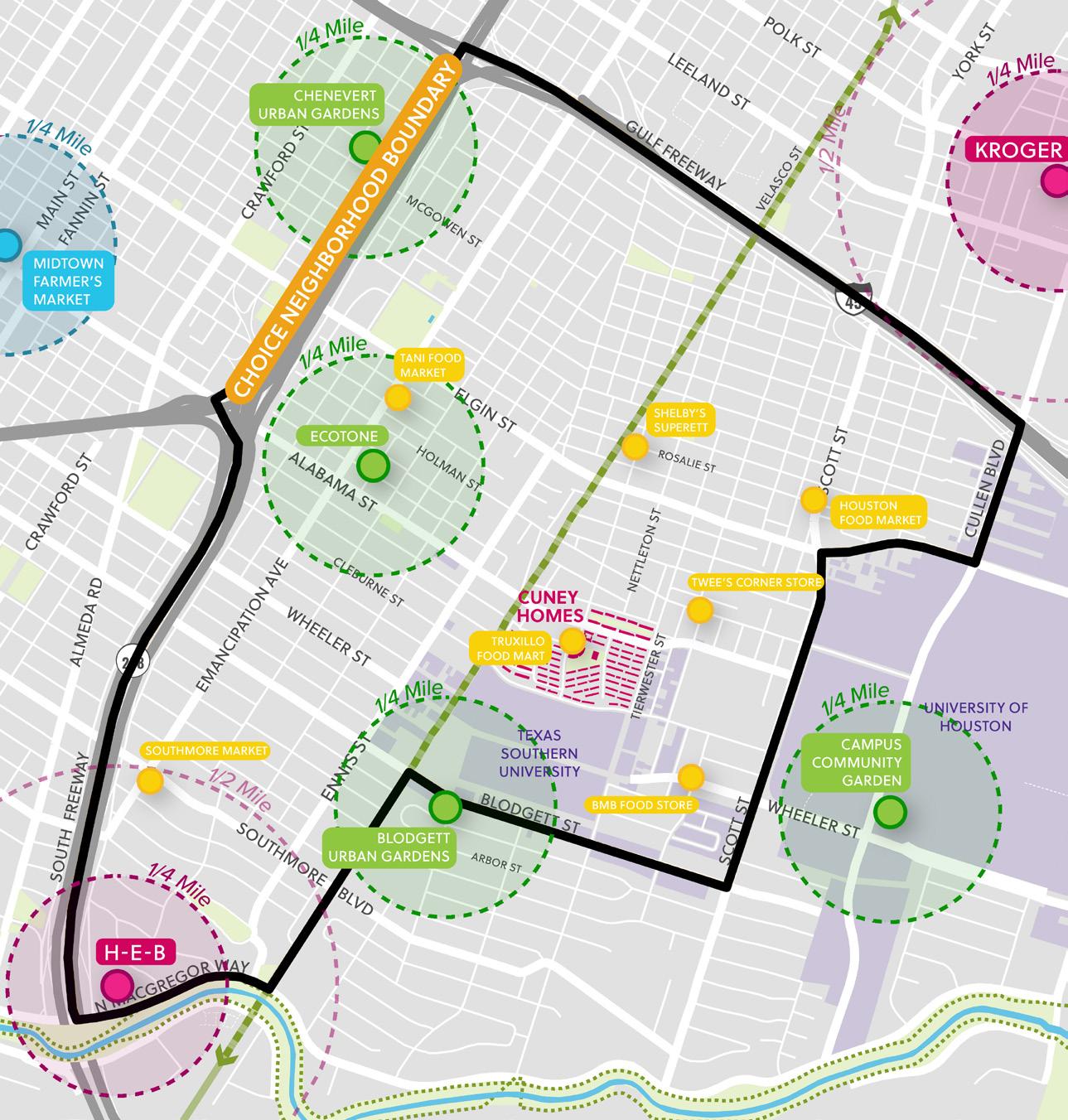
Cuney Homes
University Area
Major Highway Trail Park
Waterbody
Convenience Store
Community Garden
Farmer's Market
Grocery Store
Food resources in the Choice Neighborhood are very limited.
Source: uT SouTHWeSTerN
MeDIcAL ceNTer
According to the Third Ward Comprehensive Needs Assessment, a high percentage of current Third Ward residents have strong public safety concerns for their neighborhood, particularly at night, when only 31% of residents report feeling safe. Similarly, only half of Cuney Homes residents feel safe on-site, and only 27% feel it is safe to walk in the neighborhood at night.
More than 85% of Third Ward residents surveyed reported hearing gunfire, and drug dealing/use and gangs were also reported as being widespread. These feelings are echoed by Cuney Homes residents whose top safety concerns are: gun violence and gang activity, followed by domestic abuse, abandoned buildings and lots and child abuse/neglect. Only 33% of Cuney Homes residents feel safe allowing their children to walk and play outside.
Increased police presence is not necessarily a solution to these safety concerns, either: in a neighborhood where George Floyd lived, more than half (60%) of Third Ward residents feel neutral to distrustful about the police, compared to only 40% who trust the police. Yet it is notable that 78% of Cuney Homes residents surveyed disagree that there are too many police in the neighborhood. 66% of residents expressed that they want to be involved in making their neighborhood safer.
Public safety and crime impact not only Houston’s adults, but also its youth. As of 2021, 98% of those in Harris County juvenile detention were Black or Latinx (Redefining Youth Justice Coalition). Harris County is currently undertaking a $4 million Youth Justice Community Investment Fund for community-based, community-designed programs in neighborhoods like the Third Ward with kids most at risk.

Almost 75% of women in the neighborhood reported feeling like crime limited their movements in the neighborhood. No matter how well-located and well-connected the neighborhood may be, public safety concerns are keeping Third Ward residents from feeling comfortable moving around their neighborhood freely.
National Night Out event.
Source: HHA
“...We’re maintaining [the Third Ward] and making every strong effort to keep our neighborhood functioning and clean... The sense of unity and neighborliness exist because we are careful.”
Clarice Freeman Third Ward resident
100%
50%
0%
92% "Better communication from Houston Police"
91% "Better emergency response"
90% "Less trash and illegal dumping"
90% "Better lighting along streets"
Would any of the following changes make the neighborhood safer for you and your family? 94% "More visible security cameras"
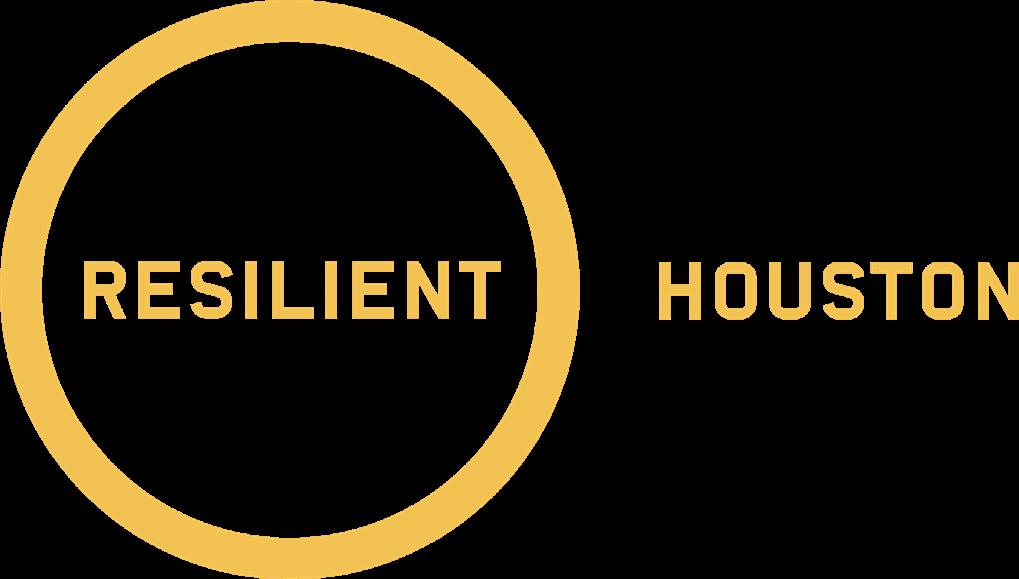
Resilient Houston develops a roadmap toward building the city's resilience to withstand a range of shocks and stresses, and establishes priorities and initiatives for implementation.

The Plan frames questions around discovery areas designed to help evaluate the effectiveness of programs and policies, and develop solutions.
Key strategies include:
f Achieve equity and inclusion.
f Build forward.
f Improve health and safety.
f Integrate housing and mobility.
The Third Ward has an extraordinarily rich culture of artistic expression rooted in its African American heritage that is immediately evident in colorful murals across the neighborhood.


Many recall the pinnacle of black culture in Houston— Eldorado Ballroom located across from Emancipation Park on Dowling Avenue (now Emancipation Avenue).
Built in 1939 and owned by African American businesswoman Anna Dupree, the “home of happy feet” was a fashionable venue for dancing that for three decades was also a premier showcase for local and national African American musicians. Historic greats like Count Bassie, B.B. King, Ray Charles, Bill Doggett, Etta James, Jimmy Reed, Big Joe Turner, and T-Bone Walker brought blues, jazz, R&B and occasionally pop and zydeco to this Third Ward landmark. In the 1970s, desegregation, a lack of parking, and changing tastes in music shifted attention away from the Eldorado. More recently, the building was donated to Project Row Houses, which is restoring the Eldorado to its former glory.
Project Row Houses is at the epi-center of the arts and culture in the Third Ward, through which it is fostering social engagement, community enrichment, and neighborhood development (see pages 111112). By celebrating, protecting, and elevating Black art, culture, and community, Project Row Houses is honoring the past while helping the community build a dynamic future.
Plan Houston intent is to create a common platform with coordinated strategies for implementation to guide the future development and investments. The Plan aims to celebrate Houston's history, culture, and people as well as promoting healthy and resilient communities.
Key strategies include:
f Engage and inform residents with equal access to opportunity and prosperity, and strong social ties supported by existing organizations.
f Affordable, high-quality supported services for all residents.
f A diverse, welcoming culture that is celebrated and respected.

“Here in the Third Ward you have everything, and it’s a beautiful place to be. (…) our culture is very much alive. The S.H.A.P.E. Community Center, Project Row Houses, we have so many organizations that keep our culture and our focus alive and well thriving into the next generation.”
Mini-murals in the neighborhood celebrate local artists and their heritage.

Source: HouSToN cHroNIcLe
BUILDING ON RECENT PLANS
City of Houston Arts and Cultural Plan identifies longterm priorities so arts and culture can benefits all residents and visitors. The Plan advocates for equitable cultural programming, allocation of cultural investments, and stronger relationships with cultural institutions.

Key strategies include:
f Promote engagement in quality arts and cultural programming.
f Enhance the support system for the city's deep cultural assets.
f Advance strategies to strengthen the local creative economy.
“One thing I love about the Third Ward is that no matter how old you are, we have a voice. And we make sure our voices are heard. And most of those people who are screaming at the top of their lungs have been artists, creative individuals, or cultural workers, which is beautiful.”
Community Music Center of Houston

Source: coMMuNITY MuSIc ceNTer oF HouSToN
Historic marker at Emancipation Park, accross from Eldorado Ballroom.
Source: WrT
S.H.A.P.E. Community Center, where memories of the Third Ward community are celebrated.

Source: WrT

RUEROB JacksonThird Ward resident
In 2020, the Texas Commission for the Arts established the Third Ward Cultural Arts District to “activate spaces of healing and create a haven for artists most in need of a place to feel safe to create and thrive.” The district also creates opportunities for visitors to participate in the work and connect with the community. Project Row Houses (PRH) is the management entity for the Cultural District.
In addition to PRH, a handful of dynamic organizations in the Choice Neighborhood are nurturing the arts. These include Workshop Houston, which offers culturally-specific, near peer-led arts education programs for youth involving music, fashion, dance, and media. The Community Music Center of Houston is a music and performing arts and education organization founded in 1979, to preserve, appreciate and perform music that reflects Black music traditions. The S.H.A.P.E. Center offers cultural, recreational, life skills, and academic enrichment activities for children and young adults to regain control of their lives and return their communities to their original greatness.

It is no surprise that the Third Ward has been home to many renowned artists. In addition to those mentioned above, Dr. John Biggers taught at Texas Southern University in the 1950s where he nurtured artists of color and many through Project Row Houses. The recent work of Third Ward resident Marc Newsome (aka Marc Furi) draws inspiration from his neighborhood, tracing the rapid gentrification through his I (heart) 3W project at Project Row Houses and his documentary I LOVE 3RD WARD series. In addition to Marc Newsome, Israel McCloud and Maya Imani Watson who also grew up in Third Ward were commissioned to take part in the Mini Murals Houston project that goes beyond beautification by paying homage to influential figures in the community.

In 1993, seven visionary African American artists—James Bettison, Bert Long, Jr., Jesse Lott, Rick Lowe, Floyd Newsum, Bert Samples, and George Smith—saw the potential of a series of run-down row houses at Holman and Live Oak streets in the historic Third Ward as a canvas to ignite social transformation.
Seven of the row houses are open twice a year to visiting artists to display works that address a topic, question, or challenge facing the community.

But that is just the beginning. Today, PRH spans five city blocks with 39 structures that touch the lives of artists along with under-resourced neighbors, young single mothers, small enterprises, and the entire community through:
Ever-evolving initiatives include the Third Ward Financial, Artistic, Career & Empowerment Center (FACE) to support community wealth building through financial literacy and career coaching. PRH’s Incubation Program provides space, time, and/or mentorship for entrepreneurs like Crumbville Bakery, Gulf Coast Cosmos Comicbook Company, Kindred Stories, and 3rd Ward Tours, bringing much needed retail to the neighborhood while lifting up local residents.
In addition to efforts such as managing the Third Ward Cultural District and restoring the Eldorado Ballroom, PRH is working with organizations to provide affordable housing that preserves the character of the neighborhood and maintains a vibrant, diverse community. PRH also helped form the Emancipation Community Development Partnership that led to the Emancipation Economic Development Council.
Project Row Houses: an international model for art and social engagement, community enrichment, and neighborhood development.

Originated in West Africa, the “shotgun” house was widely adopted in Black neighborhoods across the south. Although simple in form, row houses like those in the Third Ward are thoughtfully designed to respond to the local climate—letting cross breezes cool the interior—and foster community with front porches and shared outdoor spaces in the rear.
Celebrated artist, educator, and Third Ward resident, Dr. John Biggers was “a teacher, friend, and mentor to many of PRH’s founders.” He frequently included shotgun houses in his work, and the history and significance of the row house were recognized by PRH’s founders. The work of German artist and activist Joseph Beuys also influenced the founders who embraced his idea of “social sculpture” and the potential of shared artmaking to transform society.

The Third Ward’s parks are used for community programming and recreation, with more than 70% of residents reporting visiting a neighborhood park in the past 12 months. The Choice Neighborhood is proud to contain several culturally and historically important parks, highlighted by Emancipation Park, an important community gathering space commemorating the state’s first Juneteenth celebration in 1872. The $33.5 million renovation in 2017 preserves and fortifies the park as a center for recreation and civic life with a welcome center, aquatics center, children’s playground, recreation center with classrooms, health center, basketball court, ball fields, picnic areas, outdoor courts, and renovated lawn. Another significant resource is Moses LeRoy Park, named after an important Third Ward civil rights and labor activist. Riverside Park and Brays Bayou offer green space and recreational amenities in the southern portion of the Choice Neighborhood while smaller parks dot the rest of the neighborhood.
When asked what amenities could improve the neighborhood some of the top responses related to parks & recreation were:
The Trust for Public Land is a national organization working to ensure that there is a park within a 10-minute walk of every person, in every neighborhood, in every city in the U.S. While Houston’s ParkScore® is 61%, slightly better than the national average of 55%, a closer look at the Third Ward-Cuney Homes Choice Neighborhood shows that the neighborhood is fairly well served. There are three key areas of moderate to high need:
f 1 - Between Scott Street and Cullen Boulevard north of Elgin Street;
f 2 - West of Scott Street around Alabama Street, including the area around Cuney Homes; and
f 3 - South of Blodgett Street around Ennis Street and Emancipation Avenue.
Another important asset is the Columbia Tap Rail Trail, a four-mile paved trail, which runs alongside Cuney Homes and connects residents south to the larger Brays Bayou Greenway system and north to downtown just blocks from Minute Maid Park, home of the Houston Astros.
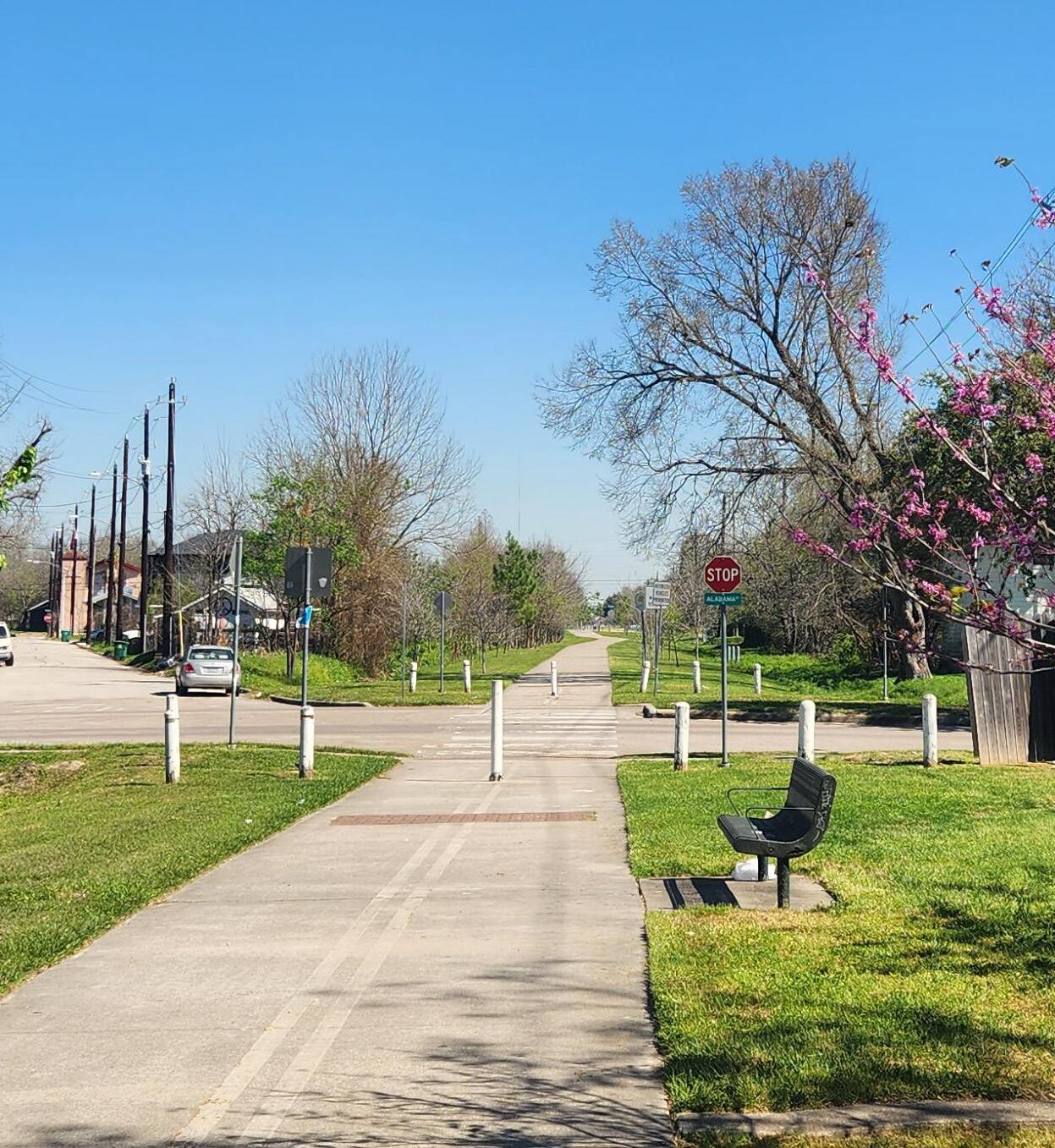
"Which
BUILDING
Houston Active Living Plan is designed to make "active living" easy by creating places where physical activities such as walking, biking, and playing are integral parts of everyday life. It recognizes that policy decisions and environmental changes across multiple sectors make an impact in public health.
Strategies are focused on Social Determinants of Health that celebrate cultural diversity and advocate for health equity.
Key strategies include:
f Offer active living initiatives that respond to Houston's diverse cultures.

f Design and build communities that are safe, convenient, and attractive for people of all abilities.
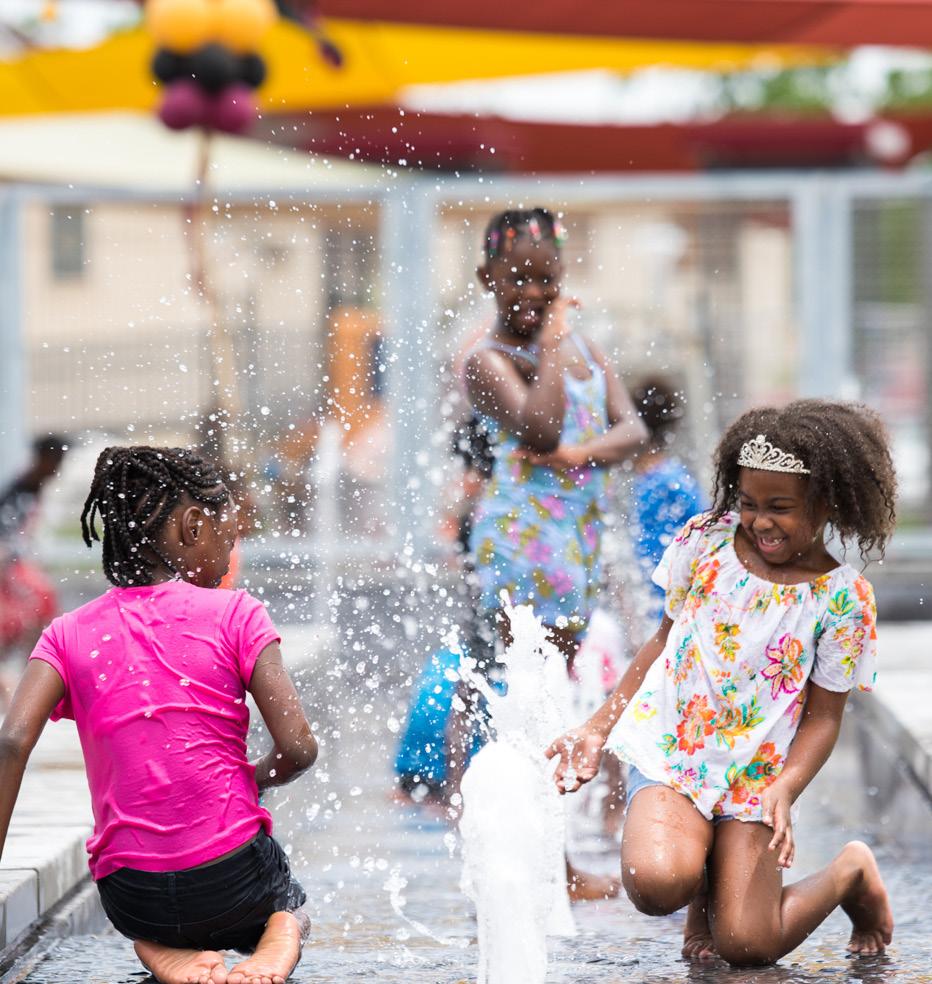
Houston at large has approximately 33.3 million trees with a canopy covering 18.4% of the City. This canopy is essential to shield Houstonians from intense heat, mitigate urban heat islands, and capture stormwater runoff — of particular importance in a hurricane-prone region with a projected increase in extreme storms. The Houston-Galveston Area Council estimates that Houston’s tree canopy provides over $100 worth of environmental benefits per person per year, saves $90 per household in energy costs, and removes more than 60,000 tons of air pollution per year.

In the Greater Third Ward many residential blocks have existing tree canopy coverage, including some of the vacant lots in the northern half of the neighborhood, but there is further capacity for expanding the canopy. The main commercial streets (Southmore Boulevard, Blodgett Street, Elgin Street, Emancipation Avenue, and Scott Street) and some of the blocks to the north and west of the neighborhood have been identified as opportunity sites to integrate additional tree plantings.
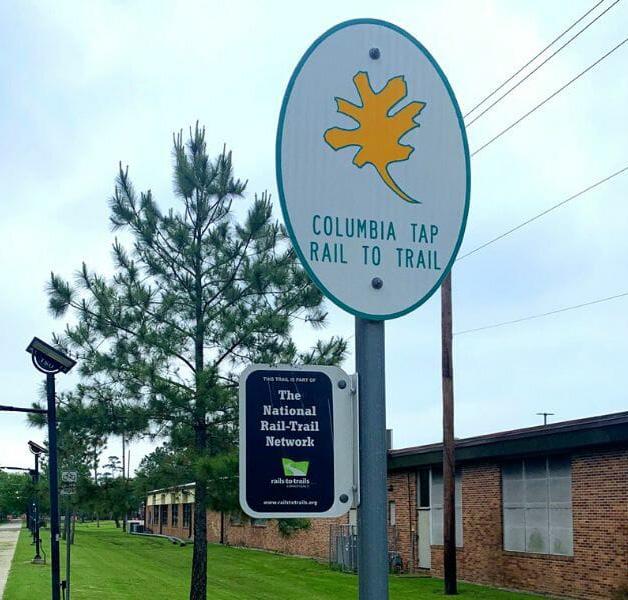
A Gulf Coast city with a subtropical climate, Houston is at risk for extreme climate events, particularly hurricanes and heat waves. Fortunately for the Choice Neighborhood, flooding is not a broad concern here, other than the area directly abutting Brays Bayou to the south of the neighborhood boundary.
However, extreme heat is a health hazard for a neighborhood with poor building stock and lowerincome residents: houses are often very energy inefficient and poorly insulated, raising the costs of air conditioning and placing residents at higher susceptibility for mortality during heat waves. The heat index skews higher in nearby Midtown and Downtown, where there is more impervious surface and dark roof coverage. Yet, the Greater Third Ward neighborhood is still assessed as having a moderateto high degree of vulnerability to extreme heat and health impacts due to the overlap between socioeconomic vulnerabilities (age, mobility) and environmental (low tree canopy, aging building stock).
With high-temperature projections rising in the 21st century, finding ways to mitigate extreme heat and protect vulnerable communities will become even more critical. Home energy retrofits, tree planting, and reducing impervious surface coverage are some of the ways neighborhoods like the Third Ward can help lower high surface temperatures in urban blocks.
LEGEND
Choice Neighborhood
Cuney Homes
University Area
Major Highway
Trail Park
Waterbody
PARK ACCESS
Park with Amenities
1/4 mile walkshed
1/2 mile walkshed
This map illustrates 10-minute walking access to the parks. A few edges of the neighborhood are in need of park space.
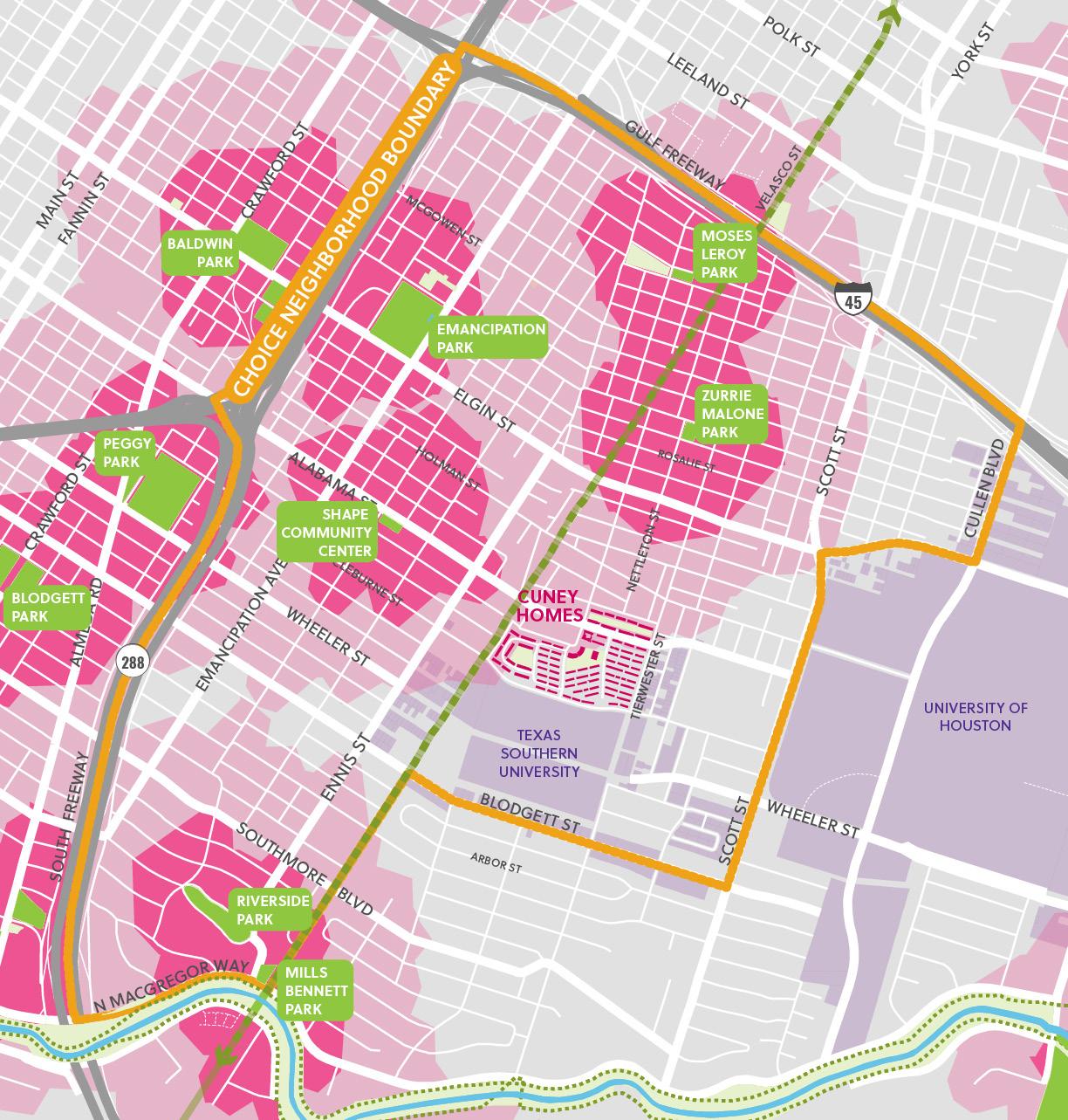
Source: cITY oF HouSToN
Choice Neighborhood
Cuney Homes
Major Highway
Waterbody
HEAT MODEL
Lower Temperature
Higher Temperature
This map show the threat of heat to many areas of the Choice Neighborhood.

Source: HeAT WATcH HouSToN AND HArrIS couNTY AFTerNooN
TeMPerATure MoDeL

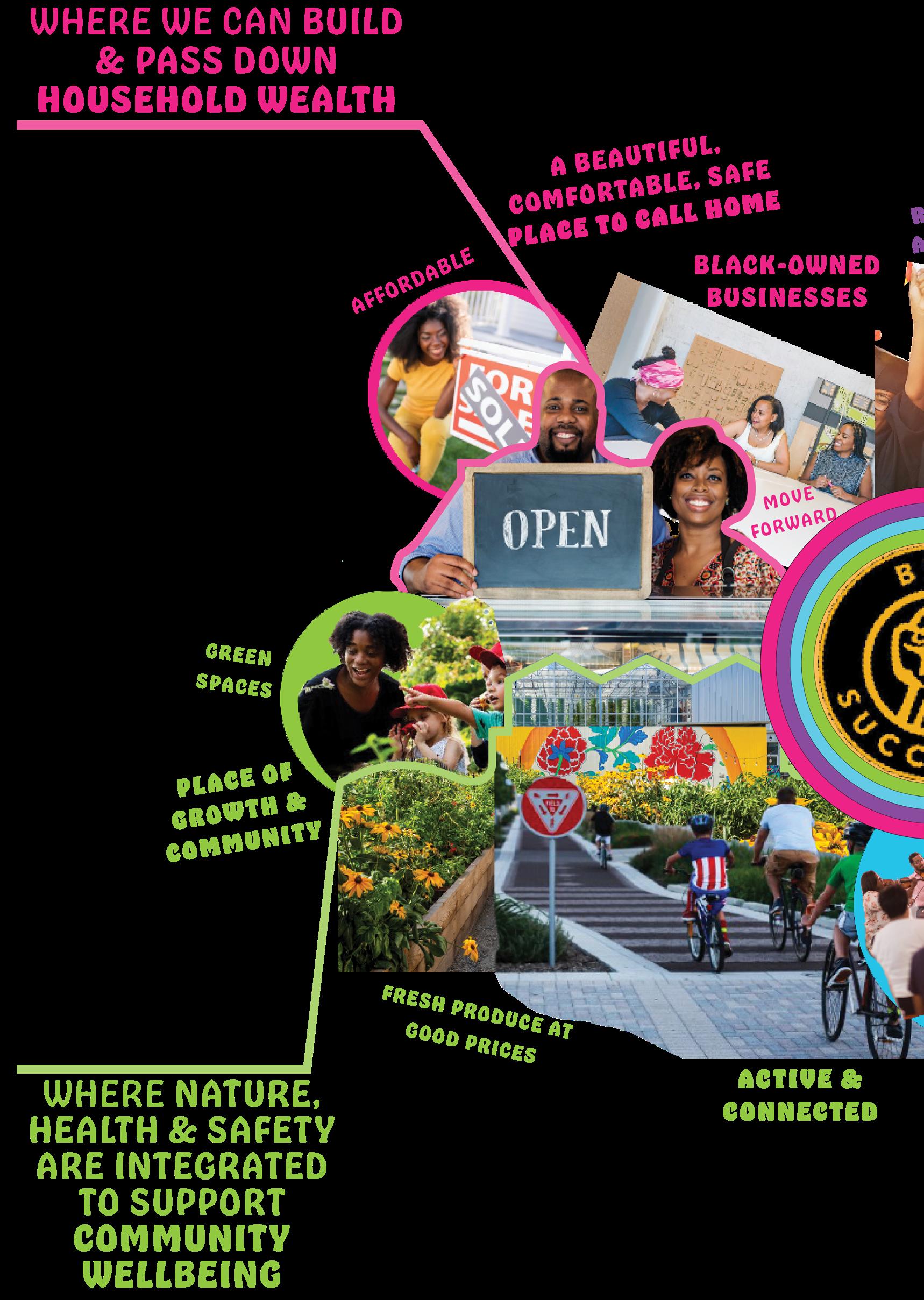
We would love the Third Ward to be known
Shaping a path for the of Cuney Homes and an inclusive planning current residents have Ward’s rebirth. It is centered Ward’s deep tradition
as a thriving & prosperous community. A place...
the future redevelopment the Third Ward involves planning process to ensure have a place in the Third centered around the Third tradition of civic activism.
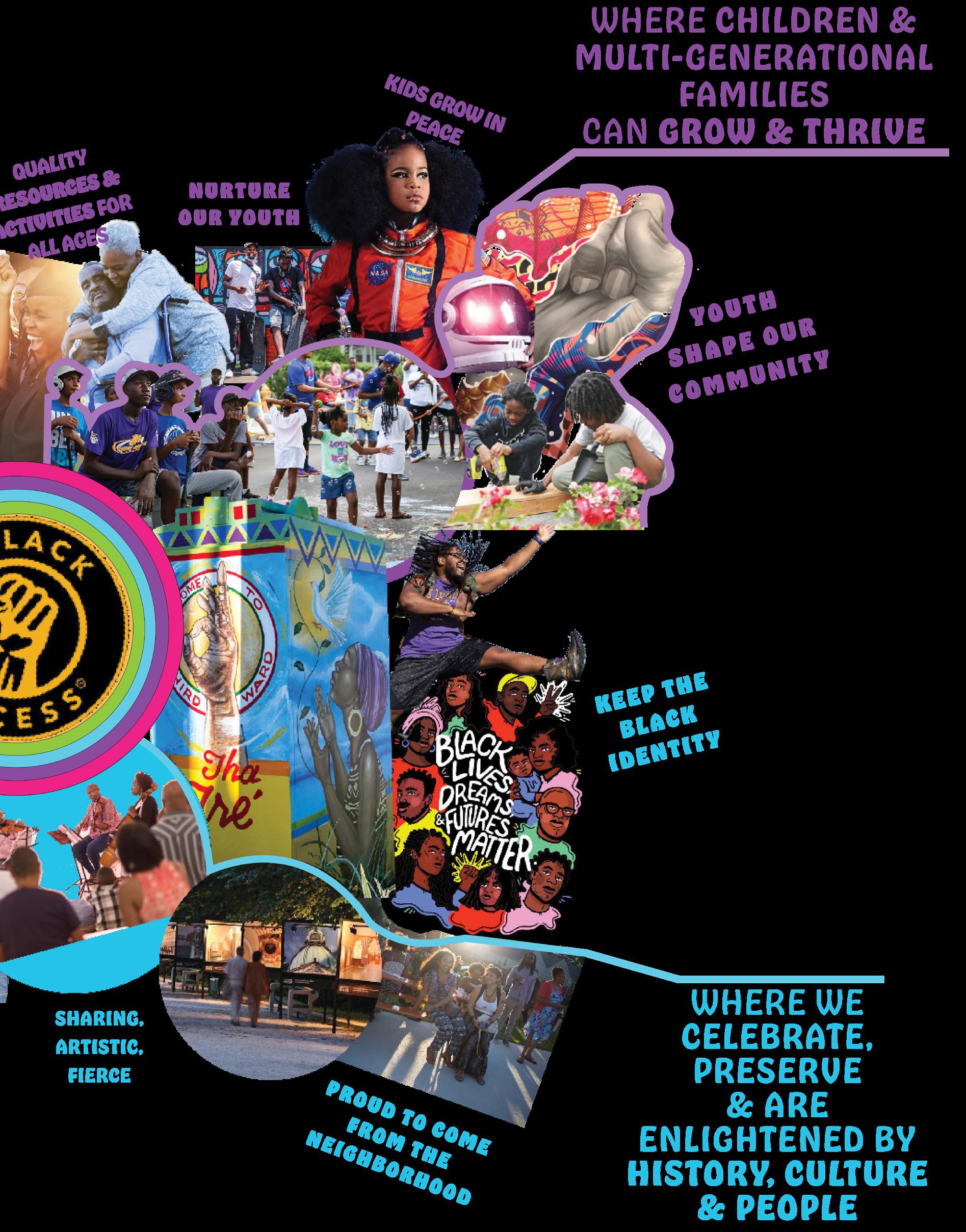


These core goals of housing, people, and neighborhood create a framework for the Third Ward-Cuney Homes Choice Neighborhood Plan.
Goal 1: Increase the number of residents with access to preventive care including annual exams, screening, and dental cleanings.
Goal 2: Increase the number of residents with a neighborhood primary care physician and pharmacy access.
Goal 3: Reduce food insecurity by providing high-quality, affordable food access for all Cuney Homes residents.
Goal 4: Increase awareness and access to mental health services and emotional health support.
Goal 5: Ensure that all the residents who would like to return to the Third Ward neighborhood are able to with support from Community Health workers.
Goal 6: Increase access and participation in physical activity to advance mental and physical health, wellbeing of Cuney Homes residents.
Goal 7: Increase access, participation, and awareness in quality Early Childhood Education by creating the Third Ward Alliance of Childcare and Early Education providers in the Third Ward-Cuney Homes Choice Neighborhood.
Goal 8: Expand awareness and support among Cuney Homes families for career-training opportunities and benefits and increase the percentage of high-school graduates entering college or career-training programs.
Goal 9: Increase opportunities and participation in after-school and out-of-school programs and provide enrollment assistance.
Goal 10: Increase household income through securing higher-paying jobs and opportunities for business ownership and entrepreneurship in the Third Ward.
Goal 11: Reduce the unemployment rate among workready residents by providing local job opportunities, regardless of criminal background.
Goal 12: Increase access to employment for youth ages 14 to 21.
Goal 1: Establish a sense of place through the recognition of community history.
Goal 2: Provide inclusive community gathering and recreation spaces through accessible design for persons with disabilities, spaces to keep both seniors and youth active, and maintain multi-generational spaces and educational spaces.
Goal 3: Improve access to basic needs, services, and amenities within walking distance of Cuney Homes and in the Third Ward. Enable residents and Black businesses to fill current gaps.
Goal 4: Establish Cuney and the Third Ward as a safe and resilient community with better relationships with law enforcement, community resources, and activated vacant lots and open space.
Goal 5: Connect residents safely to transit and complete streets. Provide more accommodating and safe transit stops, improved sidewalks and street crossings.
Goal 6 : Provide spaces and opportunities for civic engagement. Build political power through leadership capacity building and political engagement.
Goal 1 : Preserve and increase affordable housing within the Third Ward.
Goal 2: Limit displacement of Cuney Homes and Third Ward residents.
Goal 3: Redesign Cuney Homes as a welcoming place that fosters community and celebrates the historic character and rich African American culture of the larger Third Ward.
Goal 4 : Create a community that fosters health, wellness, and safety for residents and visitors of all ages as well as businesses.
Goal 5 : Support the needs of seniors and residents with disabilities.
A resilient community through connections, accessibility, relationships, and recognition of the history.
A close-knit community through the preservation of the history and culture.
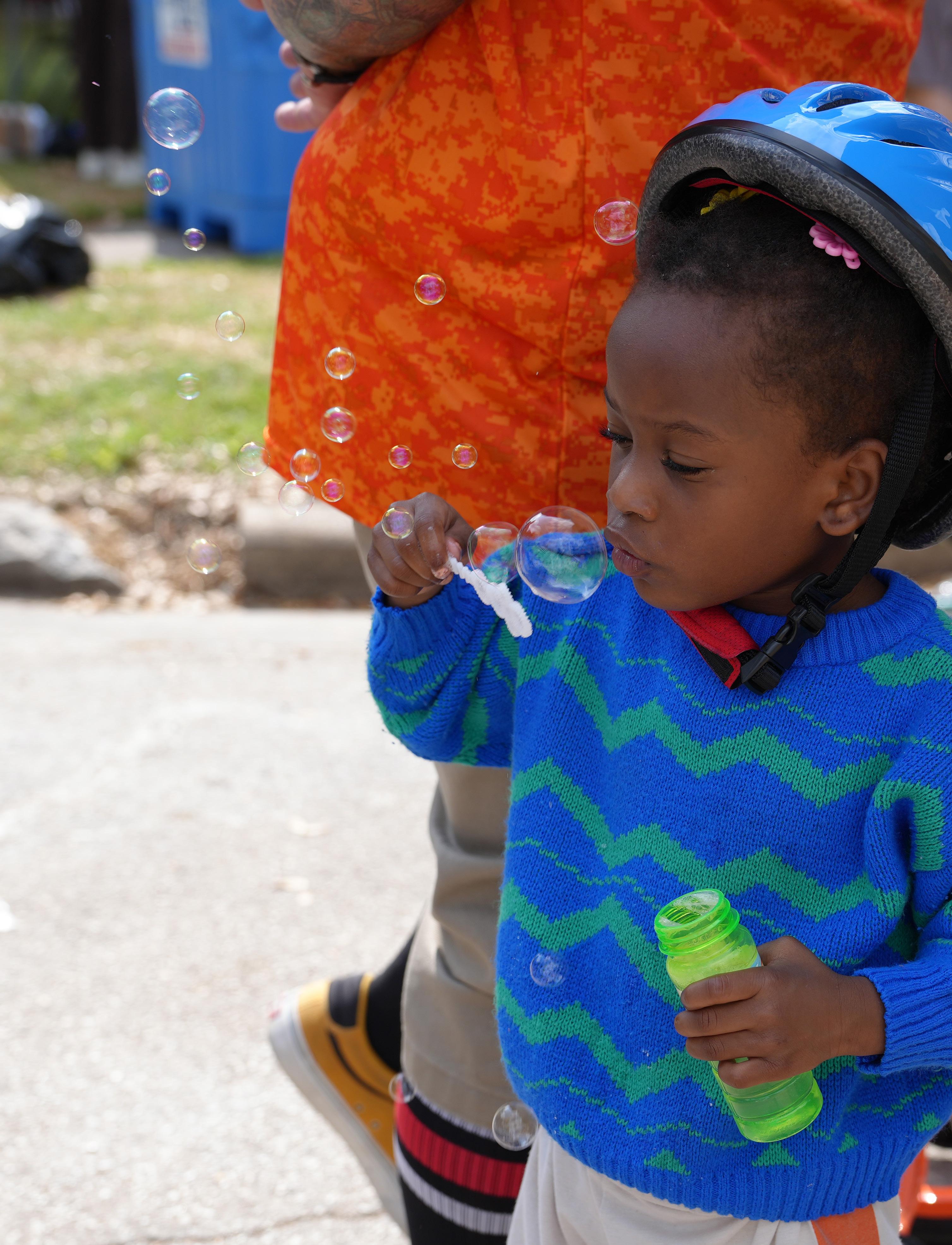
Third Ward, a place to grow and enhance community wellbeing and resilience through active resident engagement; connection to its history; educational opportunities; and pathways to building wealth and culturally responsive health and wellness resources.

The people framework begins with the voices and aspirations of Cuney Homes residents. By intentionally centering the people strategies around residents, we are able to connect and ensure the efforts of service providers and health professionals are responsive and meaningful. Several mechanisms bring these voices to the center, beginning with the understanding that the complex and dynamic lives of the residents require flexibility across a broad range of service providers. The people framework will include 10-15 Community Health Workers , drawn from the resident population and trained on-site, who will provide the first line of case management, as overseen by the academic team and including licensed social workers with the appropriate experience. The engagement with Community Health Workers is not based on needs assessments alone, but on a discussion of goals, aspirations, and barriers to achieving those goals. Reframing the engagement in this way means that the residents are treated as having strengths that are not fully expressed, and the role of the Community Health Workers and the people team is to help remove barriers to that success.
Cuney Homes residents are not treated as customers deserving to have their needs met or not, but as people who have faced barriers to their flourishing. The pathways and strategies for flourishing then require food, housing, behavioral or mental health services, education, or other services. This framing ensures that the residents see the reason for the services and see them as responsive to their larger personal goals, which helps to center the interactions in the community’s sense of itself. The academic team helps provide the tools for recognizing larger patterns and creating more systematic recommendations; the recognition of community strength and assets centers the transformation in the community, even as it recognizes that there are problems to address at a system-wide level. The professional providers will be organized into a network that responds to the community by gathering insight into the barriers faced and seeking change through reducing those barriers and creating better conditions for success.
Third Ward, a place to grow and enhance community wellbeing and resilience through active resident engagement; connection to its history; educational opportunities; and pathways to building wealth and culturally responsive health and wellness resources.
f Goal 1
Increase the number of residents with access to preventive care including annual exams, screening, and dental cleanings.
f Goal 2
Increase the number of residents with a neighborhood primary care physician and pharmacy access.
f Goal 3
Reduce food insecurity by providing high-quality, affordable food access for all Cuney Homes residents.
f Goal 4
Increase awareness and access to mental health services and emotional health support.
f Goal 5
Ensure that all the residents who would like to return to the Third Ward neighborhood are able to with support from Community Health workers.
f Goal 6
Increase access and participation in physical activity to advance mental and physical health, and the wellbeing of Cuney Homes residents.
f Goal 7
Increase access, participation, and awareness in quality Early Childhood Education by creating the Third Ward Alliance of Childcare and Early Education providers in the Third Ward-Cuney Homes Choice Neighborhood.
f Goal 8
Expand awareness and support among Cuney Homes families for career-training opportunities and benefits and increase the percentage of high-school graduates entering college or career-training programs.
f Goal 9
Increase opportunities and participation in afterschool and out-of-school programs and provide enrollment assistance.
f Goal 10
Increase household income through securing higherpaying jobs and opportunities for business ownership and entrepreneurship in the Third Ward.
f Goal 11
Reduce the unemployment rate among work-ready residents by providing local job opportunities, regardless of criminal background.
f Goal 12
Increase access to employment for youth ages 14 to 21.
“[The heartbeat of the community] is love. People love each other and care about each other. The heartbeat is right here."
Erma Phillips Cuney Homes resident
 Resident Ambassadors at the Food Pantry Tour.
Source: HHA
Resident Ambassadors at the Food Pantry Tour.
Source: HHA
f Goal 1
Utilize Cuney Homes trained Community Health Workers to serve as navigators to assist people eligible for marketplace health insurance and Medicaid coverage, providing education and application assistance.
The U.S. Dept. of Health and Human Services states that receiving regular preventative care reduces all sorts of risks associated with chronic disease, disability, and death, however millions of Americans don’t get these services every year. Through our needs assessment survey, Cuney Homes residents reported that only 8% of households have an annual checkup and only 24% have one dental cleaning a year. A focus of the people framework will be to have credentialed Community Health Workers (organized through the University of Houston's Community Health Workers Initiative) under the supervision of licensed social workers engage in goal-setting and prioritizing conversations with all residents. Within that larger context of trust-building and individualized health advocacy provided by the Community Health Workers, special attention will be paid to preventive health, including achieving health insurance coverage, discussion about healthcare access options, and assistance with applications. Additional partners include: Community care Cooperative, Third Ward Health Collaborative, and Civic Heart.
Establish a Coordinated Care Network of providers with access to a shared on-site medical space to deliver free dental cleanings, annual exams, and assist residents with preventive services.
A key strategy of the people framework is to have a shared on-site medical space that will be outfitted to serve as a landing base for Community Health Workers, host office/patient spaces, and provide health and wellness activities and resources. In order to facilitate the goal of increasing access to preventive care, Community Health Workers will receive resource matching tools to help individuals and families decide which resources best fit their needs. Clinical and other services available through the University of Houston and Texas Southern University will be highlighted, but a larger network of potential access points to specialized care will be made available to residents. Mental and behavioral health specialists will be available as part of the medical clinic presence, and the shared on-site space will provide dedicated areas for other health and wellness activities, including free dental cleanings, wellbeing appointments, cancer screenings, and preventive health exams.
Increase the number of residents with access to preventive care including annual exams, screening, and dental cleanings.
f Goal 2

Strategy A.
Employ Community Health Workers to assist in developing and maintaining a directory of primary care physicians in or near the Third Ward-Cuney Homes Choice Neighborhood, assessing patient needs, creating proactive plans, and supporting self-management goals.
A benefit of the Community Health Worker model is that they are trained to help residents see how health care fits into their long-term goals, and that keeping positive relationships with healthcare professionals, including a primary care physician, can be essential to their personal success. Many poorly controlled health conditions result from lack of a positive relationship with the healthcare system, even when access is possible, and the Community Health Workers
help create trusted relationships. Needs assessment findings show that residents are often seeking care for their children when sick at the Texas Medical Center or urgent care locations, and not necessarily with a primary health care practice. To support the Community Health Worker mission, a directory of multiple providers will be developed, with help in assessing the options, as a first step along a pathway that allows each Community Health Worker to help each resident and family to navigate and establish relationships with local primary care practices and pharmacy services. The directory and outreach services will be supported through the Community Health Workers Initiative and Community Care Cooperative, including
Source: HHA
Engage anchor institutions to establish a patient assistance program to engage pharmaceutical companies and nonprofits in offering commonly prescribed free or low-cost medications to residents who do not qualify for or are not adequately aided by other forms.
The Third Ward Community Cloth Cooperative is a direct outgrowth of two long-time community initiatives: S.H.A.P.E. Community Center's Project Harambee and the Houston Area Urban League's Coffee and Conversation. As a facilitator and connector, the Third Ward Community Cloth Cooperatives will lead efforts to engage a patient assistance program benefiting Cuney Homes residents focused on managing and improving chronic health conditions. This community-based organization will engage for-profit healthcare businesses, nonprofit healthcare organizations, and local colleges and schools of pharmacy. These partnering organizations will work to establish a fund to assist residents with paying for medications, identifying residents to enroll, and determining what medications to prioritize for financial assistance. Monthly staff support will be provided from the Emancipation Park Conservancy and Third Ward Community Cloth Cooperative in the process of becoming a Hope Dispensary nonprofit site.

"How could your access to quality healthcare be improved?"
f Goal 3
Establish an on-site food coop that allows ownership/investment options, provides fresh fruits and vegetables, and offers monthly cooking or other healthy food sessions for residents.
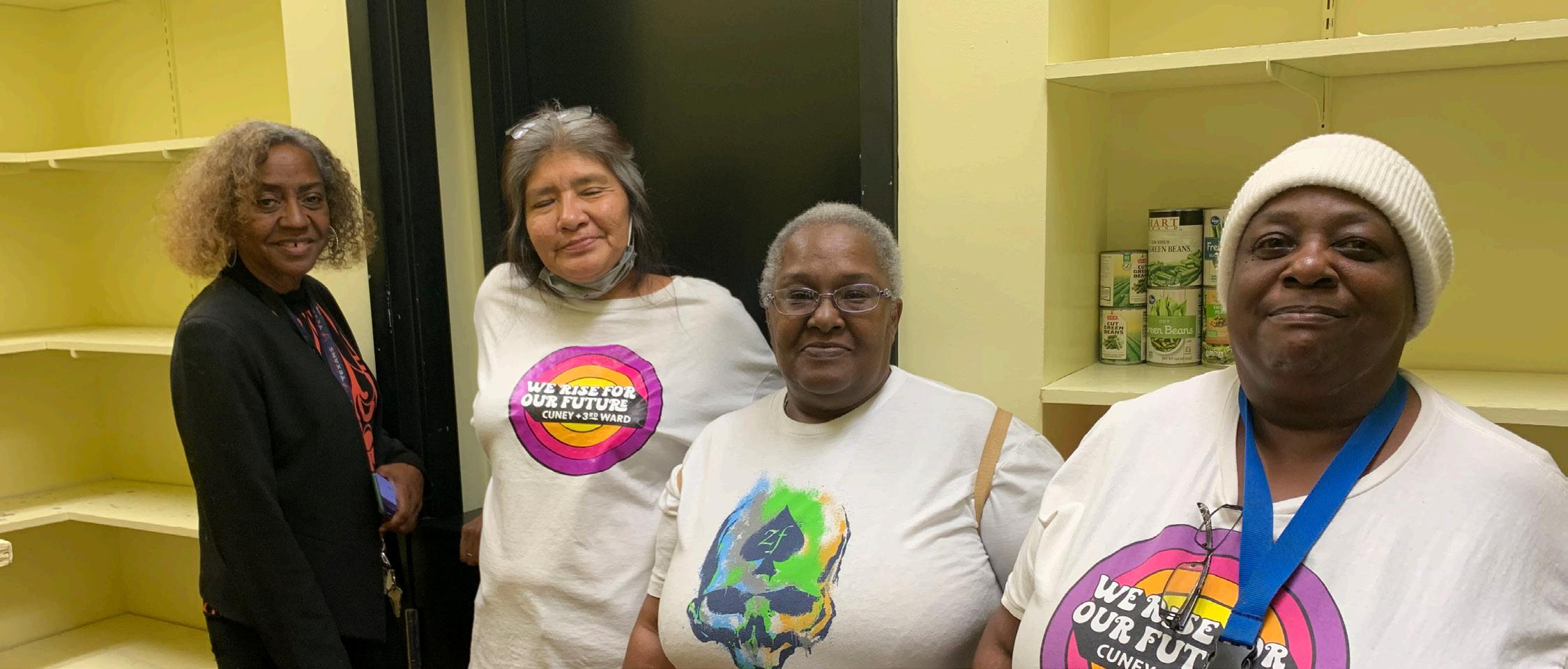
Some 36% of residents reported not having enough food to eat at least once or twice a week. Residents hired and trained as leaders for the Third WardCuney Homes Choice Neighborhood planning process became involved in addressing food insecurity among their neighbors. Working with Community Health Workers who are members of the Community Care Cooperative, the American Heart Association, and Fit Houston, residents have started a food pantry to provide fresh vegetables and non-perishable staples to 100 families each week.
Building on this work, a steering committee will be formed to include community non-profits in food security, the Emancipation Economic Development Council, the University of Houston’s Bauer College of Business and College of Medicine, Lone Star Legal and We Are The Ones Solidarity Cooperative to complete a feasibility study of opening an onsite food cooperative to serve the unmet needs of residents. We Are The Ones Solidarity Cooperative will provide training to residents to educate them on how a food cooperative is a unique business that better meets their economic, social, and cultural needs through a shared equity model providing employment opportunities and healthy, affordable food through environmental and social responsibility.
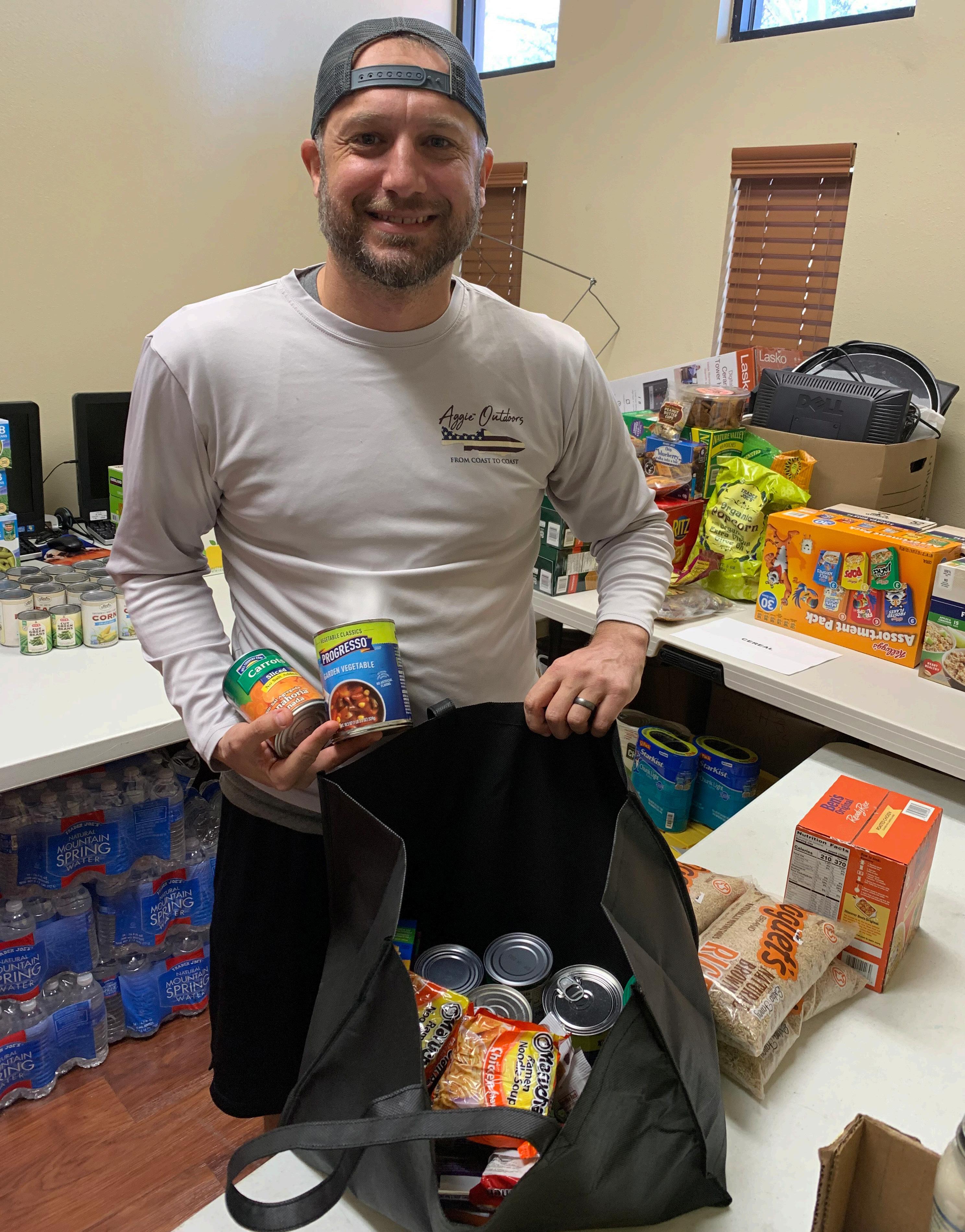 Feeding Our Future Pantry donation drive on February 2023.
Source: HHA
Feeding Our Future Pantry donation drive on February 2023.
Source: HHA
f Goal 4
Employ and train Cuney Homes residents to serve as Community Health Workers to provide information on mental and behavioral health services to residents and develop culturally relevant resources under supervision.
As with other health resources, the Community Health Workers frame this encounter so that the residents see the services as responding to their own goals and not as an imposition from an expert assessment of their needs that feels exterior and unrelated to their own experiences. Because the experts are invited into the pathway, they are more likely to be successful in encouraging success on multiple fronts. Many residents recognize themselves as needing mental health resources, but don’t know how to access them or don’t trust the resources that are offered. Building upon the existing partnership between Community Care Cooperative, Emancipation Economic Development Council, and Dr. John Saunders (a Black psychiatrist, offering grief council at SHAPE Community Center to parents who are recovering from the murder of their children), Community Care Cooperative will compensate two trained community health workers to work with Dr. Saunders to create mental health resources specifically for Third Ward residents. Building trust between residents and providers and ensure that all available mental and behavioral health services are well-utilized and appropriate is a priority. Partnering clinics offer integrated behavioral and mental health services, and these programs can be at the forefront for the residents through peer support groups and directed outreach.
Establish on- and off-site, peer-led support groups for residents.
During workshops focused on improving health, residents shared that they often turned to one another for support when going through difficulties. To build upon this existing ethic of care among residents, Community Health Workers from the Third Ward will receive additional training led by Dr. Sanders with support from health professionals from the University of Houston, Houston Recovery Initiative, and Community Care Cooperative to organize and facilitate support groups. These will be held on- and off-site for accessibility and anonymity. Peer support has been shown to be an innovative and effective way to bring more people into the healing process and provide a stronger support network to address a broad range of behavioral and mental health conditions.
“Have you or anyone in your household been diagnosed with any of the following health conditions?”
Employ Cuney Homes trained Community Health workers to support residents with peer-to-peer education and assistance in relocation and return, required notices, relocation process, right to return, and supportive services and resident tracking.
The University of Houston’s CHWI Training Center currently provides a 160-hour certification course and continuing education hours and is approved by the Texas State Department of Health and Human Services. The University of Houston will increase its offering of Community Health Worker certification courses at Cuney, building on the June 2023 pilot initiative, explicitly with the goal of hiring existing residents to work in support of the goals for education and assistance for all residents. The specific challenges of relocation and return, keeping up with the paperwork including required notices, exercising the right to return, and tracking outcomes for all residents, will be topics of special training for the community health workers and key components of the outreach and education provided to the residents.

Ensure that all the residents who would like to return to the Third Ward neighborhood are able to with support from Community Health Workers.Community Ambassadors on the 2022 Community Workshop Source: KAMILLe DeVILLe
“[The Third Ward] is special because of the people who are here.”
Akua Hunter
Third Ward resident
 Third Ward residents attended the Third Ward On Tap event to celebrate the Columbia Tap Trail.
Source: HHA
Third Ward residents attended the Third Ward On Tap event to celebrate the Columbia Tap Trail.
Source: HHA
f Goal 6
Hold on-site group exercise classes and share information on free and incomebased fitness membership offerings.
Fit Houston, a local and diverse organization focused on improving daily life and mental wellbeing for Houstonians of all ages, backgrounds, and abilities, will work collaboratively with peer organizations to facilitate increased physical activity in Cuney Homes. The residents will be the leaders in their own health journey, and Fit Houston will work alongside them to identify the physical activity fitness formats that they want to participate in and facilitate relevant partnerships. Fit Houston will also use a “train the trainer” model to ensure that power and leadership comes from within the community. For example, they will facilitate the training of Community Health Workers to lead health and wellness classes such as walking groups or basic strength training.
Hold fall, spring, and summer Sports Fairs for youth and families and create a recreation fund to assist with registration fees and equipment supplies.
Fit Houston will work in partnership with residents to create fall, spring, and summer Fit Family events for increased exposure to sports-influenced workouts. They will identify opportunities for Cuney Homes families to engage in sports and other activities at the nearby YMCA and in the school setting. Sports team trainings such as football and soccer can be adapted to be shorter in length than a traditional sports team, therefore helping students to be included. In traditional sports formats, the skills acquisition can be too difficult for newly exposed students to master, therefore this shorter and truncated format can be appropriate for fitness. A partnership between the Residents Council and YMCA will continue to support organized team sports for Cuney Homes residents.
Establish a bike sharing station at Cuney Homes with reduced user fees for residents.
A Cuney Homes dedicated bike sharing station will help residents to have access to active transportation and the joy and freedom of riding a bike. A bike station with reduced fees, safety classes, and bike donations are possible through partnerships with local nonprofits that negotiate with the bike sharing company. With reduced or no fee for riding, residents have access to accessing stores and other resources with a bike being a main mode of transportation.
Increase access to and participation in physical activity to advance mental and physical health, and the wellbeing of Cuney Homes residents.
“I would love to see more activities for the children... and just more people being active, our elders being active having things for them."
Elaine JonesThird Ward resident
f Goal 7
Increase access, participation, and awareness in quality early childhood education by creating the Third Ward Alliance of Childcare and Early Education providers in the Third WardCuney Homes Choice Neighborhood.
Strategy A.
Assist families in finding and securing quality early education services in the Third Ward.
Only 55% of children under the age of 5 living in Cuney Homes are enrolled in a licensed childcare program. Families reported cost, quality, and the availability of openings as the main obstacles they face to enrolling their children in early childhood education programs. Licensed providers in the Third Ward indicate that they have current openings and that the majority of the students enrolled in their centers lived outside of the Third Ward neighborhood. The Third Ward Community Cloth Cooperative will lead the formation of the Third Ward Alliance of Childcare and Early Education Providers with the purpose of increasing access to high-quality education for all children from birth to age five and improving the effectiveness and support of the early childhood workforce in the Third Ward. The Alliance will establish a memorandum of understanding with providers to support ongoing collaboration in improving the quality of their services and strengthening business operations. The Alliance will negotiate dedicated slots for Cuney Homes residents, prioritizing those currently in or seeking to enter the labor market. This strategy is aligned with and will be coordinated with the Third Ward Complete Communities Action Plan recommendation to expand the number of subsidized and quality childcare spaces within the Third Ward.
Lana Edwards Third Ward resident“Things have changed with COVID and the children were trying to be taught at home with computers. And it was not easy for them. The lack of exposure that they had from those interactions change things. And many parents still had to work, which means some of them were home alone.”
"Why are some reasons your children do not participate in a Pre-K or early childhood program?"
Cost, I cannot find an affordable program that meets my needs #1
Quality - I cannot find a safe, quality pre-school program #2
#3
Openings - none of the programs I tried had spaces available
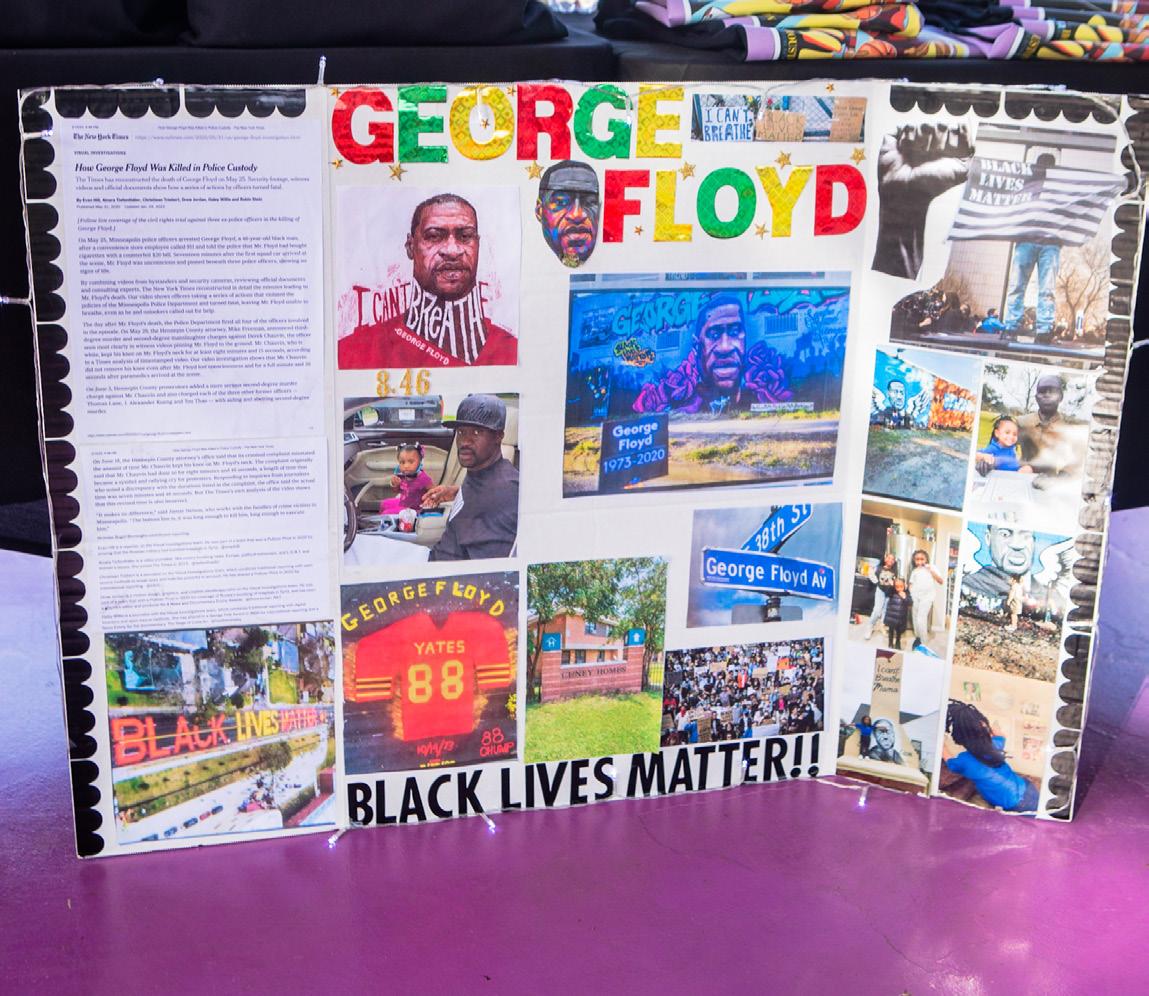
Assist home-based childcare providers through a jointly-owned cooperative that provides ongoing training, workforce professional development, and business services to enhance practice with a focus on quality improvement.
Residents not utilizing early childhood programs report relying on other residents to care for their children in their homes. Many residents indicated that they felt more comfortable with people they knew caring for their children. Recognizing these homebased providers as assets, We Are The Ones Solidarity Cooperative will engage these Cuney Homes residents in their interest in and the benefits of forming a childcare worker cooperative on-site. The cooperative will improve the quality and safety of care through ongoing professional training, reduce the cost of childcare through a shared-service model, and offer more flexible and responsive care to working families at night and on weekends.
Train and dedicate a team of parents as Community Health Workers to serve as early education advocates working with Cuney Homes families to build capacity and increase awareness.
The costs and access to childcare are the top reasons that parents at Cuney Homes report not having their children enrolled in early childhood education or Pre-K. Engaging community health workers as education advocates will assist families in applying to receive financial assistance. These advocates will participate in the Third Ward Alliance of Childcare and Early Education and actively communicate with providers to assist in expediting the enrollment of Cuney Homes children in high-quality programs when openings become available. The Community Health Workers will work with the Alliance to host a semi-annual childhood education fair at Cuney Homes to connect families to high-quality childcare programs, as well as provide updated information on childcare subsidy requirements.

f Goal 8
Expand awareness and support among Cuney Homes families for career-training opportunities and benefits and increase the percentage of high-school graduates entering college or career-training programs.
Train Cuney Homes residents to assist parents in forming a Parent Collective to build the knowledge and capacity of families to navigate educational and career pathways for students.
An estimated 65% of parents of school-age children in Cuney Homes expressed hope that their children attend college, and 26% hope that they start career training or enter the workforce after completing high school. Because more than 90% of the households have not obtained higher education, most of these students will become first-generation college students. Employing an asset-based model, a team of residents will be trained as advocates and lead the formation of a Parent Collective with the purpose of building a sense of community and peer support. Through the leadership of the trained advocates, the Parent Collective will host monthly support meetings and host workshops for requested assistance with applying to colleges or training programs for high-demand jobs. The Collective (to include Mothers on the Rise, SHAPE Community Center, Hype Freedom School, Leverage, INNERVERSE, Community Care Cooperative) will explore the creation of an education fund to assist students with the costs of attending college or career training, as well as developing a website or app to improve access to information and resources for academic enrichment. Additionally, these parent leaders will work to create partnerships between HISD schools, alumni, teachers, area non-profits, and universities to strengthen area schools.
Engage the Youth Council and Parent Collective to deliver academic and enrichment services on-site to promote and support college graduation and the completion of career training.
R esponding to what parents and students request to assist with academic success, the Youth Council and Parent Collective will engage local leaders and role models to offer a mentoring program for students. These mentors will offer onsite tutoring, assist with enrolling in out-of-school enrichment programs, help with college applications, and support families with financial aid applications. In addition to this individualized assistance, the Council and Collective will work together to host an onsite homework club to provide students with a comfortable, safe, and supportive environment. High school students involved in the Youth Council will be given an opportunity to be trained and hired as homework helpers to support their peers. The Homework Club will also provide young people with access to laptops or tablets, as well as offer them access to enrichment activities, such as workshops for arts and crafts, dance, theatre, music, and sports.
Collaborate with area universities to provide college readiness courses, as well as literacy and other college-bound experience programs.
The University of Houston and Texas Southern University are within walking distance of the Cuney Homes and Houston Community College borders the neighborhood in close proximity. The Youth Council education leaders will be assisted in partnership with the Neighborhood and Strategic Initiatives at UH and the Upward Bound office at each of these institutions to provide Cuney Homes youth with access to resources on the campuses, such as the use of the library, computer labs, and recreational facilities. In addition to the youth who are accepted into a formal college-bound program, the Youth Council will establish relationships with faculty members to schedule visits to their classrooms and campus events to expose youth to, and increase their interest in, attending college after graduating high school to earn degrees, professional certifications, and occupational licenses. Work-study students, members of African American fraternities and sororities, and students active in professional associations will be recruited to serve as mentors, tutors, and advisors to the Youth Council. This work is aligned with the Third Ward Complete Communities Action Plan, which includes initiatives to expand employment opportunities for young residents at the universities, as well as create direct partnerships between local schools, the universities, alumni, and other communities organizations.

“Everybody should be able to expand their minds and their lives where they live.”Akua Hunter Third Ward resident

 Cuney Homes youth at the basketball court opening.
Source: IMPAcT13
Cuney Homes youth at the basketball court opening.
Source: IMPAcT13
f Goal 9
Establish a Youth Council of Cuney Homes to identify specific needs and interests for middle and high school students and transmit the requests to partner local organizations. Serve as ambassadors of youth through outreach, enrollment assistance, and supporting ongoing participation.

Apart from an after-school program for elementary students, there are no regular scheduled activities for school-aged children and young adults, who live in 44% of the households. The community-based organization, Leverage, will utilize a human-centered approach to design the Cuney Homes Youth Council with the purpose of establishing youth as experts and creating a formal structural opportunity for them to participate in decision-making.
A college-bound and a career-bound committee will be formed to allow the youth to pursue their selfchosen aspirations. A team of youth will be hired and trained to serve as leaders on the Youth Council, who will complete an assessment of their educational and employment needs and develop a youth-led and youth-centered plan to address them. This ongoing training will focus on supporting the evolving capacity of these youth leaders to be actively involved in decision-making, prioritize their voice in programs, policies, and practices impacting their lives, and ensure their treatment of youth as equals. Community-based organizations serving youth, community development practitioners, and the Resident Council will be invited to serve on an advisory group to assist the Youth Council in implementing intergenerational strategies for advancing economic opportunities for youth.
S.H.A.P.E. Center, a treasured community service and history vault, has after-school programs for area children. WrT
Community meeting in March 2023. Residents gave input on the People Plan to continue shaping the goals and strategies. WrT
Establish a space at Cuney Homes to host an on-site homework and tutoring program, with STEAM exploration, to support youth in succeeding at school.
Residents, particularly youth, expressed frustration over not having ready access to space onsite. Therefore, the proposed Cuney Homes Youth Council will have dedicated space to use for meetings and scheduled activities. Students from the UH African American Studies Department will launch a pilot homework club. A shared responsibility of caring for their space will support the leadership development of members of the Youth Council, as well as create a safe and nurturing physical environment for emotional support, positive experiences, social skills, and opportunities to build relationships. The space will give youth a dependable source of educational support to succeed at school through homework assistance, one-onone tutoring, and engaging enrichment activities. Moreover, the space will be designed to house recording, digital design, and performing arts studios to nurture and expand the career interests of youth.

“Because we live in a diverse society, our children are exposed to all races and they develop their brains, and learn each other’s culture, and they are able to expand their surroundings by being part of a lot of cultures.”
Lana Edwards
Third Ward resident
“Are there additional services that would help your child do well in school?”
f Goal 10
Establish a Third Ward Workers Center that builds agency and capacity for residents seeking employment and/or training and serves as a coordinated leadership team to develop inclusive hiring practices and recruitment.
The median household income in the Third Ward is approximately $20,000 less than the median income across the US, an issue of access to higher paying jobs and training in developing sustainable entrepreneurial ventures. A newly established Third Ward Workers Center, working in collaboration with existing and developing local organizations and cooperatives (e.g., We are the Ones Solidarity Cooperative, Emancipation Economic Dev. Council), will strengthen the pipeline of residents in search of better-paying jobs moving into community-centric high paying work. The Third Ward Workers Center will connect residents with training and business development skills that simultaneously build nonextractive individual and community wealth through education, collective business ownership and management, and a strong cycle of individual and organizational community reinvestment.
Establish a fund to provide stipends for training residents on cooperative development assistance.
A significant deterrent to participation in any education system or opportunity is opportunity cost. For many residents, the ability to engage in training in developing and running democratic worker-directed businesses would naturally come at a cost to current home-life, work, issues of financial risk, and opportunity. This renewable fund will be sustained through cooperative membership, donors, and external funding that partially or fully offsets the opportunity cost of engaging in cooperative education via a stipend that reduces financial barriers to participation and increases residents’ capacity to invest resources in becoming community wealthbuilding entrepreneurs. The Emancipation Economic Development Council, We Are The Ones Solidarity Cooperative, and the Third Ward Workers Center will collaborate on administering the fund and is committed to launching with a total of ten resident stipends.
“I want to teach people how to own their own business, because if you own your own business, you will invest more on yourself and you take care of that.”
Bishop Frank Rush Third Ward resident
 Ambassador at Community Meeting on March 2023.
Source: IMPAcT13
Ambassador at Community Meeting on March 2023.
Source: IMPAcT13
f Goal 11
Reduce the unemployment rate among work-ready residents by providing local job opportunities, regardless of criminal background.
Strategy A.
Build agency and capacity for residents seeking employment through the Third Ward Workers Center by maintaining a neighborhood-based job referral system for residents and creating apprenticeship opportunities for paid on-job training opportunities.
Only 24% of Cuney residents reported working in the Third Ward neighborhood, and only 31% reported that they can get to their jobs easily. The proposed Third Ward Worker Center will develop a network of employers and community-based organizations in or proximate to the Third Ward with the purpose of developing a first-source hiring program prioritizing hiring members of the local community. We Are The Ones Solidarity Cooperative will establish a leadership committee of local stakeholders and national subject matter experts. Workforce training and skills development programs will be designed to cultivate a talent pipeline among residents and address specific barriers they face in obtaining and maintaining employment with local employers. Apprenticeships and early childhood education stipends will be provided to participating residents, as well as incentives offered to employers for successful hires.
Strategy B.
Reduce unemployment among residents with a criminal background by establishing a reentry program at Cuney Homes to assist with employment, social support, and legal services for residents impacted by the criminal justice system.
Residents reported that overcoming their criminal history and background checks were the top reasons they struggled to get and keep a job. Working with We Are The Ones Solidarity Cooperative - the Houston Recovery Initiative and Pure Justice, a reentry program will be established at Cuney Homes using a peerbased model to assist with employment, trauma, and other barriers that people face after release from incarceration. Utilizing reentry peer support specialists will promote and assist in creating a trauma-informed atmosphere to deliver recovery and relapse prevention services and assist with making linkages to community resources. Additionally, this program will assist residents with addressing legalrelated obstacles, which include child support matters, the suspension of driver’s licenses due to outstanding fines or unresolved traffic offenses, difficulty obtaining various professional licenses due to criminal convictions, and impediments to receiving various forms of federal financial aid. This reentry program will be integrated into the Third Ward Worker Center to help prioritize the hiring of residents impacted by the criminal justice system.
Provide on-site technology training, weekly drop-in technical assistance to residents, and provide site-based internet access to all residents of Cuney Homes.


Residents reported technology training and computer skills as their top priority for advancing their careers, starting new careers, or enhancing their personal skills. Addressing inequity in digital skills, We Are The Ones Solidarity Cooperative will build on the fellowship with Black Tech Futures Research Institute, "Closing the Digital Divide" to launch a 2024 project including onsite workshops and office hours. Additional partners include the Third Ward Worker Center and the School of Engineering and Applied Sciences at the University of Houston to support workshop design through engagement and consultation with residents to determine what they want to learn, what challenges they face utilizing technology to secure employment, and what skills they need to improve their career development. This engagement will assess residents’ interest in a range of topics, such as setting up a computer, creating an email address, safely and securely browsing the internet, building computers, coding, and developing proficiency to assist others. Tackling inequity in digital access, private and public partnerships will be sought to establish internet cafes onsite, develop a device and mobile hotspot lending program, install community hotspots and mesh networks, and provide subsidies to reduce the cost of broadband services to households.
Source: HHA
 Cuney Homes youth gathered together for the opening of the basketball court.
Source: IMPAcT13
Cuney Homes youth gathered together for the opening of the basketball court.
Source: IMPAcT13
f Goal 12
Establish a branch of the Youth Council of Cuney Homes to advance culturally relevant and context-specific opportunities related to employment.
There was consensus among the residents during the community engagement sessions and one-onone conversations that Cuney Homes youth lack the opportunities that they want and need. Members of the Youth Council who are interested in entering the labor market immediately or after high school will be invited to be part of this cohort.
Based on the findings of a youth-focused needs assessment, Leverage, the Emancipation Economic Development Council, and We Are The Ones Solidarity Cooperative will partner with these youth leaders to offer workshops on and resources with entrepreneurship. The Third Ward Worker Center will partner with these youth leaders to offer workshops on and assistance with securing employment or training to earn a living wage. Programming will include paid leadership opportunities for those aged 16-21.
“What we need is to rebuild Cuney Homes with the perspective of taking care of our seniors and children and not displacing them.”
Chris Tucker Third Ward resident
“If you have high school-aged children, what path do they hope to take after-school?”

The physical environment has tremendous potential to support or hinder happiness, wellbeing, and even achievement. While the neighborhood has some basic building blocks in place including a growing transit system and clear commercial corridors, it will benefit from a unified vision that aligns economic, mobility, and natural resource goals with physical infrastructure.

These principles that we worked on together guide the planning of the Third Ward-Cuney Homes Choice Neighborhood. They reflect the values that are most important to the community for a holistic neighborhood transformation.
to strengthen the local economy (walkable, mixed-use corridors with housing, and local businesses).
by building stronger relationships, expanding local programs, ensuring safe mobility, and addressing loitering.

in the neighborhood by creating social, educational, and recreational opportunities for youth and seniors.
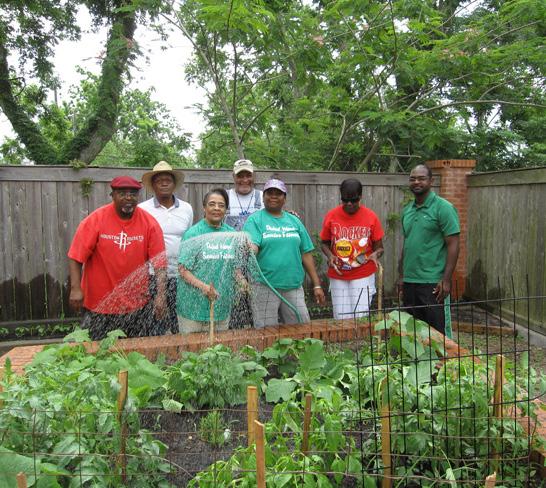
by building and strengthening the sense of place and community through cultural programming and preservation efforts that celebrate the Third Ward as a thriving center of African American culture — a destination where you can expect to find performances, landmarks, markets, and social events that celebrate the rich heritage and contributions of Black Houstonians.

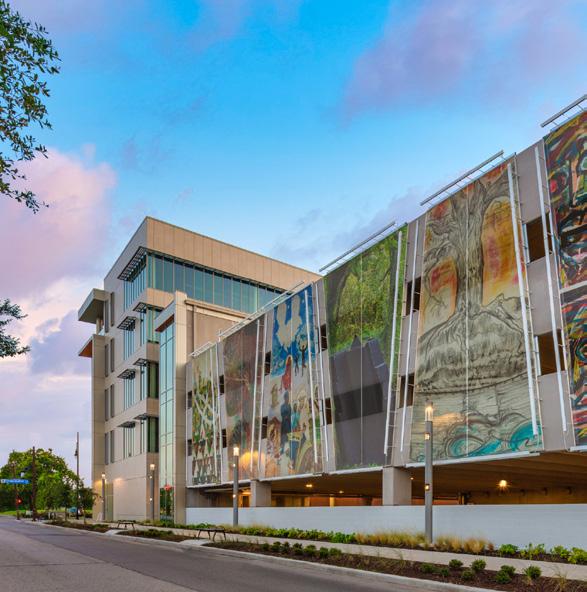
by increasing access to support services, quality healthcare, affordable fresh food, and safe outdoor recreation.

through an affordable, multi-modal transit network that provides convenient access to Cuney Homes, the neighborhood, and the city.

by addressing nuisances, creating pop-up shops, and building the capacity of local entrepreneurs to launch and grow businesses.
along key corridors and retain existing residents through tools that limit displacement and increase economic support to existing homeowners and renters.

by creating job opportunities and skills training for neighborhood residents in partnership with local anchor institutions.

through neighborhood planning, inclusion, and advocacy.
by honoring history and creating a positive identity through a coordinated art, branding, and placemaking strategy that in part, repurposes vacant lots.

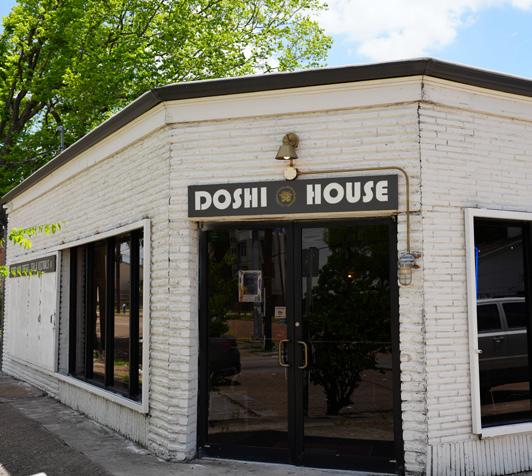

The Third Ward-Cuney Homes Choice Neighborhood Plan stitches the redeveloped Cuney Homes into a larger framework of mobility, opportunity, and history. Existing and planned transit corridors will be a focus for new investment, particularly for non-housing investments like commercial and social service spaces. These streetscape and transit connections will also better link the Third Ward to nearby neighborhoods and Downtown Houston, inviting Houstonians to support emerging small businesses and enjoy amenities like the Columbia Tap Trail. Around the newly redeveloped Cuney Homes, the surrounding street network will be reconnected to better integrate residents to the larger neighborhood, and existing gathering spaces like Emancipation Park will be complemented by newly established open spaces and parks at Cuney Homes, helping to create a sense of community. Special attention will be paid to multigenerational, family, youth, and senior spaces in the neighborhood in order to welcome a wide range of Third Ward residents in all stages of life. Third Ward and Cuney Homes’ history will be celebrated and marked throughout the neighborhood through a wide range of public art, murals, markers and gateways, and intergenerational storytelling, shining a bright spotlight on the rich culture of neighborhood stakeholders and encouraging residents of all ages to take pride in their collective heritage. Taken as a whole, the Neighborhood Plan brings Cuney Homes and Third Ward residents and stakeholders into a larger, tightly-knit fabric of connections and culture.
f Goal 1
Establish a sense of place through the recognition of community history.
f Goal 2
Provide inclusive community gathering and recreation spaces through accessible design for persons with disabilities, spaces to keep both seniors and youth active, and multi-generational spaces and educational spaces.
f Goal 3
Improve access to basic needs, services, and amenities within walking distance of Cuney Homes and in the Third Ward. Enable residents and Black businesses to fill current gaps.
f Goal 4
Establish Cuney and the Third Ward as a safe and resilient community with better relationships with law enforcement, community resources, and activated vacant lots and open space.
f Goal 5
Connect residents safely to a transit and Complete Streets. Provide more accommodating and safe transit stops and improved sidewalks and street crossings.
f Goal 6
Provide spaces and opportunities for civic engagement. Build political power through leadership capacity building and political engagement.
A resilient community through connections, accessibility, relationships, and a shared recognition of history:
Choice Neighborhood Housing Area Focus Area
Major Highway Neighborhood Corridor Trail
Planned Placemaking Node
Planned Neighborhood Investments
Park Waterbody Purple MetroRail Line
Complete Streets (Completed)
Complete Streets (Proposed)
Potential BRT Line
Resources & Supportive Services
Community Assets
Education & Child Services Place of Worship
Neighborhood framework
This map shows the ways in which the neighborhood framework will physically transform the Third Ward through safer and more convenient connections and revitalized streetscapes, while providing much needed connections between housing, services, and amenities.
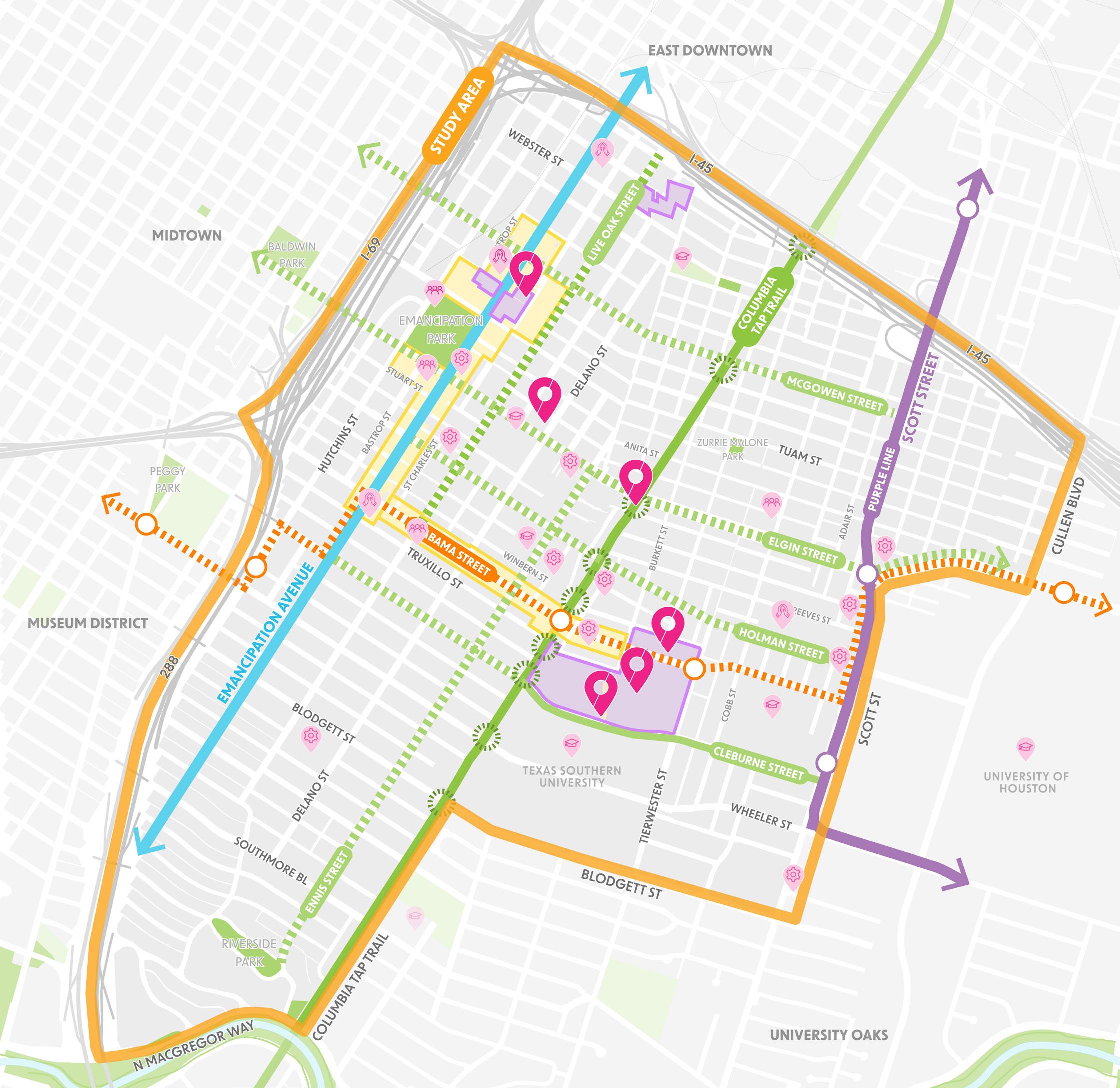
As part of the Neighborhood Plan, the Third WardCuney Homes Choice Neighborhood Plan identifies Critical Community Improvements (CCI). CCI projects are neighborhood placemaking, economic development, mobility, and wellness initiatives that advance the goals and visions of the Choice Neighborhoods Plan.
These CCI initiatives are designed with the voice of residents in mind and what we have heard throughout the process, to make the Third Ward a healthier, more connected community.
Construct a park within the new Cuney Homes redevelopment.
f Goal: increase the number of residents living within a 10-minute walk to a park.
f Potential partners: HHA and HPARD. Launch a business facade enhancement program.
f Aligned with the Third Ward Complete Communities Action Plan.
f Goal: increase the number and amount of small business loans to Third Ward small businesses.
f Potential partners: OBO, CDFIs, Third Ward Community Cloth, Houston Southeast Management District. Improve right of way and drainage.
f Potential partners: HPW, Civic Clubs, OST/Almeda TIRZ, Rebuild Houston, NTWNPP, HSE.
Commission and install art and artistic performances in public spaces.
f Aligned with the Third Ward Complete Communities Action Plan, Cultural Affairs Annual Report.
Amplify and expand the work of the Third Ward Cultural District.
f Aligned with the Third Ward Cultural Plan.
f Potential partners: MOCA, Third Ward Cultural District, Project Row Houses, SHAPE Community Center, Emancipation Park Conservancy.
Develop the historic Wesly Chapel on Emancipation Avenue into a cultural center.
f Aligned with the Third Ward Complete Communities Action Plan.
f Potential partners: HCDD.
Sustain and improve community gardens.
f Aligned with Third Ward Complete Communities Action Plan.
f Goal: increase the number of residents without a vehicle that have access to healthy food defined by no more than 1/2 mile from a grocery store.
f Potential partners: HHD, HCDD, Plant It Forward, Harris County Master Gardeners, Houston Food Policy Work Group, Ecotone, EEDC, GRO1000, Classes, TSU, Urban Harvest, Blodgett Community Garden, Alabama Gardens, Harris County Master Gardeners.
Expand DAWN Center at the Third Ward MultiService Center.
f Aligned with Third Ward Complete Communities Action Plan.
f Potential partners: HHD, Harris Health, American Diabetes Association.
Establishment of a TechLink library at Smith Neighborhood Library
f Aligned with Third Ward Complete Communities Action Plan, Capital Improvement Plan.
f Potential partners: HPL, Philanthropic partners. Seed new community-owned or worker-owned cooperatives and businesses.
f Aligned with Third Ward Complete Communities Action Plan, Emancipation Avenue Main Street Strategic Plan.
f Goal: increase the number of new, locally-owned businesses.
f Potential partners: OBO, NTWPP, EEDC, National Cooperative Bank, Universities, SN Council, NST, HSE, Community, Collectives United, Third Ward Cooperative Community Builders, UH Bauer College of Business, Kinder Institute for Urban Research, TSU School of Business, HSE Micro-lending.
Expand Texas Southern University's Center for Transformative Health and Earl Carl Institute for Social Justice.
Establishment of a Bezos Academy in Third Ward.
f Aligned with Third Ward Complete Communities Action Plan.
f Goal: higher number of children enrolled in highquality nursery schools.
f Potential partners: Bezos Academy, MOE, HHD, HISD.
Expand access within the neighborhood to the Workforce Solutions services.
f Aligned with Third Ward Complete Communities Action Plan.
f Goal: increase the number of residents with employment.
f Potential partners: H-GAC, Texas Workforce Commission, Greater Houston Partnership.
Expand cradle-to-college support services for Third Ward youth.
f Aligned with Third Ward Complete Communities Action Plan.
f Goal: increase in educational attainment in the neighborhood.
f Potential partners: HESS Corp., MOCC, HISD, University of Houston, Texas Southern University, Houston Community College.
Expand career-technical education course offerings for the Third Ward youth.
f Aligned with Third Ward Complete Communities Action Plan.
f Goal: increase in workforce-ready high school graduates.
f Potential partners: H-GAC, Texas Workforce Commission, Greater Houston Partnership, Houston Community College.
Increase broadband connectivity to single- and multi-family residencies.
f Goal: increase the number of households with stable broadband connectivity.
f Potential partners: HITS, Verizon, T-Mobile, AT&T, Cricket.
Improve Wi-Fi connectivity within the Third Ward.
f Potential partners: HITS, Verizon, T-Mobile, AT&T, Cricket.
Improve access to Columbia Tap Trail
f Aligned with Resilient Houston Strategy, Walkable Places Plan.
f Potential partners: HHA. HPW, HPARD. Continue and expand ride share program to expand access to HEB supermarket in adjacent super neighborhood.
f Goal: build equity in food access.
f Potential partners: Link Houston, Evolve Houston, METRO, Bike Houston. Improve area sidewalks.
f Aligned with Capital Improvement Plans, Third Ward Complete Communities Action Plan.
f Potential partners: HPW, Southeast Houston Management District. Improve area streets.
f Aligned with Capital Improvement Plans, Third Ward Complete Communities Action Plan.
f Potential partners: HPW, Harris County, TxDOT, USDOT.
f Goal 1
Strategy A.
Work with local artist groups to collectively create more murals, public art, and wayfinding that connects with community culture and heritage.
The Third Ward’s collective history and heritage can be celebrated through a variety of artist collaborations to transform the neighborhood at key sites. Artists can integrate Third Ward history and culture into the neighborhood’s public spaces by creating community art installations, whether permanent or temporary. Additionally, a comprehensive wayfinding program to design and install consistently-branded signs identifying street names and key cultural points in the Third Ward can help orient residents and visitors while also expressing the robust local culture.
All of these projects can be sponsored through key partnerships and created in collaboration with stakeholders throughout the process of design and installation, ensuring that the community has input into selected art projects. Specific partnerships include the Houston Arts Alliance, MOCA, and the Houston Public Library, who can assist with creating four new Mini Murals, a Civic Art project, the Visit My Neighborhood grants, a Resident Artist Program (R.A.P.), creative writing workshops, and a Neighborhood Poetry Project by the Houston Poet Laureate, Deborah “DEEP” Mouton.
New Cuney Homes basketball court mural. The design was produced through a youth focus group where children brainstormed what they would like to see in this new piece of treasured community art.
Source: IMPAcT13

“[My vision for the Third Ward] is for it to continue at a strong cultural base where people know they can come just like they go to other cities.”
Raymond Thompson
Third Ward resident
COMPLETE COMMUNITIES ALIGNED
Promote Third Ward events and resources by connecting with community partners to maintain communication and provide support.
The Third Ward is an active neighborhood with robust community engagement and resources, but too often these resources are underused by local residents. The feedback collected from the Cuney Homes Resident Survey revealed that although there are important community services in the Third Ward community such as childcare, food pantries, and educational programs for both youths and adults, the residents were often unaware of these offered services.
Barriers to access and awareness include adult illiteracy, lack of access to the internet/social media, and lack of transportation. Project Row Houses, S.H.A.P.E. Center, Change Happens, Emancipation Economic Development Council (EEDC), Greater Third Ward Super Neighborhood Council, and Houston Complete Communities are key partners that regularly distribute information on community resources. The planning team will work with these community partners to ensure Cuney Homes and Third Ward residents are more aware of resources, activities and events through a consolidated communication strategy that employs several additional methods to engage the community, such as informative yard signs and building marquees, erecting more community bulletin boards or billboards on highly trafficked streets and/ or buildings in the Third Ward, robocalls and emails.
Art is alive in the Third Ward. Murals, art pieces, and artists at Project Row Houses light up the Third Ward culture and history through art.

Source: WrT
“How would you like the history of your neighborhood be celebrated and told?”
local artists
 Residents participating at Third Ward On Tap at the Columbia Tap Trail on March 2023.
Residents participating at Third Ward On Tap at the Columbia Tap Trail on March 2023.
Encourage neighborhood youth to become storytellers by interviewing older residents, capturing Third Ward history, and instilling pride in the next generation.

Storytelling is a powerful way to build empathy and make personal connections across generations. The S.H.A.P.E. Center, with existing “Elders Institute of Wisdom” and after-school youth programming, and Generation One, an early education provider and research group, are natural Third Ward partners to help such a storytelling program bridge the generational gap between neighborhood youth and older residents. By bringing Generation One and the S.H.A.P.E. Center’s youth into dialogue with participants in the Elders Institute and other neighborhood seniors, this oral history project will help pass the Third Ward’s history down to neighborhood youth, giving the Third Ward’s next generation a meaningful sense of place and civic pride. Generation One’s new location in the heart of the Cuney Homes site will make this program convenient and even more deeply rooted in the community.
Participate in neighborhood festivals and cultural activations and organize a variety of activities that highlight the Third Ward's unique cultural heritage, encourage social cohesion, create political and economic effectiveness, and honor social diversity.
In addition to Emancipation Park, an important community gathering place for events like Juneteenth, the redeveloped Cuney Homes site will also provide the Third Ward a range of open spaces that can accommodate cultural and social activities throughout the year, ranging in size from neighborhood-wide festivals to smaller resident-focused events. These community gathering places are already being activated through Early Action Activities, which are helping to create social cohesion and momentum around neighborhood-wide community building. As the Cuney Homes site is redeveloped, these established festivals and events can be brought onsite to physically and programmatically bring Cuney Homes into the larger Third Ward neighborhood.
Recruit youth volunteers to engage with older residents by adopting a grandparent, making monthly telephone calls to a senior, and engaging older residents during the holiday season.
As part of the Choice Neighborhood Plan, the team conducted a storytelling event with Cuney Homes and Third Ward residents at the S.H.A.P.E Center.
Source: WrT
Senior Housing & Programmingf Goal 2
Revitalize the “trailheads” where Cuney Homes meets the Columbia Tap Trail.
The Columbia Tap Trail, a four-mile hike and bike trail that borders Cuney Homes, is of significant importance to the Third Ward, although there are no historic markers that currently exist to tell its story. Federal and local funding converted this former railway into a trail used by pedestrians and cyclists in 2009, but the section of the trail between Cleburne St and Truxillo St is known as the “gun range” due to the random shootings, drug use and sales, prostitution activity, and illegal dumping. Keeping the focus on neighborhood history and transportation, we want to restore this part of the trail to a yet unforeseen glory.
The intersections where Cuney Homes meets the Columbia Tap Trail – at Truxillo/Briley, and along the new Complete Street on Cleburne St - could become much more inviting “Trailhead” entrances that welcome the broader Houston public into the newly redesigned Cuney Homes site and connect Cuney Homes residents to the rest of the city. Community engagement activities, such as Task Force meetings, community meetings and design charrettes, indicate that residents desire to hold this space for recreational activities for people of all ages and abilities.
The Brave Architecture and Asakura Robinson firms are currently working to redesign the area as an official gateway that welcomes residents to the Columbia Tap Trail and Cuney Homes.
These gateways can be reimagined as pocket parks, complete with benches, lighting, wayfinding signage, pollinator and rain gardens, landscaping, information boards, and a mural that celebrates the history and the future of the Columbia Tap Trail. Gateway elements and signage will welcome intergenerational pedestrians and cyclists by integrating local history and culture. Visitors connecting to or from the Trail will be able to learn about Norris Wright Cuney and Cuney Homes, with the site’s history and coming events advertised to the broader public. Cameras and additional lighting can help with security and make residents and visitors feel comfortable. Landscaping that mediates the trail and the Cuney Homes site can nod to the care and pride of residents in their natural habitat. While similar elements could be installed at both, the Cleburne St trailhead can become a much more public entry into Cuney Homes, while the Truxillo/Briley entrance can be designed as a more Cuney Homes resident-facing gateway.
Provide inclusive community gathering and recreation spaces through accessible design for persons with disabilities, spaces to keep both seniors and youth active, and multigenerational and educational spaces.
Create activities and festivals at Cuney Homes and along the Columbia Tap Trail to establish the site as a community anchor in the Third Ward neighborhood.
Cuney Homes is a place of cultural significance and is a major contribution to the Third Ward neighborhood. There are many misconceptions about public housing, both earned and unearned. Cuney Homes can be perceived by the public as a place to avoid, leaving residents to feel isolated, ignored, and overlooked. This site should be a place known for its resilience, as a place of refuge and stability, one that welcomes the neighborhood in, not keeping neighbors out. To build neighborhood camaraderie, Cuney Homes hosted two annual events for the first-time ever in the history of the Houston Housing Authority: National Night Out and Third Ward on Tap.
In October 2023, the Houston Housing Authority partnered with Houston City Council District D to host National Night Out. National Night Out is an annual community-building campaign that promotes police-community partnership and a true sense of community. The event was filled with a massive presence from Houston Police Department, Texas Southern University Campus Police, Harris County Sheriff’s Office Precinct 6 & 7, Congresswoman Sheila Jackson Lee and Mayor Sylvester Turner, hundreds of residents from both Cuney Homes and the Third Ward, and many community partners.
To highlight the connection between Cuney Homes and the Columbia Tap Trail, the planning team joined the Friends of Columbia Tap Trail and Houston City Council District D to co-host the second annual Third Ward on Tap: Trill Edition festival in March 2023 at Cuney Homes. During this event, the cycling community was invited to join Cuney Homes residents for scheduled bike rides along the Columbia Tap Trail. The planning team introduced the Columbia Tap Trail Early Action Activity and gathered feedback about the project design. The festival also included a kid’s zone for children’s activities, basketball games, a food distribution, and a community resource fair. The planning team will continue to use these annual opportunities while creating new ways to hold a firm and visual presence in the Third Ward community.
“As people move into the area, of course, they are bringing their experiences, their knowledge, where they’ve lived. (…) We want them to understand that they are moving into an area where they’re going to have the responsibility of helping to maintain the area and make it better. You’ve got to make a difference.”
Clarice FreemanThird Ward resident
On April 26, 2023, an impactful field trip was organized by the Houston Housing Authority and Third Ward Cuney Homes Choice Neighborhood Initiative in collaboration with Friends of Columbia Tap, a trails and greenspace community advocacy group. The event aimed to provide residents of Cuney Homes and members of the Third Ward community with an enriching experience that combined history, nature, and community engagement.
The field trip provided participants with a unique opportunity to connect with nature, history, and each other. As attendees explored Nash Prairie, Varner Hogg Plantation, and other historical sites, they gained valuable insights into the region's history, from early settlement to the legacy of enslaved labor on plantations.

The excursion allowed participants to witness the tangible importance of preserving green spaces and natural landscapes. The visit to Nash Prairie showcased the value of wild spaces, fresh air, and the sensory experience of blooming flowers. A heartwarming moment occurred when a participant shared memories of childhood spent in similar fields, highlighting the deep emotional connection that such landscapes evoke.
The tour of Varner Hogg Plantation offered an immersive historical experience, providing a window into the lives of those who lived and worked on the

plantation. The plantation's complex history, including its role in the sugar and cotton industries, offered attendees a deeper understanding of the region's past. The trip also included visits to the Columbia Historical Museum and Columbia Rosenwald School, which provided insights into the educational and cultural history of the area.
The field trip underscored the importance of community engagement, historical preservation, and the revitalization of green spaces. As Cuney Homes and the adjacent Columbia Tap Trail undergo renovation, the journey highlighted the potential to incorporate historical interpretation and native plantings, reflecting the region's history and offering a space for reflection and rejuvenation.
The support and partnership of organizations like the Friends of Columbia Tap, the Houston Housing Authority, and the Third Ward Cuney Homes Choice Neighborhood Initiative were vital in orchestrating this successful event. By working together, these groups were able to provide residents and community members with a transformative experience that will contribute to the ongoing efforts to enhance the quality of life in the Third Ward. The field trip left participants with a sense of inspiration, a deeper connection to their surroundings, and a shared commitment to preserving history, fostering community, and creating vibrant green spaces for future generations.

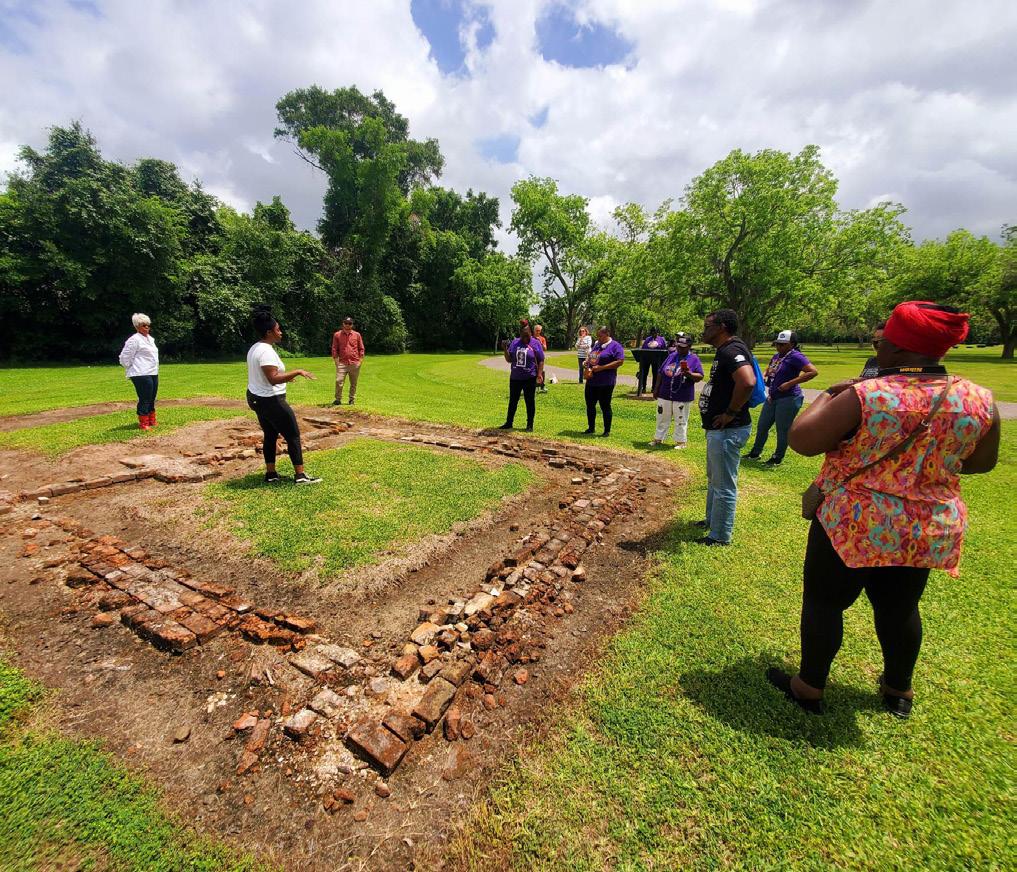

Third Ward On Tap on March 2023 brought together the community a second year to celebrate culture and assets in the Third Ward.
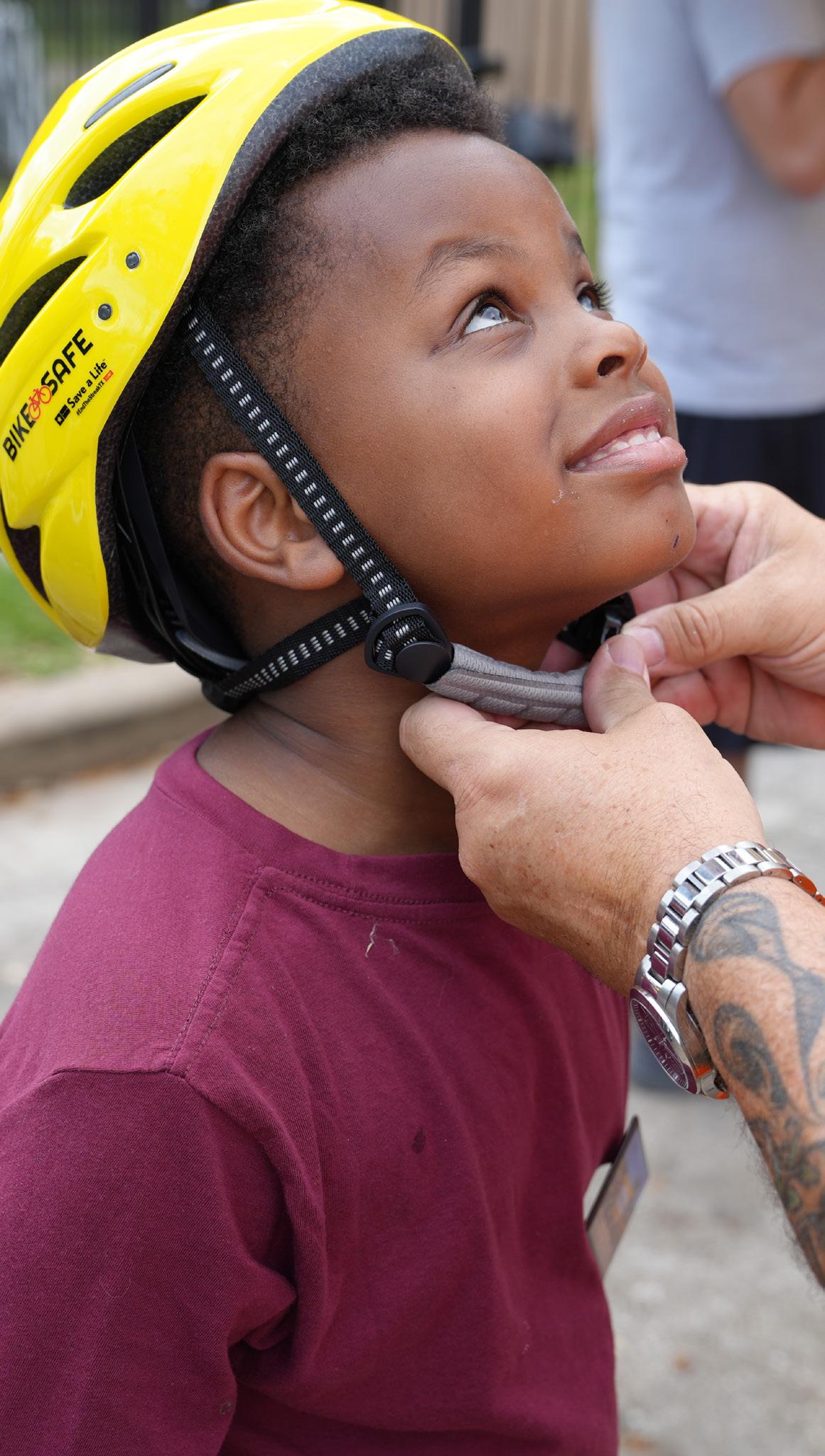
Source: HHA
As part of the redevelopment of the Cuney Homes site, create a network of active recreation amenities for residents of all ages and abilities.
The Columbia Tap Trail will connect into the redeveloped Cuney Homes site through the Truxillo/ Briley Trailhead, connecting to an internal walking loop linking to the main Cuney Park space along Nettleton. Cuney Park will feature a playground, adaptive outdoor exercise equipment, a multipurpose sports field, and a B-Cycle Station, along with public art and landscaping to encourage gathering. The main Cuney Community Center will also be located along this internal loop, as well as emergency call boxes, accessible restrooms, activity tables, and bright lighting, creating a variety of safe and inviting gathering and recreational spaces dotted throughout the new Cuney Homes site. All amenities will incorporate universal design principles and encourage intergenerational interaction.
Seek sponsors for stipends to make it easier for residents to participate in civic and engagement opportunities.
The Third Ward–Cuney Homes Choice Neighborhood Initiative does not treat resident participation as a mere requirement, but a welcome opportunity to engage with Cuney Homes residents to gain feedback to inform the Choice Neighborhoods Plan. The planning team enlisted the help of the Community Ambassadors to promote Choice Neigborhood community meetings and experimented with incentives to attract participants.
During this process, the planning team learned that residents had difficulty attending meetings due to their unmet needs. The Ambassadors reported input from their neighbors and also experienced themselves the hardships of attending evening meetings and sharing their valuable experiences while they did not know where their next meal will come from. Many businesses offer compensation to gain feedback from the public in focus groups, but too often residents are expected to be vulnerable and transparent while serving as subject matter experts for free. It was no surprise that the meetings with larger audiences offered meals and giveaways as incentives to encourage attendance. We will collaborate with community partners, nonprofit organizations, elected officials, businesses, etc. to financially sponsor meetings or participants to ease the barriers of meeting participation.
Create opportunities for youth to showcase their talent with local musicians in a street festival type environment. Invite a variety of programs at this event that outreach to parents and teens and try to meet their needs through activities with their kids.
Community meetings and events can bring the community together while being an opportunity for advocating for needs.
Source: HHA

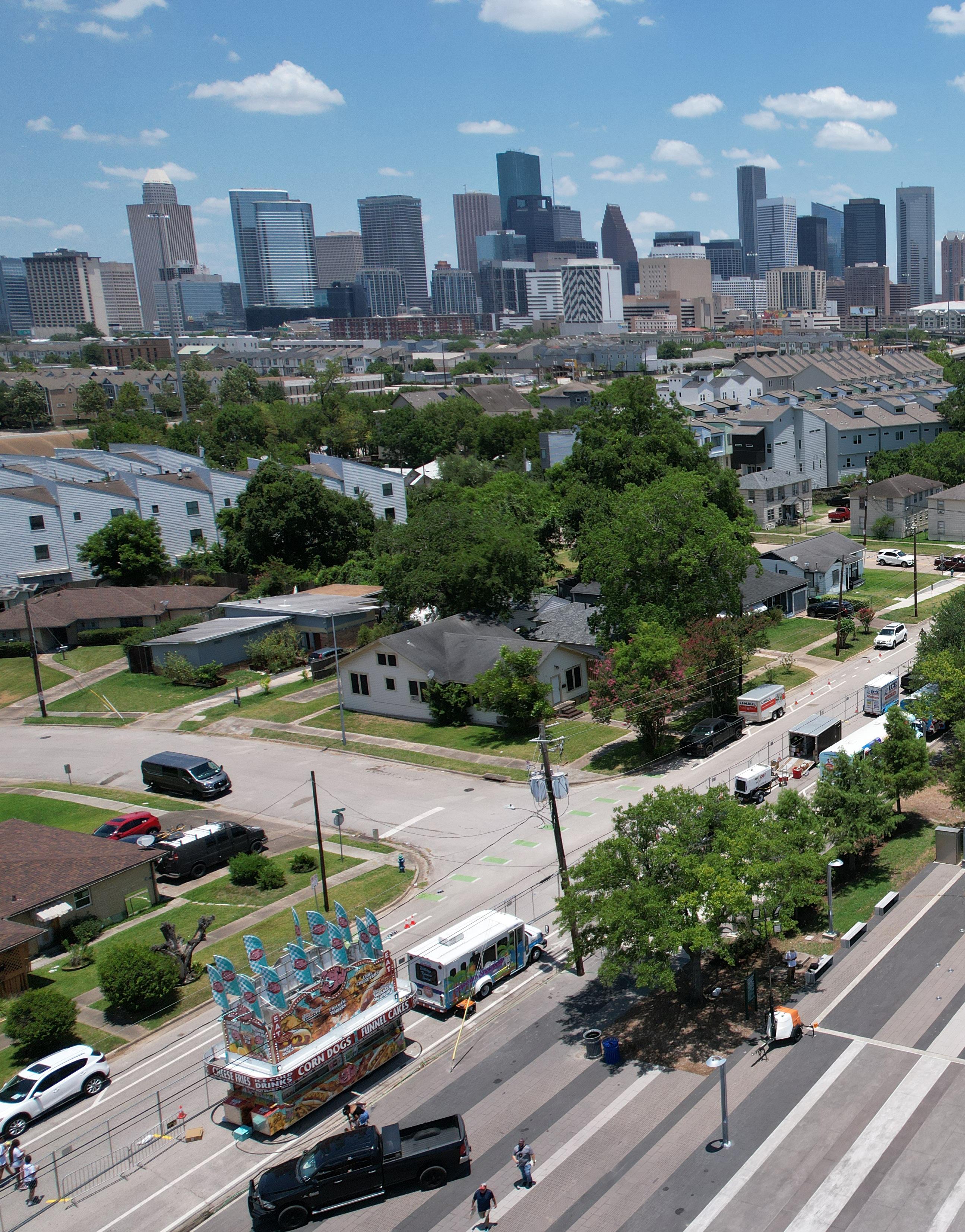
 Emancipation Park preparing for Juneteenth festivities.
Source: KAMILLe DeVILLe
Emancipation Park preparing for Juneteenth festivities.
Source: KAMILLe DeVILLe
f Goal 3
Improve access to basic needs, services, and amenities within walking distance of Cuney Homes and in the Third Ward. Enable residents and Black businesses to fill current gaps.
Strategy A.
Create opportunities and provide access to free spaces for pop-up markets to create more exposure for Black, Indigenous, People of Color, and Third Ward owned micro-enterprises.

With the support of the Third Ward-based Emancipation Economic Development Council (EEDC), emerging small businesses can develop a pop-up presence at several key sites in the neighborhood in order to advertise and test out their products or services without the full commitment of a permanent lease. Currently, EEDC semi-regularly hosts markets with several dozen vendors as part of the Emancipation Avenue Main Street program.
Complementing EEDC’s work along Emancipation Ave, the redeveloped Cuney Homes site can also encourage entrepreneurship: live-work units along the Columbia Tap Trail north of Cleburne Street are ideal for at-home businesses, which can then harness the flexible spaces in the main Cuney Park for pop-up festivals and market events. Alabama Street ground-floor spaces can also help test short-term businesses indoors in a more formal setting, before making a commitment to a fulltime permanent leasable space. Local BIPOC-owned local businesses can also tap into EEDC’s Resilient Entrepreneurship Program in order to refine their business plans and gain access to start-up capital.
“Historically, (…) Black people have been able to come to the Third Ward to work and live. We have continued to keep that legacy as the next generation.”
RUEROB Jackson Third Ward resident
Partner with existing Third Ward businesses to lease additional space.
In addition to providing space for new and pop-up entrepreneurs, Cuney Homes and the Third Ward can help existing small businesses identify larger, more central spaces for expansion or relocation. At-home businesses may be searching for more public spaces to operate, and informal pop-up businesses may wish to be open on a more frequent and permanent basis. In addition to emerging commercial spaces along Emancipation Avenue, some of the ground-level mixed use spaces at the redeveloped Cuney Homes site along Alabama Street are great opportunities for small businesses to expand and formalize.
Partner with affordable food suppliers to create a food pantry at Cuney Homes.
The Cuney Homes Resident Survey revealed that food insecurity is a major issue for Cuney Homes and Third Ward residents. This community is a food desert with no grocery store, general store, or pharmacy within a 5-10 minute walking distance from Cuney Homes. 36% of residents go hungry 1-2 nights each week. The most immediate access to food is obtained from the corner stores, which sell overpriced off-brand food items while supporting gang activity, drug use and sales.
While we work towards the ultimate goal of establishing a Food Co-op for Cuney Homes and Third Ward residents, we are determined to partner with affordable food suppliers to create a food pantry inside the Cuney Homes Community Center that offers healthy food options to residents. With the help of The Common Market, a mission driven distributor of sustainable, local farm foods, we will open the Feeding Our Future Food Pantry twice a week to feed 400 Cuney Homes families per month. We will continue to identify other food partners to offer dry food goods through regular distributions and raised food items through community food drives.
Organizations like EEDC and Project Row Houses organize craft sale events and Free Markets for local artists.
Source: eeDc
Community Ambassador receiving donations for the newly opened Cuney Homes Feeding Our Future Pantry.
Source: HHA

As part of future mixed-use development along key nodes, incorporate small subsidized commercial spaces on the ground floor.
To complement the commerce that EEDC is already prioritizing along Emancipation Ave, any new Third Ward development along the priority commercial corridors of Emancipation Ave and Alabama Street should be incentived to incorporate small commercial spaces on the ground floor. These spaces should be reserved for local Black- and brown-owned businesses and should be subsidized in order to hold space for the culturally-appropriate services and products that the community would prefer to support.
One Emancipation Center, across from Emancipation Park, hosts organizations that support the production of affordable housing and serve low-to-moderate income residents.
Source: ArcH coN WeBPAGe
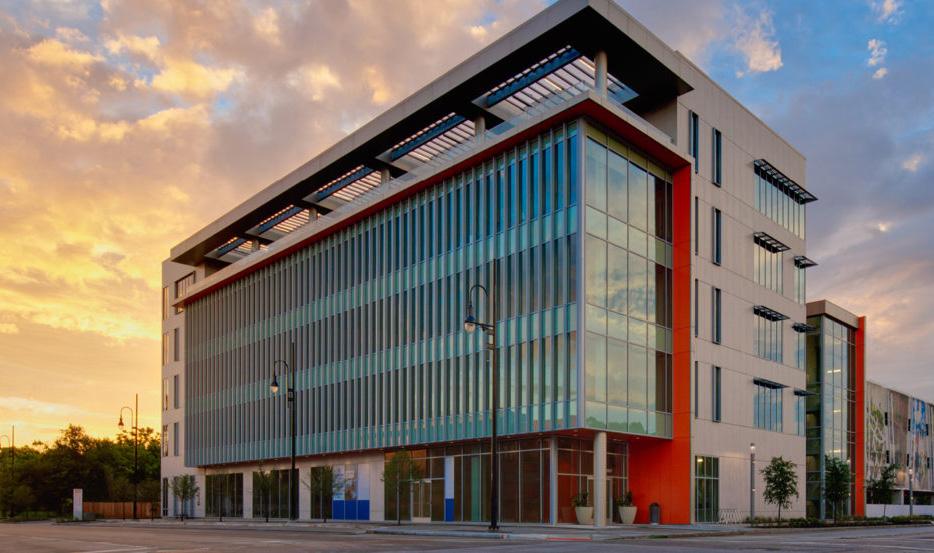
“[In the future]
I see businesses coming back in (…) African American entrepreneurs being able to apply their craft into the area.”
Chris Tucker Third Ward resident
Choice Neighborhood
Neighborhood Corridor
Major Highway
Trail
Park
Waterbody
Housing Area
Planned Placemaking Node
Planned Neighborhood Investments
Potential BRT Line
Non-housing investments in the Choice Neighborhood This map shows the non-housing investments in the Third Ward. They range from affordable business spaces for Third Ward enterpreneurs, to new parks and nature areas with trails to improve physical and mental health, and placemaking nodes that will incorporate history and culture areas throughout the neighborhood.

Riverside General Hospital was critical healthcare institution located within the Third Ward. Opened in 1927 and originally named the Houston Negro Hospital, this facility became the first nonprofit hospital for Black patients within the City of Houston, where it not only served the immediate community but also became a place of work for Black physicians and medical practitioners. Throughout the duration of its operation, The Houston Negro Hospital treated countless patients and trained a generation of professionals through its educational programs such as The Houston Negro Hospital Nursing School.
Following an additional facility expansion in 1961, the building was renamed the Riverside General Hospital, but its role as a critical community healthcare provider in the Third Ward did not change. Despite changes to the greater healthcare system within the nation which placed strain on the small community hospital, the facility continued to operate until 2015 when financial hardship and legal difficulties forced the hospital to closure. The dissapearance of this Third Ward asset created a major void for accessible healthcare services within the neighborhood.
Riverside General Hospital in 2023.
Source: HouSToN cHroNIcLe (top to bottom)
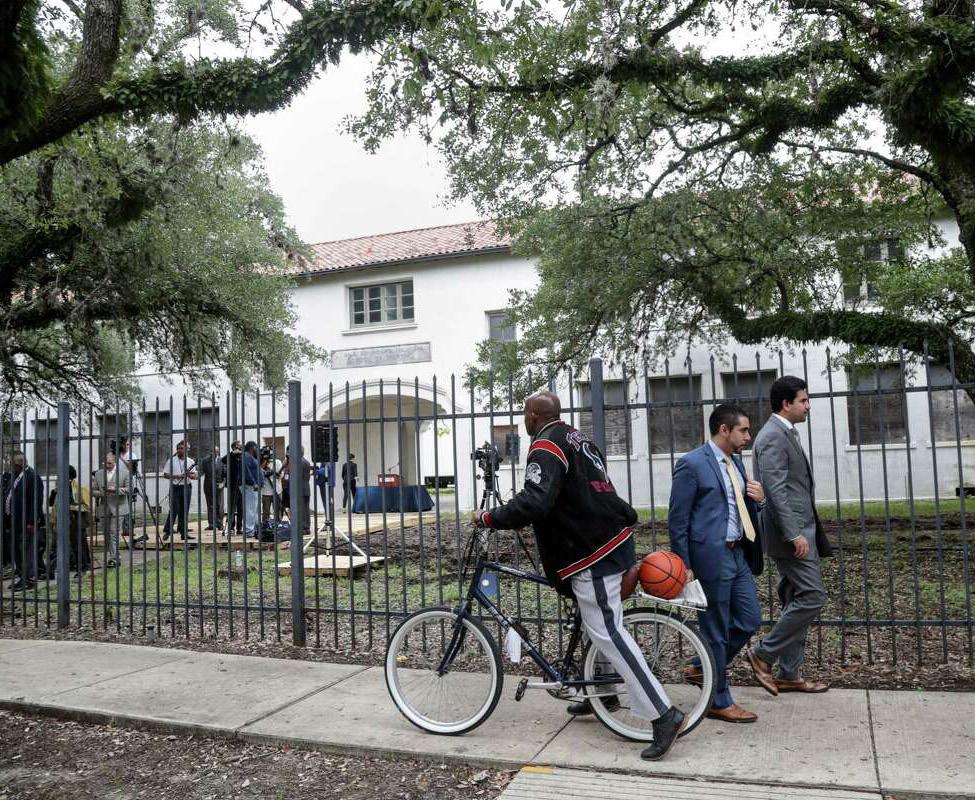
Riverside General Hospital School of Nursing.
Source: TeXAS STATe HISTorIcAL ASSocIATIoN.
Patient, doctor, and nurse in the Hospital's lawn.
Source: TeXAS STATe HISTorIcAL ASSocIATIoN.
Riverside General Hospital: a historic place for healthcare, wellbeing, and employment and educational opportunities in the Third Ward.
Fortunately, plans to renovate the building and restore its function within the community are already underway. In 2018, Riverside General Hospital was purchased by Harris County and progress has already been made towards the building’s redevelopment. Currently, the plans call for the renovation and reopening of the hospital facilities, but will also include expanded program and new facilities in order to accommodate the new headquarters of Harris County Public Health’s ACCESS (Accessing Coordinated Care and Empowering SelfSufficiency) division.
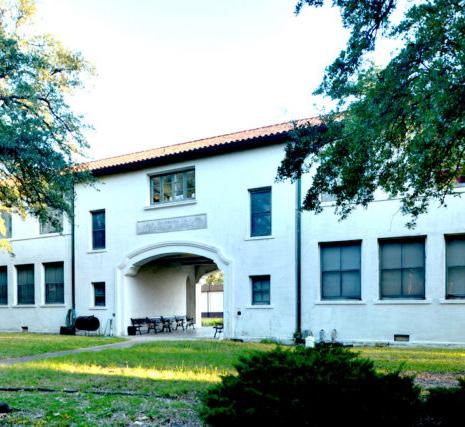
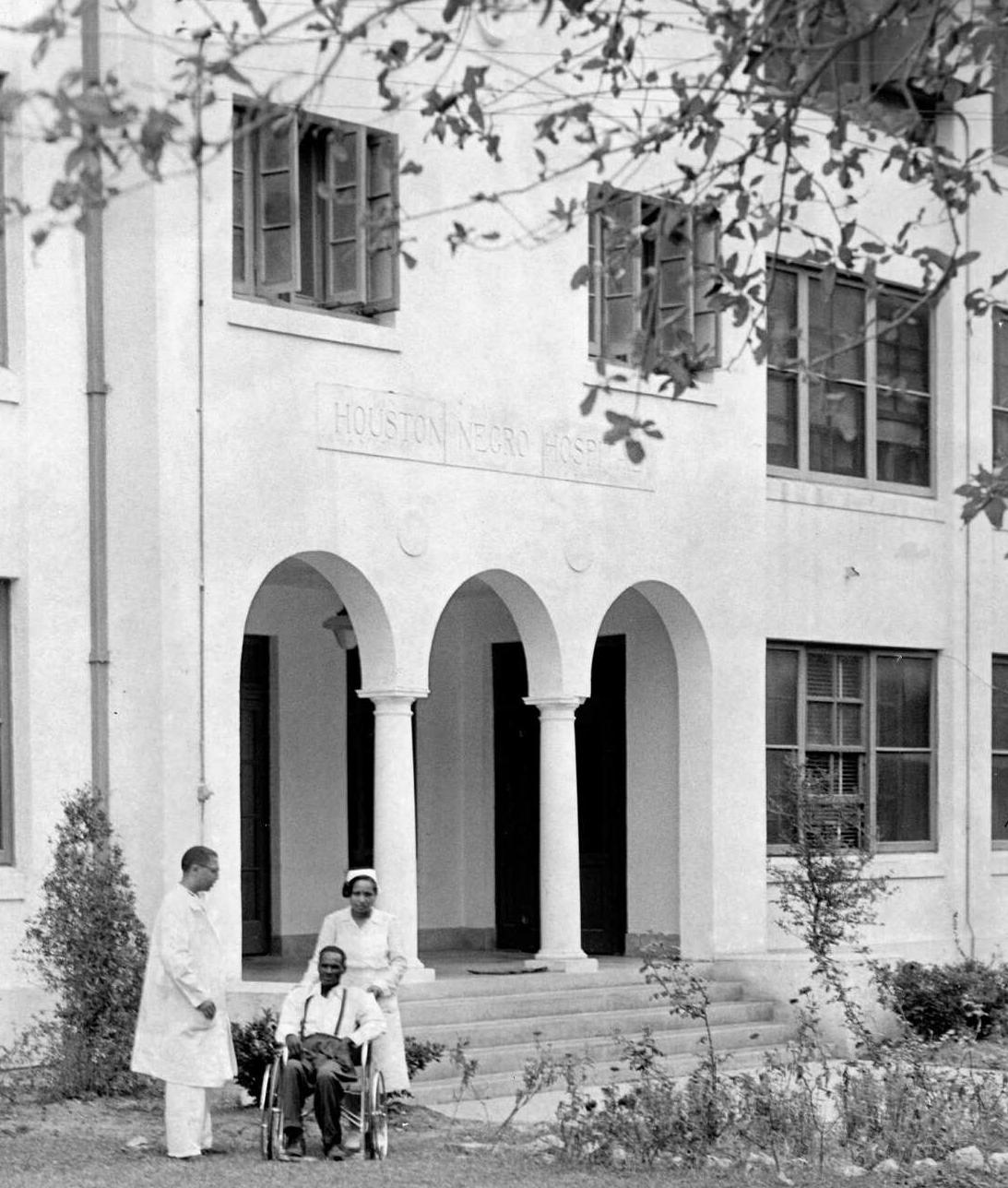
ACCESS intends to serve the local community by coordinating care for vulnerable individuals across multiple domains. Early programs are intended to address homelessness, behavioral health conditions, Black maternal health, and violence prevention but eventually will expand to include vaccinations and flu shots, obesity reduction, asthma care, diabetes prevention, dental care, and more. While specific project details are still under review, much of the facility is expected to be open by 2025 where it can once again serve residents of the Third Ward.
But this redevelopment offers more possibilities than just affordable, accessible healthcare to Third Ward residents. The investment that Harris County is doing in the Third Ward, will also allow for creation of jobs, educational opportunities, and training programs for residents, uplifting them and helping them advance their careers.
Utilize a Commercial Community Land Trust model to protect affordability, support entrepreneurs of color, and limit displacement.

Community Land Trusts are an emerging ownership tool for keeping property locally owned and cost controlled, but CLTs like the existing Houston Community Land Trust often focus on residential properties and not commercial spaces, providing challenges for prospective entrepreneurs. However, some models are expanding to purchase and hold commercial spaces in order to provide “bricks and mortar” spaces for local residents to launch their small businesses, serving as both community-held property owners and also incubators of business tenants.
A commercially-oriented Community Land Trust model in the Third Ward – whether an expansion of the HCLT or a new entity – could selectively acquire existing property and buildings along the neighborhood’s primary commercial corridors, holding them for entrepreneurs of color to help provide affordable business space and increase the probability of long-term success and growth. Administration and structure of the Community Land Trust will require careful planning and oversight, but should be explored as a strong option for community ownership and power in the Third Ward.
EEDC's Emancipation Main Street market is a culture-based market that supports entrepreneurs.
Source: eeDc
As an important piece of history and infrastructure that runs through the whole Third Ward, the Columbia Tap Trail provides space for active recreation and events.
Source: WrT

Emancipation Park is a hub for all types of recreation and events about history and culture are organized on a regular basis.

Source: WrT
Establish a quarterly neighborhood market.
The Emancipation Economic Development Council (EEDC) has piloted a semi-regular street market for the past several years as part of the Emancipation Avenue Main Street program, with several dozen vendors and hundreds of attendees. In addition to supporting and strengthening this market, Cuney Park at the heart of the redeveloped Cuney Homes is an excellent site for a smaller Cuney Homes-specific market providing access to fresh produce, food products, and local arts and crafts. The S.H.A.P.E. Center could be a strong partner for recruiting the food-based market vendors, and local businesses and artisans elsewhere in the neighborhood could use this as an opportunity to bring their goods directly to Cuney Homes residents to introduce them to available products and services. Adhering to a regular calendar rhythm for this market will help to quickly establish it in the seasons of Cuney Homes residents and create a festive experience for Houstonians of all ages and backgrounds to gather and enjoy the redeveloped Cuney Homes open spaces.
“During a regular week, are there times that you find there is not enough food to eat in your household?”
64% 31%
Never Yes, once or twice a week
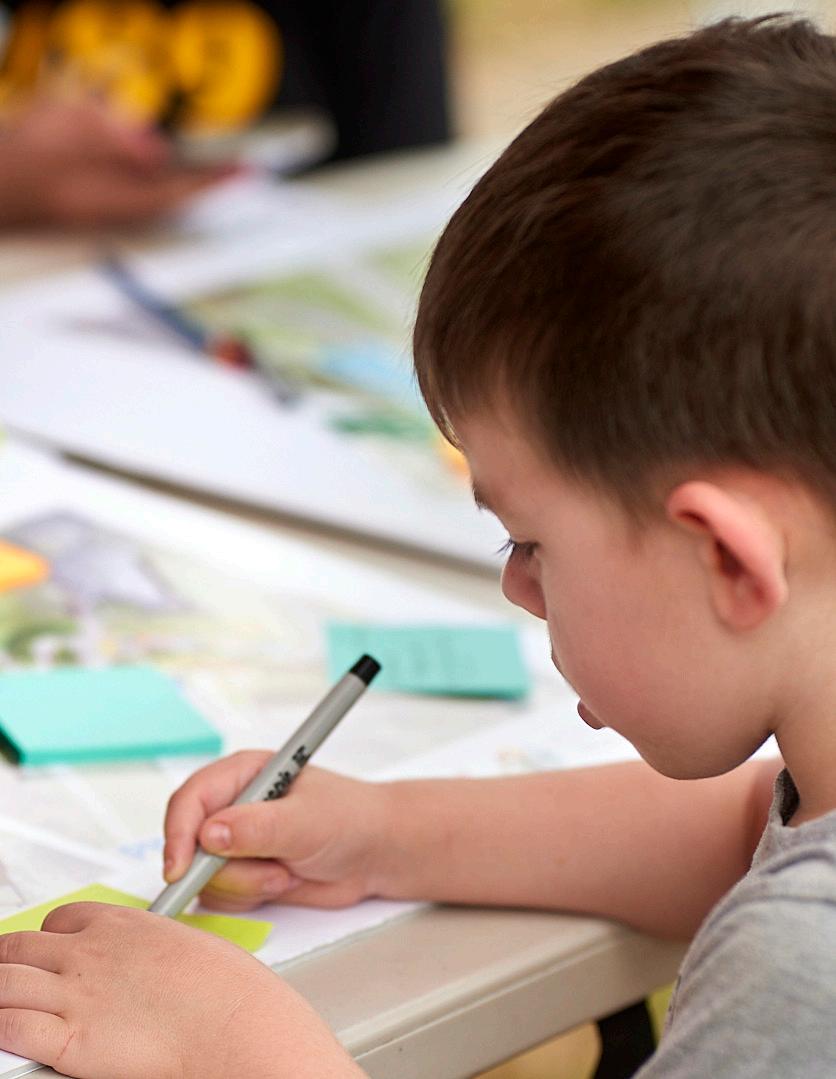
Create a sport teams at Cuney Homes to participate in competitions with other HHA properties teams.
Provide gathering spaces for seniors where weekly activities can be conducted.
Link seniors, youth, and families to events through multiple platforms and communication methods that are accessible for all ranges of abilities, including those with disabilities.
The new Cuney Homes site will include a full suite of accessible spaces and programs rich in intergenerational interaction. Fully accessible trails, plazas, seating areas, and recreation spaces will allow residents of all ages and abilities to meet each other and enjoy both passive and active recreational opportunities . Neighborhood youth, families, and seniors will each have specialized activities and events hosted in distinct spaces throughout the site, with special emphasis on intergenerational programming to help build all-ages relationships.
In addition to physical accessibility, programming and services should be communicated on a variety of platforms as well. In addition to social media and web-based messaging, more analog techniques like fliers and centrally-located bulletin boards will help get the word out and bridge the digital divide.
Third Ward On Tap event on March 2023. Source: HHA“I would like to see more togetherness within the community. People smiling and laughing. We have a beautiful culture here, and it is deeply rooted.”
Efuru Korii
Third Ward resident
National Night Out event on October 2022, where community gathered to have fun and celebrate together.
Source: HHA
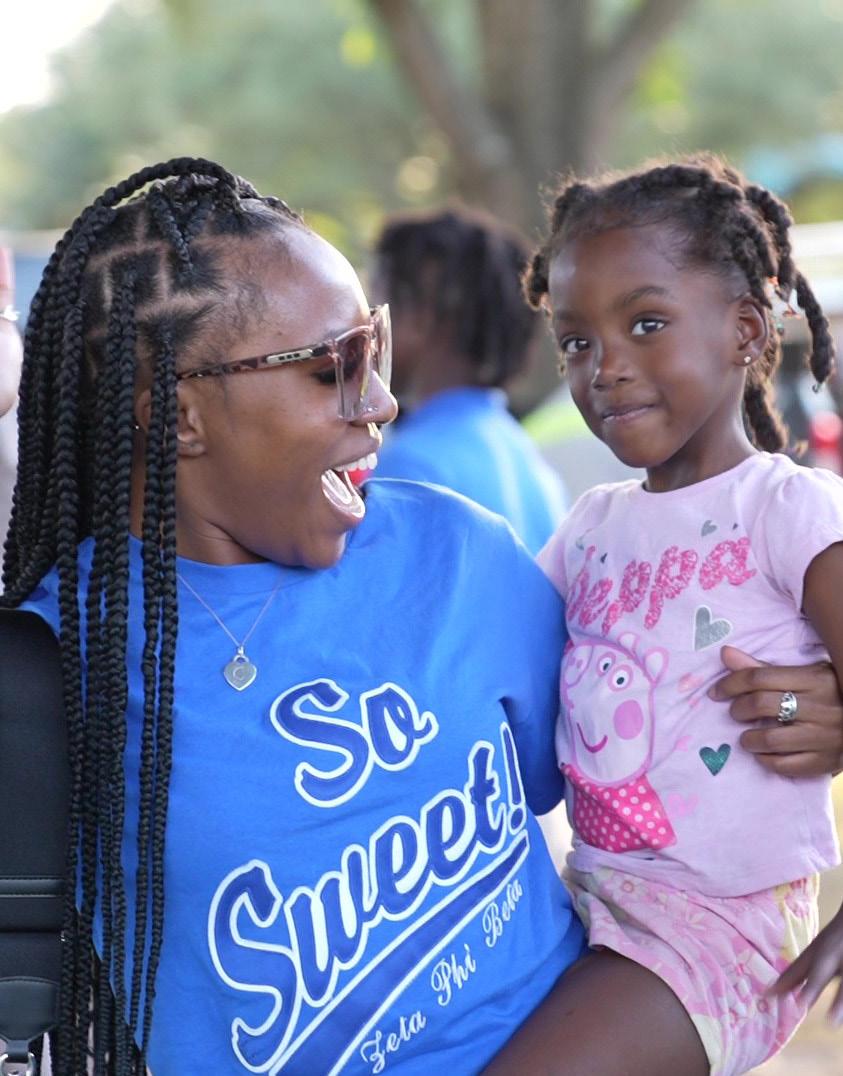
f Goal 4
Establish youth-oriented programs to gain trust with participants and their parents.
Community engagement with local law enforcement agencies has been a struggle at Cuney Homes. The Cuney Homes Resident Survey indicated that 92% of residents want better communication with Houston Police Department and 67% of residents believe ongoing conversation with the police can be improved by holding monthly meetings at or near Cuney Homes. While Cuney Homes residents desire an improved relationship with local law enforcement, interactions with the police during community meetings remain tense and communication continues to be strained. A general distrust from the community in regards to law enforcement still persists in the community.
While local law enforcement continues efforts to engage with the public, we want to make sure local Third Ward and Cuney Homes youth are also civically engaged. We hope that establishing positive connections between local law enforcement and youth will build relationships through engagement in sports, outdoor activities, education, and the arts while preventing juvenile crime. Through youthcentered law enforcement mentoring programs, we aim to also build trust with parents while connecting families to community resources.
Establish Cuney and the Third Ward as a safe and resilient community with better relationships with law enforcement, community resources, and activated vacant lots and open space.Third Ward On Tap event on March 2023. Source: HHA Organize field trips to engage with the history and assets that the Third Ward and Houston has to offer and build community connections.
During conversations in multiple Choice Neighborhood Task Force meetings, residents have consistently advocated for more cameras on the property. Although the Houston Housing Authority promotes the “See Something, Say Something” campaign to encourage residents to report suspicious activity to the agency’s hotline, residents have voiced their fear in reporting their neighbors for fear of retaliation against themselves or family members.

While there are community policing programs in the Third Ward, Cuney Homes residents overwhelmingly do not feel comfortable participating in this program at this time. They strongly believe in surveillance cameras
as a true and viable way to identify bad actors and illegal activity. To help defray the cost of this technology, grant funding from Department of Justice’s Bureau of Justice Assistance programs designed to reduce violent crime and create safer communities can be secured. Funding can be used to purchase body cameras, surveillance cameras, license plate readers, emergency call boxes, and supportive programs for mental health and substance abuse disorders.
Through the redevelopment of the Cuney Homes site, high quality cameras (including doorbell cameras) can be installed on the property at units and in highly trafficked areas, such as the basketball court, Columbia Tap Trail, property gateways, and other common areas. Emergency panic buttons can be installed inside units.
Work with City officials to enact legislation and ordinances to help combat nuisance businesses and unsecured/ unkempt vacant lots.
Nuisance businesses continue to plague the Third Ward community with illegal activities at corner stores, such as food benefits fraud, supporting gang and drug activity, and price gouging. Clubs and bars in the Third Ward are common sources of property and violent crimes. Vacant lots are also a formidable opponent to progress in the Third Ward. A report from the 2019 ECDP Strategic Implementation Framework indicates investors own 37% of vacant land in the Third Ward. It is overwhelming to see the constant state of blight caused by absentee vacant lot owners who are awaiting sales offers from the highest bidder aimed to continue the gentrification trends in this community. These vacant lots are often left unsecured - attracting illegal activity as well as trash accumulation.
In conversations with the Houston Police Department and Department of Neighborhoods, the steps to remedy nuisance businesses and property code violations are outdated and with numerous steps that take several months, if not years to effect change. Collaboration between Third Ward residents, Houston City Council District D, elected officials and local law enforcement is a priority to reform city ordinances and laws concerning nuisance businesses and vacant lots.
Enforce lease requirements for Cuney Homes residents.
While Cuney Homes residents are required to successfully pass criminal background checks during their annual recertification process to remain eligible for housing, there are currently unauthorized occupants residing in Cuney Homes that may not be eligible. According to the Houston Housing Authority’s Admissions and Continued Occupancy Policy (ACOP), visitors are permitted to stay for a total of 14 days within any twelve-month period so long as they have no previous history of behavior on HHA premises that would be a lease violation.
There are numerous unauthorized occupants residing in Cuney Homes units committing crimes, such as domestic violence, drug sales, and gang activity. Although it may be difficult to prove the presence of unauthorized occupants, the Houston Housing Authority must work with the property management team to enforce the ACOP and lease requirements to prevent unauthorized guests.
of Cuney Homes residents believe that crime and safety is the most pressing issue in the neighborhood
of Cuney Homes residents believe that activities and safe meeting places for teens are missing
of Cuney Homes residents think that maintaining and making neighborhood parks safer could improve the neighborhood
Employ Crime Prevention through Environmental Design (CPTED) strategies at Cuney Homes and in the surrounding neighborhood.
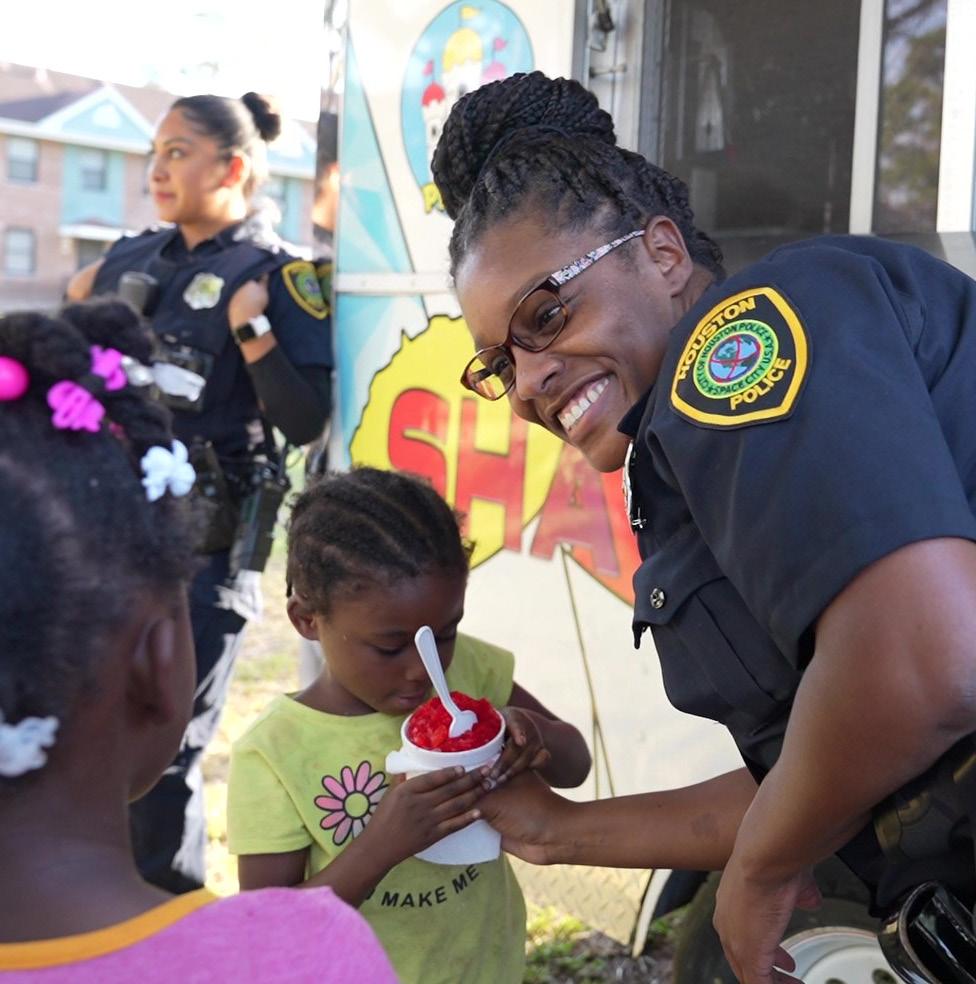
Public safety is the most pressing concern for the Third Ward and Cuney Homes residents. In the Cuney Homes Resident Survey, only 25% of respondents felt safe in Third Ward, and only half of the respondents (50%) felt safe in Cuney Homes. The fear of neighborhood crime unfortunately dictates the way Cuney Homes residents move about their community. Over half (60%) of Cuney Homes residents believe it would be easier to have an active lifestyle if their feeling of safety was greater.
The physical environment can be designed to reduce crime and improve the quality of life by implementing the “eyes of the street” method introduced to us by Jane Jacobs. Residents in the Neighborhood Task Force feel very strongly on how the Cuney Homes site should be redeveloped. One early suggestion from the Houston Police Department was to install perimeter fencing to convert Cuney Homes into a gated community. Residents quickly opposed this notion, fearing that installing gates around the property would make them feel incarcerated.
Crime Prevention Through Environmental Design (CPTED) is a multi-disciplinary approach of crime prevention that uses urban and architectural design and the management of built and natural environments. Cuney Homes residents feel (1) illuminated wayfinding signs, (2) traffic calming installations (like bollards, speed bumps or tables, angled slow point curbing), (3) brighter street lighting, (4) designing units to overlook the Columbia Tap Trail, (5) improved addressing system to aid law enforcement with responding to specific units, (6) keypads with codes assigned per unit to access common areas like the on-site computer lab or laundromat, (7) larger windows for residents to easily observe street life, (8) landscaping to prevent visual barriers on the property as well as dead spaces, (9) installing benches and seating areas to encourage physical presence of “eyes on the street” are all viable design solutions to discourage crime at the Cuney Homes.
Both Harris County, the City of Houston, and the Department of Justice have demonstrated efforts to deploy well-defined, sound, community based, and results-oriented public safety strategies through the Cure Violence, One Safe Houston, and Violent Crime Initiative programs. These three programs are aligned to build upon existing public safety efforts to decrease gun and gang violence while employing advocates for community policing efforts and the healthcare system for supportive services and resource connections for crime prevention efforts.
Harris County announced the Cure Violence program in 2021. This initiative will address violent crime issues from a public health perspective through the hospital system and with community advocates. County commissioners approved $11 million for this initiative.
In February 2022, the City of Houston launched the One Safe Houston crime reduction initiative focused on four key areas: violence reduction and crime prevention, crisis intervention, response and recovery,
key community partnerships, and youth outreach opportunities. This $44 million-dollar program is funded by the American Rescue Plan Act of 2021.

Also in 2022, The U.S. Department of Justice visited Third Ward’s Jack Yates High School to announce the Violent Crime Initiative, a combination of tools and resources used to investigate and prosecute violent gangs with federal racketeering (RICO) charges. Dedicated investigative agents from the FBI, Bureau of Alcohol, Tobacco, Firearms and Explosives (ATF), U.S. Marshals Service, Houston Police Department, and the Harris County Sherriff’s Office (HCSO) are also included in this effort.
The City of Houston’s Gun Buy Back program is a “no questions asked” approach to collecting firearms in exchange for gift cards. In just two events, $250,000 in gifts was distributed to obtain 3,000 guns that were permanently removed from the streets. The City has budgeted $1 million for the gun buy-back program.
2023.
Source: HHA
Walking Towards Our Future with residents of Cuney Homes in JunePeople at risk for violent victimization will be connected to mental health and substance abuse treatment, employment opportunities, and support to exit gangs through Harris County’s Gun Violence Interruption Program.
To further ensure the public’s safety, the City of Houston invested $1.9 million to employ 15 additional park rangers. Rangers will work with local law enforcement to maintain safety in Houston’s parks. The Cure Violence Program trains and deploys outreach workers and violence interrupters to mitigate conflict on the streets.
The Holistic Alternative Responder Tram program (HART) sends public health staff instead of law enforcement to nonviolent calls involving mental health, homelessness, and substance abuse issues. This program will help ease law enforcement resources and help avoid unnecessary police interactions. Harris County considers the HART program as the fourth pillar in the first responder system and has invested $5 million into this program.
Harris County also addresses root causes to violence from the public health perspective. Teams of individuals who have also been perpetrators or victims of violent crimes will be assembled as “credible messengers”. These individuals are trained to understand crimes trends in at-risk neighborhoods and hospitals to connect these residents with supportive services, such as mental or other health services, and basic needs (food, shelter, clothing, etc.).
Collaborating with the Hospital Alliance on Violence Intervention will allow hospital workers to help victims of violent crimes with supportive services.
Houstonians voiced their outrage when bail bond companies allow violent criminals with high bonds to post bond at a cost substantially less than the customary 10 percent of the bond amount. The City’s Legal department is drafting an ordinance that will require bail bond companies to charge a premium that is equal to at least 10% of the bail bond set by the court.
The City of Houston provided an additional $1.5 million in funding to the Houston Forensic Science Center. This funding will allow Harris County’s courts to process 100,000 cases on backlog, which is more than any other city in Texas as well as the county. This effort will provide timely evidence for cases still in progress in the local court system.
Recently, the Department of Justice has increased their efforts to combat gang violence in Third Ward. Through partnerships with the U.S. Attorney’s Office for the Southern District of Texas (SDT x ), local and state and federal law enforcement, the Department of Justice Criminal Division’s Violent Crime Initiative returned it’s first indictments against six alleged gang members of the 100% Third Ward (103) Gang accused of furthering an ongoing gang war in Third Ward. This gang is accused of violating federal racketeering laws with criminal acts involving murder, robbery, narcotics distribution and assault while recruiting new members primarily from Third Ward neighborhoods.
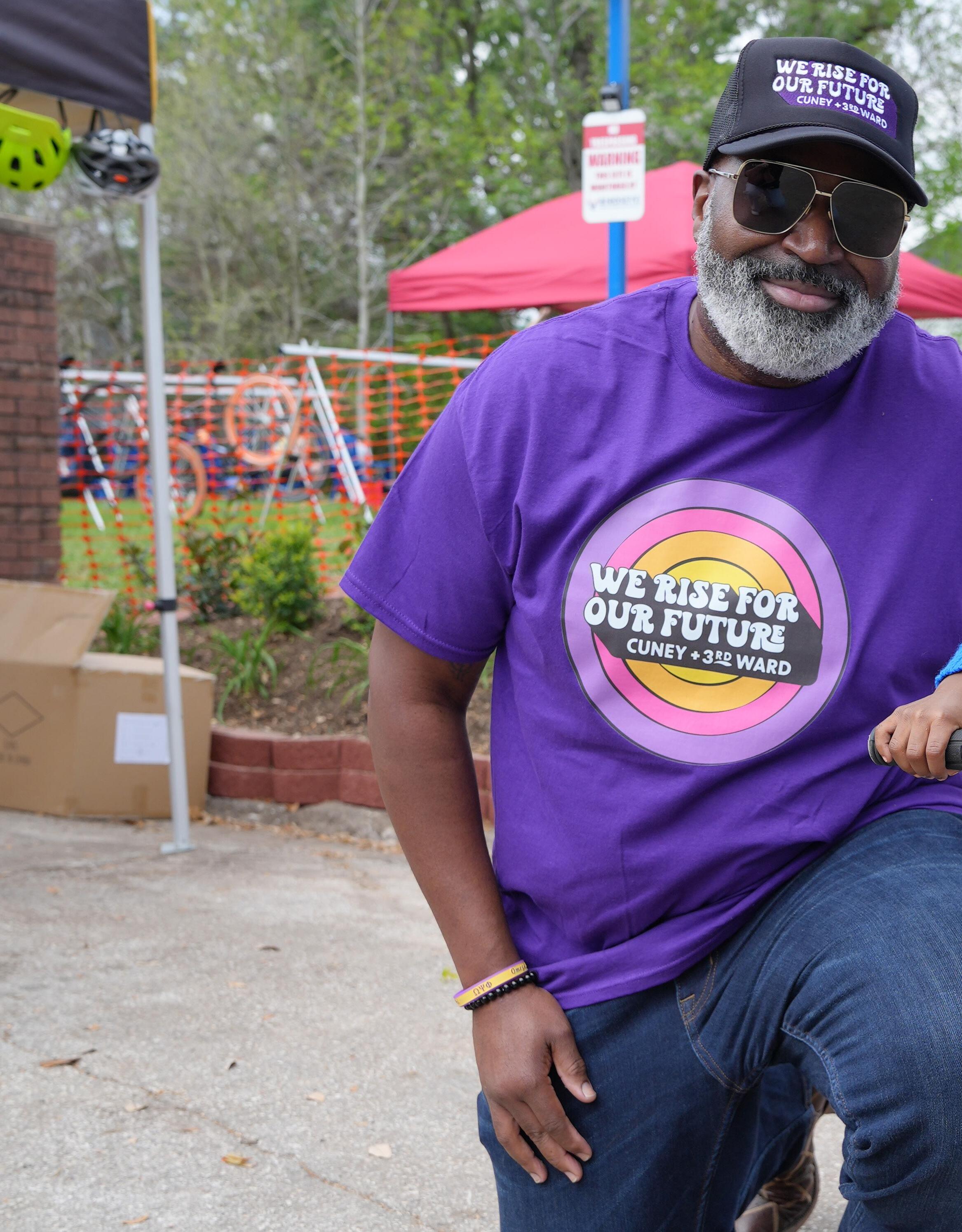
 The larger community came to the Third Ward On Tap event at the Columbia Tap Trail on March 2023.
Source: HHA
The larger community came to the Third Ward On Tap event at the Columbia Tap Trail on March 2023.
Source: HHA
f Goal 5
Design and implement streetscape improvements, traffic calming measures, and public elements that support the neighborhood’s history and culture.
Safely and easily moving around the Third Ward and beyond is essential for residents of all ages, abilities, and modes of transit. As outlined in the Third Ward Complete Communities Plan, and now designated one of the City of Houston’s Walkable Places, Emancipation Ave is a key corridor of community gathering and history that should be revitalized for resident safety and cultural celebration. Streetscape improvements should include repaving streets, repairing and connecting sidewalks, installing attractive lighting for after-dark safety, and trimming back overgrown tree canopy that can block visibility and lighting.
Traffic calming measures like traffic tables at crosswalks, bump-outs at accessible corner crossings, and decreased width for lanes of travel will help slow passing traffic and allow residents to safely cross and walk along Emancipation Ave.
Beyond physical improvements for safety, streetscape elements can also help to tell the story of the Third Ward’s history and culture. Public art, wayfinding signage, and blue street tiles can all work together to celebrate the heritage of the neighborhood, and work in partnership with EEDC’s economic development measures to support emerging Blackowned businesses along the Emancipation Avenue Main Street corridor. Once Emancipation Ave is revitalized, other important connector streets like Alabama and Ennis can receive similar streetscape treatments and wayfinding in order to key the entire neighborhood into a similar identity.
"I would like to see more buses out here like Metro lift, helping the elders and helping the people that really need help.”
Elaine Jones
Third Ward resident
Provide awareness of and transportation to parks and recreation spaces, and to other extracurricular activities such as STEM events that encourage educational and historical learning about Houston and local Black heritage.
Providing mobility and engagement for our neighborhood youth is one of our foundational needs: many residents speak of the strong need for extracurricular places and programs that welcome our children with enriching and educational activities for all. Houston’s recreation centers/athletic fields and sports leagues are one resource, but so are educational or skill-building places like libraries, career days, and STEM-focused activities to engage our youth even outside of school.
We will collaborate with Houston Public Schools, METRO, Texas Southern University, and youthoriented organizations like Generation One, to promote activities and physically bring youth of all ages to these opportunities, whether through public transportation or targeted shuttle services.
The new recreational spaces at Cuney Homes and existing hubs like Emancipation Park are a natural site for activities, but all of Houston’s public recreation and youth-focused places should be accessible. Physical transportation to these sites will go hand in hand with a campaign to broadcast awareness of opportunities to better engage our youth physically and mentally. Some of these programs and mobility resources can subsequently be expanded to adults in our neighborhood who may also wish to improve access to recreational and career-training resources in the city.
“Would any of the following programs interest the children in your household?”
Reduce blight by repurposing vacant lots utilizing a “Lots to Love” strategy of activating vacant lots through short and mid-term reuse.
The vacant lots scattered throughout the Third Ward can be seen as a negative blight on the prosperity of the neighborhood, but they can also provide sites of opportunity for short-term activation and pocket parks in the heart of residential blocks. A recent success story is the Third Ward Chess Park, which reclaimed a vacant lot at the intersection of McGowen St and Live Oak St for the Third Ward Chess Club to meet and gather, with the help of donations, volunteers, and the permission to use the property. Similar projects can be expanded throughout the neighborhood, which will have the double benefit of discouraging dumping while promoting local community culture. Implementing a vacant-lot reuse program like the “Lots to Love” program outlined in 2016’s Emancipation Park Neighborhood plan, and drawing from successful vacant land reuse programs from other cities, would give residents the opportunity to reclaim vacant areas on their own streets. These short- and mid-term projects could include landscape beautification, community gardening, and small-scale infrastructure like benches and platforms for holding events. The program can be facilitated through the Houston Land Bank and EEDC, and promoted for residents to take a grassroots approach to create spaces for community building and culture sharing in their own neighborhoods. These reclaimed sites can become a neighborhood-wide way to highlight hyperlocal culture and promote the Third Ward’s vibrant and welcoming community.
Work with METRO to explore transit improvements for the current long range plan.
While mobility improvements within the boundary of the Third Ward are necessary to better connect residents with each other, connecting the Third Ward with Houston at large is even more important, particularly to connect our residents with job centers. We will be collaborating closely with METRO as they enact their current long range plan to ensure that Cuney Homes and Third Ward residents are well connected to the larger city, and that planned expansions of the current transit systems continue to incorporate our neighbors and their mobility needs. While final decisions are in progress, current conversations are exploring the expansion of the Westheimer bus route east to Emancipation Park and the University of Houston; a north-south bus route on Emancipation Avenue between the Texas Medical Center and downtown Houston; and a Bus Rapid Transit line through the Third Ward, possibly along Alabama Street. All of these improvements would have an enormously beneficial impact on our residents’ lives and ability to move around and get to services, jobs, and other resources in the Houston region.
Third Ward On Tap event brought kids and families from Cuney Homes and the wider Third Ward together to enjoy the Columbia Tap Trail, one of the key assets of the Third Ward.
Source: HHA

f Goal 6
Teach Third Ward youth about the neighborhood's history and spirit of advocacy.
Community centers, nonprofit organizations, and parks can be leveraged as resources to expand afterschool and summer enrichment programs, including historical tours, guest speakers, and holistic projectbased workshops/programs. Through these programs, youth can identify an issue that affects the Third Ward, research the issue’s historical, cultural, environmental, economic, and social impact on their community and research, propose practical solutions, write about their findings, and ultimately advocate for change through local civic groups, local government, local community partners and stakeholders.
Cuney Homes Resident Council can facilitate a Cuney Homes Youth Council to create initiatives that interest the youth of Cuney Homes. They can help with community canvassing in promotion of community wide events, and create a youth led agenda around safety and security, after-school/summer programs, youth-oriented events and field trips. Through their schools, they can organize food drives to provide food to the Feeding Our Future Food Pantry. Youth can receive volunteer hours for their involvement on the Council which can assist with college acceptance. Community Resources include: Cuney Homes Resident Council, S.H.A.P.E Community Center (after-school & summer program), Change Happens- Good Life Outcome Program, Project Row Houses, The ReEducation Project, and Workshop Houston.
“What makes Third Ward unique is the nuance of the intergenerational gatherings that take place to let it be known that pride and prosperity are things that we prioritize.”
RUEROB Jackson
Third Ward resident
Engage residents with existing programs offered by local service providers that empower them to be active in the community and provide them with advocacy knowledge.
Connecting residents to existing programs is crucial, and will rely on the partnership of service groups working in the neighborhood to diversify outreach efforts. Local service providers can start by reaching out to residents and establishing personal connections, creating an important word of mouth network. Community organizations, churches, and leaders who have established relationships with residents can also help facilitate and customize outreach efforts. Services and programs should be offered in easily accessible and convenient locations like laundromats, parks, or local schools.
Text messages, robocalls, social media, and community bulletins could be used to advertise services and events for a wide range of technological literacy.
Local services and programs can offer incentives or community competitions to engage residents. Workshops and seminars can focus on topics such as civic engagement, community organizing, and advocacy, in order to help build collective power in the Third Ward. Community Resources include EEDC, Project Row Houses, National Black United Front, S.H.A.P.E. Community Center, Third Ward is Home, Third Ward is Home Civic Club, Third Ward Community Cloth Cooperative, and the Change Happens- Good Life Outcome Program.
Events like HHA Bike Ride with Cuney Homes residents can help them connect with other residents while advancing community advocacy.
Source: HHA

 T-shirt with the mural of Cuney Homes basketball court made for the opening day. Red and yellow represent the colors of Jack Yates and 54 represents George Floyd's number.
Source: IMPAcT13
T-shirt with the mural of Cuney Homes basketball court made for the opening day. Red and yellow represent the colors of Jack Yates and 54 represents George Floyd's number.
Source: IMPAcT13
Continue to promote and encourage the participation of Cuney Homes residents in community engagement events.
Cuney Homes residents may need some additional attention to bring them into larger engagement activities in the neighborhood. A wide toolkit of strategies can all work together to increase participation. The Houston Housing Authority can partner with local community organizations, such as neighborhood associations or churches, to co-host community engagement events. This can help reach a wider audience and build stronger relationships with the community. Some prospective partners include 3rd Ward is Home Civic Club, The 3rd Ward Super Neighborhood, S.H.A.P.E. Community Center, Trinity Baptist Church, and the Third Ward Community Cloth Cooperative.
Identifying the barriers that may keep residents from participating is crucial. For instance, some Cuney Homes residents may face transportation barriers that prevent them from attending community engagement events. The Houston Housing Authority can provide transportation services to help residents get to and from events or partner with METRO to provide bus/ train cards. Incentives can help encourage residents to participate in community engagement events: for instance, residents who attend a certain number of events can be entered into a raffle for a prize or receive a small gift card.
The Houston Housing Authority along with Sankofa Research can solicit feedback from residents about the types of community engagement events they would like to see. This can help ensure that events are relevant and interesting to residents, and can help build buy-in and participation.
Communication strategies include a Cuney Homes Newsletter with upcoming events, meetings, workshops/classes, holidays, announcements, safety tips, fundraisers, service contact information, and community initiatives, spearheaded by the Resident Council; and Cuney Homes Bulletin Boards throughout the property where residents can see regular community announcements and events.
“[My vision for the Third Ward] is to continue growing the way it has been with a vision of it getting better, not going backwards.”
Clarice Freeman
Third Ward resident

The Housing Plan will aim to enhance the availability of safe and affordable housing that continues to foster the strong sense of community and is sensitive to the surrounding context. The Plan will consider strategies to address gentrification and prevent displacement, and explore opportunities to create “nodes” of activity so that the neighborhood can enjoy some of the services it currently lacks.

These principles that we worked on together guide the planning and design of housing in the Third WardCuney Homes Choice Neighborhood. They reflect the community's priorities for redevelopment of housing in Houston's Third Ward.
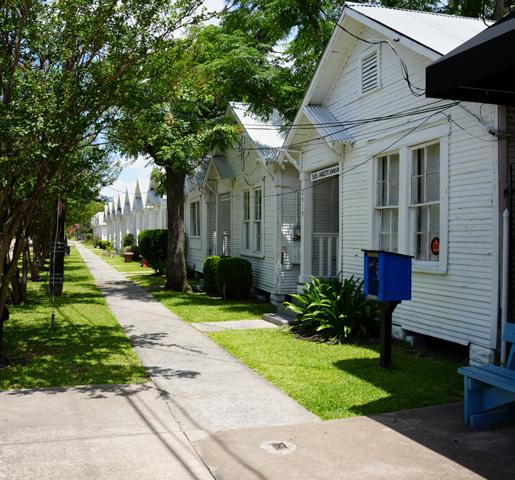

the history, culture, and character of the Third Ward in art, murals, landmark signage, and wayfinding with QR-codes that share stories, and streets named for significant Third Ward residents.
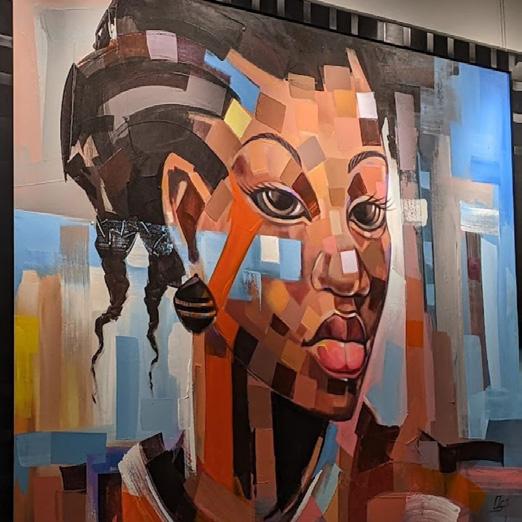
that build skills, education, and wellness such as a learning and rec center with programs and activities (tech lab, job training, portable library) for all ages as well as playgrounds, outdoor fitness, and community gardens.

that speaks to the Black community and says Third Ward, preserving its modest scale, front porches and courtyards, gabled roofs, and green spaces.
to stores and services nearby, particularly a co-op market, an incubator for entrepreneurs, community kitchen, entertainment, and job opportunities (including for youth).
by organizing housing in clusters and weaving in seating/gathering areas outdoors.


safety for all ages and businesses through design, lighting, and disaster resiliency planning, including safe play spaces for children.
using a range of housing types and amenities for people at different stages of their life (seniors, those with disabilities, in transition, youth, families, single parents) and maintain affordability.
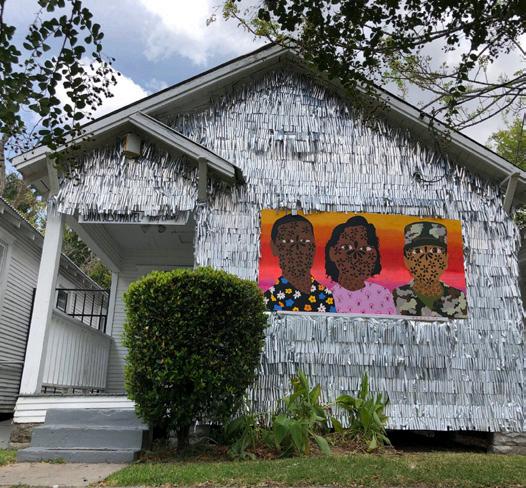


to reliable Metro routes and encourage other forms of transportation (bike lanes and racks, bus shelters, scooters).

by maintaining permanent affordability, incentivizing resident return, and helping existing homeowners remain in their homes.
lasting materials like brick, textures, and cobblestone crosswalks to create a sense of longevity and quality.
and green infrastructure into the design including solar energy, green roofs, rain gardens, solar shading.

A close-knit community through the preservation of the history and culture:
The key goals of the Housing Plan emerged from residents’ input and feedback throughout the planning process. These goals reflect the desires we heard from the community for the Choice Plan to not only impact the Cuney Homes site, but to positively transform the Third Ward neighborhood as a whole. The priorities outlined in this housing framework knit together objectives from various multi-sector efforts across the Third Ward to create lasting change at Cuney Homes and beyond. Investments in the redesign and development of the Cuney Homes site anchor a broader shared vision for a healthy, safe, and inclusive community, where neighbors of all ages, abilities, and incomes support one another and celebrate the rich history and culture of the Third Ward. Through efforts to bolster affordable housing in the neighborhood, mitigate displacement and gentrification across the Third Ward, and build generational wealth among residents, the Housing Plan serves as a catalyst to strengthen and propel forward the vibrant and empowered legacy of African American communities in Houston’s Third Ward.
f Goal 1
Preserve and increase affordable housing within the Third Ward.
f Goal 2
Limit displacement of Cuney Homes and Third Ward residents.
f Goal 3
Redesign Cuney Homes as a welcoming place that fosters community and celebrates the historic character and rich African American culture of the larger Third Ward.
f Goal 4
Create a community that fosters health, wellness, and safety for residents and visitors of all ages as well as businesses.
f Goal 5
Support the needs of seniors and residents with disabilities.
Choice Neighborhood Resources & Supportive Services
Cuney Homes Site and Off-Sites

Neighborhood Corridor
Major Highway
Trail Park
Waterbody
Community Assets
Education & Child Services
Place of Worship
The Choice Neighborhoods Housing Plan strives to create new affordable housing units and homeownership opportunities accross the Third Ward. These new housing areas are located in proximity of main cultural, mobility, and economic corridors - Alabama Street, Emancipation Avenue, and Columbia Tap Trail.
f Goal
Strategy
Increase new affordable housing stock at Cuney Homes and other infill sites in the Choice Neighborhood in addition to onefor-one replacement.
The most effective strategy to serve as a bulwark against the culture-erasing forces of gentrification in Houston’s Third Ward is to develop new affordable rental units for every Cuney Homes household and many more working-class families. This strategy responds to both quantitative and qualitative needs. Data shows that the Third Ward households are older, lower in income, and higher in rental rate than the City of Houston. Additionally, the vacancy rate is more than twice that of the city. Despite these data points, the median value of a home in the Third Ward is 20% higher than the city as a whole. Gentrifying forces have been in effect for over a decade. Residents corroborate this from their personal experiences – fear of being displaced and desire to retain culture through affordable housing are of the strongest sentiments from engagement events. 90% of surveyed residents feel new affordable rental housing is needed in the neighborhood.
Structure all non-intitial phase of redevelopment (and every site) to be approximately 75% affordable (replacement and non-replacement) and 25% market rate.
In order for the Third Ward to thrive for future generations, it is important that all Choice rental housing be mixed-income in nature. Mixed-income housing has been proven to be successful both economically and socially in national models. Public housing households, workforce households, along with market-rate tenants live in indistinguishable apartment units, sharing the same amenities and participating in the same community activities. Market rate rents will escalate as the Third Ward continues to grow. In many mixedincome developments, market rate rental units play an outsized role in activating street life – retail presence, parks/trails activation, and business incubation.
“[What should happen at Cuney Homes is] affordable housing, livable housing. I am holding strong trying to see the future. Just to building up the area around us. It is time.”
David Butler
Cuney Homes resident
Integrate a variety of housing types/unit sizes that complement existing typologies and accommodate a range of household needs.
The Third Ward architectural vernacular is an eclectic mix of bungalows, shotgun homes, new townhouses, and low-scale apartment buildings. The Housing Plan proposes a wide range of housing types that include live/work units, rowhouses (inspired by Project Row Houses), walk-up flats, kneeling townhouses, and multifamily, mixed-use elevator buildings (both senioronly and family). Additionally, to accommodate Cuney Homes and Third Ward households in every stage of life, the Housing Plan includes bedroom sizes that range from one-bedroom units for singles and seniors to two-bedroom/two-bathroom units for co-living as well as three- and four-bedroom family-friendly units. Some buildings can be modified to accommodate multigenerational living situations.
“What type of housing do you feel is needed in the neighborhood?”
New affordable rental housing
Supportive housing (for veterans, people with disabilities, transitional housing, etc)
New senior housing
A home renovation/ modification program
Community meeting in March 2023.
Residents were able to give input on some of the features on the redeveloped Cuney Homes.
Source: WrT


Residents giving input on what they would like to see at Cuney Homes in the future on June 2022 workshops.
Source: KAMILLe DeVILLe

A preliminary market scan conducted by Community Development Strategies in 2022 informed the Housing Plan. Empirical data, coupled with anecdotal input, reveal a rapidly changing housing market in the Third Ward – where high income outsiders are buying and renting in the Choice Neighborhood at the expense of existing residents. Absorption rates, sale prices, median rents, and intense need for affordable housing support an ambitious mixed-income housing plan in the Third Ward.
In the Choice Neighborhood an estimated 11% of owner households made less than $50,000 and 52% of renters made less than $50,000.
In comparison, Houston had 13% of owner occupied households that made less than $50,000 and 35% of renters made less than $50,000.
The median gross rent as a share of income for the Choice Neighborhood was 32.5% compared to 30.4% for Houston.
Renter households making less than $34,999 in the Choice Neighborhood made up 91% of housing cost burden renters.
Homeownership relevant data highlights based on market research
f Single-family detached home sales volume in the Choice Neighborhood increased by 84% from 80 in 2016 to 147 in 2021.
f The median sale price in 2016 was $261,250 and went up 40% by 2021 to $365,000.
f Average sales price per square foot increased about 40% from $131 psf. in 2016 to $183 psf. in 2021.
f Single-family townhome sales volume in the Choice Neighborhood from 2016 to 2021 stayed flat with 26 and 28 sales.
f The median townhome sale price in 2016 was $296,500 and $299,500 in 2021.
f The Choice Neighborhood had a higher median price than the Houston Metro in 2016 and 2021.
f As of February 2022, there were 63 single-family detached active listings with a median list price of $375,000 in the Choice Neighborhood.
f Of the 63 single-family detached active listings, median square feet was 1,777 and median list price per square foot was $215 psf.
f As of February 2022, there were 3 single-family townhome active listings with a median list price of $335,000.
f Of the 3 single-family townhome active listings, median square feet was 1,779 and median list price per square foot was $191 psf.
CDS’ forecast shows significant population and jobs growth in the Choice Neighborhood by 2045.
CDS reached out to several local real estate agents, builders and developers active within the Choice Neighborhood. Their anonymous feedback has been paraphrased in the bullet points below.
f So far in 2022 prices have continued to increase to the high $300,000s as the lowest priced new detached single-family home.
f Older homes are bought almost exclusively by investors.
f Most new construction is from a few local investors, developers and builders that have been the most active over the past five to seven years.
f Older homes are not being preserved or rehabbed.
f Not enough rental units, almost everything new is higher priced for-sale.
f Single-family rentals are getting harder to find.
f Empty lots are going for $125,000 to $245,000 a piece.
f Most recent buyers for new product are professionals working downtown like engineers, or lawyers, or at the universities as professors or faculty or work in or around the Texas Medical Center in healthcare.
f Age for buyers of newest single-family in the $380,000’s to $400,000 ranges have mostly been 28 to 40 high salary earners in the $150,000 and up range.
f Most of the buyers of highest priced homes in the $500,000s and up have been 40 and older since those prices require so much savings and down payment.
f Older buyers of the highest priced homes seem to be mostly coming in from outside of Texas from other parts of the country and world.
f New permits from the city have gone from 3 to 5 months to 14 months now to start building on additional owned lots that plans have been submitted and paid for.
f Time delays are passed on to the buyer and they pay with not much pushback because they know everything is backed up from materials to permits and they are getting a very nice, brand new home.
f The local builders and developers that are active in the Third Ward right now have the experience and understanding to construct new duplex and multi-unit rental housing.
In 2023, ALN Apartment Data was contracted by the Houston Housing Authority to conduct a market survey of multifamily properties within a 1.5 mile radius of Cuney Homes. ALN surveyed 13 properties with a median construction date of 1979 and an average unit count of 162 dwelling units. The average effective rent per unit is $1,437; the average square footage is 793 square feet; the average rent per square foot is $1.81 with a 93% average occupancy rate, and no markedly noticeable slow down in absorption rate. Based on this data/trend, there is confidence of strong demand for unrestricted market rate rental homes proposed in the Housing Plan.
Looking at typical market rate lease rates for recently built multifamily properties and comparing that to rents affordable to various Houston region AMI levels, CDS estimates that 120% AMI households should be able to afford the new market rate units, especially if they are somewhat lower rates than new multifamily properties west of SH 288 or north of I-45. CDS would recommend such lease rate positioning for the market rate units as the lease rates attained by properties in Midtown / Museum Park / EaDo are not likely yet supportable in the Cuney Homes / Emancipation Park area. Many households (though not necessarily all) in higher income ranges well beyond 120% AMI may prefer attainably priced properties in those other neighborhoods anyway due to a better range of neighborhood amenities and services.
CDS finds the rental unit product mix largely suitable for the neighborhood and market context. The rowhouses and townhomes will be particularly attractive to families, especially those with children, needing a greater number of bedrooms and preferring exterior entrances to common interior corridors.
They also provide options for renters who do not want multifamily living, or at least other tenants living above, and might otherwise leave the neighborhood to seek single family rentals. They can also be less expensive to construct than stacked multifamily buildings on a per square foot basis.
The units with potential ground floor commercial space (the vertical mixed-use apartments and the live-work units) merit some additional considerations. The Third Ward likely has a growing community of entrepreneurs, but the range of businesses they pursue may span a larger spectrum than those with a “quiet”, office-focused environment. The design and use of noise reducing materials of the units, and perhaps use restrictions, will therefore need to ensure that noisier and messier businesses are relatively self-contained and do not lower the quality of life for unaffiliated nearby residents.
Furthermore, due to challenges with access to capital, these businesses may have limited funds for interior buildout and required equipment. Commercial rents in vertically mixed-use space may also need to be relatively high for standard development because the overall building structure tends to be more expensive to construct, and many local businesses can find it a fatal burden, especially if they are serving low and moderate income customers. A financial and technical assistance program, including working with the SBDC, CDFI and other small business finance organizations such as Houston Business Development, Inc., in addition to below-market lease rates for the commercial space (for qualifying business and ownership types), should be a consideration. Finally, the Emancipation Avenue frontage is the best-suited to accommodating customer-facing or retail and dining businesses. The commercial spaces on the redeveloped Cuney Homes site itself may need to target occupants that do not need high physical visibility to potential customers.
Through the Houston Community Land Trust (HCLT), we can ensure lasting and sustainable affordable homeownership in the Third Ward. HHA will work with HUD and HCLT to connect qualified home buyers to home builders. The buyer is responsible for the taxes on the land lease and they are responsible for the taxes on the improvements which is determined by the owner's investment from the mortgage they have taken out and any down payment or earnest money they have contributed. Below is an example:
Developer builds a home and sets the sales price at $300,000 as determined by their build and land acquisition cost. A buyer at 80% AMI in a single person household for example can afford a home at $100,000. Therefore a subsidy of $200,000 would have to be put into the home to meet the buyers affordability.
The buyer decides to buy through HCLT and the restricted resale price would then start at $100,000 plus whatever the buyer contributed for a down payment and earnest money. The buyer would then earn 1.25% appreciation on the home every year. They would pay taxes on the $100,000 not the $300,000 market rate to start and pay taxes on the limited appreciated value moving forward as well as the taxes on the land lease which is an additional $150.00 per year.
This table below assumes a max of 30% of income spenttowards rent and estimated income levels based on an average of HUD’s figures for 3-person and 4-person households. If this analysis were performed for 1- or 2-person households, the estimated income levels would be lower, and required subsidies greater. It should be noted that in this scenario, there may be some extra transaction fees or other costs not accounted for in the following calculations.
Promote and invest in a Community Land Trust to expand affordable housing.
The project team is exploring the Houston Community Land Trust model for the affordable homeownership units. The community land trust model is designed to protect certain neighborhood land from the relentless upward pressure of urban land markets. In other words, the community land trust preserves some neighborhood land for community-serving uses, such as permanently affordable housing for everyday families with limited incomes. Community land trust homeowners buy their home at a price they can afford, and are far more likely to be able to remain in their home for as long as they wish to stay - without the pressures of unaffordable mortgage payments or rising property taxes in the surrounding neighborhood. Community land trusts create housing affordability through shared ownership: the homeowner owns the home itself, while the community land trust owns the land beneath, stewarding it for the benefit of the homeowner, future homeowners, and the community as a whole. The homeowner enters into a Ground Lease with the community land trust that allows them to enjoy exclusive use of the land beneath their home. The Ground Lease lasts 99 years, and is both renewable and inheritable. In the Ground Lease, the homeowner agrees to earn modest equity in the home over time and, if they sell, to sell to another limited-income buyer. This way, the price of the home always remains affordable to future buyers.
Provide tax incentives for rehabilitation for property owners that rent affordable units.
Learning from other Texas cities, the City of Houston can adopt tax incentive policies that encourage property owners to invest in the maintenance of their rental properties. Dallas’ Comprehensive Housing Policy update designates Neighborhood Empowerment Zones (NEZ), within which developers and landlords may qualify for development fee reimbursements and a 10-year City tax abatement if they spend at least $10,000 bringing single-family or duplex rentals for households under 60% AMI up to code. The City of Dallas Housing Finance Corporation also provides tax-exempt mortgage revenue bond financing for the acquisition and rehabilitation of existing and new multifamily units for working families at 60% AMI or below. In Austin’s historic districts, developers rehabilitating a contributing property in a historic district are eligible for an abatement of 100% of municipal property taxes assessed on the added value of the rehabilitated property.
“The smaller houses are being displaced and (…) somebody’s trying to buy your area. Let them know that “we are not selling, we are giving to our children”.
Lana Edwards Third Ward resident
Residents gathered to give feedback on the Housing Plan on March 2023 at the community meeting.
Source: WrT

Strategy A.
Follow a build-first strategy to limit displacement of Cuney Homes residents while the site is being redeveloped.
Fear of displacement is the highest concern for Cuney Homes households. In order to limit displacement (and to set the correct tone) it is imperative that the Housing Plan begins off-site on vacant parcel(s). This first phase of mixed-income rental housing should have a high percentage of Cuney Homes replacement units in order to serve as an early relocation resource.
Integrate Cuney Homes into the Third Ward neighborhood by creating a distinct, welcoming, and inviting environment that celebrates the Third Ward's history, art, culture, and character.
The Housing Plan prioritizes four areas within the Third Ward to foster a seamless integration between the Cuney Homes site and key neighborhood corridors. These focus areas include Emancipation Avenue, Alabama Street, Live Oak Street, and Cleburne Avenue and the Columbia Tap Trail.
86%
A safe, stable, and familyfriendly neighborhood
84%
A thriving center of Black and African American culture - a place you can expect to find performances, markets, and social events that celebrate the rich heritage and contributions of Black Houstonians
f Emancipation Avenue: as the historic heart of the Third Ward, Emancipation Avenue anchors Cuney Homes and the neighborhood with cultural, recreational, and commercial amenities. Building on the higher density, yet historic, character of this corridor and its potential to evolve into a destination and central gathering space for the community and visitors alike, the shared vision for Emancipation Avenue features a mix of densities, rental and homeownership opportunities, as well as retail spaces and amenities that serve the Third Ward. New housing along Emancipation Avenue will feature 172 accessible multifamily homes and 21 affordable homeownership homes. Plazas with shade, retail space for Black-owned small businesses, and well-lit, walkable streets will also respond to the community’s priorities for this area.
"What would you like this neighborhood to be known for after it has been redeveloped?"
f Alabama Street: centered around the planned BRT corridor, this portion of the site is envisioned by residents as a lively, walkable local main street. Mixed-use residential buildings of 4 to 5 stories will line Alabama Street with ground-floor retail amenities as residents expressed a desire to maintain the smallscale and the local feel of this corridor. Wider sidewalks will encourage the activity of vibrant local small business, such as eateries and a food co-op to spill out onto the sidewalk, inviting folks to walk, gather, shop, and enjoy. The integration of art from Black artists in the Third Ward that celebrates the neighborhood and the legacies of former residents will foster neighborhood pride and a distinct sense of place.

f Live Oak Street: This corridor will be a key connector between Alabama Street and the New Hope Housing development on Gray Street. With proposed Complete Street improvements along Live Oak creating walkable access to New Hope Housing’s wraparound supportive senior services, preschool, and indoor and outdoor communal spaces, Cuney Homes residents can seamlessly integrate with this multigenerational community, contributing to a cohesive Third Ward.
f Cleburne Avenue and Columbia Tap Trail: this area is envisioned by residents as a neighborhood gateway to Cuney Homes that celebrates its proximity to Texas Southern University and the Columbia Tap Trail. Cleburne Avenue is an important east-west connection that was recently transformed into a Complete Street to make it safe for pedestrians, cyclists, drivers, and users of public transit. The community’s shared vision features a mix of townhomes, stacked townhomes, 3-story multifamily buildings, and 4-story multifamily gateway buildings that will knit this edge of the Cuney Homes site with the adjacent neighborhood, opening up to a 1.25-acre town green and new community center that will serve as central gathering spaces for Cuney Homes residents. This integrated approach continues along the Columbia Tap Trail, where live-work units will overlook the trail – a key north-south connector that will integrate public art, lighting, benches, and a small plaza.
“Third Ward is my home, and it is not for sale. (…) It is our land, it is our place.”
Chris Tucker Third Ward resident

The current Cuney Homes occupies a large portion of the Third Ward land and thus, the scale of the site requires a conceptual design that responds and aligns with preexisting landscape functions whether that means to protect existing heritage trees or acknowledging the relatively flat terrain that may drain slowly during a storm event.
As communities are always a part of the natual environment, this Plan also includes consideration of the cherished physical aspects of Cuney Homes and Third Ward. These considerations include the history of Black arts and artists visible in the public realm with features such as Project Row Houses.
STORMWATER INFRASTRUCTURE


Open space rain gardens
Streetside rain gardens
Sub-surface storage

f Control on water on site: A critical component to the site's design is the management of stormwater. Rain gardens can help mitigate flood risks by providing a volume of space for water to be temporarily stored without hazard. For added precaution, the neighborhood's parking lots can also be sites for subsurface storage in the form of various cistern systems.
ARTS INFRASTRUCTURE
Walking loop
Arts and heritage walk
Sculpture and mural opportunity
Open green space
SOCIAL INFRASTRUCTURE
Walking loop and lounges
Arts and heritage walk
Athlete's run and lounges
Open green space
Community and amenity rooms
Columbia Tap Trail
CONNECTIVITY AND MOBILITY
Walking loop
Arts and heritage walk
Connected sidewalks
Table crossing

Pedestrian plaza
Pedestrian bulb-outs
STREET TYPES
Boulevard
Community boulevard
Neighborhood street
Parking and raingarden
Plaza street
Columbia Tap Trail
f Celebrate place with arts & educational opportunities: A network of pathways and community spaces provides opportunities for social interaction as well as arts installations. Such features will highlight the interconnected histories of Cuney Homes and the Third Ward neighborhood.
f Foster connections in the landscape: Each building within the site represents its own community and will feature its own tailored amenities such as a streetside courtyard & porch for the seniors, ground floor retail and operation sites for local organizations. These indoor and outdoor spaces are supported by safe and pedestrian friendly walks
f Prioritize pedestrian experience: The ability of residents and visitors to move around the neighborhood as pedestrians in a safe and comfortable manner is a central feature in the site's design. The inclusion of not only complete sidewalks, but sidewalks enhanced with sitting areas adjacent to public activities such as retail shopping is to ensure a vital public realm.
f Provide distinct street character: All of the systems mentioned above inform this most critical framework. The character of streets is determined by building type, ground floor activities and the desire for higher visibility and community activities, or privacy and respite.

Create 100 affordable homeownership opportunities within the Choice Neighborhood.
The City of Houston along with the Local Initiatives Support Corporation (LISC) Houston and the Harris County Homeownership Collaborative (HCHC) have launched a new initiative aimed to make homeownership more affordable for communities of color in Houston. The goal is to construct 3,000 single family homes in the short term. According to a 2022 Kinder Houston area survey, a quarter of Houstonians struggle to pay their mortgage or rent and 37% of those who struggle are Hispanic. For African Americans, the number is 40%, and for whites it is 17%. The planning team has set a goal of 100 homeownership units as part of our Housing Plan, targeting households between 60% and 120% of Area Median Income, with a priority for eligible Cuney Homes households.
Establish, expand, and promote home improvements programs for existing Third Ward homeowners.
HCD administers several programs to support lowand moderate-income homeowners in repairing or rebuilding their homes to protect homeowners’ life, health, and safety. These programs are designed to serve general rehabilitation needs as well as repairs needed. Assistance can range from minor repairs on roofing, plumbing, HVAC, and electrical systems to major, structural renovations of specific areas of a home or substantial systems like water and wastewater.
Provide legal assistance for at-risk renters and homeowners with tangled titles.
Lone Star Legal Aid is the third largest provider of free legal aid in the country, providing services, to clients meeting their financial and legal status eligibility requirements in over 70 Texas counties, including Harris County. A strong potential partner for advancing this housing strategy, Lone Star Legal Aid’s services include providing civil legal assistance and full representation in court to tenants facing eviction, supporting homeowners in addressing issues related to foreclosure, property taxes, title clearing, and mortgages, and taking action to defend and promote fair housing rights.
"Are you interested in working towards buying a house in the next few years?"
Choice Neighborhood
Cuney Homes Site and Off-Sites
Neighborhood Corridor
Major Highway
Trail Park
Waterbody
Vacancy: Public
Vacancy: Midtown Redevelopment
Vacancy: Private
Location of potential affordable homeownership opportunities.
This map shows the areas where housing investments, affordable and potential affordable homeownership, will happen in the Third Ward through Choice Neighborhoods. By investing in different areas, these developments will contribute to stabilizing affordable housing in the neighborhood and will allow residents to have a choice to live in the Third Ward.

f Goal 3
Incorporate history, culture, and placemaking elements into the new site.
It is critical that the redesign of Cuney Homes intentionally amplifies the strong sense of community pride that exists within and throughout the Third Ward. The positive transformation of Cuney Homes and the Third Ward must be anchored in the recognition and celebration of the distinct assets and rich historic and cultural legacy of this community.
A wide range of physical and programmatic elements seek to strengthen the sense of pride in place held by Cuney Homes and Third Ward residents. The Cuney Homes redevelopment will save some of the bricks existing on the site, which are to be repurposed in landscape elements or inscribed with residents’ names as part of new buildings and artworks. Residents have also suggested naming new roads and landmarks after notable neighborhood residents like George Floyd and Reverand Ray Martin.
A series of placemaking features will be integrated throughout the new recreational amenities and physical landmarks of Cuney Homes. A walking loop that connects recreational spaces throughout the Cuney Homes site will highlight heroes and histories of the Third Ward, and feature a Heritage Garden with native plantings that reflect local Black history and culture. The gateway to Cuney Homes along Cleburne Avenue will create small housing clusters and communal gathering spaces, including a new covered basketball court, to strengthen community ties and honor the historical neighborhood tradition. The adjacent Columbia Tap Trail will embrace the distinct artistic and cultural expression of the community through public art, public-facing spaces, and a livework community.
Redesign Cuney Homes as a welcoming place that fosters community and celebrates the historic character and rich African American culture of the larger Third Ward.
“It is important to consider the architecture in the planning process to make sure it emulates the community, and in fact, is recognizable. [It needs] to blend in, in a way that is not off-putting but it is encouraging and feels like home.”
RUEROB Jackson
Third Ward resident
Placemaking and activity elements of the redeveloped Cuney Homes.
The redeveloped Cuney Homes incorporates a wide range of open spaces. Within them, art and culture will be alive through signage, gateway art, installations... The celebration of the Cuney Homes community will be seen and felt hroughout the site.

Art and celebration of culture takes different shapes in the Third Ward, from murals, to mosaics, installations, sculptures, events, cultural activities...
 Source: KAMILLe DeVILe
Source: KAMILLe DeVILe
Create a central gathering space for residents to connect through programs, activities, and leisure time.
Cuney Park will be a centerpiece of the Cuney Homes community with public gathering spaces to provide recreational and social opportunities. Serving Cuney Homes residents and paying homage to the site’s current open space, the park will include a covered basketball court to replace the old court, a multipurpose amphitheater that can be used to watch basketball games or adapt the court as a stage for performances and events, a flexible lawn, and a picnic grove. These open spaces and recreational amenities will lend themselves to formally organized programs and activities, and spontaneous use by residents of all ages and abilities.
Incorporate the historic character of the Third Ward by maintaining the small scale and integrating front porches and durable materials in the redeveloped Cuney Homes.
Traditional housing styles of the Third Ward will be integrated throughout the Cuney Homes site. In particular, housing clusters near Cleburne Avenue and the Columbia Tap Trail will feature townhomes with integrated porches and small-scale gathering spaces like pocket parks. With many single-parent families living in Cuney Homes, the inner portion of the site adjacent to Columbia Tap will feature an intimate residential village characterized by smaller, shotgun-style rowhouses, inspired by Project Row Houses. These homes will reflect historic features of the Third Ward like porches and gabled roofs and create protected, highly visible play spaces for children.
Host community events that promote connections and artistic, cultural, and historical education through engaging activities for all ages.
Open space and amenity spaces at the Cuney Homes site will provide flexible opportunities for a wide range of community programming and events that serve people of all ages and abilities.
While several different zones for different lifestyles (such as young families, seniors, etc.) will span Cuney Homes, residents emphasized the need for an even distribution of artistic, cultural, historical, and environmental features across the site. The community especially embraces activities and features that signify a sense of ownership and pride in Cuney Homes, including marking gateways or entries into the neighborhood and identifying histories and local heroes – particularly those demonstrating the significance of this neighborhood to Black history in the US. Other programmable spaces celebrated by residents include areas for picnics and barbeques, outdoor exercise areas for lifting, stretching, running, and walking, nature play spaces, amphitheaters, edible forage gardens, and a food pantry.
“[My vision for] Cuney Homes is that resident can come out of their spaces, they can mix, they can enjoy, (…) they can open the door and let more people know it’s a safe and cultural space. (...) everybody should have a unity space where they can live, and work, and enjoy their time together.”
Raymond Thompson
Third Ward resident
Celebrate Cuney Homes and its residents by creating distinctive gateways at key locations that serve as landmarks for the larger Third Ward.
Four highly visible gateways will anchor the foundation of residents’ shared vision for the neighborhood’s future. On Cuney Home’s western edge, the Columbia Tap Trail serves as a front door to Cuney Homes. A series of placemaking nodes along the trail - including public art, lighting, benches, and plazas - and the abutting live-work community will ensure that Cuney Homes reflects the Third Ward’s unique cultural identity, while footpaths promote safety and connectivity with the surrounding area. On Cleburne Avenue, low-density buildings and central gathering spaces will create a welcoming gateway between Cuney Homes and Texas Southern University, fostering connection through a neighborhood feel. Alabama Street, a lively connector cutting through Cuney Homes, will integrate public art, wide sidewalks, vibrant storefronts for local businesses, and plazas to ensure that residents and visitors alike recognize this as a special place to gather and celebrate the neighborhood. To the west, Emancipation Avenue will integrate Cuney Homes into the historic heart of the neighborhood through low-density homes reflecting the area’s historic character, mixed-use developments that meet Third Ward residents’ needs, and placemaking features like banners.
Integrate storytelling into gateways describing the accomplishments of Third Ward residents past and present.
Cuney Homes and Third Ward residents are proud of their history and community leaders that served their community. The four gateways will be a celebration of community and togetherness, incorporating elements showcasing moments and people that are representative of Cuney Homes and the Third Ward. Residents expressed they would like to see this displayed through artistic expression, incorporating cultural signs, murals, and sculptures in the redevelopment of Cuney Homes that are as welcoming to visitors as informative for residents. These elements will allow residents to celebrate and be proud of their past while looking into the future.
Integrate mixed-use spaces along with housing to support economic activity, local enterpreneurs, and Black businesses to provide much needed services and generate foot traffic.
Mixed-use developments along Emancipation Avenue and Alabama Street will serve residents’ widely held desire for affordable, local businesses that serve community needs. With a strong demand for Third Ward- and Black-owned small businesses, a full-service grocery store, convenience stores, and community service providers, the Housing Plan will provide 3,660 square feet of mixed-use space on Emancipation Avenue and 93,227 square feet on Alabama Street. Responding to residents’ desires to see fewer corporations and more spaces for shops housing local entrepreneurs that serve the Third Ward, Alabama Street retail spaces will include a co-op style grocery store as well as storefronts for Black-owned and Third Ward businesses. On Emancipation Avenue, in addition to drug stores and pop-up spaces for local shops, residents would like to grow this community hub to include a one-stop-shop, multigenerational resource center that houses multiple partners who can provide services ranging from healthcare navigation to job placement and financial support.
“When I imagine Cuney 10 years from now, I see nature, music in the background, smells of cookouts and gatherings. (…) Merchants selling, political advocates. (…) the artwork that I see, the murals, the soundscapes. I see and feel a sense of pride and happiness.”
RUEROB Jackson
Third Ward resident
Mixed-use and wellness spaces in the redeveloped Cuney Homes. The redeveloped Cuney Homes incorporates affordable spaces for local enterpreneurs along Alabama Street that will bring needed services to the area. To promote mental and physical health, a walking loop around the site that connects to Columbia Tap Trail with facades along it, and an internal art walk with sport areas are incorporated as part of the redevelopment.

We are proud to be the Cuney Homes!
Raymond ThompsonThird Ward resident
Alabama Street by Cuney Homes, the front door to a vibrant, culture-based, closed-knitted community.
A lively street where small Black-owned services and businesses can be found, and where gathering areas welcome the community.


Safety strategies by design in the redeveloped Cuney Homes.
The CPTED design of the redeveloped Cuney Homes provides a sense of ownership of the place, creating a threshold between public and private areas through nature strategies and pathways, while overlooking streets and open spaces. The highly programmed space with trails and amenities reinforces the feeling of safety of the residents.
Chris Tucker Third Ward resident[My] vision for the Third Ward is for it to become a green space oriented community, where our community is revitalized, (…) where elders can live and breathe a community that is more healthy-oriented for them, for our young people to grow up in a safe, productive environment, (…) and to raise our children to believe that they can be anybody they want to be from this neighborhood.”
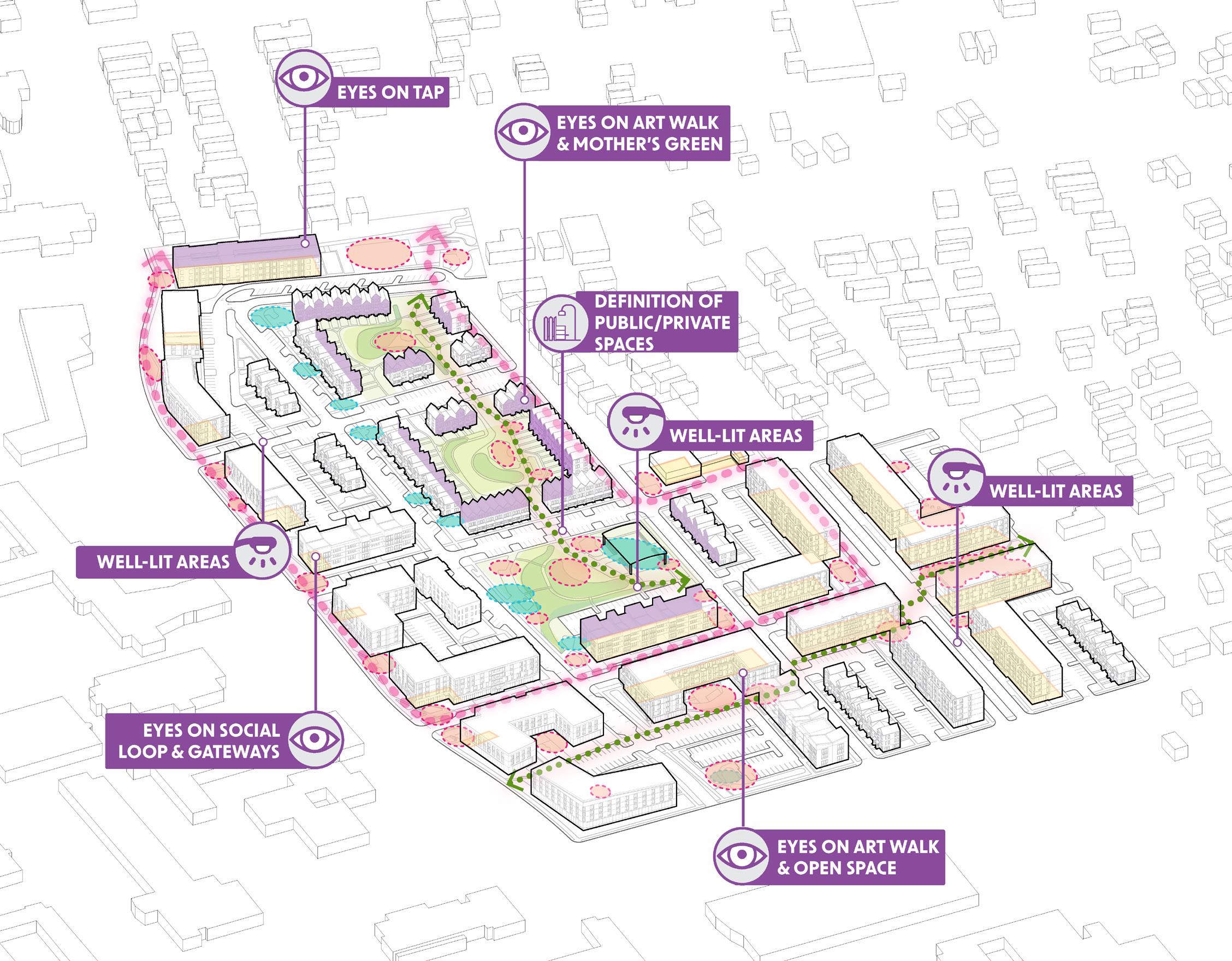
f Goal 4
Strategy A.
Redesign Cuney Homes using CPTED guidelines (natural access control, natural surveillance, activity support, maintenance) to improve safety and have more "eyes on the streets."
The concept of Crime Prevention through Environment Design (CPTED) focuses on the idea of “defensible space.” Neglected areas and those without clear ownership are more susceptible to crime. The redesigned Cuney Homes site will incorporate many CPTED principles that include:
f Placing windows and doors of buildings overlooking streets and trails with clear lines of sight;
f Ensuring all areas are well lit;
f Integrating smaller clusters of units and porches to create highly visible play spaces;
f Using fencing, shrubs, and walkways to clearly define public and private areas, directing visitors in a way that prevents unwanted foot traffic in residential areas
f Carefully maintaining the property to reinforce that the area is cared for and watched.
Strategy B.
Design a walking loop within the redeveloped Cuney Homes that promotes safe walking for leisure and exercise and connects to key amenities.
The site includes an 8-foot wide pathway that will connect open space activities throughout Cuney Homes. Recreation opportunities along the loop will include playgrounds, small outdoor gyms, and mile markers encouraging runners and walkers.
In addition, the path will connect Cuney Homes residents to heritage, nature, and neighbors. Gardens featuring native plantings, edible plants, stormwater management, and pollinators will be located along the loop. Access to a food pantry and outdoor lounge areas will foster mutual aid and connection, while signage spotlighting neighborhood heroes, community histories, and environmental facts along the path will promote community discovery and pride.
Create a community that fosters health, wellness, and safety for all residents and visitors of all ages as well as businesses.
Create a series of activity nodes with seating, art, and amenities along the Columbia Tap Trail and main corridors like Alabama Street, Cleburne Street, and Emancipation Avenue that encourages socializing and walking.
Integrating Cuney Homes with the neighborhood, these activity nodes will promote walkability and foster a vibrant sense of community by encouraging people to pause, gather, and interact. A combination of plazas, public art, seating, greenery, gardens, and play spaces will enhance the pedestrian experience along these key corridors. Activity nodes along each corridor will reflect the desired look, feel, and uses expressed by Cuney Homes and Third Ward residents. Along Alabama Street and Emancipation Avenue, nodes will feature larger plaza spaces with game tables and seating areas for the higher foottraffic of these commercial corridors and integrate murals, sculptures, and mosaics that represent the Third Ward to residents and visitors alike. In contrast, Cleburne Street and the Columbia Tap Trail will feature smaller seating areas and interspersed benches, multigenerational play spaces, pocket parks, and BBQ and picnic areas to complement their intimate neighborhood feel and open space qualities.
Promote healthy living with views and access to nature including seating, meditative, exercise, and play spaces.
The Cuney Homes site incorporates active and passive recreation opportunities in response to residents’ strong desire to promote healthy lifestyles. While all areas will be universally accessible and many will promote multigenerational activity, some amenities will be dedicated to the preferences of children, teens, families, or seniors. CPTED design elements that promote visibility of play spaces, basketball courts, and walking and jogging paths will ensure safety across amenities. Buildings and open spaces will be designed around the distinctive live oak trees that characterize Cuney Homes. Recreation areas will respect and maintain these trees while gleaning the benefits of their shade and beauty.
Incorporate spaces at the redeveloped Cuney Homes for a farm market or community garden and healthy cooking and nutrition classes.
Cuney Homes will feature a farmer’s market style food pantry and forage gardens. The gardens, which can supplement offerings from the pantry, will feature edible plantings including herbs, and fruits. These low maintenance plants will be located near high-use areas to encourage collective maintenance and care. These assets will be connected via the walking loop to ensure that all Cuney Homes residents are able to easily access healthy and local foods, while cooking and nutrition classes offered at the community center or organized by residents promote comfort with new ingredients and ways of preparing food.
“There should be various areas. (…) private places for seniors that need more quiet and calm that are separate from children’s areas to play ball, or listen to music (…) for people that have children.”
Lana Edwards Third Ward resident
Stormwater management strategy on the programmed nodes and pathways in the redeveloped Cuney Homes. In addition to maintaining the oak trees and creating open spaces, the redeveloped Cuney Homes is planned for stormwater management. Each activity node and pathways include strategies such as rain gardens, storage, or roof run-offs that comprehensively create a system.

Mobility strategies in the redeveloped Cuney Homes. Mobility is other of the key components of the redeveloped Cuney Homes. Street strategies to reduce traffic speeds, in addition to safe, visible, marked crossings, ADA accessible pedestrian paths, and a connected network allow for safe mobility throughout the site.

f Goal 5
Strategy A.
Include a range of senior housing options to ensure residents are taken care of and able to age-in-place.
North of Alabama Street, a mix of stacked townhomes and multifamily apartment buildings will comprise a community for seniors within the Cuney Homes site. Much of this senior housing is part of the Cuney site’s non-replacement housing given the strong need for affordable rental housing for seniors earning 30-60% of the Area Median Income in the Third Ward. These units will feature universal design that allows seniors of all accessibility levels to age-in-place as their mobility and caretaking needs evolve. Communal spaces within senior buildings and semi-protected courtyards will facilitate relationship-building that ensures care even for those living alone.
Strategy B.
Include outdoor spaces at the redeveloped Cuney Homes site that promote active living for seniors.
Given the wide range of ages and abilities of Cuney Homes residents, the community highlighted the need to evenly distribute amenities across the site, while catering to the distinct lifestyles of different demographic groups. Nettleton Street, which bisects the senior living community north of Alabama Street and connects it to Cuney’s central gathering spaces, will be a pedestrian street that encourages safe mobility for seniors. With ADA accessible pedestrian paths and easy access to the Cuney Homes walking loop and its diverse amenities, seniors will have a range of opportunities for active living and recreation throughout the Cuney Homes site.

“I would like a section for senior citizens. (…) When you know, you age, you change, your body changes, and you just want peace. That’s what I would like to see.”
Erma Phillips Cuney Homes resident

 Cuney Homes residents playing basketball at the basketball court opening.
Source: IMPAcT13
Cuney Homes residents playing basketball at the basketball court opening.
Source: IMPAcT13
Through the People, Neighborhood, and Housing Plans we outlined the goals and strategies that when implemented, will allow residents of Cuney Homes and the Third Ward to thrive, reconnect, and showcase their culture and love for their neighborhood.
In this section, we illustrate how we applied the Plan's goals to Cuney Homes and Emancipation Avenue redesign and redevelopment, reconnecting the site to the neighborhood, providing accessible housing and programmed spaces for all ages and abilities that respond to community needs, and more importantly, showing the Third Ward and Cuney Homes pride that residents expressed throughout the process through art and cultural spaces.

Street connections in the redeveloped Cuney Homes. To reconnect Cuney Homes with the neighborhood, it is important to enhance the street network. A new street system at Cuney Homes allows for physical connection to the surroundings, safe walking and driving access, and improved mobility access, while allows for implementation of CPTED guidelines.

The reimagined Cuney Homes, a vibrant, culture-based, closed-knitted community.
A lively environment where gathering areas, active trails, and assets welcome community and relationships.


f Preserve the history and culture:
Residents of Cuney Homes and the Third Ward are proud to live here and be an active part of the rich African American culture. Moving forward, residents would like the Third Ward to be known as a thriving center of African American culture; a place where you can expect to find performances, markets, and social events that celebrate the rich heritage. This desire translates to the Cuney Homes design, where flexible outdoor spaces, gathering areas, and programmatic elements are centered around art, culture, and the preservation of the memory of those who have contributed through community advocacy and service.
f Reconnect to the neighborhood:
Residents want a safe, community-centered, walkable, and well-connected neighborhood. Life at Cuney Homes is about community. By reconnecting the street grid to the neighborhood, t he new redevelopment will be more approachable and walkable, creating more foot traffic and generating more street activity that is welcoming the community and extends to the neighborhood.
f Provide a wide range of building typologies:
Residents at Cuney Homes have expressed the non-traditional family units and the wide range of age of its residents. By creating several housing alternatives, the redeveloped Cuney Homes makes sure there is space for everyone.
From multifamily buildings with play areas nearby, to senior-only buildings with dedicated open spaces, townhome clusters with protected courtyards for monoparental families, and livework units that will allow enterpreneurs to launch their own business from home, Cuney Homes will be an attractive place and the place where residents choose to live.
f Design for safety:
Safety is the top concern for residents, and a safer neighborhood would further enhance the sense of community. Three and four story buildings are oriented towards the streets so windows overlook the recreation and walkable areas, open spaces, and parking lots. Entrances to the buildings will be properly lighted and identified, and the site is landscaped to provide a sense of care and reinforcement.
f Provide spaces with active program accessible for people of all ages and abilities:
While most of the residents state that they exercise some times every week, the percent of children and seniors engaging in physical or wellbeing activities is much lower. The redeveloped Cuney Homes provides spaces for all ages and abilities, where the community can gather, organize events, chat, casually play in open spaces, engage in organized sports, walk around, etc. Safe and multigenerational outdoor spaces will ensure the community thrives and is able to connect and help each other.
Residents said... the Plan addresses.
New affordable rental housing and senior housing is needed in the Third Ward...
79% of the residents would like to return to the site when completed. But housing typologies need to speak to the need of the current families on-site...
A significant percentage of households (31%) have specialized needs...
Seniors need a place of their own. A place where they can be in peace and develop their own events and activities...
Safety is the most pressing issue. We need to feel safe letting our children play outside and we need safer areas to have an active lifestyle...
Small businesses and enterpreneurship is of interest. Additional after-school programming is needed...
We need places to exercise; we need places to gather as a community; children need play and active recreation spaces...
A healthier lifestyle will help with health conditions. Spaces at the Cuney Homes do not reflect the need of our community...
What we like the most about the Third Ward is our neighbors, the sense of community, the deep-rooted culture that many before us have built on...
We would like a greener Cuney Homes and Third Ward. We need to be able to face the weather events that happen in Houston...
1,253 affordable new homes and 46 affordable homeownership units will replace the current 553 Cuney Homes homes and will add to the affordable housing market in the Third Ward.
There is a wide range of building typologies that respond to community needs and desires: multifamily, senior-only, live-work units...
At least 10% of all new homes per phase and bedroom mix will be fully ADA accessible.
Senior-only apartments will be located north of Alabama and will be fully accessible. They will have outdoor spaces for seniors to gather and attend events and activities.
Buildings are designed with front entrances facing the streets and programmed spaces, so "eyes on the street" provide an added layer of community safety.
Buildings along Alabama Street and Nettleton Street will incorporate in the groundfloor spaces for local enterpreneurs and flexible spaces for youth and senior engagement, as well as services that the community needs.
Programmed outdoor spaces are some of the features included in the Cuney Homes redevelopment. There will be spaces for all ages and abilities.
A walking loop with amenities and pocket parks will connect the site with Columbia Tap Trail to promote healthy living and wellbeing.
The open spaces and walking loop will incorporate signage and wayfinding areas that reflect the Third Ward and Cuney Homes history and culture, as well as public art from local artists.
The landscape features have been carefully designed to provide green areas and stormwater infrastructure, with native planting that speaks to the Third Ward and Houston.


The Choice Housing Plan is designed to serve current Cuney Homes and Third Ward residents while attracting new renters and homeowners across a broad range of incomes. This is accomplished through a housing plan that is ambitious in nature – 1,299 new housing units; multi-locational – 4 separate sites in the Choice Neighborhood; and fully in keeping with the principles set forth by community members – build first, don’t displace, and prioritize residents’ needs.
The Housing Plan redevelops the 553 unit distressed Cuney Homes superblock public housing site into a reconnected neighborhood that leverages the Third Ward’s greatest assets – Emancipation Park, Emancipation Avenue, Alabama Street, University of Houston, Texas Southern University, the Columbia Tap Trail, and a constellation of local service/advocacy institutions. Demolition and redevelopment of Cuney Homes is justified by the obsolescence of the target housing site which is over 80 years old. While Cuney Homes’ structures will be removed, its stories, memories, heritage and cultural significance will live on in new housing, parks, streets and lives.
Every 553 public housing unit at Cuney Homes will be replaced one-for-one. Replacement units will be distributed on- and off-site and serve both senior and family households. HHA will use Project-Based Vouchers to locate 67 Cuney replacement units in New Hope Housing on Gray Street. Extra attention will be paid to customize the bedroom mix of the Replacement Housing program so as to right-size them to existing Cuney households’ needs and the needs of HHA’s waitlist.
Over 30% of the entire Housing Plan will be dedicated to non-replacement affordable housing – both rental and homeownership, on-site and off-site. It is anticipated that non-replacement affordable rental housing will target households (seniors and family) earning 30-60% of Area Median Income. Housing for this band of low-income households is critically needed in the Third Ward where current housing stock serves two extreme ends of the income ladder. Affordable homeownership units will target a higher income bracket based on City subsidy parameters and requirements of lenders.
As approved by community members, approximately 20% of the Housing program will be set aside for market rate rental units. The demand for these units are evident in the market study, analysis of comparables, and demographic trends. A minority percentage of Market-Rate housing will ensure new investments in the Third Ward without replacing the neighborhood’s culture and people.
 Residents hands on at the community workshop in June 2022.
Source: WrT
Residents hands on at the community workshop in June 2022.
Source: WrT
The redeveloped Cuney Homes is a renewed vision for this historic affordable housing site in the Third Ward; a celebration of the neighborhood's unique history and culture, a place where residents will be proud to live and where they will feel connected to their community.
The site showcases the rich culture, responds to the needs of residents and the context, and emphazises social interaction through positive health and wellbeing spaces and safe pedestrian movement and recreation, while connecting to the surroundings and Third Ward assets.
To reconnect Cuney Homes with the Third Ward, it is important that physical connections are in place. A new street system at Cuney Homes allows for ease of mobility to the surroundings, and streetscapes have a unique character that improves different types of mobility throughout the site.
Connections to the neighborhood are reinforced through Alabama Street and Cleburne Avenue. Alabama Street is the major throughfare, presenting a revitalized gateway to the Third Ward and becoming the main entry point to Cuney Homes. Framed by mixed-use development with ground floor amenities and business spaces that bring amenities and resources closer to residents while activating the corridor, Alabama Street is a welcoming entrance to the community lined up with trees and a public plaza that opens up to Cuney Homes.
Cleburne Avenue recent upgrades to Complete Street enhances walkability and safety by strengthening connections to transit stops and bike paths, connecting east-west to other transit resources like the light rail and assets like Texas Southern University and University of Houston. The redevelopment allows for a major trailhead into the Columbia Tap Trail, inviting Cuney Homes and neighborhood residents into this historic Third Ward asset.
Nettleton Street and Burkett Street are the main northsouth connections into Cuney Homes. Burkett Street emphasizes community relations and responds to Third Ward typologhies through the design of the streetscape, which include rain gardens for access to natural areas that also serve for stormwater management, and lower density with shotgunstyle houses with porches that front the street. The grove of trees that will run down along the street will enhance visibility and entrance into Cuney Homes. Nettleton Street is the community boulevard, with wider sidewalks and setbacks to accommodate a walking loop that will run through Cuney, Nettleton, and Truxillo Streets and will be framed by community amenities on the ground floor and opportunities for social interaction and enrichment.
Cuney Street and Truxillo Street are the Cuney Homes connections that wove all together. These streets are lined up by the walking loop, designed to create community interactions and to access the major recreation areas of the site - the main open space central to the community, and the trailhead connections to the Columbia Tap Trail on the west of the site.
Street bumpouts and plantings along the edge can make crossings a safer environment while contributing to the beautification of the area.
Complete Streets provide a safer walking and biking environment while managing stormwater and greening the streetscape.

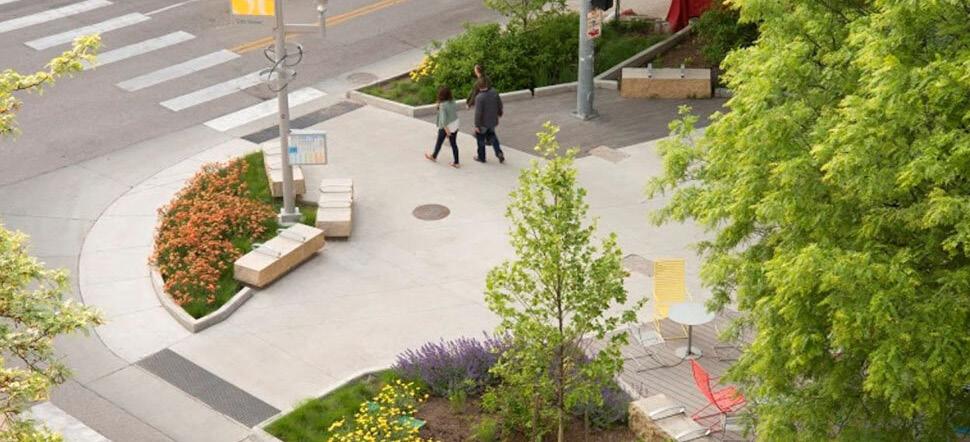

Fostering a sense of safety and community connection is one of the Cuney Homes residents priorities. The redeveloped Cuney Homes pays close attention to the orientation and proximity of the housing units to the open spaces and circulation routes to ensure the creation of defensible spaces and "eyes on the street" throughout the site. Smaller, programmed open spaces are distributed along the main streets with clear views so they do not feel unsafe or isolated.
Throughout the site, there are a number of pedestrian paths that can be used internally for residents to get to different points of Cuney Homes. These paths will connect assets and amenities on-site while providing a safer route for people of all ages and hosting spaces to relax, play, or gather.
To tie the design of the site and respond to residents' needs, the redeveloped Cuney Homes integrates a variety of housing typologies. Multifamily buildings in major throughfares define a more prominent street edge and host ground-floor amenities. Windows
overlooking the street, open spaces, and parking provide a greater feeling of safety. Responding to residents' feedback, these buildings provide a contemporary twist in materials but still incorporates traditional features that respond to the Third Ward typologies like balconies and local art in the facades.
The redeveloped Cuney Homes also integrates a variety of townhomes that respond to the traditional shotgun style houses seen in the Third Ward, with features like gabled roofs and front porches that promote community interaction, and design and materials that create a unified vision with the Third Ward style.
Live-work units allow residents to become enterpreneurs and start their own business. This typology immediatly responds to what we've heard, and builds on the need of affordable business spaces in the Third Ward. Units incorporate a work space, and have access to outdoor display and makers area.
Through the extensive resident and community engagement process, we have prioritized topics that are most important to residents to guide the open space design of the redeveloped Cuney Homes.
Third Ward's public space is important to the history of Black Houstonians with Emancipation Park setting the tone as foundational space representing the collective work for freedom. In addition to this, the small everyday outdoor spaces are just as important, whether its an small entry plaza with gathering space to one of the neighborhood's politically active churches, or garden yards that welcome neighbors in contrast to insular developments that signify gentrification.
This Plan builds on this context and legacy of care for the neighborhood and what it represents to its longterm residents.

The redeveloped Cuney Homesoffers the opportunity to foster connections by organizing activities along different themed walking routes:
f The Walking Loop: connecting Cuney Homes to Columbia Tap Trail. A central feature of the redeveloped Cuney Homes is its socially active loop. This walking path weaves through and connects the different zones of the site. Beginning at the Columbia Tap Trail to further incorporate it into the neighborhood for greater safety and use, the walking loop connects the lower density residential area to the mixed-use areas along Nettleton Street and Cleburne Street.
This walking loop is characterized by its pollinator gardens, which attract monarchs, swallowtails, and queen butterflies as well as different types of bees and hummingbirds. The presence of these creatures may enliven the many lounges, or areas to sit and reflect publicly. Lastly, the Walking Loop, with its wide 8' minimum sidewalks, enable residents to enjoy gatherings that move around and utilize the entire site.
f Athlete's Walk: areas to stretch and exercise. This linear walk is also wide with social lounges on both sides to foster connections similar to the walking loop. However, this walk will feature an area for pull-up bars and basic body weight exercises in Cuney Home's central open space. Lastly, this walk also connects the central open space to the ground floor amenities in Nettleton Street as well as the maker's plazas adjacent to the site's live-work homes.
f Arts and Heritage Walk: opportunities for artists and community voices to shine. Cuney Homes and Third Ward residents are proud to live here and be an active part of the rich African American culture that has made the neighborhood famous. These two walks center these themes and provide opportunities for ongoing discussions of the neighborhood's legacy and future.
These walks are located within the central backyards of shotgun-style townhomes on blocks G and F. Following the model of Project Row Houses, this collective backyard space termed Mother's Green provides families with a place to play and explore immediately outside their doorsteps. This walk connects to the townhome developments before heading into Cuney Homes central open space. A feature of these smaller, more intimate walks are the opportunities to express community history and art along its pathway or within the sitting areas associated with it through signage, art, sculptures... The intimacy of these spaces combined with the shared art and history should provide a uniquely Third Ward experience.
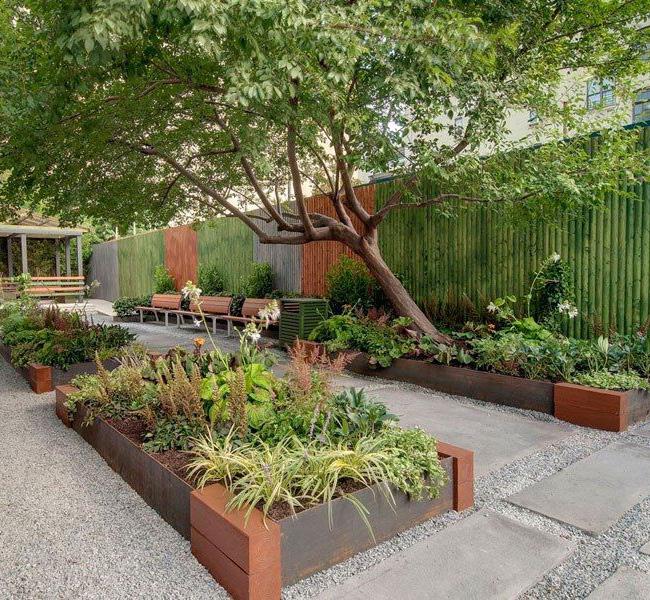
Stormwater management cannot only help with flooding but also make the street feel greener and taken care of.
Planting and greenery provide cooler environments for areas with heat issues.

The proposed neighborhood site plan also offers tailored public spaces for residents and visitors in need of different types of activities:

f Mother's Green: building on the legacy of Project Row Houses. Residents of Cuney Homes and the Third Ward are proud to live here. That pride is the result of collective actions to address local needs of residents and to stay within the Third Ward despite gentrification presures. An example of this has been the Project Row Houses, which have provided single mothers a place for themselves and their children. Building on this model, the Mother's Green is the collective 'backyard' for residents of the townhouses. Families with young children will appreciate the capacity to allow their children to play and explore two small parks characterized by a rain garden swale and a small mound to provide an elevated play area for greater visibility and safety. With this collective backyard, there are also opportunities to instill pride with arts installations geared towards educating youth about community history or the natural environment of the small parks themselves.
f Maker's Plaza & Columbia Tap Trail: eyes on the trail and customers for entrepreneurs. A live-work building is planned facing Columbia Tap Trail to provide opportunities for entrepreneurs to sell their wares. In doing so, the increased foot traffic along the trail will help ensure its safety.
f Central open space: building on the legacy of Cuney Homes. Currently, the heart and center of Cuney Homes features a well-loved covered basketball court as well as a play area and flexible lawn. The Cuney Homes central open space maintains this use. The Plan is able to utilize the large mature trees that are currently there for picnic grove and other programming where shade is desired. The central open space is further supported by a community room at the ground floor of the adjacent multifamily building, and the green plaza at the corner of Truxillo Street and Burkett Street.
f Gateway plazas: traffic calmed entries into Cuney Homes. Both Nettleton Street and the new street provide opportunities to provide a pleasant doormat to visitors and residents into the neighborhood. These plazas allow for vehicular traffic to enter the site while prioritizing pedestrians with paving to signal a special place, and lounge areas that are at-grade with the street to further calm traffic and enhance social interaction.
f Heritage & forage planting within the Arts and Heritage Walkand the Athlete's Walk. Featured planting selections that are aromatic to the touch, or invite pedestrians to pause is the goal of this planting type. Providing connection to nature with the availability of edible herbaceous and aromatic plants can reinforce open space areas featuring murals showcasing Third Ward history, or frame community gardens associated with a food pantry.
f Pollinator Planting and the Walking Loop. These planted areas will feature selections that attract pollinators to the neighborhood. Pollinators are species that helpe to fertilize flowering plants (hummingbirds, honey bees, butterflies, etc.) and by attracting those, the small fruiting plants further attract birds. Through this planting strategy, this garden type can support those seeking to utilize the observation of nature for their mental health.
f Stormwater planting and comfortable sidewalks. A warm and wet climate such as Houston's is friendly to year-round growing and was a contributing factor to the settlement history of the region and has been a source of pride for garden clubs across the city.

Artistic expression that depicts the history and culture of the Third Ward can be incorporated throughout the site and within its open space.
Connections to Columbia Tap Trail and trailheads include a variety of planting that will activate the wildlife at Cuney Homes and seating and resting areas will allow residents to contemplate it.


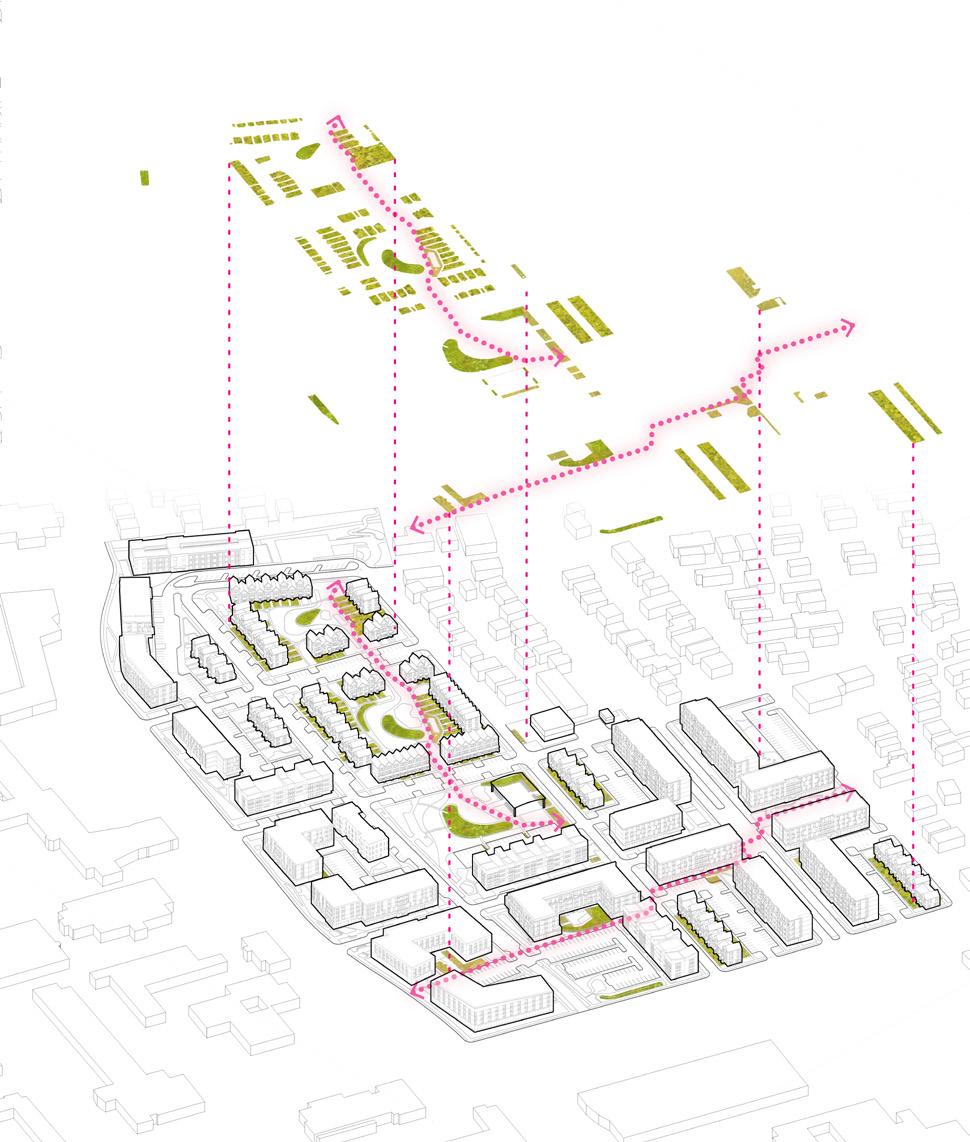
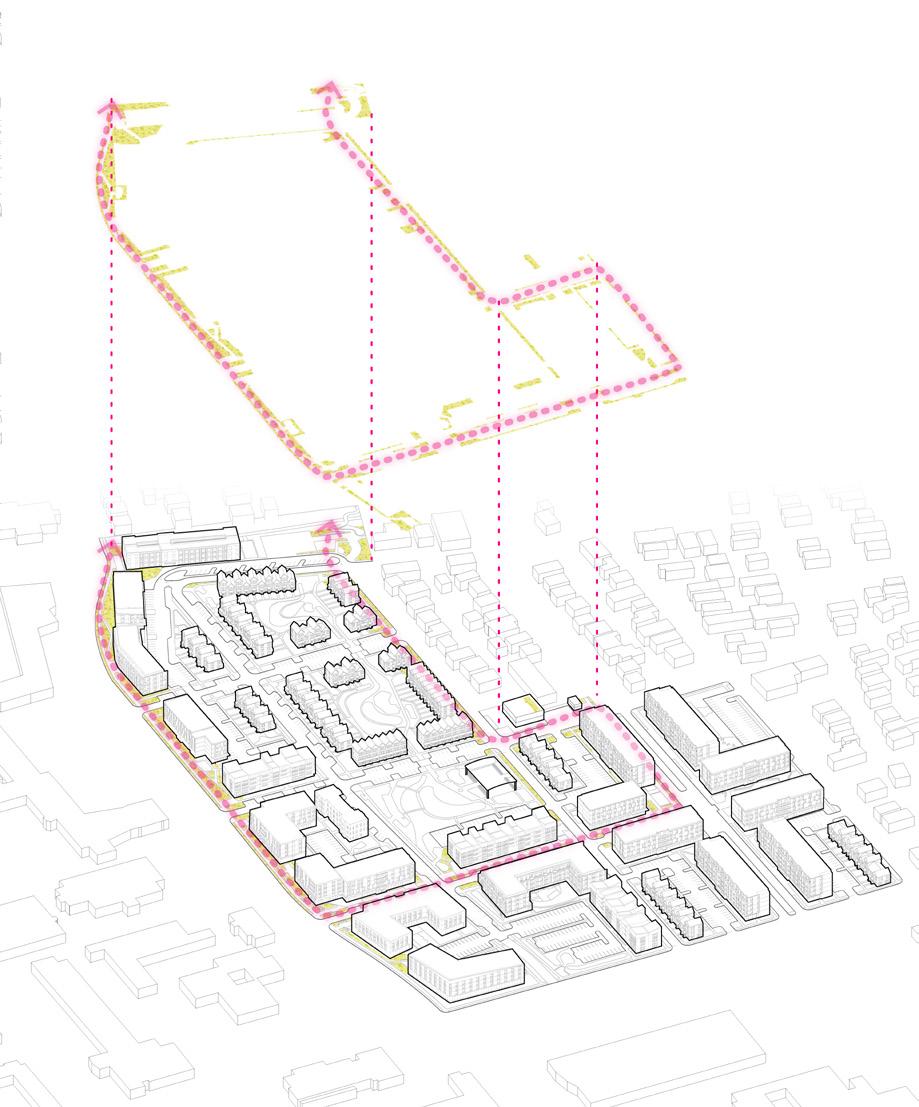
A planting palette, or a curated list of plants selected for a design, can reinforce goals for the overall experience and health of a neighborhood. To do this, planting selections must first consider the demanding Houston climate and its future of weather extremes. Of equal importance is the relationship planted areas have to site functions and local culture. Lastly, plants may be selected to serve multiple functions and in different growing conditions. The capacity for durability and beauty helps to maintain connections between residents in open space, and with the land and nature itself.

Selected species were identified by the Texas Parks & Wildlife Department, the Garden Club of Houston, the Ladybird Johnson Botanical Garden and the Native Plant Society of Texas, Houston.
f Neighborhood trees. The foundation of useful planting palettes begins with the selection of trees. Trees with their dense or dappled shade can change the environment and growing conditions for the plants cast in its shadow. The function, look, and growing conditions of a grouping of trees can help guide the design for understory planting, and even the materials of a paved area where heat is a concern. Trees for this Plan have been selected to manage stormwater, reduce heat, and provide yearround visual interest.
Mature healthy trees exist throughout the current Cuney Homes, an asset to pull into the next generatiion and to support landscape programming
H: S: Note: Roots treat polluted rain water
Shumard Oak Quercus shumardii
H: S: Note: Fast grower, two feet per year
Texas WIld Olive Cordia boissieri


H: S: Note: Popular for Houston Streets, Shade

Loblolly Pine Pinus taeda

H: S: Note: Sub-tropical pine, evergreen

Red Buckeye Aesculus pavia



H: S: Note: Fast grower, two feet per year
Parsley Leaf Hawthorn Crataegus marshallii
H: S: Note: Ornamental, berries attract birds
H: S: Note: Edible flowers, Spring pollinator Sassafras Sassafras albidum
H: S: Note: Regional history, Swallowtail butterfly

On-site housing: Cuney Homes.
The redeveloped Cuney Homes comprises 821 new rental homes distributed throughout the site on several building typologies. While north of Alabama Street hosts senior-only buildings, the rest of the developments along the corridor incorporate ground floor areas where local Black-owned businesses and services can settle. A strong sense of cultural pride is built through art and signage, announcing visitors the front door to Cuney Homes.
Nettleton Street is reconnected to the neighborhood grid to bring a main street, where resident services can be found on the ground floor. A wider streetscape is designed to incorporate part of the walking loop where active and passive recreation areas are woven in acting as throughfares between the public front streets and the private backyards.
Cleburne Avenue is lined up by the south Columbia Tap Trail trail head that incorporates historic markers and wayfinding elements. Taking the advantage of the Complete Street, it incorporates the southern leg of the walking loop with outdoor spaces that are welcoming and inviting of community.
Along Columbia Tap Trail, there are live-work units that have been of interest to the residents, since they will be able to start their business from home. The development has a marked and protected frontage to the Columbia Tap Trail, and it will be proceeded with on-brand open spaces like a Maker's Plaza where they can create events and attract visitors.
On the west of the site, residents can find development of shotgun-style rowhouses that respond to neighborhood typologies. This typology incorporates large protected backyards where children and families can play, interact, and experience outdoor spaces together.
The Cuney Homes site incorporates many programmed open spaces that are woven in the fabric of the development. They respond to the typologies and the community living in them. Together they form a network of lively, active, colorful, resilient gathering spaces where residents can join together to be part of the Cuney Homes community.
The redeveloped Cuney Homes includes 46 new affordable homeownership units located in Cuney Street and the new street.
Off-site housing: Emancipation Avenue. North of Emancipation Park, Emancipation East and Emancipation West show as opportunities to start bringing to life this historic economic corridor and fill it in with opportunities.
Emancipation East and West comprises a total of 297 untis on two multifamily buildings. The architectural articulations allow for Emancipation Park views to the south and downtown to the north, bringing together two icons that we've heard the residents talk about. The ground floor welcomes visitors through a semiporched plaza, a space to welcome all visitors and residents and that is tinted with cultural signage and lively plantings. The the frontage hosts community spaces for residents and affordable commercial spaces for small Black-owned businesses, to continue the tradition of Emancipation Avenue and respond to the need of affordable makers spaces.
Off-site housing: New Hope.
New Hope Housing in partnership with Midtown Redevelopment Authority are bringing affordable housing with wrap-around services for seniors to the historic Third Ward. Thanks to a partnership with Houston Housing Authority, the Housing Plan is able to incorporate new homes to the total of affordable units. In addition to housing, the development incorporates a preschool space and playground, a main courtyard, and indoor amenity spaces.
On-Site: 821 Mixed-Income
Rental Homes, 46 Affordable Homeownership Units
Off-Site (Emancipation West and East): 297 MixedIncome Rental Homes;
Off-Site (New Hope Housing Gray) : 135 MixedIncome Rental Homes
Choice Neighborhood
Cuney Homes Site and Off-Sites
Neighborhood Corridor
Major Highway
Trail Park
Waterbody
Resources & Supportive Services
Community Assets
Education & Child Services
Place of Worship
Housing investment areas in the Choice Neighborhood.
This map shows the areas where housing investments will happen in the Third Ward through Choice Neighborhoods. By investing in different areas, these developments will contribute to stabilizing affordable housing in the neighborhood and will allow residents to have a choice to live in the Third Ward.

The redeveloped Cuney Homes. The redeveloped Cuney Homes comprises 821 homes with ground floor space for services and local businesses, live-work homes for enterpreneurs, and large open space with gathering areas for the community. In addition, 46 affordable homeownership units will be developed on blocks F, G, K, and L. vThe intergenerational programmed open spaces and the CPTED guidelines in the design will ensure Cuney Homes will be a place where residents can thrive and improve their physical and mental health, continue creating community, and have safe and convenient access to services.

 Cuney Kickback on August 2023
Source: HHA
Cuney Kickback on August 2023
Source: HHA
We have heard that residents would like to access affordable homeownership homes in the neighborhood for them and their families. While the Third Ward provides a broad set of assets within its footprint, the rise in home values also brings the threat of displacement, causing long-term homeowners and residents to move out of the neighborhood as the Third Ward has experienced in the last decade.
It is important to find opportunities that meet the needs of existing, returning, and future residents. Efforts to increase the variety of affordable homes catered to the communities' need and neighborhood character will not only strengthen the housing market but will provide many stabilizing benefits to the neighborhood while combating displacement.
The redeveloped Cuney Homes includes 46 new affordable homeownership units located in Cuney Street and the new street that will promote and help build pathways to homeownership opportunities for Cuney Homes and other neighrbohood residents. These on-site and off-site new affordable replacement homes and affordable homeownership homes will enhance the quality of life of residents and their families.
These homes will not only contribute to a healthier housing stock within the Third Ward, but will help preserving affordability and addressing quality of life issues. These new 46 affordable homeownership units will also contribute to develop a model that helps build generational wealth and equity for Cuney Homes residents and other future communtiy members, and that can be replicated in many distressed and vacant areas in the Third Ward.
There are possibilities for expanding the affordable homeownership program to other areas of the neighborhood in the long-term, contributing to distressed target areas in the Third Ward and building a culture of community and neighborhood-friendly housing stock.

f Summary of detailed program
THE HISTROIC ST JOHN MISSIONARY BAPTIST CHURCH
Emancipation East and West development.
Emancipation East and West comprises 297 multifamily homes in the heart of the Third Ward with affordable spaces for local entrepreneurs on the ground floor following the history of Emancipation Avenue - once a thriving economic corridor filled with businesses and services that were part of the cultural makeup of the Third Ward. Residents are in close access to Emancipation Park and Third Ward established businesses and services, in addition to transit and Houston downtown.

f Summary of detailed program
New Hope Housing
Source: NeW HoPe HouSING AND HouSToN AreA cDc; GSMA
This partnership made possible thanks to New Hope Housing and Houston Area CDC with Houston Housing Authority provides 67 replacement units to Cuney Homes residents.
Emancipation Avenue, the heart of the Third Ward. A lively street where you can find historic places, local art, thriving businesses, and active and passive recreation spaces.

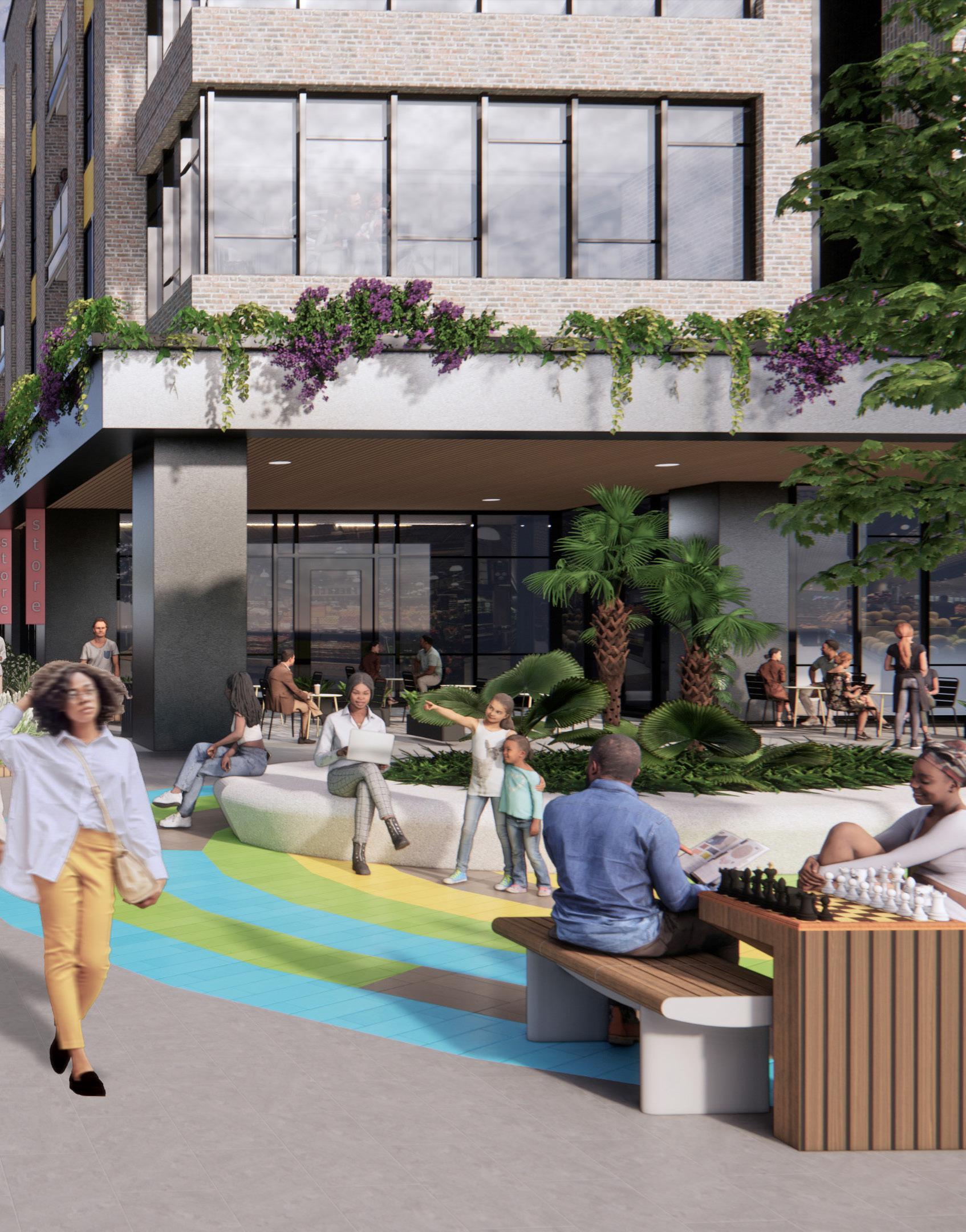
The Housing Plan is anticipated to take place in five phases over the course of 8-10 years.
The phasing will be as follows:
f Phase 1 - New Hope Housing; off-site.
f Phase 2 - Emancipation East and West; off-site.
f Phase 3 - Cuney Homes, Alabama Street; on-site.
f Phase 4 - Cuney Homes, Nettleton Street; on-site.
f Phase 5 - Cuney Homes, Cuney Drive; on-site.
The development of the new homes will happen in phases depicted above to minimize the displacement of current Cuney Homes residents. The units will be right-sized, and the Choice program will provide one-for-one replacement for the existing housing units. The future on-site and off-site housing will include at a minimum 10% of every bedroom type in every phase to be fully ADA-accessible.
The first phase will entail the development of New Hope Housing, where HHA has allocated 67 Project-Based Vouchers; the second phase will focus on the development of Emancipation East and West, with a total of 297 new homes.
This off-site, "build-first approach" construction provides for minimal disruption on residents' everyday life during the early phases of the development.
This strategy allows for the Choice Plan to reach its goals of non-displacement and only-move once strategy. The 157 residents having to relocate from Phase 3 for its development are ensured a total 432 new homes in Phase 1 and Phase 2, allowing them to access their new home.
To encourage return and age-in-place in the third Ward, Phase 1 and Phase 2 will incorporate a range of residential typologies (senior living, multi-family, and mixed-use) and bedroom mix for all community needs that invites Cuney Homes residents to continue their community relationships and ties at the very front of the development process while providing
safe, welcoming, new affordable housing at the heart of the Third Ward and in walking distance from Emancipation Park and other neighborhood assets such Eldorado Ballroom.
Phase 3, Phase 4, and Phase 5 will take place at the Cuney Homes site. Phase 5 will include 46 affordable homeownership units.
Phase 3 will be developed following the construction of Phase 1 and Phase 2 and the relocation of current residents in the footprint. The 188 residents having to relocate from Phase 4 for its development are ensured a total of 350 homes in Phase 3, allowing them to access their new home. Phase 3 will count with a range of mixed-use buildings and townhomes in the heart of Alabama Street where residents can choose to come and live.
Phase 4 will be developed following the construction of Phase 3 and the relocation of current residents in the footprint. The 208 residents having to relocate from Phase 5 for its development are ensured a total of 283 homes in Phase 4, allowing them to only move once to access their new home. Phase 4 will count with a range of mixed-use buildings and garden apartments in the heart of Cuney Home, where residents can enjoy new assets such as the walking loop and the new Cuney Homes park in close proximity to their homes.
Phase 5 will be developed following the construction of Phase 4. It will count with 188 new affordable homes and 46 new affordable homeownership units where residents can choose to relocate if desired. Phase 5 will count with a range of multi-family buildings, stacked townhomes, and live-work units, and affordable homeownership units in close proximity to Columbia Tap Trail and the new walking loop, as well as other planned areas as the Mother's Green.
This map shows the areas where housing development will happen in the Third Ward through on-site and off-site development and the relocation process. The relocation will follow a build-first strategy to avoid displacement of current residents and achieve a onlymove-once process.
f Phase and unit summary

Phase 1 will happen off-site at New Hope Housing; this off-site, "build-first approach" construction provides for minimal disruption on residents' everyday life during the early phases of the development.

Phase 2 will happen off-site at Emancipation East and West; this off-site, "buildfirst approach" construction provides for minimal disruption on residents' everyday life during the early phases of the development.

Phase 3
Phase 3 will happen on-site around Alabama Street. Residents will be relocated to previous, already built phases.


Phase 4
Phase 4 will happen onsite around Nettleton Street. Residents will be relocated to previous, already built phases.
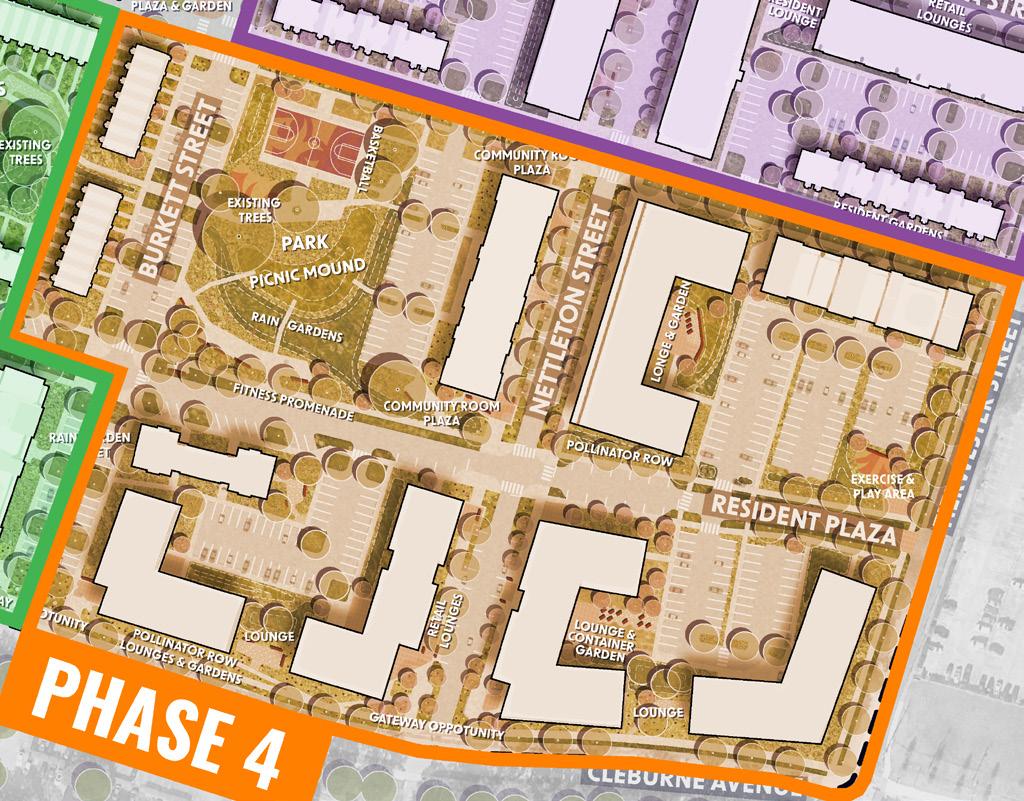


Phase 5
Phase 5 will happen on-site around Cuney Drive. The project would be complete.




Phasing of the Housing Plan

A conceptual financing plan for the Housing Plan envisions 5 overlapping 4% Low-Income Housing Tax Credit deals subsidized significantly with local dollars while fully leveraging approximately $30 million of HUD Choice Implementation funds.
The Housing sources and uses tables below assumes a conservative average per unit construction cost of $244,788. This cost only includes housing and surface parking construction, and does not account for infrastructure and public realm development – which are substantial on-site. Affordable homeownership is financed separately and un-sequenced with rental housing development.
Plan Celebration event on September 2023.
Source: WrT

The Houston Housing Authority and our Choice Neighborhood partners are committed to a deeply intentional relocation strategy with the following goals:
f Minimize disruption to the affected households.
f Equip residents with the necessary tools to enable them to make a well-informed choice of housing options.
f Clearly communicate rights, benefits and responsibilities of all parties.
f Efficiently utilize and coordinate all available resources.
f Follow all applicable statutes and regulations at the federal, state, and local levels.
To minimize disruption, the housing plan has been designed to develop two off-site phases prior to commencement of demolition and redevelopment on the Cuney site. This approach will create replacement housing units so that the first residents to be relocated will have the option of only one move to a permanent replacement housing unit.
The relocation strategy is dedicated to a choicebased relocation approach that establishes ongoing and frequent communications with all residents and allows families to select the type and location of their relocation housing. This communication began with the development of this transformation plan and will continue until each family has exercised their right of return.
Redevelopment on the Cuney site will only commence once residents have been provided with alternate housing options of their choice, including housing within HHA’s real estate portfolio comprised of newly
developed tax credit and project-based voucher properties; other public housing communities; or housing in the wider Houston housing market using a tenant-based voucher.
HHA and the Housing Team will work closely with Cuney Homes and Third Ward residents as well as other community stakeholders to develop the final detailed Relocation and Transition Plan. This plan will detail the following relocation services and benefits that will be provided to all residents.
f Assessment of family relocation needs and preferences.
f Relocation advisory services and case management during the relocation process.
f Required advanced notice of the relocation.
f Written notices describing rights to relocation benefits and services.
f Housing search assistance including transportation.
f A temporary relocation housing unit that is decent, safe and sanitary (DS&S) appropriate to the family needs.
f Payment assistance for utility reconnection fees, rental application fees and security deposits.
f Packing and moving assistance for all moves, temporary and permanent.
f Guaranteed right of return to a permanent housing unit post redevelopment.
f Rental Housing Assistance Payments if electing voluntary permanent relocation.
f Right to appeal decisions made within the relocation program that affect them.
All relocation activities associated with the Third Ward Cuney Homes redevelopment will be governed by the following regulations.
f The Uniform Relocation Assistance and Real Property Acquisition Policies Act of 1970 (the “Uniform Act” or “URA”), as amended, and its implementing regulations at 49CFR, Part 24.
f HUD Handbook 1378, (Implementing Guidelines of the URA), as amended.
f 24 CFR Part 970, Public Housing Program – Demolition or Disposition of Public Housing; 24 CFR Part 970.12 –Relocation of Residents.
f PIH 2016-17, Rental Assistance Demonstration (RAD) Notice Regarding Fair Housing and Civil Rights Requirements and Relocation Requirements Applicable to RAD First Component, Public Housing Conversions;
f PIH 2019-23 Rental Assistance Demonstration Program (RAD) Final Implementation REV4; and,
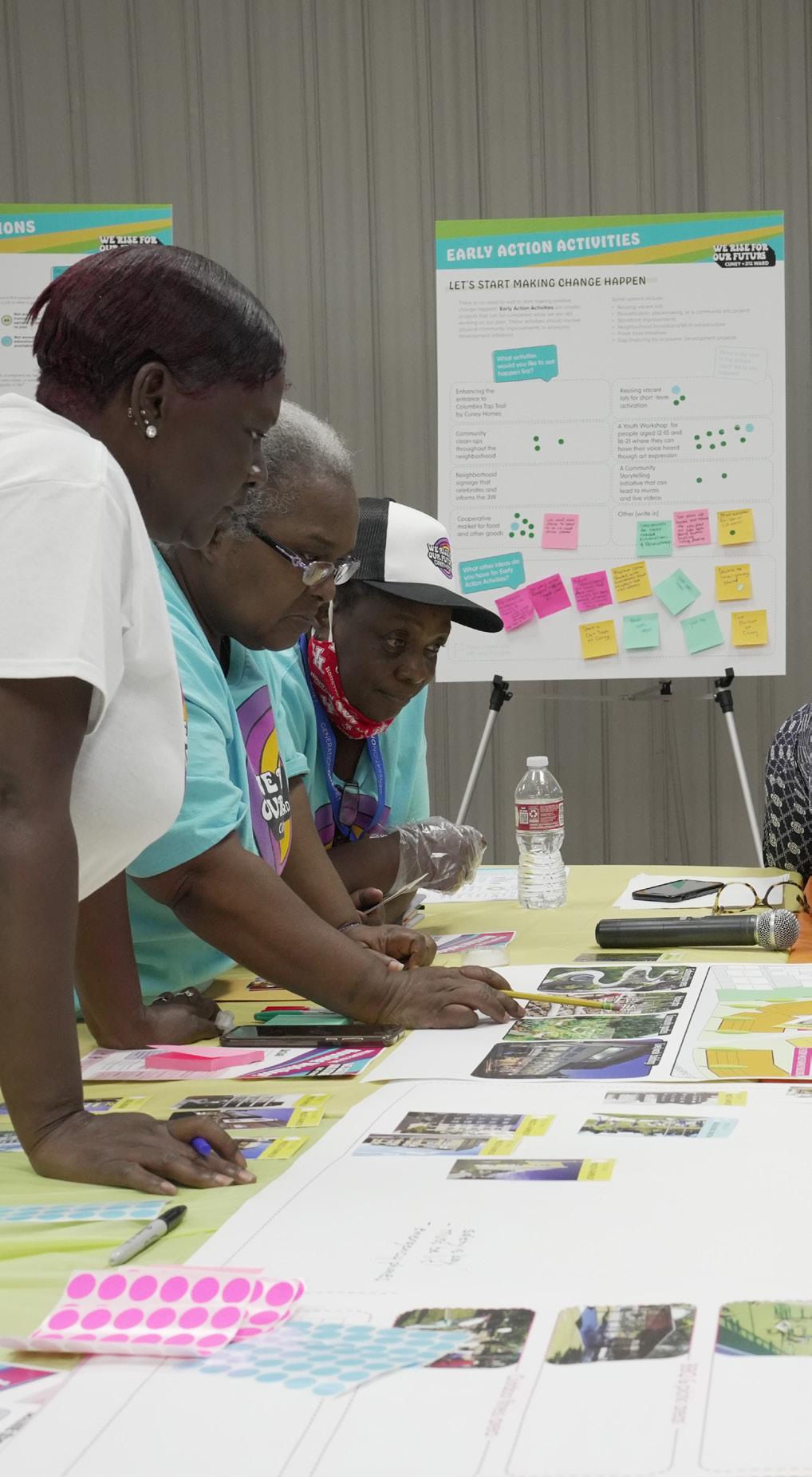
f PIH 2023-19, RAD Supplemental Notice 4B.
Residents who are relocated under temporary, extended temporary or voluntary permanent relocation, as a result of the redevelopment shall be relocated to other decent, safe, sanitary and affordable housing (at rents no higher than permitted under the Act) on a non-discriminatory basis without regard to race, color, religion, creed, national origin, handicap, age, familial status, sex, sexual preference, sexual orientation or gender identity and in compliance with Federal, State and Local laws.
The Choice Neighborhood Housing Plan has been developed based on the guaranteed right to return for all residents. The Housing Plan calls for 1299 total housing units to be developed in five phases, of which 553 are replacement housing units. Each phase includes a mix of incomes to assure that all Cuney residents, regardless of income, have access to a permanent replacement unit.
Cuney Homes residents who occupy a unit under a valid lease on the date the Choice Neighborhood Implementation grant is awarded will be provided first opportunity to return to a replacement unit if the resident is lease-compliant and remains leasecompliant during the relocation period. A Cuney Home returning resident will be provided the highest-level preference for a replacement unit (on-site or off-site) before units are made available to other eligible households.
Cuney Homes residents who may have initially elected voluntary permanent relocation to alternate housing options may subsequently exercise their right to return to a replacement unit at the time of initial lease up of the replacement units. Once all original Cuney households have been offered their guaranteed right to return and all replacement units have been leased, Cuney residents will no longer retain a preference for the replacement units.
The Relocation and Transition Plan will be designed to minimize the hardships of relocation and to ensure that each resident moving due to redevelopment activity is provided with the full measure of assistance for which the resident is eligible. The plan will require relocation process and procedures that will ensure extensive and ongoing communication with residents and guarantee the provision of physical, financial, and case management support for all households before, during and after their relocation.
HHA will have early and regular meetings with the residents impacted by the relocation to discuss relocation plans, timelines, resident’s rights and benefits, and relocation housing options.
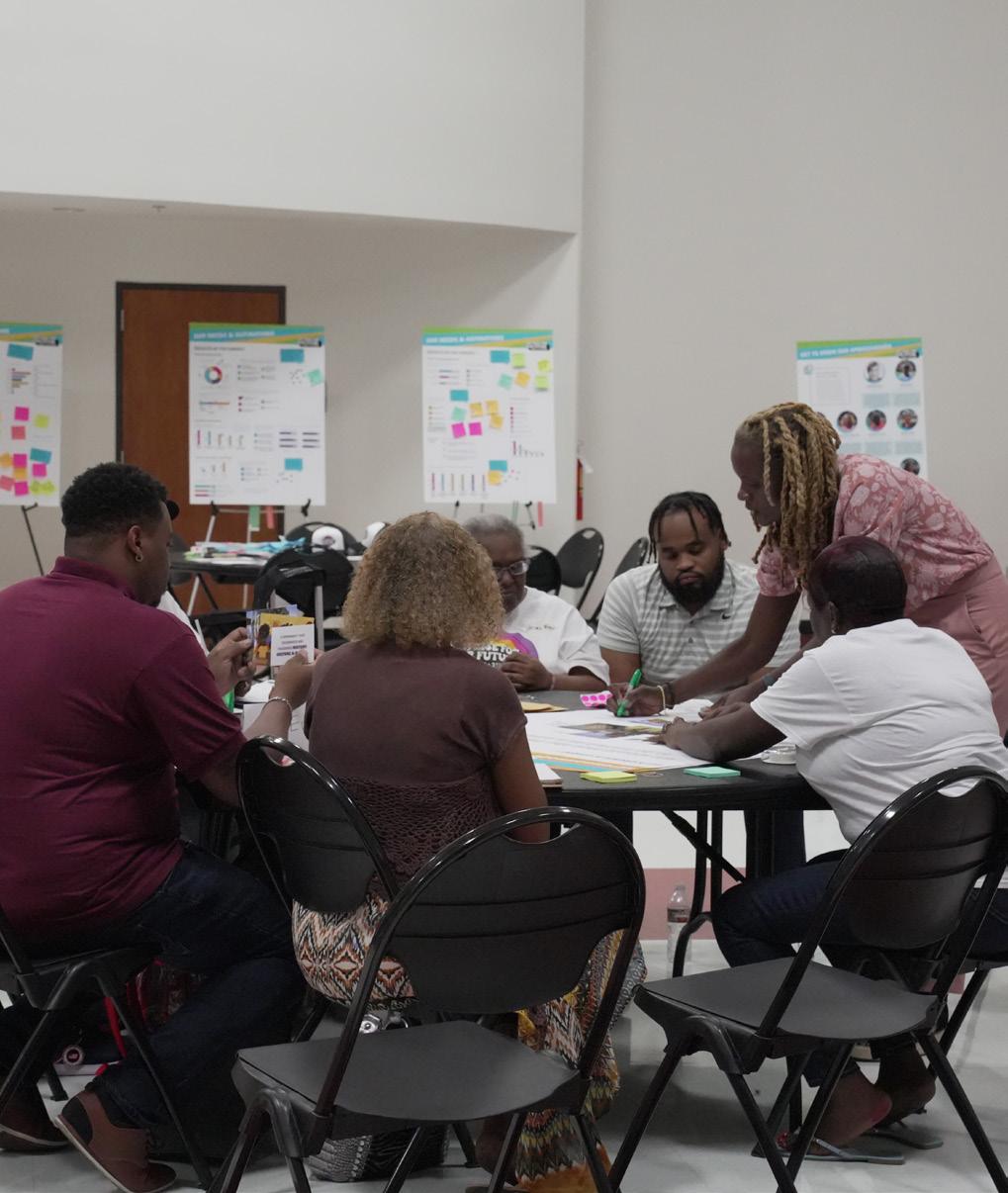
Household data will be analyzed by HHA and updated on an ongoing basis to ascertain basic household information such as the number, ages and sex of household members to determine unit size and income levels to determine eligibility for certain housing programs or unit types.
Prior to implementation of relocation, individual needs assessment shall be completed for each affected household to determine their unique relocation and/or special need including those related to physical, mental and emotional impairment, medical requirements, and transportation, A detailed assessment form will be completed for each household and will serve as the basis to develop the individual household relocation plan.
All relocation documents will be made available in the primary language of the household as needed and interpretations services will be provided to ensure meaningful access and understanding for LEP persons.
The relocation strategy is premised on choice-based relocation that establishes ongoing and frequent communications with all residents. This communication began with the development of this transformation plan and will continue until each family has exercised their right of return.
A multitude of communication methods will be used to assure that residents remain fully informed at all time throughout the relocation process. A monthly newsletter and quarterly resident meetings will serve as the framework for keeping residents informed. In addition, each household will have an assigned Relocation Specialist and Case Manager.
A tracking software system will be utilized to track all residents throughout the redevelopment process to assure that all communications as well as required formal URA notices are documented and available for easy reference to assist the family. Relocation and Case Managers will share this tracking system to assure coordination of all family support services.
The guaranteed right of return is premised on resident lease compliance throughout the entire redevelopment and relocation period. To support this effort, case management will prioritize stabilizing residents who are at risk of eviction. Case management will be a highly intensive approach to assisting residents with accessing services for eviction prevention. Working with households to keep them lease-compliant and ensure their right to return will be a priority. Case managers will work with relocation staff and the Transformation Plan network of Partners to develop mitigation strategies and an eviction support network so residents maintain their right to return. HHA will put in place an early warning system to detect those at risk of falling out of good standing and to provide support to stay lease compliant before, during, and after relocation.
Relocation counseling will be provided to all households prior to and during the relocation process and for one-year post-relocation. HHA Relocation Specialist and Case Managers will work together so that families fully understand the relocation process and are ready to move when needed. Staff will schedule individual meetings with each household to provide an overview of the relocation process, relocation benefits and advisory assistance available. Relocation staff will also inform residents of their Right to Return and the requirements of lease-compliance and re-occupancy. They will also describe the resident’s rights to permanent relocation using voucher assistance or other housing options.
Relocation advisory services will also include detailed information on the following:
f Expected temporary or extended temporary relocation time period.
f Types and location (on-site/off-site) of temporary relocation housing units.
f Option, at the sole choice of the resident, to reside with family or friends during a temporary relocation period.
f Storage options, as applicable.
f Moving assistance available including assistance with packing and unpacking.
f Responsibilities of the tenant during the temporary relocation period including requirements to continue to pay applicable tenant rent.
f All rights of the tenant including the guaranteed right to return to the property upon completion of construction.
The Houston Housing Authority will be available to assist residents with questions about relocation and/ or assistance in relocating. Close personal contact shall be maintained with each Household. Services and benefits to be provided by HHA as part of the relocation process are identified below.
The redevelopment of Cuney Homes will include the demolition and new construction of replacement housing units both on-site and off-site. No tenant will be permanently displaced; however, all tenants will have to relocate to allow for demolition and redevelopment of the Cuney site. Tenants who choose or are required to move prior to the availability of permanent replacement unit shall be classified as temporary relocation.
If it is necessary for a tenant to be temporarily relocated for more than one year, the tenant will be given the opportunity to choose to remain temporarily relocated for an agreed upon time period based on an estimated timeline when a permanent replacement unit will become available, or may choose voluntary permanent relocation.
All residents have a guaranteed right of return to a permanent replacement unit. If a resident must be temporarily relocated due to construction beyond 12 months, and chooses voluntary permanent relocation, HHA will secure informed, written consent from the resident of their understanding of the permanent relocation assistance and payments to be provided.
HHA will offer residents various temporary housing options including housing within HHA’s real estate portfolio comprised of newly developed tax credit and project-based voucher properties; other public housing communities; or housing in the wider Houston housing market using a tenant-based voucher. Residents will be required to move when notified. A temporary relocation housing unit will be provided that is decent, safe, and sanitary and at a cost no greater than what they are currently paying.
Tenants required to temporarily relocate may choose to reside with family members or friends during the temporary relocation period. If the tenant elects this option, HHA will provide payment to off-set direct household costs as the result of additional person(s) in the family/friend household.
All relocation moves within a 50-mile radius will be performed by a third party professional moving company procured by HHA.. These moves include moves from the current Public Housing unit to the temporary unit and the return move from the temporary unit to the permanent replacement unit. HHA will assure that any third party mover provides appropriate insurance to cover any and all claims resulting from damage incurred to resident possessions during the move process. HHA will provide written information to all residents prior to a move, the process and time period for filing a claim in the event that any damages occur.
It is anticipated that most moves will be within a 50-mile radius. However, if a tenant chooses to move outside the 50-mile radius, move assistance will be based on a fixed payment pursuant to the most recent schedule published by the Federal Highway Department as shown in the table below, unless the third party moving company will provide the move services at a cost less than the fixed payment amount.
All tenants will be provided with packing materials as needed. Upon request, households will be provided with packing and unpacking assistance.


If a tenant elects to reside with a family member or friend during the temporary relocation period furniture may be placed into a secure storage facility and all associated costs of storage during the temporary relocation period will be paid by HHA.
HHA will pay connection fees applicable to the transfer to the temporary housing unit and reconnection fees to transfer utilities back to the permanent replacement unit. Payment will be made for essential utilities in the name of an authorized household member. Essential utilities shall include electric, gas, water, sewer, trash disposal, telephone land lines, cable/satellite television and internet. If disconnection of utilities results in a demand for a deposit to reconnect utilities, said deposit will be paid by the Developer upon reconnection of the utility. However, no payment will be made for past due utility bills prior to commencement of the temporary relocation period.
Existing security and pet deposits at the public housing units will be transferred a the time residents vacate the public housing unit. HHA will provide assistance with any additional security deposits or pet deposits that may be required at a temporary housing unit or the permanent replacement housing unit.
Within the City of Houston, transportation services will be provided and a minimum of three comparable replacement housing units will be offered to the resident. A comparable replacement unit is a unit that meets the federal Housing Quality Standards and is appropriate to the size of the family.
Replacement housing rental assistance shall be provided for voluntary permanent relocation and shall be calculated pursuant to the Uniform Relocation Act for any household who elects voluntary permanent relocation and is not income eligible for voucher subsidy payments.
HHA will provide a tenant-based voucher as a housing option for both temporary and voluntary permanent relocation.
Formal relocation notices shall be provided to each household prior to commencement and throughout the relocation process as required under the applicable relocation requirements. Every effort will be made to personally deliver notices individual or in group meeting to provide verbal explanation of the applicable notice and answer questions from residents to assure fully comprehension of each notice.
f General Information Notice (GIN) – GIN notices shall be issued to residents within 30 days following the CNI grant award.
f RAD Information Notice (RIN) – RIN notices shall be issued to residents with all housing phases that will utilize the RAD conversion process for development of replacement housing units.
f 90 Day Notice to Vacate – The 90 day notice to vacate will be issued a minimum of 90 days prior to the scheduled relocation of each resident.
f Notice of Non-Displacement – The Notice of NonDisplacement will be issued to each resident with the 90 day notice to vacate.
f Notice of Eligibility for Relocation Assistance (NOE) – The NOE will also be issued as a joint notice or separately but simultaneously with the Notice of NonDisplacement.
f 30 Day Notice to Move – HHA will issue a notice to residents 30 days prior to move.
f 10 Day Notice to Move HHA will issue final notice 10 days prior to a scheduled move.
 We Rise for Our Future swag from the Plan Celebration event on September 2023.
Source: WrT
We Rise for Our Future swag from the Plan Celebration event on September 2023.
Source: WrT

The planning process presents a unique opportunity to bring residents and partners together to shape a shared vision for the future. Planning is the first critical step toward meaningful change. Mapping out a path for implementation with clear milestones and responsibilities is the second critical step, necessary to turn the plan into reality.

As exciting as it is to dream of the possibilities, it is more exciting to see actual change. The Third WardCuney Homes Choice Neighborhood Plan is committed to developing goals and strategies with clearly defined metrics, timeframes for completion, and partners identified to lead their implementation. The intent is not for this Plan to remain idle.
Measuring progress is an effective way to track the Plan’s goals and strategies and to ensure steps are being taken to realize the Plan.
This section includes a detailed matrix summarizing all of the Plan’s goals and strategies. It will be used to track evolving timeframes, responsible partners, and metrics to aid in monitoring progress.
Short-Term (ST): 0-3 Years
Mid-Term (MT): 3-5 Years
Long-Term (LT): 5+ Years
GOAL 1: Increase the number of residents with access to preventive care including annual exams, screening, and dental cleanings.
A. Utilize Cuney Homes trained Community Health Workers to serve as navigators to assist people eligible for marketplace health insurance and Medicaid coverage, providing education and application assistance.
Community Health Workers Initiative at the University of Houston; Community Care Cooperative; Third Ward Health Collaborative; Civic Heart
B. Establish a Coordinated Care Network of providers with access to a shared on-site medical space to deliver free dental cleanings, annual exams, and assist residents with preventive services.
Increase number of residents enrolled with primary care physician in the CN to 50%
Community Health Workers Intitiative at the University of Houston; Community Care Cooperative; Third Ward Health Collaborative; Cuney Homes Resident Council; Community Engagement Core at Texas Southern University
MT
UH Community Health Workers Initiative to provide annual health training to 10 Cuney Homes or Third Ward residents (new or existing Community Health workers).
Houston Health Family Care Center; Texas Southern U. Community Engagement Core (CHWs will assist residents in quarterly cancer mobile screenings)
GOAL 2: Increase the number of residents with a neighborhood primary care physician and pharmacy access.
A. Employ Community Health Workers to assist on developing and maintaining a directory of primary care physicians in or near the Third WardCuney Homes Choice Neighborhood, assessing patient needs, creating proactive plans, and supporting selfmanagement goals.
B. Engage anchor institutions to establish a patient assistance program to engage pharmaceutical companies and nonprofits in offering commonly prescribed free or lowcost medications to residents who do not qualify for or are not adequately aided by other forms.
Increase number of residents enrolled with primary care physician to 80%
Community Health Workers Initiative at the University of Houston; Community Care Cooperative; Third Ward Health Collaborative
ST
Community Health Workers Initiative; Community Care Cooperative; Third Ward Health Collaborative. Apprenticeships for Third Ward health navigators.
Increase the percentage of residents with a pharmacy in the Choice Neighborhood or with pharmacy delivery services to 50%
Third Ward Community Cloth Cooperative; Third Ward Health Collaborative; Dispensary of Hope; University of Houston Family Care Center; Texas Southern University School of Pharmacy; Emancipation Park Conservancy
LT
40 hours of monthly staff support from the Emancipation Park Conservancy & Third Ward Community Cloth Cooperative.
GOAL 3: Reduce food insecurity by providing high-quality, affordable food access for all Cuney Homes residents.
A. Establish an on-site food coop that allows ownership / investment options, provides fresh fruits and vegetables, and offers monthly cooking or other healthy food sessions for residents.
Directly serve at least 100 residents per month
We Are The Ones Solidarity Cooperative; University of Houston Law Clinic; University of Texas Cooperative Development Center; University of Houston School of Medicine
25 hours of monthly project management from We Are The Ones Solidarity Cooperative to lead the cooperative business development process; legal and business plan assistance from the UH Law Clinic & the University of Texas Cooperative Development Center.
GOAL 4: Increase awareness and access to mental health services and emotional health support.
A. Employ Cuney Homes trained Community Health Workers to provide information on mental and behavioral health services to residents and develop culturally relevant resources.
Increase the percentage of residents aware of mental health services available to 30%
Community Health Workers Initiative at the University of Houston; Community Care Cooperative; Emancipation Economic Development Council; Baylor College of Medicine; SHAPE Community Center
B. Establish on- and off-site, peer-led support groups for residents.
Increase access and participation in emotional support settings
Community Health Workers Initiative at the University of Houston; Community Care Cooperative; Emancipation Economic Development Council; Baylor College of Medicine; SHAPE Community Center
ST
Community Care Cooperative will compensate two trained CHWs to work with Dr. Saunders/SHAPE Center to create mental health resources specifically for Third Ward residents.
Community Care Cooperative will assign two trained CHWs to participate in a project led by Dr. Saunders to create mental health resources specifically for Third Ward residents.
GOAL 5: Ensure that all the residents who would like to return to the Third Ward-Cuney Homes Choice Neighborhood are able to with support from Community Health workers.
A. Employ Cuney Homes trained Community Health Workers to support residents with peer-topeer education and assistance in relocation and return, required notices, relocation process, right to return, and supportive services and resident tracking.
Return 100% of residents to the who want to return to the Choice Neighborhood
Community Health Workers Initiative at the University of Houston; Community Care Cooperative; Third Ward Super Neighborhood Association
LT
Bulid on June 2023 pilot initiative at Cuney Homes (Resident Council, Community Care Cooperative, & CHWs). Funding from a $100,000 grant will be used to employ six residents trained as CHWs through Community Care Cooperative to continue ongoing engagement.
GOAL 6: Increase access and participation in physical activity to advance mental and physical health, and the well-being of Cuney Homes residents.
A. Hold on-site group exercise classes and share information on free and income-based fitness membership offerings.
B. Hold fall, spring, and summer Sports Fairs for youth and families and create a recreation fund to assist with registration fees and equipment supplies.
Increase access to and participation in physical activity
Fit Houston; Resident Council; Emancipation Conservancy
Fit Houston & Resident Council Partnership launched a Walking Club in the summer of 2023, Fit Houston will launch a train-the-trainer program for up to 10 residents to lead or organize on-going exercise activities for parents, seniors, and youth.
Increase the percentage of youth involved in a team or organized sport to 50%
Fit Houston; American Heart Association; YMCA; Emancipation Park Conservancy
Residents Council & YMCA partnership to start a basketball team at the newly renovated basketball court, two residents trained as CHWs will work with the Cuney Youth Council to identify the organized and team sports that school-age residents are most interested in.
C. Establish a bike sharing station at Cuney Homes with reduced user fees for residents.
Increase the percentage of residents with access to a bike to 50%
Residents Council; FitHouston; Tour De Hood; Friends of Columbia Tap; Precinct 2
Fit Houston & Resident Council partnership w/Friends of Columbia Tap will apply for an e-mobility microgrant with EVOLVE. Fit Houston & Resident Council to coordinate a bike donation program for new and used bikes and a metal storage container. Tour de Hood: assist residents in learning ride safely & bike maintenance.
GOAL 7: Increase access, participation, and awareness in quality early childhood education by creating the Third Ward Alliance of Childcare and Early Education providers in the Third Ward-Cuney Homes Choice Neighborhood.
A. Assist families in finding and securing quality early education services in the Third Ward.
Increase the percentage of children enrolled aged four and five to 95%; Increase percentage of children aged 3 to 75%
B. Assist home-based childcare providers with training and workforce professional development to enhance practice with a focus on quality improvement.
C. Train and dedicate a team of parents as Community Health Workers to serve as early education advocates working with Cuney Homes families to build capacity and increase awareness.
Increase Cuney Homes families’ knowledge of and access; Hold learning resources fairs
Third Ward Community Cloth Cooperative to lead alliance: Third Ward Alliance of Childcare and Early Education Providers; National Association of
Third Ward Community Cloth Cooperative will utilize 2 local graduate social work students to identify and document the educational services available to families living in Third Ward. NAACP Education Advocacy Committee, Third Ward Community Cloth Cooperative, Resident Council to host the first educational fair at Cuney Homes.
We Are The Ones Solidarity Cooperative; Little Futuristic Childhood
We Are The Ones Solidarity Cooperative will serve as the project manager for this cooperative business; provide stipends to support the ongoing engagement of three Cuney Homes residents (enrolled in Section 3 programs & completed a home-based childcare entrepreneurship program).
Successfully completed trainings; increased placements
Third Ward Alliance of Childcare and Early Education Providers; Community Health Worker Initiative at the University of Houston; Community Care Cooperative; Mothers on the Rise
MT CHWs Initiative will train two residents as education navigators to assist parents and caregivers of children ages 0 to 5.
GOAL 8: Expand awareness and support among Cuney Homes families for career-training opportunities and benefits and increase the percentage of high-school graduates entering college or career-training programs.
A. Train Cuney Home residents to assist parents in forming a Parent Collective to build the knowledge and capacity of families to navigate educational and career pathways for students.
Increase parent / family structured events
B. Engage the Youth Council and Parent Collective to deliver academic and enrichment services on-site to promote and support college graduation and the completion of career training.
Involve at least x# of youth and parents
Mothers on the Rise; Communities Collective United; Hype Freedom School; Community Care Cooperative; INNERVERSE
Mothers On The Rise: Organize a committee of stakeholder organizations serving parents and students at Cuney Homes (SHAPE Community Center, Hype Freedom School, Leverage, INNERVERSE, and Community Care Cooperative). Communities Collectives United will facilitate a "Sou-Sou" or moneysaving circle.
Mothers On The Rise; Leverage; Hype Freedom School; INNERVERSE
Mothers on the Rise & Leverage: shared calendar of activities for parents and youth. Hype Freedom School & INNERVERSE: establish Cuney Homes as a new site to host a series of sessions for 75 caregivers and their children.
C. Collaborate with area universities to provide college readiness courses, as well as literacy and other college-bound experience programs.
# of shadow days at UH or TSU, increased participation
Upward Bound Office (At U of H and TSU); African American Studies Department at the University of Houston
VP for Neighborhood and Strategic Initiatives at the UH will coordinate with the Cuney Youth Council and Parent Collective at Cuney Homes. Through the Office of Career Services at UH, Cuney Homes will be established as an off-site work-study site, and two students will be hired through the Emancipation Economic Development Council to assist with recruitment and coordination.
WE RISE FOR OUR FUTURE
Strategies
Metrics Lead Agency & Partners Timeframe (ST, MT, LT)
Leverage Resources
GOAL 9: Increase opportunities and participation in after-school and out-of-school programs and provide enrollment assistance.
A. Establish a Youth Council of Cuney Homes to identify specific needs and interests for middle and high school students and transmit the requests to partner local organizations. Serve as ambassadors of youth through outreach, enrollment assistance, and supporting ongoing participation.
Involve at least x# of youth and parents
Leverage; INNERVERSE; SHAPE Community Center; Blackshear Elementary School
Leverage: dedicate $50,000 of grant funding to implement a design thinking curriculum with four cohorts of 25 youth ages 12 to 16
B. Establish a space at Cuney Homes to host an on-site homework and tutoring program, with STEAM exploration, to support youth in succeeding at school.
Strategies
Cuney Homes Youth Council; Third Ward Parent Collective; African American Studies Department at University of Houston
Metrics Lead Agency & Partners Timeframe (ST, MT, LT)
Leverage Resources
GOAL 10: Increase household income through securing higher-paying jobs and opportunities for business ownership and entrepreneurship in the Third Ward.
A. Establish a Third Ward Workers Center that builds agency and capacity for residents seeking employment and/or training and serves as a coordinated leadership team to develop inclusive hiring practices and recruitment.
Increase household income
We Are The Ones Solidarity Cooperative; Emancipation Economic Development Council; Third Ward Initiative at the University of Houston; Third Ward Super Neighborhood (Complete Communities Initiative); One DC; Pittsburgh Black Workers Center
B. Establish a fund to provide stipends for training residents on cooperative development assistance.
Recruit and provide training to 50 residents to become work-owners of cooperative businesses located in Third Ward
The Emancipation Economic Development Council; We Are The Ones Solidarity Cooperative; Third Ward Workers Center
LT
We Are The Ones Solidarity Cooperative: establish and convene a leadership committee comprised of local stakeholders and national subject matter experts (Anchor Partnership Strategies).
ST
We Are The Ones Solidarity Cooperative: existing funding to launch with a total of ten stipends (3 residents involved in the in-home child care cooperative strategy, 3 residents involved in the food cooperative strategy, 2 residents interested in a cleaning cooperative, and 2 residents interested in a transportation cooperative.
Lead Agency & Partners Timeframe (ST, MT, LT)
GOAL 11: Reduce the unemployment rate among work-ready residents by providing local job opportunities, regardless of criminal background.
A. Build agency and capacity for residents seeking employment through the Third Ward Workers Center by maintaining a neighborhood-based job referral system for residents and creating apprenticeship opportunities for paid onjob training opportunities.
Reduce the unemployment rate among workready residents to 10%
We Are The Ones Solidarity Cooperative; Texas Workforce Commission; Emancipation Economic Development Council; Third Ward Initiative at the University of Houston; Third Ward Super Neighborhood (Complete Communities Initiative); One DC; Pittsburgh Black Workers Center
B. Reduce unemployment among residents with a criminal background by establishing a reentry program at Cuney Homes to assist with employment, social support, and legal services for residents impacted by the criminal justice system.
Reduce the unemployment rate among residents with a criminal background to less than 20%
We Are The Ones Solidarity Cooperative; Houston Recovery Initiative; Pure Justice
We Are The Ones Solidarity Cooperative: estbalish a leadership committee comprised of local stakeholders and national subject matter experts.
We Are The Ones Solidarity Cooperative: lead the creation of this initiative as a Phase I of its efforts to establish a Third Ward Workers Center.
C. Provide on-site technology training, weekly drop-in technical assistance to residents, and provide site-based internet access to all residents of Cuney Homes.
Increase the technology literacy and access for adults seeking employment or career advancement
Third Ward Workers Center; We Are The Ones Solidarity Cooperative; Black Tech Futures Research Institute; Third Ward Initiative at the University of Houston; School of Engineering and Applied Sciences at the University of Houston
Black Tech Futures Research Institute ("Closing the Digital Divide") launched with residents in 2024 that wil include on-site workshops & office hours to offer assistance with technology needs and challenges.
GOAL 12: Increase access to employment for youth ages 14 to 21.
A. Establish a branch of the Youth Council of Cuney Homes to advance culturally relevant and context-specific opportunities related to employment.
Increase access and employment for youth 21 and younger
Leverage; Emancipation Economic Development Council; We Are The Ones Solidarity Cooperative; Redefining Youth Justice Coalition
ST
Leverage: Design Thinking Curriculum that will be launched at Cuney Homes with youth, including paid leadership opportunities for those ages 16 to 21.
Mid-Term (MT): 3-5 Years
Long-Term (LT): 5+ Years
GOAL 1: Establish a sense of place through the recognition of community history.
A. Work with local artist groups to collectively create more murals, public art, and wayfinding that connects with community culture and heritage.
Establish a sense of place and recognition. Help to create a storyline. Integrates the community's history and stories in the built envrionment (buildings, streetscape, landscape, art).
B. Promote Third Ward events and resources by connecting with community partners to maintain communication and provide support.
C. Encourage neighborhood youth to become storytellers by interviewing older residents, capturing Third Ward history, and instilling pride in the next generation.
(per month/per year)
Number of festivals per year
and cultural activation spaces per phase
GOAL 2 : Provide inclusive community gathering and recreation spaces through accessible design for persons with disabilities, spaces to keep both seniors and youth active, and multi-generational and educational spaces.
A. Revitalize the “trailheads” where Cuney Homes meets the Columbia Tap Trail.
B. Create activities and festivals at Cuney Homes and along the Columbia Tap Trail to establish the site as a community anchor in the Third Ward-Cuney Homes Choice Neighborhood.
C. As part of the redevelopment of the Cuney Homes site, create a network of active recreation amenities for residents of all ages and abilities.
D. Seek sponsors for stipends to make it easier for residents to participate in civic and engagement opportunities.
Establish a connection between Cuney Homes and Columbia Tap Trail
Number of festivals per year at intersection of Cuney Homes and Columbia Tap Trail
A playground, adaptive outdoor exercise equipment, multi-purpose sports field, and a BCycle Station.
Number of sponsors and amount of stipends
GOAL 3 : Improve access to basic needs, services, and amenities within walking distance of Cuney Homes and in the Third Ward. Enable residents and Black businesses to fill current gaps.
A. Create opportunities and provide access to free spaces for pop-up markets to create more exposure for Black, Indigenous, People of Color, and Third Ward owned micro-enterprises.
B. Partner with existing Third Ward businesses to lease additional space.
Number of pop-up spaces and BIPOC owned local small businesses
Entity
Emergence of at-home, popup, ground-level commercial mixed-use spaces at Cuney Homes site along Alabama Street and Emancipation Ave
C. Partner with affordable food suppliers to create a food pantry at Cuney Homes.
D. As part of future mixeduse development along key nodes, incorporate small subsidized commercial spaces on the ground floor.
E. Utilize a Commercial Community Land Trust model to protect affordability, support entrepreneurs of color, and limit displacement.
Feed 400 Cuney Homes families per month, identify other food partners.
Emergence of at-home, popup, ground-level commercial mixed-usespaces at Cuney Homes site along Alabama Street and Emancipation Ave
Implementation Entity
Set up of a Commercial CLT
F. Establish a quarterly neighborhood market. Quarterly neighborhood market
City of Houston & EEDC
State and Federal Funding
Implementation Entity & City of Houston
G. Link seniors, youth, and families to events through multiple platforms and communication methods that are accessible for all ranges of abilities, including those with disabilities
Fully accessible trails, plazas, seating areas, and recreation spaces will allow residents of all ages and abilities to meet each other and enjoy both passive and active recreational opportunities.
City of Houston
City of Houston
GOAL 4 : Improve community safety through building community trust, supporting technology improvements to fight modern crime trends, collaborating with elected officials to enact legislation and ordinances, and coordinating supportive services to assist residents with special needs.
D. Enforce lease requirements for Cuney Homes residents.
youthoriented programs
Number
of blighted
lots/properties
Houston Police Department MT City, State and Federal Funding
Reduction of Part 1 and Part 2 crime rates
E. Employ Crime Prevention through Environmental Design (CPTED) strategies at Cuney Homes and in the surrounding neighborhood. of Houston ST City of Houston
GOAL 5 : Connect residents safely to transit and Complete Streets. Provide more accommodating and safe transit stops and improved sidewalks and street crossings.
A. Design and implement streetscape improvements, traffic calming measures, and public elements that support the neighborhood’s history and culture.
B. Provide awareness of and transportation to parks and recreation spaces, and to other extracurricular activities such as STEM events that encourage educational and historical learning about Houston and local Black heritage.
C. Reduce blight by repurposing vacant lots utilizing the “Lots to Love” strategy of activating vacant lots through short and mid-term reuse .
D. Work with METRO to explore transit improvements for the current long range plan.
GOAL 6: Provide spaces and opportunities for civic engagement. Build political power through leadership capacity building and political engagement community activities.
A. Teach Third Ward youth about the neighborhood's history and spirit of advocacy.
B. Engage residents with existing programs offered by local service providers that empower them to be active in the community and provide them with advocacy knowledge.
C. Continue to promote and encourage the participation of Cuney Homes residents in community engagement events.
Youth participation rate
Houston Public Schools ST
People Implementation Entity ST
Local partnership to co-host community engagement events
Cuney Resident Council ST
(ST): 0-3 Years
Long-Term (LT): 5+ Years
A. Increase new affordable housing stock at Cuney Homes and other infill sites in the Choice Neighborhood in addition to one-for-one replacement.
B. Structure all non-initial phase of redevelopment (and every site) to be approximately 75% affordable (replacement and non-replacement) and 25% market rate.
C. Integrate a variety of housing types/unit sizes that complement existing typologies and accommodate a range of household needs.
# of new affordable housing units in the Third Ward
E. Provide tax incentives for rehabilitation for property owners that rent affordable units.
HHA
HHA
/
/ Houston / Master Developer / HCLT
HHA
City
of Houston
GOAL 2: Limit displacement of Cuney Homes and Third Ward residents.
A. Follow a build-first strategy to limit displacement of Cuney Homes residents while the site is being redeveloped.
B. Integrate Cuney Homes into the Third Ward neighborhood by creating a distinct, welcoming, and inviting environment that celebrates the Third Ward's history, art, culture, and character.
C. Create 100 affordable homeownership opportunities within the Choice Neighborhood.
D. Establish, expand, and promote home improvements programs for existing Third Ward homeowners.
# of transitional hosing units built before redevelopment of Cuney Homes
# of new and expanded infrastructures that reflect the integration of Cuney Homes into the Third Ward
of affordable
opportunities
# of new and expanded home improvements programs for the Third Ward
E. Provide legal assistance for at-risk renters and homeowners with tangled titles.
# of renters and homeowners received legal assistance
Partners
GOAL 3: Redesign Cuney Homes as a welcoming place that fosters community and celebrates the historic character and rich African American culture of the larger Third Ward.
A. Incorporate history, culture, and placemaking elements into the new site.
B. Create a central gathering space for residents to connect through programs, activities, and leisure time.
C. Incorporate the historic character of the Third Ward by maintaining the small scale and integrating front porches and durable materials in the redeveloped Cuney Homes.
D. Host community events that promote connections and artistic, cultural, and historical education through engaging activities for all ages.
# of special events hosted
E. Celebrate Cuney Homes and its residents by creating distinctive gateways at key locations that serve as landmarks f or the larger Third Ward.
F. Integrate storytelling into gateways describing the accomplishments of Third Ward residents past and present.
G. Integrate mixed-use spaces along with housing to support economic activity, local entrepreneurs, and Black businesses to provide much needed services and generate foot traffic.
# of new and improved gateways/ landmarks
Management Company in partner w neighborhood and fatihbased organizations
ST
Rowhouses and SHAPE Center
GOAL 4: Create a community that fosters health, wellness, and safety for all residents and visitors of all ages as well as businesses.
A. Redesign Cuney Homes using CPTED guidelines (natural access control, natural surveillance, activity support, maintenance) to improve safety and have more "eyes on the streets."
B. Design a walking loop within the redeveloped Cuney Homes that promotes safe walking for leisure and exercise and connects to key amenities.
C. Create a series of activity nodes with seating, art, and amenities along the Columbia Tap Trail and main corridors like Alabama Street, Cleburne Street, and Emancipation Avenue that encourages socializing and walking.
D. Promote healthy living with views and access to nature including seating, meditative, exercise, and play spaces.
E. Incorporate spaces at the redeveloped Cuney Homes for a farm market or community garden and healthy cooking and nutrition classes.
Walking loop implementation and usage frequency
HHA \ Master Developer LT HHA \ Master Developer \ City, State, Federal Funding
Creation of activity nodes, track usage of nodes
CIty of Houston \ Friends of the Colombia Tap Trail
MT City, State, Federal Funding
# of reserved natural spaces for meditation, exercise, and play
HHA \ Master Developer LT City, State, Federal Funding
Creation of community/urban gardens
HHA \ Master Developer LT
GOAL 5: Support the needs of seniors and residents with disabilities.
A. Include a range of senior housing options to ensure residents are taken care of and able to age-in-place.
Senior housing options at Cuney Homes or in the Third Ward
B. Include outdoor spaces at he redeveloped Cuney Homes site that promote active living for seniors.
Open spaces with active living amenities and infrastructure
HHA \ New Hope Housing \ Master Developer ST City, State, Federal Funding
HHA \ Master Developer MT City, State, Federal Funding